Italian Art

NEW RESEARCH ON ART AND ITS HISTORY JANUARY 2023
Bronzino: a new portrait and other discoveries | Sicilian silver in Malta | Raphael’s anniversary in retrospect Pisanello in Mantua | The Tudors in Manhattan | Recent books on Artemisia Gentileschi | Noguchi in Bern
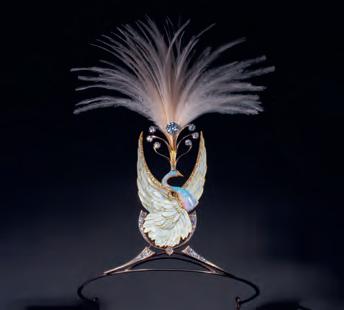

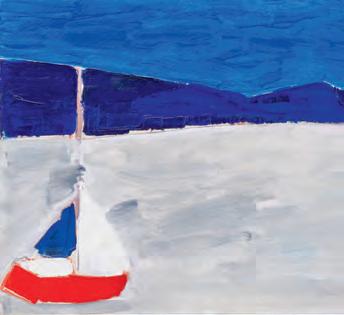
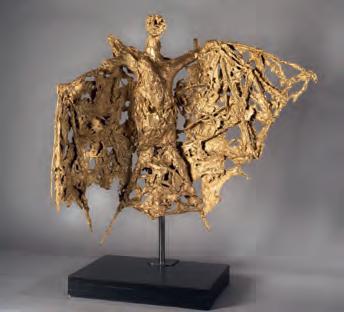
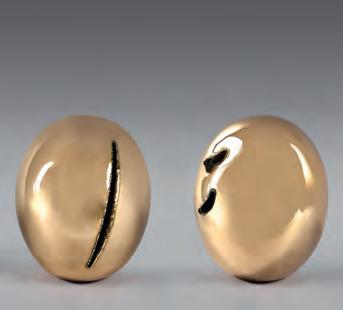
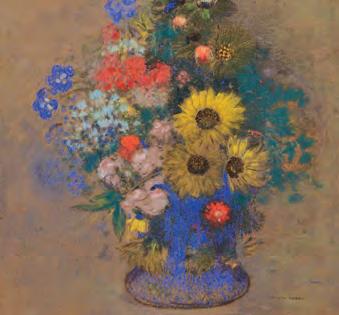
29 JAN — 5 FEB 2023
EXPO
HEYSEL www.brafa.art
OF THE MOST INSPIRING
WORLD
BRUSSELS
I
ONE
FAIRS IN THE














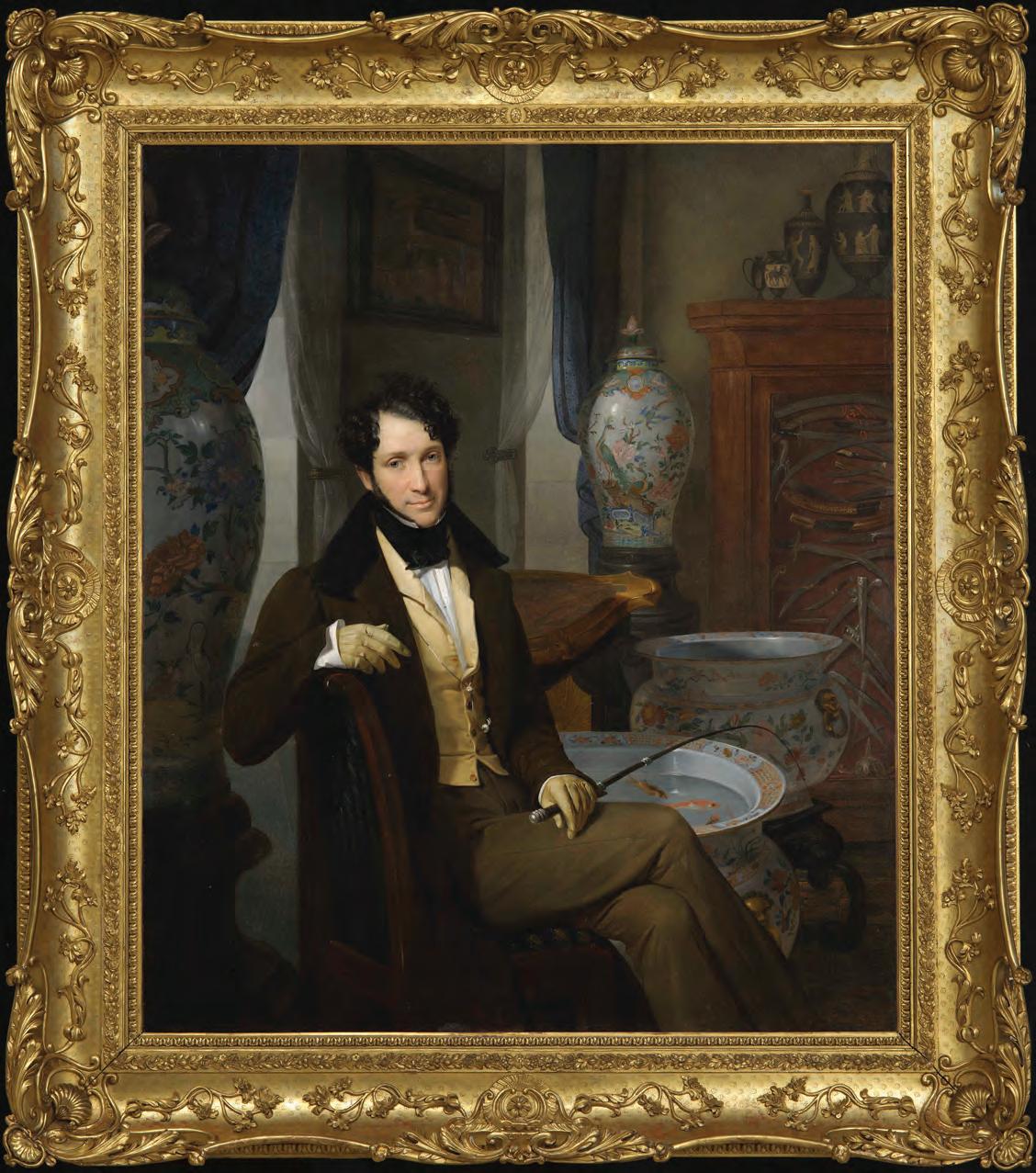
GIUSEPPE MOLTENI 1800–1867 Portrait of Marchese Antonio Visconti Aimi (1798–1854) c. 1830–35 www.robilantvoena.com
29th January – 5th February 2023
Brussels Expo, 1020 Brussels
For more details visit: brafa.art
IT IS REASSURING to both public and private collectors and the wider commercial art world that BRAFA, a museum quality event, is returning to its New Year position in the fair calendar. After the success of 2022, the 68th edition will again occupy two capacious halls at Brussels Expo. With 130 exhibitors from all over the world, this truly international event will showcase a diverse range of objects dating from prehistory to modern times. This year BRAFA has chosen Art Nouveau as its thematic focus. The 2023 iteration of the fair will celebrate the art movement with a talks programme, special events and selected dealer displays; even the design of the fair will pay homage to this heritage.
Large-leaf verdure depicting a stag and doe. Southern Netherlands, 1550–1600. Wool and silk, 270 by 178 cm.
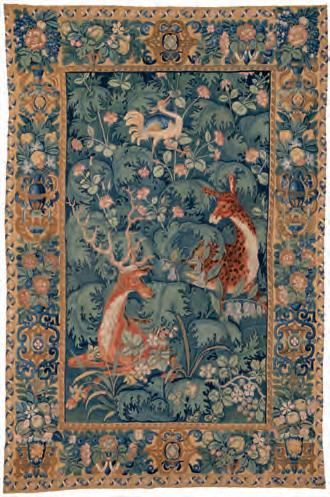
DE WIT TAPESTRIES, MECHELEN
Lega figure. Democratic Republic of Congo, early 20th century. Wood and pigments, height 29 cm. DIDIER CLAES, BRUSSELS
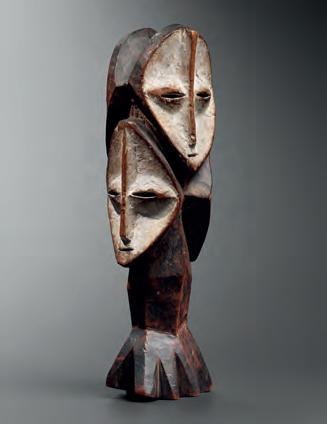
Avarice, by Pieter van der Heyden (c.1530–72) after Pieter Bruegel the Elder (c.1525–69). Engraving, 29.6 by 22.5 cm. BELGIAN ANTIQUARIAN BOOKSELLERS ASSOCIATION (BBA), BRUSSELS

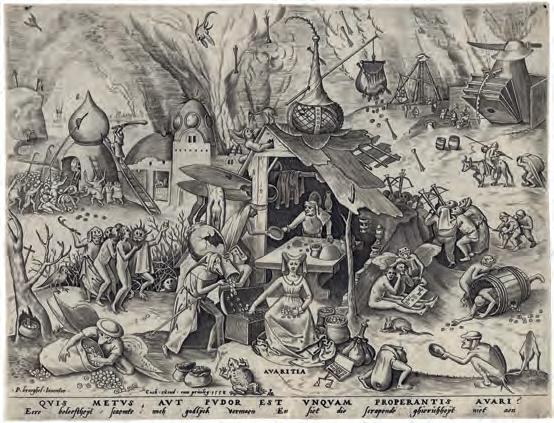
Maisons au Quai Vert, Bruges, by Auguste Herbin (1882–1960). 1906. Oil on canvas, 53 by 64 cm. STERN PISSARRO GALLERY, LONDON
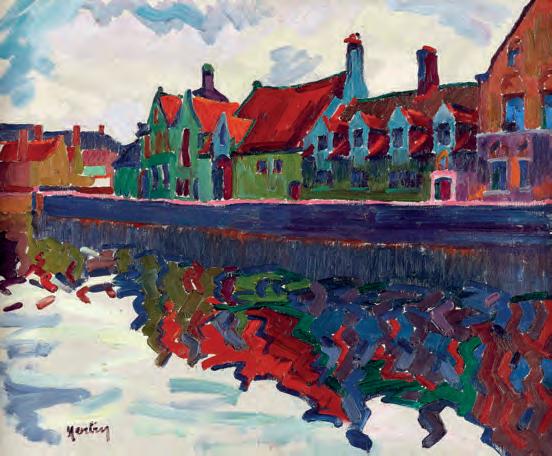 The temptation of St Anthony, by Pieter Huys (1519–84). Oil on panel, 41.8 by 57.8 cm. DE JONCKHEERE, GENEVA AND PARIS
The temptation of St Anthony, by Pieter Huys (1519–84). Oil on panel, 41.8 by 57.8 cm. DE JONCKHEERE, GENEVA AND PARIS

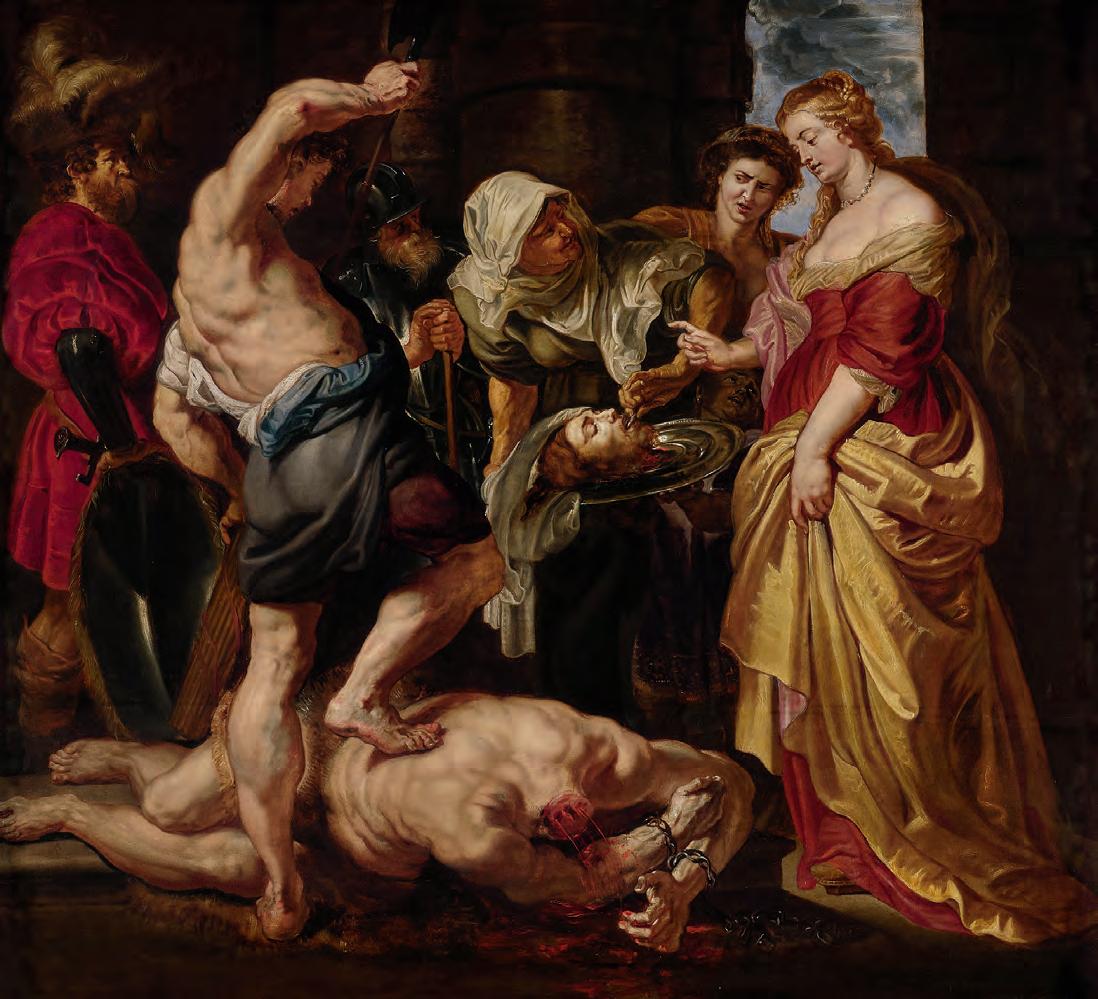
The head of Saint John the Baptist presented to Salome Estimate $25,000,000–35,000,000 SCAN HERE TO LEARN MORE 1334 YORK AVENUE, NEW YORK, NY 10021 ENQUIRIES +1 212 606 7230 SOTHEBYS.COM/MASTERPAINTINGS #SOTHEBYSMASTERS © SOTHEBY’S, INC. 2022 NEW YORK 26 JANUARY
SIR PETER PAUL RUBENS
29th January – 5th February 2023
Brussels Expo, 1020 Brussels
For more details visit: brafa.art

Golden pheasant China, Quinlong period (1736–95), c.1750–70. Porcelain with polychrome, height 35.5 cm.
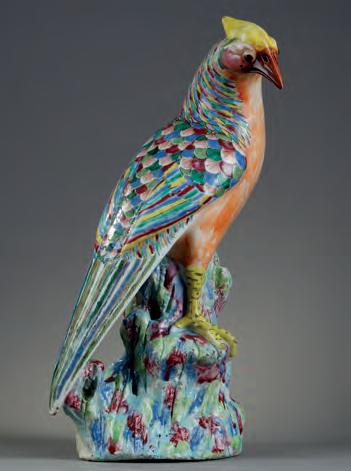
GALERIE BERTRAND DE LAVERGNE, PARIS
Crate table, by Gerrit Thomas Rietvelt (1888–1964).
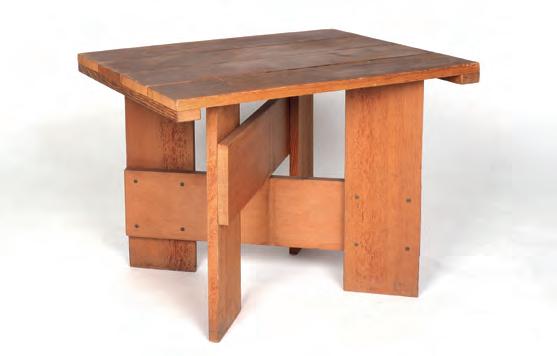
1935. Wood and brass, height 63 cm.
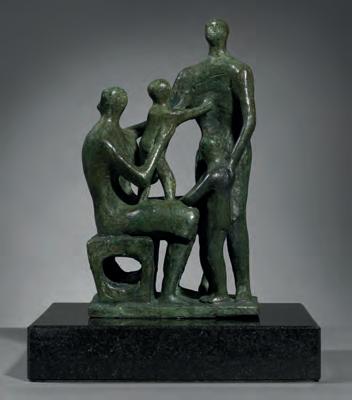
GALERIE VAN DEN BRUINHORST, KAMPEN

Green table, by Henri Hayden (1883–1970).
1917. Oil on canvas, 81 by 54 cm. SIMON STUDER ART SA, GENEVA
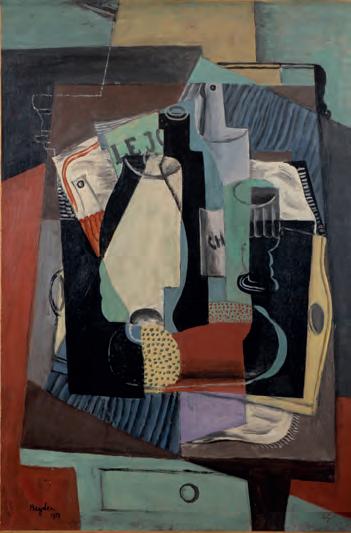 Psycho-site, by Jean Dubuffet (1901–85). 1981. Acrylic on paper, 50 by 81 cm. GUY PIETERS GALLERY, KNOKKE-HEIST
Family portrait. Antwerp school, c.1620. Oil on canvas, 134.5 by 159 cm. KLAAS MULLER, BRUSSELS
Family group, by Henry Moore (1898–1986). 1945. Bronze, height 18 cm. OSBORNE SAMUEL
GALLERY, LONDON
Psycho-site, by Jean Dubuffet (1901–85). 1981. Acrylic on paper, 50 by 81 cm. GUY PIETERS GALLERY, KNOKKE-HEIST
Family portrait. Antwerp school, c.1620. Oil on canvas, 134.5 by 159 cm. KLAAS MULLER, BRUSSELS
Family group, by Henry Moore (1898–1986). 1945. Bronze, height 18 cm. OSBORNE SAMUEL
GALLERY, LONDON
Rare New Seasons Catalogue

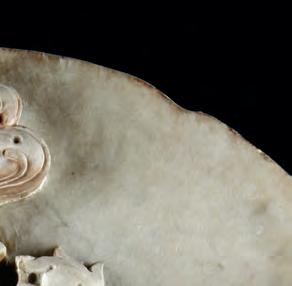
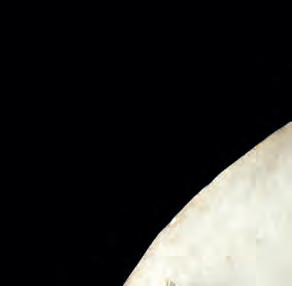
A Very Rare and Important Marble Relief of the Resurrection of Christ Attributed to the Master of the Mascoli Altar Marble, Venice, Italy

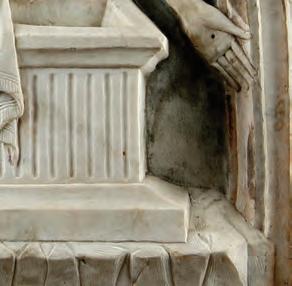
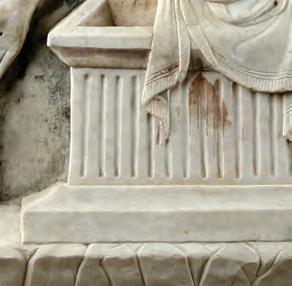
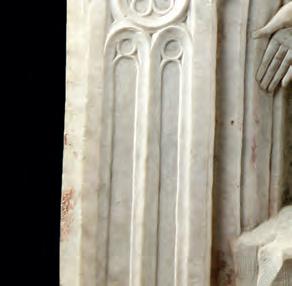
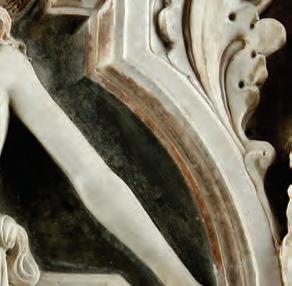

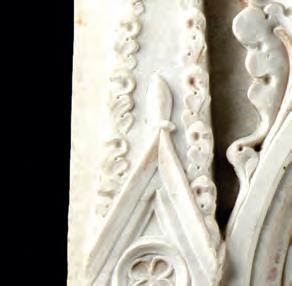
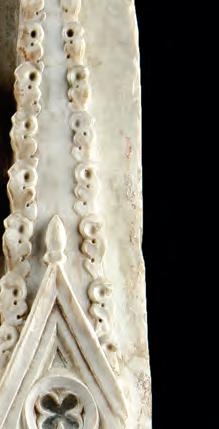

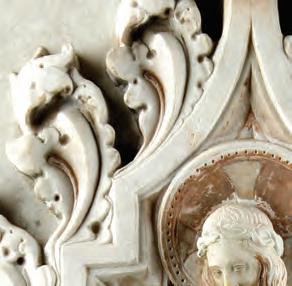

Second half of the 15th Century provenance: Former French Private collection, gallery of Gustave Clément-Simon (1833–1909), in his Castle of Bach, Naves (Corrèze, France) since the late 19th century Thence by descent until 2013 Ex Private collection
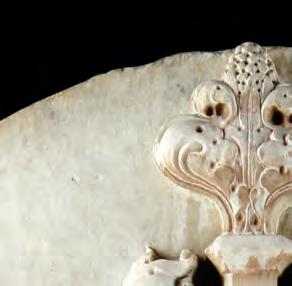
w: www.finchandco.art m: +44 (0)7768 236921 e: enquiries@finch-and-co.co.uk
number 39 available upon request Exhibiting at: BRAFA Art Fair 29 Jan – 5 Feb 2023 Brussels Expo Heysel, Brussels Belgium

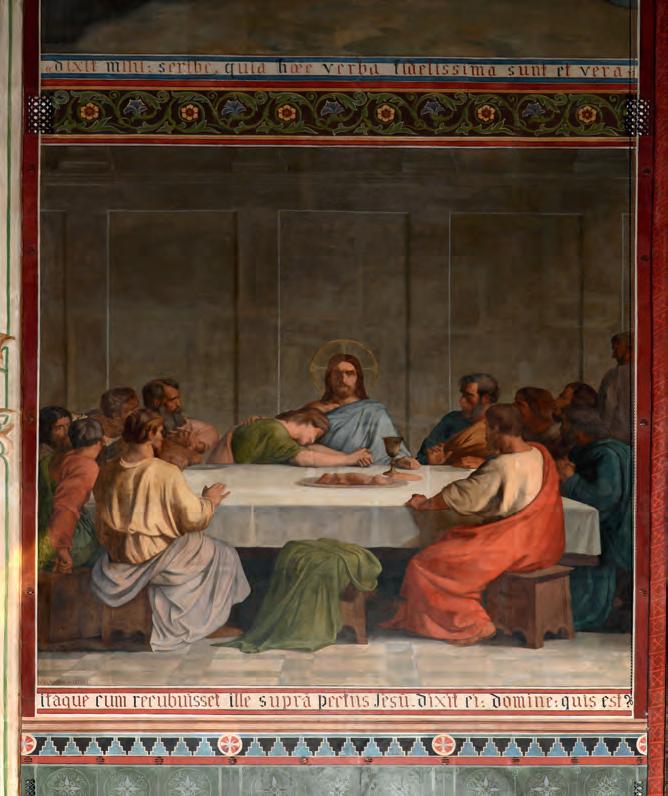
vi the burlington magazine | 165 | january 2023 Print and online from less than £15 per month 40% off for new readers and gifted subscriptions shop.burlington.org.uk/promotion/seasonal
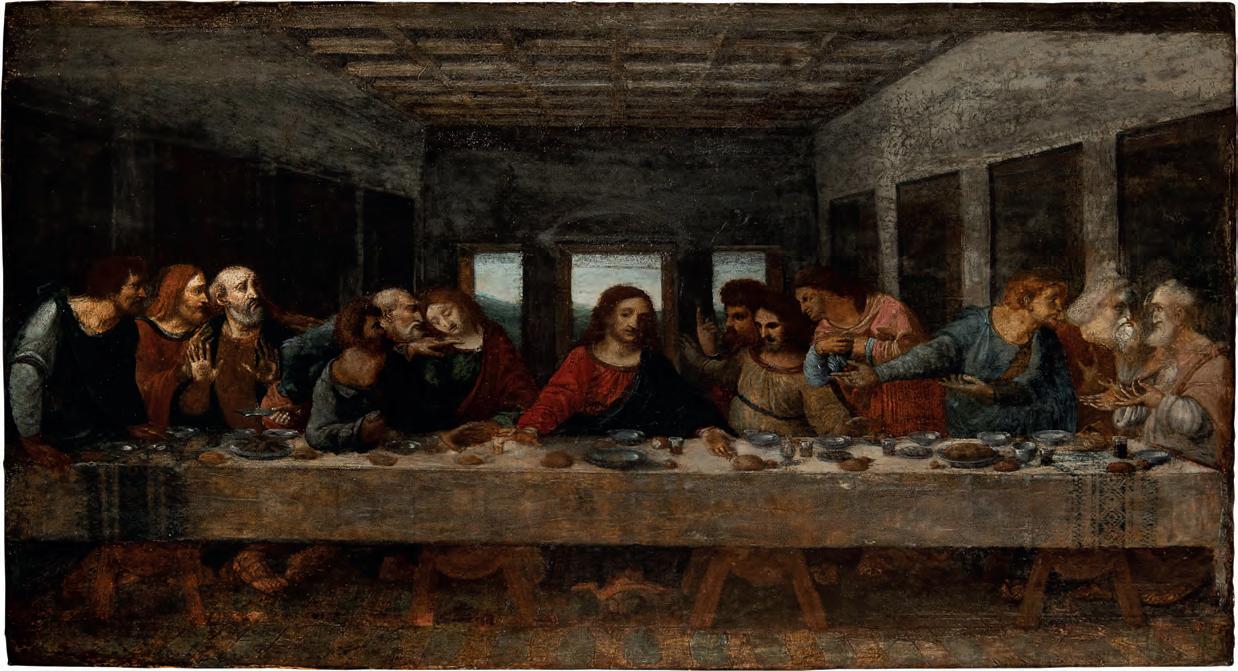
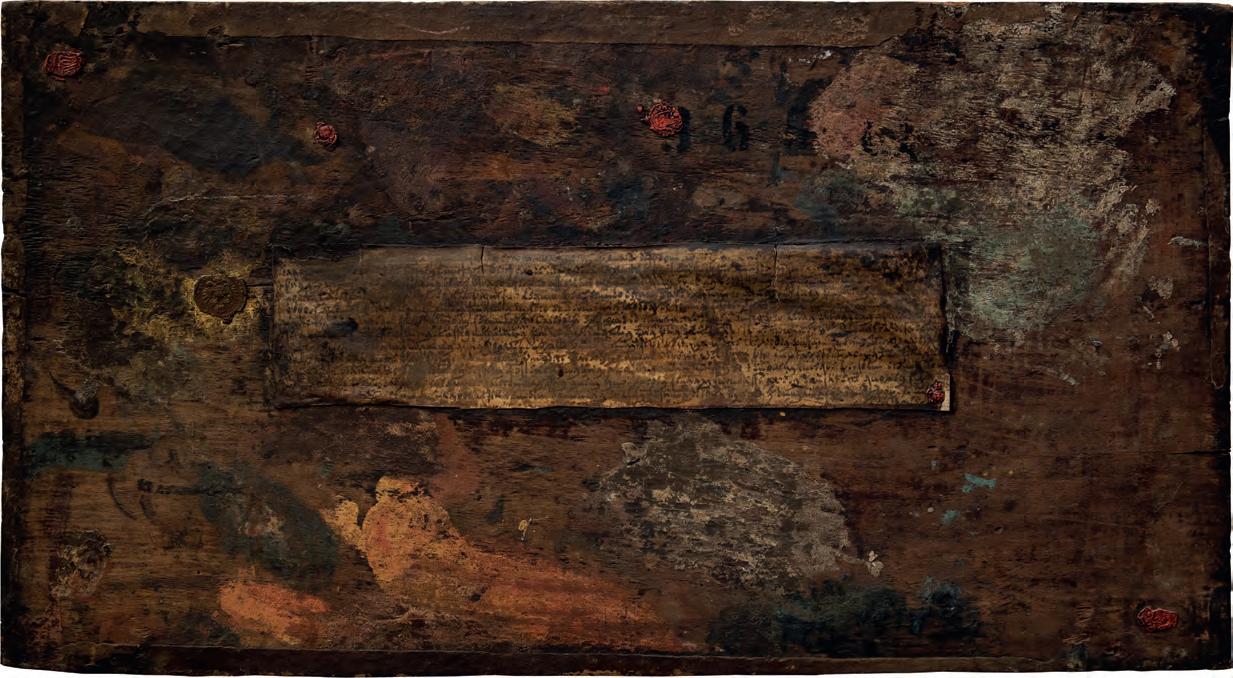
SLOANE STREET AUCTIONS Zero seller’s fees at Sloane Street Auctions 69 LOWER SLOANE STREET, LONDON, SW1W 8DA INFO@SLOANESTREETAUCTIONS.COM - +44 (0)2072590304 - WWW.SLOANESTREETAUCTIONS.COM 1st March 2023 - Lot 71 - £20,000-30,000
Executed possibly pre 1515. Recorded by Domenico Pino, the author of the first monograph dedicated entirely to Leonardo’s Cenacolo, the Prior of the monastery for which the original Last Supper was made. Written in 1796 as located in the Santa Maria Delle Grazie di Milano and in Guillon as “…l’autre petit, et non moins ancienne, mais peinte sur bois…elle était au temps du P. Pino dans le chambre de l’un de ses confreres”. Imperial seal of the royal academy, Milan. Christies London June 7 1856 as Lionardo da Vinci.. Gift of John Law to St Wilfrid’s Convent. The reverse with ancient parchment (papal bull?) and numerous wax seals. 36 cm x 65 cm. £20,000-30,000
Property of The Daughters of the Cross. 16th century. Oil on panel. An extraordinarily rare depiction of Leonardo’s La Cenacolo



















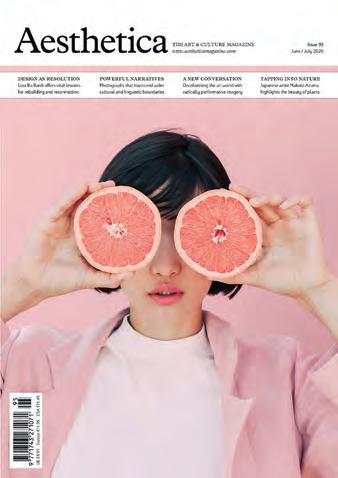
VIII THE BURLINGTON MAGAZINE | 165 | JANUARY 2023 Minerva magazine showcases the beauty and sophistication of ancient civilisations. With spectacular illustrations and exciting features, each issue will give you an inside view of the archaeology, culture, and art of the ancient world. PLUS, YOU’LL GET EVERY ISSUE DELIVERED TO YOUR DOOR VISIT www.minervamagazine.com/BurlHalf CALL 020 8819 5580 quoting ‘BurlHalf’ SUBSCRIBE TODAY, AND GET A 1 -YEAR SUBSCRIPTION FROM JUST £ 1 4.99 (USUALLY £31.95) introductory half-price offer for BURLINGTON readers OFFERSPECIAL SUBSCRIBE TODAY aestheticamagazine.com The Destination for Art and Culture SUBSCRIBE & SAVE 70% 12 MONTHS FOR £12 (+P&P) Offer ends 31 January 2023
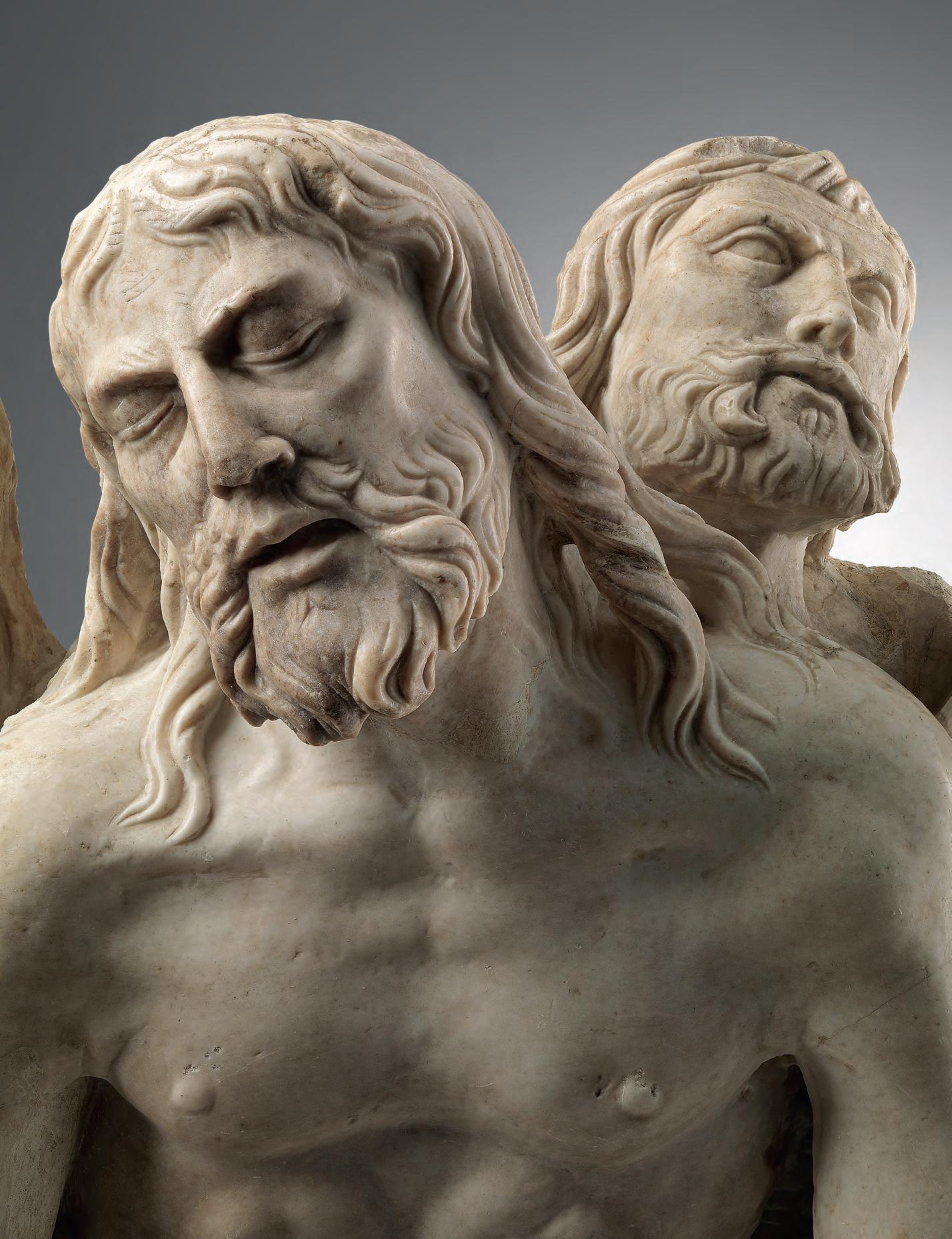
Gasparo Cairano Deposition Group (detail) alabaster 47,5 x 65 x 22,5 cm CARLO ORSI Old Master Paintings and Sculpture
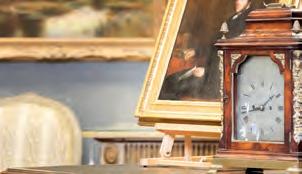


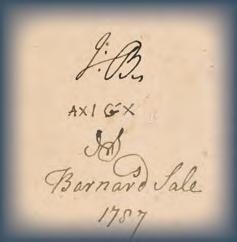
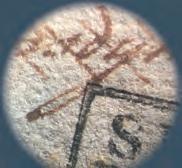





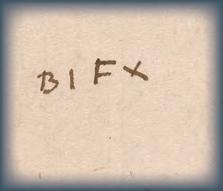





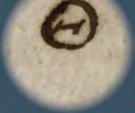






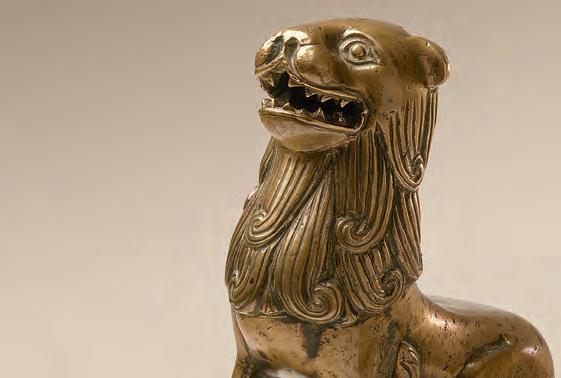
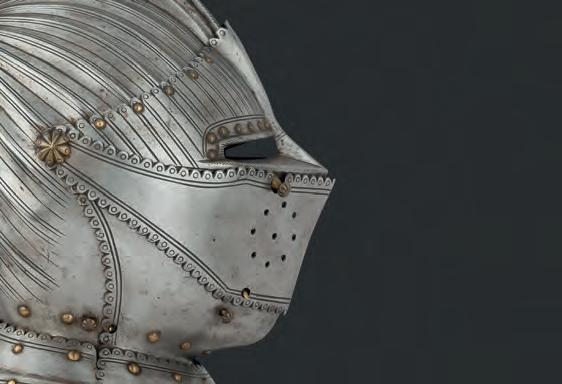





THE BURLINGTON MAGAZINE | 165 | JANUARY 2023 X CONT @ CTS owse and b one-of-a-kind items online ms m 11 Duke Street | St James’ | London SW1Y 6BN Tel. +44 207 930 1144 | Fax. +44 207 976 1596 www.rafaelvalls.co.uk | info@rafaelvalls.co.uk Daniel Katz G allery from antiquity to the 2oth century www.katz.art TRINITY FINE ART 15 old bond street london w 1 s 4 ax www.trinityfineart.com info @ trinityfineart.com +44 (0)20 7493 4916 GROUND-BREAKING ISSUE ON COLLECTORS: EARLY INSCRIPTIONS AND SECRET CODES vol. 60-4 2023-Burlington Mag.indd 1 11/12/2022 10:58 CONT @ CTS Browse one-of-a-kind day & faber old master drawings www.dayfaber.com m 11 Duke Street | St James’ | London SW1Y 6BN Tel. +44 207 930 1144 | Fax. +44 207 976 1596 www.rafaelvalls.co.uk | info@rafaelvalls.co.uk Daniel Katz G from antiquity to the 2oth century www.katz.art m TRINITY FINE ART 15 old bond street london w 1 s 4 ax www.trinityfineart.com info @ trinityfineart.com +44 (0)20 7493 4916 NEW RARITET GALLERY OLD MASTER PAINTINGS From Renaissance to the 20th Century www.newraritetgallery.com 38 & 39 DUKE STREET, ST JAMES’S, LONDON +44 2078395666 WWW.PETERFINER.COM CONT @ CTS uy owse and b Br one-of-a-kind items online ms faber drawings century ART trinityfineart.com 4916 GALLERY Century To advertise please visit: burlington.org.uk day & faber old master drawings www.dayfaber.com m 11 Duke Street | St James’ | London SW1Y 6BN Tel. +44 207 930 1144 | Fax. +44 207 976 1596 www.rafaelvalls.co.uk | info@rafaelvalls.co.uk m m NEW RARITET GALLERY OLD MASTER PAINTINGS From Renaissance to the 20th Century www.newraritetgallery.com uy owse and b Br one-of-a-kind items online ms day & faber old master drawings www.dayfaber.com m 11 Duke Street | St James’ | London SW1Y 6BN Tel. +44 207 930 1144 | Fax. +44 207 976 1596 www.rafaelvalls.co.uk | info@rafaelvalls.co.uk Daniel Katz G allery from antiquity to the 2oth century www.katz.art m TRINITY FINE ART 15 old bond street london w 1 s 4 ax www.trinityfineart.com info @ trinityfineart.com +44 (0)20 7493 4916 NEW RARITET GALLERY OLD MASTER PAINTINGS From Renaissance to the 20th Century www.newraritetgallery.com
2023 SCHOLARSHIP

INVITATION FOR APPLICATIONS


The Burlington Magazine is pleased to announce its sixth annual scholarship which has been created to provide funding over a 12-month period to those engaged in the study of French 18thcentury fine and decorative art to enable them to develop new ideas and research that will contribute to this field of art historical study. Applicants must be studying, or intending to study, for an MA, PhD, post-doctoral or independent research in this field within the 12-month period the funding is given. Applications are open to scholars from any country. A grant of £10,000 will be awarded to the successful applicant. Deadline for applications is 17 March 2023 and the successful applicant will be notified by 31 May 2023. For application guidelines and terms and conditions please visit www.burlington.org.uk
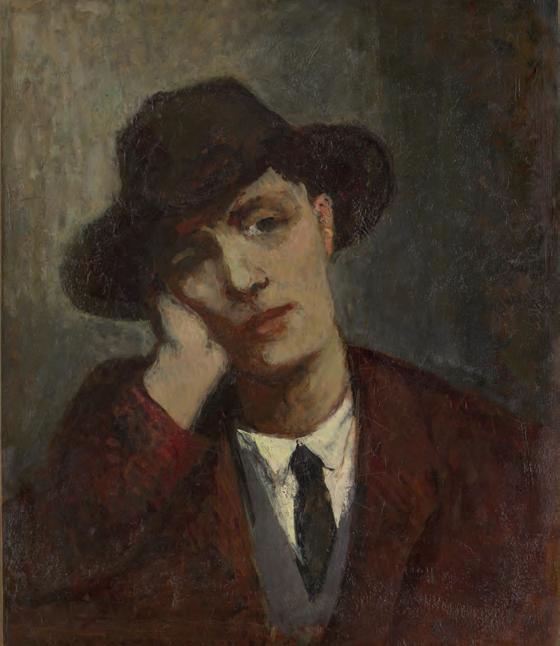

















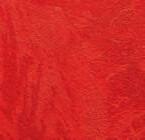

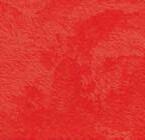
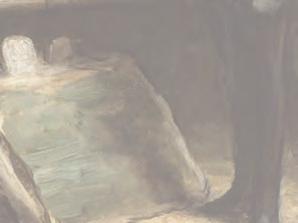
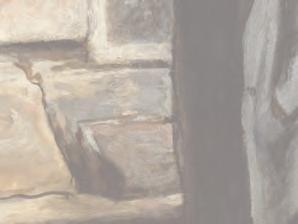


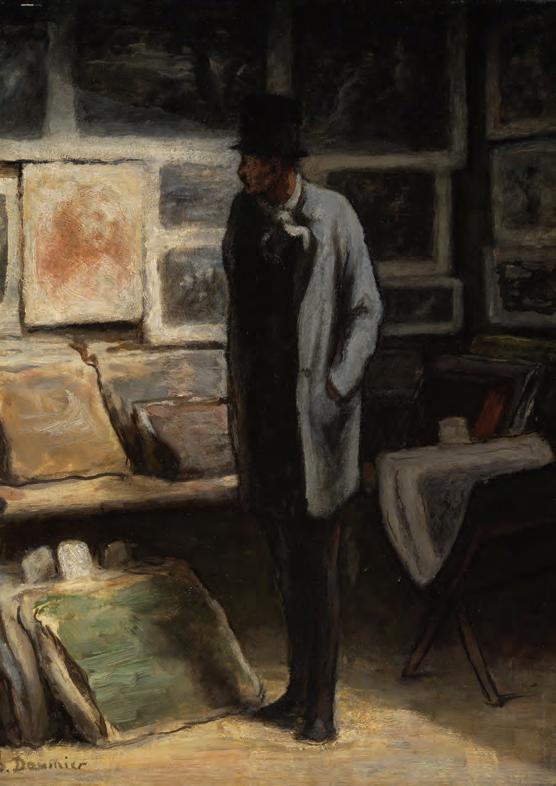
THE BURLINGTON MAGAZINE | 165 | JANUARY 2023 XI Theleadingpeer-reviewedjournal dedicatedtotheartoftheprint www.printquarterly.co.uk PRINT QUARTERLY ADVERTISESUBSCRIBEPUBLISH Read The Art Newspaper anywhere, anytime Save 50% on a digital subscription
Subscribe
Enter
sale More
O ers are
the
The Art Newspaper has been making sense of the art world for more than 30 years. We don’t simply write about art – our news relates to current events and how those a ect the international landscape of art and culture at large, from politics and the economy to technology and the environment. Save 50% when you purchase a Digital subscription and get seamless access to all our content via our website, apps for Apple and Android mobile device and an ePaper archive of the monthly newspaper going back to December 2012.
at: theartnewspaper.com/ subscription-o ers
code: BURLINGTON Modigliani portrait from the artist’s rst creative period in Paris for
to know at: www.modigliani-portrait.com
invited by using
contact form included
for the study of French 18th-century fine and decorative art


MORETTI 13 Duke Street, St. James’s London SW1Y 6DB enquiries@morettigallery.com +44 (0)20 7491 0533
Vasari Arezzo, 1511 – Florence, 1574 The Temptation of Saint Jerome Oil on panel, 165 x 117 cm Recently sold to a private collector
Giorgio
Editorial 3 A spoonful of sugar
Articles
focus on bronzino
4 Bronzino’s portrait of Cosimo I de’ Medici in armour re-examined by paula dredge, anne gérardaustin, daryl howard and simon ives
16 Bronzino’s ‘Petrarch’ retrieved: new light on Bartolomeo Bettini’s ‘camera’ by jeroen stumpel
26 A portrait of the Lady Isabella by the hand of Bronzino by bruce edelstein
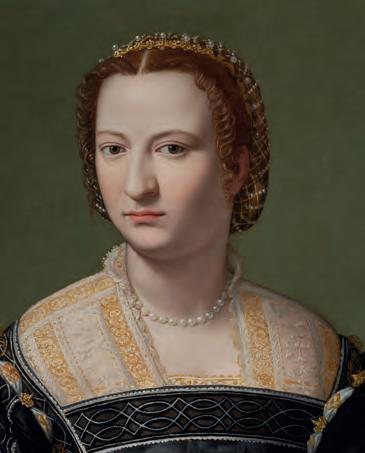
38 Discoveries in the Parma baptismal registers: 1 Parmigianino as godfather by mary vaccaro
42 Sicilian silver in Malta: an eighteenthcentury ciborium in Mdina by roberta cruciata
A rticle reviews
50 The many faces of Mary Magdalene by susan haskins 57 The man who never was – almost by arnold nesselrath
Exhibitions
66 Denis Wirth-Miller: Landscapes and Beasts by katharina günther 69 Vor Dürer: Kupferstich wird Kunst by armin kunz 71 Pisanello: Il Timulto del Mondo by samuel dawson 74 The Tudors: Art and Majesty in Renaissance England by elizabeth goldring 77 Der Maler als Zeichner – der Zeichner als Maler: 300 Jahre Johann Heinrich Tischbein d. Ä. by heidrun ludwig 79 Fuseli and the Modern Woman: Fashion, Fantasy, Fetishism by kevin salatino 81 Modigliani Up Close by bart j.c. devolder 83 Morris Hirshfield Rediscovered by randall morris 86 Isamu Noguchi by penelope curtis
Cover Detail of a composite XRF scan map of Cosimo I de’ Medici in armour, by Agnolo Bronzino. c.1545. (p.13).
Left Monument to heroes, by Isamu Noguchi. 1943. (p.88).
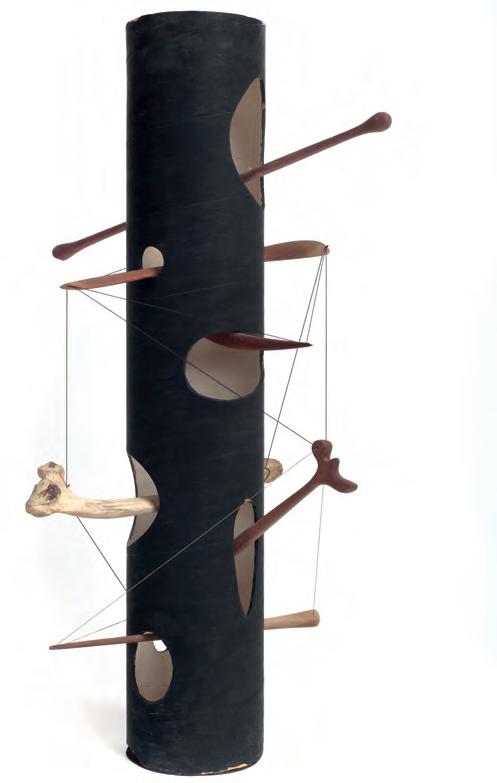
Above Detail of Portrait of a woman, by Agnolo Bronzino. c.1560. (p.27).
Right Mary Magdalene crouching, by Venanzo Crocetti. 1956. (p.56).
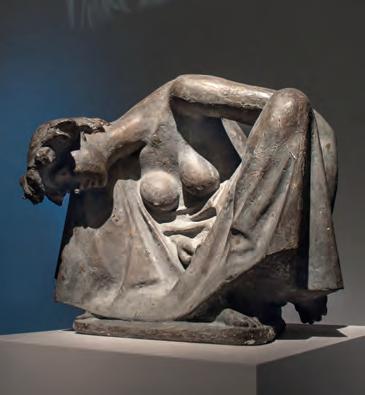
Books
90 Artemisia Gentileschi, S Barker by mary d. garrard
91 Artemisia Gentileschi and Feminism in Early Modern Europe, M.D Garrard by babette bohn
92 A Companion to Late Medieval and Early Modern Siena, S. Casciani and H. Richardson Hayton, eds by giulio dalvit
93 On Bramante, P.P. Tamburelli by david hemsoll
95 Il Mobile a Roma dal Rinascimento al Barocco, A. González-Palacios by simon swynfen jervis
97 La nascita di una collezione: Gli Hercolani di Bologna (1718–1773), B. Ghelfi by linda borean
97 Improbable Pioneers of the Romantic Age: The Lives of John Russell, 6th Duke of Bedford, and Georgina Gordon, Duchess of Bedford, K. Davidson by richard ormond
99 Mary Gillick: Sculptor and Medallist, P Attwood by mark stocker
100 Paul Signac: Journal 1894–1909, C. Hellmann, ed. by richard thomson
101 Against the Avant-Garde: Pier Paolo Pasolini, Contemporary Art, and Neocapitalism, A.H. Merjian by robert silberman
Obituary
103 Angus Trumble (1964–2022) by andrew hopkins 104 among this month’s contributors
Contents Volume 165 | Number 1438 | January 2023
Editor
Michael Hall Reviews Editor
Alexandra Gajewski
Contemporary Art Editor
Kathryn Lloyd
Assistant Articles Editor
Christine Gardner-Dseagu
Assistant Reviews Editor
Lisa Stein
Editorial Assistant, Burlington Contemporary Yi Ting Lee
Art Editor
Tzortzis Rallis
www.burlington.org.uk www.contemporary.burlington.org.uk
14–16 Duke’s Road, London wc1h 9sz Tel: 020–7388 1228 Email: burlington@burlington.org.uk Editorial Tel: 020–7388 8157
© The Burlington Magazine Publications Ltd
All rights reserved Printed in Wales by Stephens & George, Merthyr Tydfil Print issn 0007 6287 Online issn 2044 9925
Managing Director
Andrew Dunn
Advertising & Development Director Mark Scott
Head of Partnerships Sarah Bolwell
Head of Commercial Design & Production Chris Hall
Marketing & Circulation Manager Hannah Daldry
Marketing & Advertising Executive Nicole Gilchrist-Reeves Office Administrator Serena Sclocco
The Burlington Magazine is owned and published by Burlington Magazine Publications Ltd. Registered in England, company no.790136. Registered charity in England and Wales no.29502. Burlington Magazine Publications Ltd is owned and supported by the Burlington Magazine Foundation CIO (charity no.1187286) and the Burlington Magazine Foundation Inc., a not-for-profit company incorporated in the State of New York, USA.
Directors, BMPL
Caroline Campbell
Craig Clunas fba
Simon Swynfen Jervis fsa Nathanael Price
Andrea Rose cmg obe
Desmond Shawe-Taylor lvo, Chairman Anna Starling Paul Williamson obe fsa frhists
Trustees, BMF CIO Hugo Chapman
Elizabeth Cropper Gabriele Finaldi David Landau cbe
John Nicoll, Chairman Sir Nicholas Penny fba fsa Jane Portal fsa Andrea Rose cmg obe
Desmond Shawe-Taylor lvo Catherine Whistler
the burlington magazine foundation’s benefactors and supporters
Directors, BMF Inc. Andrew Dunn
Colin B. Bailey Joseph Connors
Lynne Cooke
Elizabeth Cropper John Nicoll, Chairman Patricia Rubin John Walsh
Contributing institutions
The Morgan Library & Museum, New York
The Museum of Fine Arts, Houston Kimbell Art Museum, Fort Worth Fondation Custodia, Paris
The Metropolitan Museum of Art, New York
The J. Paul Getty Museum Director’s Council Yale Center for British Art, New Haven
Supporters
Charles Booth-Clibborn
Commercial supporters Bridgeman Images John Sandoe Books Ltd
The European Fine Art Foundation (TEFAF)
Benefactors
The Michael Marks Charitable Trust Timothy Llewellyn obe Richard Mansell-Jones
consultative committee
Past benefactors & supporters
The late Gilbert de Botton
Sir Harry Djanogly cbe • Francis Finlay
Nicholas and Judith Goodison •Daisaku Ikeda
The late Paul Z. Josefowitz • John Lewis obe
The late Jan Mitchell • Mr and Mrs Brian Pilkington Mrs Frank E. Richardson • Sir Paul Ruddock fsa
Nancy Schwartz • Madame Andrée Stassart
The late Saul P. Steinberg • Janet de Botton
Gifford Combs • The late Hester Diamond Mark Fisch • The Lady Heseltine
The Rt. Hon. Lord Rothschild om gbe fba Patricia Wengraf
Dawn Ades cbe fba
David Anfam
Colin B. Bailey
David Bindman
Christopher Brown cbe
Richard Calvocoressi cbe
Lorne Campbell
Lynne Cooke
Caroline Elam
David Franklin
Julian Gardner fsa
Elizabeth Goldring frhists
Christopher Green fba
Tanya Harrod
Simon Swynfen Jervis fsa
C.M. Kauffmann fba
Rose Kerr Felix Krämer
Alastair Laing fsa
Shane McCausland
Elizabeth McGrath fba
Robin Middleton
Jennifer Montagu cbe lvo fba fsa
Peta Motture fsa
Sir Nicholas Penny fba fsa
J.M. Rogers fba fsa Pierre Rosenberg
John-Paul Stonard
Deborah Swallow
Gary Tinterow
Julian Treuherz
Simon Watney
Sir Christopher White cvo fba Paul Williamson obe fsa frhists
Subscription & Advertising Enquiries Telephone: 020–7388 1228 Email: subs@burlington.org.uk Annual Subscription rates for Individual Subscribers (Agencies and Institutional rates published on www.burlington.org.uk) Full digital access: United Kingdom £240 • USA $324 • Canada $324 • EU €276 • Rest of World £240 12 Print issues (including full digital access): United Kingdom £300 • USA $800 • Canada $780 • EU €500 • Rest of World £500 *VAT applied to UK and EU customers. Attributions and descriptions relating to objects advertised in the magazine are the responsibility of the advertisers concerned. © The
Magazine Publications Ltd. All rights reserved.
members of the Consultative Committee give invaluable assistance to the Editor on their respective subjects, they are not responsible for the general conduct of the Magazine.
Burlington
Although the
A spoonful of sugar
Let’s try to be positive. Nobody can pretend that 2022 ended in an entirely rosy fashion for the world’s museums. Still in recovery mode after the pandemic, with visitor numbers in most cases not yet back to pre-2020 levels, and having to cope like everybody else with resurgent inflation and soaring energy costs, they are facing challenges caused on the one side by politcal activism, as Stop Oil protestors have targeted art as way of promoting their environmental message, and on the other by governments seeking to use museums as tools for social engineering. In November, and with no prior warning to the institutions affected, Arts Council England announced cuts designed to reallocate funds to areas of the country that the government has targeted for levelling-up, making a mockery of the idea that it operates at arm’s length from its political masters. To take only the most egregious example, the Fitzwilliam Museum, Cambridge, had its annual grant cut by 50 per cent, from £1.21 million to £617,534, putting its educational and outreach programmes at risk. Our annual selection of exhibitions to look forward to in the year ahead is therefore taking a lead from Mary Poppins – bearing in mind that the Walt Disney Company is celebrating its one hundredth anniversary in 2023 – by offering a spoonful of sugar for bitter times.
Nowhere are they more bitter than Ukraine, where to the wholesale destruction of museums in, for example, Lyman and Rubizhne, has been added the looting of the museum in Mariupol by Russian troops. That backdrop makes the success of Ukraine’s cultural authorities and curators in staging the exhibition In the Eye of the Storm: Modernism in Ukraine, 1900–1930s at the Museo Nacional Thyssen-Bornemisza, Madrid (to 30th April), all the more impressive. Around seventy works, ranging from oil paintings to collages and theatre designs, trace the avant-garde movements in Ukraine led by such artists as Oleksandr Bohomazov, Vasyl Yermilov, Viktor Palmov and Anatol Petrytskyi. An exhibition with particular resonance for violent events unfolding in another part of the world, the protests in Iran that have followed the death in police custody of Mahsa Amini in September 2022, is Women Defining Women In Contemporary Art of the Middle East and Beyond at the Los Angeles County Musuem of Art (23rd April–24th September), which will present seventyfive works by women artists born or living in Islamic societies who seek to challenge stereotypes.
In Paris, memories of the fire that engulfed Notre Dame in April 2019 remain vivid, but the rapid progress made in repair and restoration is heartening. An opportunity to see at close quarters the treasures that were so nearly lost will be provided by The Treasury of Notre Dame Cathedral from its origins to Viollet-Le-Duc, at the Musée du Louvre (19th October 2023–19th February 2024), which will highlight the reliquaries ordered by Napoleon for the Crown of Thorns and a fragment of the True Cross. There is perhaps particular pleasure during times of hardship in looking at objects of luxurious splendour, in which case we can look forward to Luxury and Power: Persia to Greece at the British Museum, London (4th May–13th August), which explores the way luxury was used as a political tool in the Middle East and south-east Europe from 550 to 30 BC. If any exhibition can add cheerfulness to life it will be Beyond Bollywood at the Asian Art Museum, San Francisco (31st March–10th July), which celebrates two thousand years of the depiction of dance in the arts of Asia.
There is no shortage of monographic shows this year. Leading the way with the hottest ticket in town is Vermeer at the Rijksmuseum, Amsterdam (10th February–4th June), which promises no fewer than twenty-eight works by the artist. At the Gemäldegalerie, Berlin, Hugo van der Goes: Between Pain and Bliss, which opens on 31st March (to 16th July), is surprisingly the first-ever exhibition devoted solely to him. Best known for his portrait by Diego Velázquez, the painter Juan de Pareja (c.1608–70) is given his own exhibition at the Metropolitan Museum of Art, New York, Juan de Pareja, Afro-Hispanic Painter (3rd April–16th July). Dulwich Picture Gallery, London, is staging Berthe Morisot: Shaping Impressionism, her first major exhibition in the United Kingdom since 1950 (31st March–10th September), and the Accademia Carrara, Bergamo, has an exhibition on that most enigmatic and idiosyncratic of Caravaggio’s followers, his lover Cecco del Caravaggio (26th January–4th June). Giacomo Ceruti: A Compassionate Eye at the J. Paul Getty Museum, Los Angeles (18th July–29th October), focuses on this eighteenth-century artist’s hauntingly realistic depictions of beggars and vagrants. Of all the many contemporary art monographic shows, Mike Nelson: Extinction Beckons at the Hayward Gallery, London (22nd February–7th May), is particularly eagerly anticipated. Nelson’s installations will, we are promised, take us into ‘fictive worlds that eerily echo our own’.
It is not a classic year for artists’ anniversaries – the three-hundredth anniversary of Joshua Reynolds’s birth would pass largely without notice were it not for an exhibition at The Box in his native Plymouth, Revisiting Reynolds: A Celebration (24th June–29th October). The biggest name to receive anniversary attention is Picasso, who died fifty years ago, on 8th April 1973. An astonishing forty exhibitions are said to be in preparation, conveniently listed on the website of the Picasso Museum, Paris.1 The one that seems likely to provoke the widest interest will be at the Brooklyn Museum (2nd June–24th September), still untitled at the time of writing, which promises to examine the issues of misogyny, masculinity, creativity and ‘genius’ that surround the artist’s reputation.
It would be an interesting debate whether Picasso or Disney can claim to have had the bigger impact on global visual culture. A visitor to one of the Picasso exhibitions can ponder the question at Disney 100: The Exhibition, which opens at the Franklin Institute, Philadelphia, on 18th February and will be seen also in Munich and London.2 It is now ninety years since the critic Dorothy Grafly, in a famous review of the art of Walt Disney, declared that ‘He goes to nature for his material, but it is the nature of the poet. Quite as much as Picasso he distorts and renders unreal, but from this unreality one derives a fine emotional participation that brings conviction’.3 Perhaps the comparison is not so absurd: Dalí’s and Mondrian’s admiration for Disney is well known, and anyone who doubted the artistry of his cartoons had the opportunity to be persuaded by the exhibition Inspiring Walt Disney: The Animation of French Decorative Arts, seen in 2021–22 at the Metropolitan Museum of Art and Wallace Collection, London.4 In any case many museum directors and curators are probably hoping that 2023 will bring more than the bare necessities.
1 www.museepicassoparis.fr/en/celebration-picasso-1973-2023, accessed 19th December 2022.
2 For full details, see www.disney100exhibit.com/en/, accessed 19th December 2022.
3 D. Grafly: ‘America’s youngest art’, The American Magazine of Art 26 (1933), pp.336–42, at p.342.
4 Reviewed by Kee Il Choi Jr in this Magazine, 164 (2022), pp.504–07.
the burlington magazine | 165 | january 2023
3
Editorial
focus on bronzino
Bronzino’s portrait of Cosimo I de’ Medici in armour re-examined
Technical analysis by the Art Gallery of New South Wales of its portrait by Bronzino of Cosimo I de’ Medici in armour has revealed more details of the mysterious underlying portrait first observed in a X-radiograph in the 1980s. It has also established that Bronzino hesitated between making the portrait half-length or three-quarter-length, confirming that the painting is the prime autograph version of the three-quarter-length image.
by paula dredge, anne gérard-austin, daryl howard and simon ives
Agnolo di cosimo, known as Bronzino (1503–72), was the leading painter in mid-sixteenth-century Florence, where he served as court painter to Duke Cosimo I de’ Medici (1519–74). His portraits are characterised by an intense concentration and an almost unnerving clarity – none more so than the version of Cosimo I de’ Medici in armour in the Art Gallery of New South Wales, Sydney (Fig.1). In this magnificent likeness of the duke, Bronzino displays a perfectionism characteristic of his artistic style. If the duke’s diverted gaze reveals a sense of anxiety in the stillyouthful ruler, his steely reserve is cleverly accentuated by his forbidding armour. Rendered with reflections, highlights and shadows, and lined with rich red velvet, Cosimo’s armour is an article of transfixing interest.
The portrait was commissioned by the duke as a gift for the gallery of illustrious men formed by Paolo Giovio (1483–1552) on Lake Como.1 Giovio was a Lombard historian, physician and prelate who in the last years of his life became a friend and adviser of Cosimo.2 A letter from Giovio to Cosimo’s majordomo, Pier Francesco Riccio (1501–64),3 dated 30th July 1546, thanks the duke for ‘the marvellous portrait of His Excellency [which] was so pleasing to the gentlemen of this [Papal] Court, and judged excellent by painters [. . .] blessed be the hand of Bronzino, which I think surpasses that of his teacher Pontormo’.4
The identification of the panel as the work commissioned for Giovio is supported by the presence of the Latin inscription ‘cosmvs/ medices
1 The portrait is recorded in the catalogue of Paolo Giovio’s collection in P. Giovio: Elogia vivorum bellica virtute illustrium, Basel 1551, Book 7, pp.338–
39. The gallery, known as the ‘Museo’, was established near the site of the villa of Pliny the Elder at Borgo Vico on Lake Como.
2 The primary source on Giovio in English is the comprehensive biography by T.C. Price Zimmerman: Paolo Giovio: the Historian and the Crisis of Sixteenth-century Italy, Princeton 1995.
3 On Pier Francesco Riccio, see A. Cecchi: ‘Il maggiordomo ducale Pierfrancesco Riccio e gli artisti della corte medicea’, Mitteilungen des
Kunsthistorischen Institutes in Florenz 42 (1998), pp.115–43.
4 ‘Signor mio honorando, il mirabile ritratto di Sua Excellenza è piacciuto summamente alli galanthuomini di questa Corte, et giudicato finissimo da’ pittori [. . .] et benedatta sia la mano di Bronzino qual mi pare che avanzi quella del Pontorni [sic] suo maestro’, Archivio Stato di Firenze (hereafter cited as ASF), Mediceo del Principato, vol.1170a, fol.104r, letter from Paolo Giovio to Pier Francesco Riccio, 30th July 1546.
5 See R.B. Simon: ‘Bronzino’s portrait of Cosimo I in armour’, THE BURLINGTON MAGAZINE 125 (1983), pp.527–39, at
the burlington magazine | 165 | january 2023 4
1. Cosimo I de’ Medici in armour, by Agnolo Bronzino. c.1545. Oil on poplar panel, 86 by 66.8 cm. (Art Gallery of New South Wales, Sydney; © Art Gallery of New South Wales, Diana Panuccio).
• dvx/ flor’ (‘Cosimo de Medici, duke of [the] Floren[tine Republic]’) in the lower-right corner of the painting. Unique among the many versions of Cosimo I de’ Medici in armour, this inscription is a formula used on other portraits of famous personages owned by Giovio. Although difficult to see, the presence at lower right of the Medici broncone – a laurel tree stump with a vigorous leafy side shoot on which the sitter’s helmet rests – is also associated with Giovio, who had promoted the use of the iconographic device to represent and legitimate Cosimo’s leadership of Florence.5 Cosimo belonged to a secondary branch of the Medici family and succeeded to the dukedom in 1537 only when the main Medici line was extinguished by the assassination of Alessandro de’ Medici (1510–37). The broncone suggested that Cosimo was a true heir of the Medici patriarchy and represented an alternative, but forceful, new growth from the family tree.
Although Giovio’s collection had largely been dispersed by the end of the sixteenth century, the Sydney portrait remained in the Giovio family until 1860.6 It was then sold to Napoléon-Jérôme Bonaparte, Prince Napoléon (1822–91) and cousin of Emperor Napoléon III, better known by his popular nickname ‘Plon-Plon’. Following the sale of his collection in 1872, the painting was acquired by the celebrated collector Alfred Morrison of Fonthill, Wiltshire (1821–97).7 Having subsequently passed
p.533. This side shoot is almost impossible to see in the painting today but is clearly imaged by technical examination, as discussed later in the present article.
6 In the late sixteenth century the painting was transferred with the rest of the ‘Museo’ collection to Palazzo Giovio, Como. On Giovio’s Gallery, see L.S. Klinger: ‘The portrait collection of Paolo Giovio’, unpublished PhD diss. (Princeton University 1991); and P. Giovio: Ritratti degli uomini illustri, ND, ed. C. Caruso, Palermo 1999.
7 See Sale, Christie’s, London, Works of Art from the Collections of his Imperial Highness the Prince Napoleon
[. . .], 10th May 1872. According to a handwritten note on p.26 of a copy of the sale catalogue in the National Art Library, Victoria and Albert Museum, London, 1030527571, it was sold to ‘Holloway’ for £341 5s. This was the art dealer Thomas Holloway & Sons, who, at least from 1864 and 1870, operated at Bedford Street, Covent Garden, London. Holloway acted as an agent for Alfred Morrison, to whom the painting was most likely sold soon after the May 1872 auction. The painting remained in the Morrison family until it was sold in 1971; see Sale, Christie’s, London, Important Pictures by Old Masters, 26th November 1971, lot 47.

the
magazine | 165 | january 2023 5
burlington
through a private collection in London, the painting was purchased by the Art Gallery of New South Wales in 1996.8
While the painting was in London it was studied by the art historian Robert Simon, who published two articles on it in The Burlington Magazine, in 1983 and 1987. He established the unbroken provenance of the painting back to the sixteenth century, argued that it was an autograph work by Bronzino, and proposed that it was the archetype of the three-quarter-length version of the often-replicated composition of Cosimo I de’ Medici in armour.9 The 1987 article also published an
8 For the complete provenance, see www.artgallery.nsw.gov.au/collection/ works/78.1996/, accessed 23rd November 2022.
9 Simon, op. cit. (note 5); and idem: ‘Blessed by the hand of Bronzino; the portrait of Cosimo I in armour’, THE BURLINGTON MAGAZINE 129 (1987), pp.387–88.
10 Ibid., p.387, fig.44.
11 Simon, op. cit. (note 5), pp.536–39, ‘Appendix II. Check list of known versions of Bronzino’s portraits of Cosimo I in armour’.
12 Inv. no.MNP M05. Oil on panel, 74.5 by 58 cm.
13 Inv. no.08.262. Oil on panel, 95.9 by 70.5 cm.
14 See C. Falciani and A. Natali, eds: exh. cat. Bronzino: Artist and Poet at the Court of the Medici, Florence (Palazzo Strozzi) 2010, p.114. For a discussion of the irregular appearance of the Golden Fleece insignia on Cosimo portraits and its use for dating the panels, see Simon, op. cit. (note 5), p.531 and p.531, note 13.
15 Simon, op. cit. (note 5), p.531.
16 The panel maker was likely the sculptor, carver and architect Giovanni Battista del Tasso (1500–55), who made for Cosimo the carved limewood ceiling of the Laurentine Library, Florence, in 1549. Tasso is also mentioned as the panel maker for the large Lamentation over the dead Christ commissioned by Cosimo for the chapel of Eleonora di Toledo in the Palazzo Vecchio, see ASF, Mediceo del Principato, vol.1170a, fol.36r, letter from Bronzino to Pier Francesco Riccio, 22nd August 1545.
17 See S. Heffney: ‘Bronzino: master of mystery’, American Institute for Conservation Preprint Abstracts, Buffalo NY 1992, p.17. Heffney observed that microscopic examination of paint cross sections taken from Bronzino’s Portrait of a young man (Nelson-Atkins Museum of Art, Kansas City) showed the presence of a glue layer polished into the gesso ground. He suggested that this assisted in creating the smooth finish of the artist’s paintings but also rendered them vulnerable to paint lifting and flaking. He postulated that a similar history of paint
2. Cosimo I de’ Medici in armour, by Agnolo Bronzino. 1543. Oil on panel, 71 by 57 cm. (Galleria degli Uffizi, Florence; Bridgeman Images).
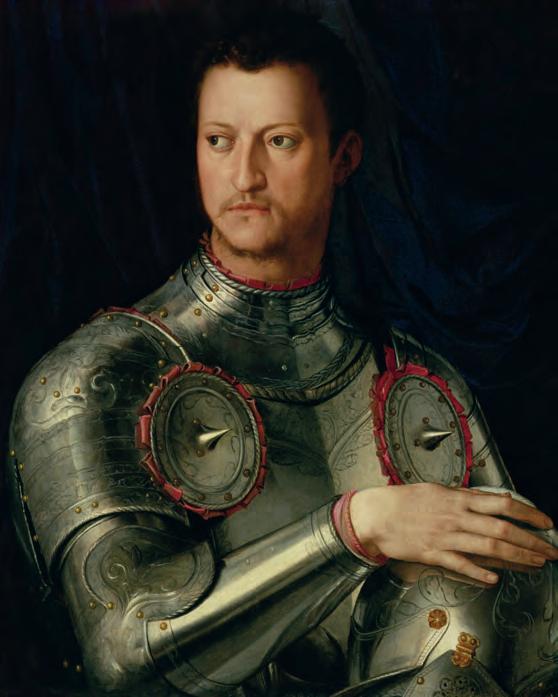
X-radiograph image of the painting, which revealed that the panel had an obscured portrait underneath the figure of Cosimo.10 Simon suggested that the hidden painting may be an earlier portrait of the duke. Recent technical examination undertaken by the Art Gallery of New South Wales using technologies developed since the 1980s, such as high-resolution X-ray Fluorescence (XRF) elemental mapping, has revealed greater details of both the upper and lower portraits on the panel and thrown new light on the development of this extended version of the celebrated composition. It also raises new hypotheses regarding the subject of the lower painting and identifies some potentially related portraits within Bronzino’s œuvre.
In a check-list of the versions of the portrait published in his 1983 article,11 Simon identified the primary, autograph version as being that in the Tribuna of the Galleria degli Uffizi, Florence, which, according to Giorgio Vasari, was painted in 1543 (Fig.2). It was likely followed by the version painted c.1545 that is now in the Muzeum Narodowe, Poznań.12 Shortly after these two half-length portraits were painted, an awkwardly conceived and extended three-quarter-length version (Metropolitan Museum of Art, New York) was attempted by Bronzino’s workshop.13 Bronzino must have completed the Sydney panel by 29th July 1545, as Cosimo is not shown wearing the insignia of the Golden Fleece, bestowed on him by Charles V, which arrived in Florence on that date and was included in subsequent portraits of the duke.14 Simon judged that of all these portraits the Sydney three-quarter-length version is ‘unquestionably the finest of the large format pictures both in its execution and its formal structure’.15 At least twenty-five versions of the Cosimo portrait are known to exist, many of which are variations on this extended length version. They include autograph and workshop versions, as well as later replicas by other hands.
The Sydney version of Cosimo I de’ Medici in armour is remarkably well preserved, having retained the full width of its thick poplar panel without later thinning or cradling. The panel comprises three vertical planks, butt-joined with no pegs or dowels imaged by X-radiography.16 The panel suffered a complete break through the centre at an unknown date. This was repaired with a slight misalignment of the surface plane along the join with two horizontal batons nailed across the break at
separation on other paintings might be evidence of Bronzino’s workshop practice.
18 Inv. no.NG651. See C. Plazzotta and L. Keith: ‘Bronzino’s “Allegory”: new evidence of the artist’s revisions’, THE BURLINGTON MAGAZINE 141 (1999), pp.89–99.
19 Inv. no.1950-86-1. See M.S. Tucker: ‘Discoveries made during the treatment of Bronzino’s “Cosimo I de’ Medici as Orpheus”’, Philadelphia Museum of Art Bulletin 81, no.348 (1985), pp.28–32.
20 See J. Cox-Rearick and M. Westerman Bulgarella: ‘Public and private portraits of Cosimo de’ Medici and Eleonora di Toledo: Bronzino’s paintings of his ducal patrons in Ottawa and Turin’, Artibus et Historiae 25, no.49 (2004), pp.101–59.
21 Musée des beaux-arts et d’archéologie, Besançon, inv. no.D.799.1.29.
22 ‘io la vogl[i]o in quel modo proprio come sta quella et non la vogl[i]o più bella, quasi dicesse non m’entrare in altra invention perché quella mi piace’,
ASF, Mediceo del Principato, vol.1170a, fol.36r, letter from Bronzino to Pier Francesco Riccio, 22nd August 1545.
23 ‘Ieri, che fumo alli XXI del presente, fui con S[ua] E[ccellenza] [Cosimo I] per cagione del Ritratto, dove dissi quanto per vostra s[ignoria] [Riccio] mi fu imposto circa la speditione della Tavola per in Fiandra, et come volendo sua E[ccelenza] che se ne rifacessi un’altra, bisognava stare costì alma[n]co otto o dieci giorni per farne un poco di disegno’, ibid
24 Simon, op. cit. (note 5), p.531.
25 Ibid., p.532, note 19. The Uffizi panel is 71 by 57 cm. and the area within the inscribed lines on the Sydney panel is only slightly larger at 75.6 by 61.7 cm.
26 See C. Gamba: ‘Il ritratto di Cosimo I del Bronzino’, Bollettino d’arte 5 (1925), pp.145–47, cited in Simon op. cit. (note 5), p.531, note 16, as supporting ‘the primacy of the half-length format by maintaining that the three-quarter length versions are later expansions of the original image, executed several years after it and probably by followers of the artist’.
Focus on Bronzino the burlington magazine | 165 | january 2023 6
the back. A line of subsequent filling and retouching down this join also exists, visible in the X-radiograph and other technical images as an anomaly with the original paint. Furthermore, there is a history of paint lifting and tiny losses across the painting that is consistent with published findings on other paintings by Bronzino, and which may relate to the methods he used to achieve his incredibly smooth surfaces.17 The painting was restored in the 1980s by the London-based painting conservator Herbert Lank. The treatment consisted of surface repairs only – the removal of an old varnish and previous restorations as well as minor retouching and the application of a new varnish.
Other paintings by Bronzino that have been studied using X-radiography and infra-red examination provide valuable insights into the artist’s working methodology in general and the evolution of the Sydney panel in particular. For instance, Allegory with Venus and Cupid (c.1545; National Gallery, London) is a complex arrangement of figures that Bronzino modified several times during its development, including altering Cupid’s initial frontal pose to a back view, the original knees of the figure being cleverly reworked as buttocks.18 In the celebrated Portrait of Cosimo I de’ Medici as Orpheus (c.1537–39; Philadelphia Museum of Art) the main figure was initially partially clothed in animal fur before being reworked into full nudity.19 These pentimenti – unusually extensive but not without precedent in Bronzino’s creative process – are hidden by the smooth final renderings of his paintings. The appearance of control, planning and elegant ease of process belie the complex compositional changes revealed through technical analysis.
In contrast to these primary compositions displaying evidence of pentimenti are the replicas of Bronzino’s paintings that he and his workshop were required to make occasionally for distribution to Cosimo’s political patrons.20 In the summer of 1545, for instance, Bronzino painted a large altarpiece, the Lamentation over the dead Christ, for the private chapel of Cosimo’s wife, Eleonora di Toledo, in the Palazzo Vecchio, Florence.21 Once it was completed, however, Cosimo decided to send the altarpiece to Nicolas Perrenot de Granvelle (1486–1550) in Besançon as a diplomatic gift (Granvelle was one of the most trusted advisers of the Emperor Charles V) and requested Bronzino to make a replica for his wife’s chapel. In a letter to Riccio, Bronzino records Cosimo saying to him: ‘I want it exactly as the other and I do not want it more beautiful’.22 That the duke felt the necessity to emphasise his desire for an exact copy suggests that he knew Bronzino’s working processes and compulsive predilection for altering compositions. Further insight into Bronzino’s technique for making replicas of his paintings is revealed in a
note from him to Riccio that it was necessary to make a ‘poco di disegno’ of the Deposition of Christ prior to its dispatch, and this would require eight to ten days.23 This ‘small drawing’ of the two-and-a-half-metrehigh panel was likely to have been a full-scale detailed cartoon used to trace the design directly onto another panel of the same size, which remains in the chapel.
The presence of pentimenti indicates that a painting is a primary composition rather than a copy, which would be made in Bronzino’s studio with the use of a detailed cartoon . Simon observed a visible pentimento in the Uffizi painting, leading him to consider it to be the primary version of the Cosimo de’ Medici in armour prototype 24 Two notable errors in the Sydney painting compared to the Uffizi composition are indicative that the former, at least in the central part, is a replica. The top part of the helmet above the right hand is missing and instead the intended outline is just faintly visible as a curved line, which probably formed part of the transferred drawing from the cartoon that was otherwise hidden after the application of the paint layers (Fig.3). In addition, several rivets on the right forearm vambrace in the Uffizi version have been replaced by a decorative pattern. Notwithstanding these transfer errors, the sheer quality of the execution and such touches as a dab of a finger into the wet red lake pigment around the proper left rondel, breaking up the brushstroke to create a skilful play of reflected light, suggest the virtuosity of the master (Fig.4).
How the extended three-quarter-length composition of the Sydney painting might have evolved from the half-length version has been a matter of much conjecture. Embedded horizontal and vertical lines slightly inside the Sydney panel’s edges are still visible on the painting. Simon suggested that these lines were incised in the gesso and indicated the placement of a cartoon taken from the Uffizi painting. 25 This proposition raised questions regarding the extended compositional elements. Was the whole extended composition conceived and painted as one, including the inscription and broncone, with the commission for a painting for Giovio in mind? Or were the compositional extensions added after a half-length replica was already in place in the panel?26
3. Macro photograph of Fig.1, showing a copying error in which the top edge of the helmet has been drawn (placement indicated with white arrows) but mistakenly painted as background. (© Art Gallery of New South Wales, Diana Panuccio).
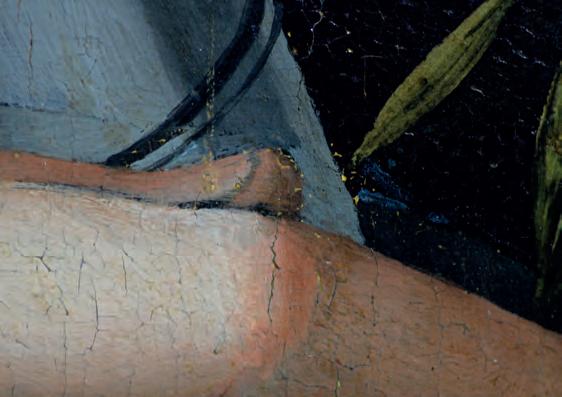
4. Macro photograph of Fig.1, showing the reflection of the red ribbon on the proper left rondel. The ridges of red lake paint suggest they were dabbed, leaving the impression of a fingerprint in the paint. (© Art Gallery of New South Wales, Diana Panuccio).

the
magazine | 165 | january 2023 7
Bronzino’s portrait of Cosimo I de’ Medici in armour
burlington
The 1987 X-radiograph of the painting revealed not a pentimento as such but another portrait underneath the figure of Cosimo in armour. The sitter in this painting wears a cloak and a soft cap and holds an open book. Simon identified two hidden facial contours, ‘one on either side of the visible profile’ of the lower painting, representing ‘at least one other face’ – most likely two different conceptions of a single abandoned portrait.27 The revealed face(s) could represent a younger Cosimo ‘in mufti’, in Simon’s words, as the facial features seem quite close to the duke’s, or they could belong to a completely different subject.28 If the upper and lower paintings are both portraits of the duke, this too might provide new clues to the evolution of the painting and throw light on the development

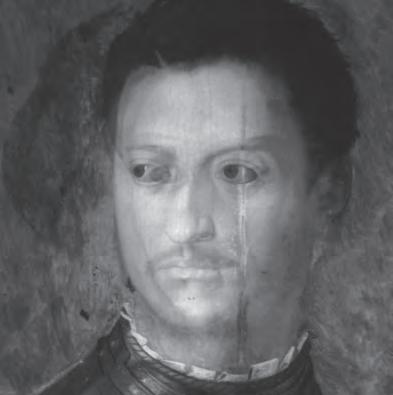

5. Digital X-radiograph of Fig.1. (© Art Gallery of New South Wales, Paula Dredge).
6. Detail of infra-red reflectogram of Fig.1. (© Art Gallery of New South Wales, Paula Dredge).
7. Infra-red reflectogram of Fig.1 with placement of incised lines indicated with white arrows. (© Art Gallery of New South Wales, Paula Dredge).
of this iconic depiction of Cosimo. If the lower portrait is a distinct work, it would raise further questions as to the sitter’s identity and its date, and assist in understanding why it was abandoned.
Seeking clarification of these questions, a new technical investigation of the painting was undertaken using the digital technologies of X-radiography and infra-red reflectography (IRR) alongside synchrotronsourced XRF mapping. Microscopic-sized samples of the paint layers were also examined with scanning electron microscopy and analysed with energy dispersive X-ray spectroscopy (EDX) to assist in establishing the sequential build-up of the layers of paint. 29 X-radiography locates the distribution of pigments of higher-mass elements, such as lead found in the dominant white pigment used in European painting prior to the twentieth century. The new digital X-radiograph of the Sydney panel is of greater clarity than the previously published image (Fig.5).30 It shows a broad brimmed cap and expansive shoulder line, as well as lips, eyes and neck offset lower and to the right of Cosimo’s face, while the pages of a small book are visible at the bottom left of the panel. Due to the transmission technique of traditional X-radiography, the batons and
the burlington magazine | 165 | january 2023 8
Focus on Bronzino
structure of the panel are also strongly imaged, interfering and confusing the image of the paint layers. The difficulty in clearly imaging the lower portrait is also due to the lack of X-ray opaque lead white pigment in the hidden subject’s black cloak and cap.31
In contrast, infra-red light is typically responsive to black pigments and should penetrate to the lower figure, but the armour of the upper figure is also strongly responsive as a result of carbon black being used to create the silver-grey of the steel.32 The infra-red image gives just a faint indication of a book and the face beneath, particularly the shape and outline of the lower figure’s eyes and facial contours (Fig.6). What is shown more clearly in the IRR than the X-radiograph is an anomaly between the paint of the green background inside and outside of the incised lines (Fig.7).
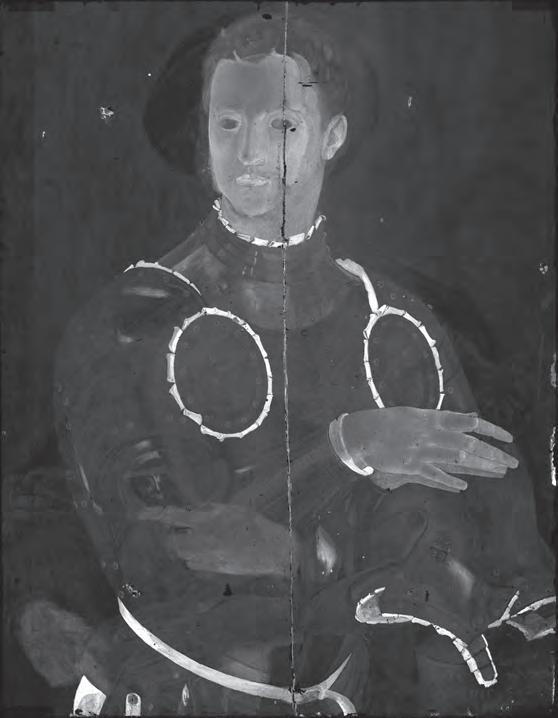
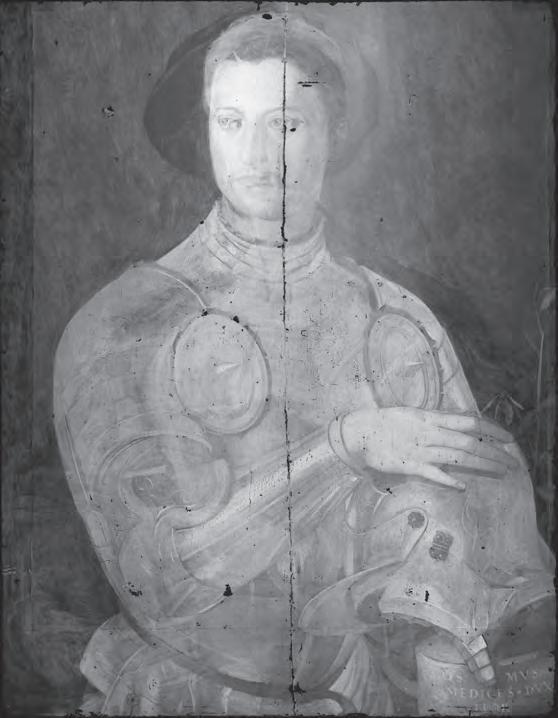
Because of the continuing lack of clarity of the lower painting in the recent X-radiograph and IRR images, the painting was taken to a particle accelerator for XRF mapping.33 The X-ray Fluorescence
27 Simon 1987, op. cit. (note 9), p.388.
28 Ibid
29 This research was undertaken on the XFM beamline at the Australian Synchrotron, Melbourne, part of ANSTO. Scanning Electron Microscope study was undertaken by Will Lawler at ATA Scientific Pty Ltd.
30 Six digital X-radiograph images were collected at 40 kV, 6mA, 30 sec and stitched together using Photoshop image processing.
31 Carbon-based paint is not imaged with X-radiography due to the low molecular weight of the element. In fact, greater X-ray penetration is visible in the black paint areas of the
lower figure, giving a negative outline of the hat and shoulders.
32 An infra-red reflectogram was collected on Osiris Infra-red Camera (Opus) with an indium gallium arsenide line array sensor and operational wavelength 900-1700nm with a cutout filter 760-860nm and mechanical in camera stitching of sixty-four digital tiles, of 16 megapixels each.
33 The painting was analysed at the Australian Synchrotron on 29th–31th August 2019. Pixel size was 150 microns and scan velocity was 60 mm/s, yielding a pixel dwell time of 2.5 msec. The painting was scanned at two different incident energies, 12600 eV
8.
9. XRF scan
Microscopy beamline at the Australian Synchrotron in Melbourne utilises a fast throughput Maia detector alongside a fine-focused X-ray beam, thus enabling elemental imaging of paintings without visual interference from the panel structure. Importantly, all of the elements present in pigments, from silicon (atomic number 14) to bismuth (83), can potentially be imaged with this technique. The elemental imaging of the Bronzino panel included mercury (present in the red pigment vermilion), copper (related to the use of green pigment), tin (correlated with the use of lead tin yellow), iron (present in a range of ochres) and manganese (specific to the use of umber), as well as the trace elements present in these pigments derived from mineral deposits.
and 18500 eV. The 12600 eV energy is below the lead L3 edge (13035 eV), thus avoiding high-intensity lead fluorescence and potentially providing better sensitivity to lighter elements present in the paint pigments. The 18500 eV energy excites lead, thus giving access to this important element in the painting and allows observation of the trace elements strontium and bismuth. The scanning apparatus has a maximum width of approximately 60 cm. Thus the painting width of 66.8 cm. was too long to scan in one pass, but the 86 cm. height of the painting was within scanning limits of approximately 110 cm. Therefore, two scans were
required to investigate the entire surface of the painting. Images were stitched in the FIJI (ImageJ) software using Plugins – Stitching –Pairwise Stitching. The primary artefact after stitching was the carbon fibre holder at the top and bottom, which in some images appears partially faded out. Over the two-day experiment, the painting travelled a total distance of 8 km back and forth on the scanning apparatus. For further details, see D.L. Howard et al.: ‘The XFM beamline at the Australian Synchrotron’, Journal of Synchrotron Radiation 27 (2020), pp.1447–58.
the burlington magazine | 165 | january 2023 9
Bronzino’s portrait of Cosimo I de’ Medici in armour
XRF scan mapping the distribution of lead in Fig.1. (© Art Gallery of New South Wales).
mapping the distribution of mercury in Fig.1. (© Art Gallery of New South Wales).
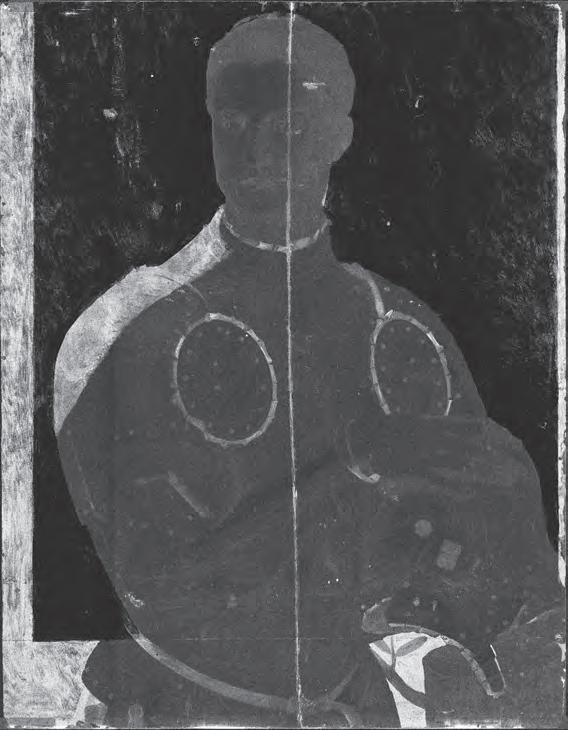
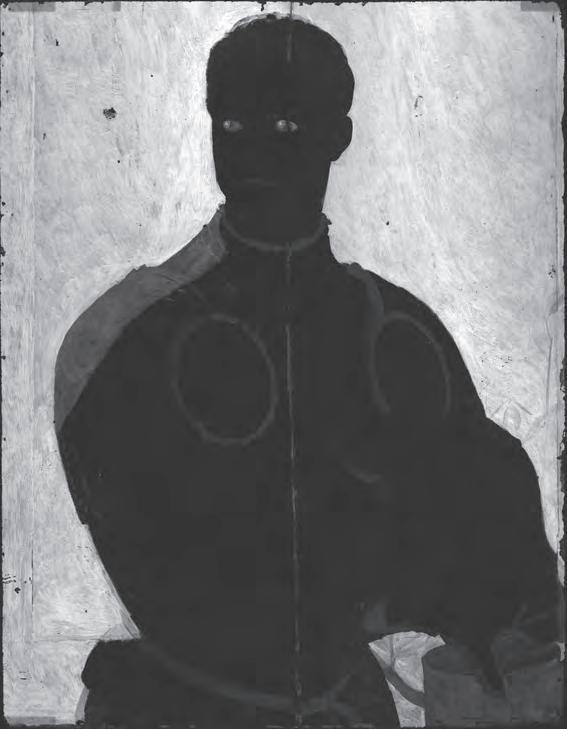
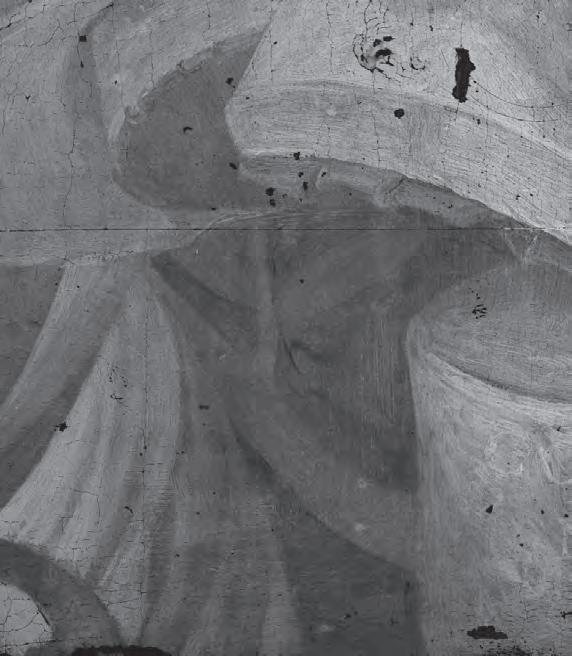
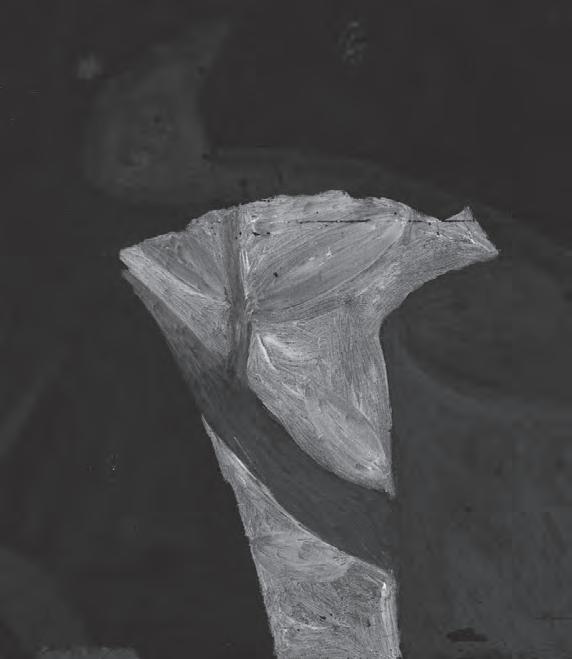
the burlington magazine | 165 | january 2023 10
Focus on Bronzino
Opposite, clockwise from top left
10. Detail of the XRF copper map of Fig.1, showing an inscribed horizontal line on the lower-right side passing through the broncone and the additional leaves of the side branch. (© Art Gallery of New South Wales).
11. Detail of the XRF lead map of Fig.1, showing an inscribed horizontal line on the lower-right side passing through the broncone and the additional leaves of the side branch. (© Art Gallery of New South Wales).
12. XRF scan mapping the distribution of arsenic in Fig.1. (© Art Gallery of New South Wales).
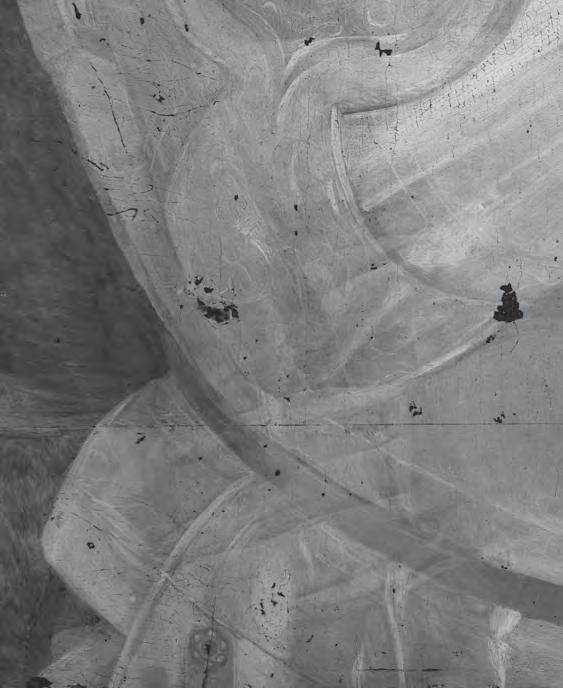
13. XRF scan mapping the distribution of copper in Fig.1. The black and white arrows indicate the green copper-based azurite pigment embedded into the indentation left in the surface after inscribing lines and the painting out of armour at the waist in preparation for cutting the panel. (© Art Gallery of New South Wales).
14. Detail of Fig.8, showing an inscribed horizontal line on the lower-left side with removal of lead. (© Art Gallery of New South Wales).
The elemental distributions were mapped across the painting, with single greyscale images representing individual elements. For each image, the variable concentrations throughout the painting are indicated by tonal differences: the brighter areas correspond to a higher concentration of the specific element and its associated pigment. Each pixel of the digital image is the XRF spectral result from an area of 150 microns in diameter on the painting (the size of the incident beam on contact with the surface). The maps are accumulated from the analytical results of adjacent areas across the entire surface giving a sharp definition to the fine application of painted details and the brushwork on the painting.
The XRF map from the fluorescence of the element lead resembles a traditional X-radiograph, imaging the use of lead white pigment unimpeded by the visual disturbance of the panel and baton additions at the back (Fig.8). The XRF mercury map indicates the use of vermilion pigment in the opaque bright red colour used for the flesh tone and the warm reflections of the armour as well as its velvet lining (Fig.9). The consistency of the paint and brushwork of the armour across the horizontally inscribed line – seen in both lead and mercury maps –indicates that the three-quarter-length composition was conceived and executed simultaneously. Both maps further demonstrate that the lower horizontal line is not a preparatory guide for the placement of a cartoon in the gesso as Simon suggested, but is instead the result of paint from the armour being removed afterwards (Fig.14). However, the sharp and fine incision lines must most likely have occurred in the artist’s studio before the paint had fully dried and become brittle. The broncone was also painted during this same stage of painting. The XRF copper and lead maps show the laurel shoot emerging from the left side of the stump underneath the helmet with four leaves and continuing vertically upwards (Figs.10 and 11). The two larger leaves beneath the helmet were also scratched by the inscribed horizontal line visibly in both maps, confirming their early presence in the composition.
In contrast, the background appears to have been painted in two separate stages, inside and outside the inscribed lines (as previously indicated by the infra-red image; see Fig.7). The copper map identifying the copper-based azurite pigment used for the green curtain background shows a discontinuity of the brushstrokes across the lines (Fig.13). Furthermore, a difference in the concentration of the trace element arsenic inside and outside the lines is also apparent in the XRF arsenic map (Fig.12). Because of this anomaly, micro-samples of paint were taken from
34 Scanning electron microscope and energy dispersive X-ray spectroscopy analysis was undertaken with a G5 Phenom ProX.
35 A technical study of historic azurite pigment has demonstrated a variety in the trace elements typically present, which included arsenic in the
the edges of pre-existing paint losses, set in polyester resin and polished back to reveal the layers of the painting (Figs.15–17). The cross sections obtained show that the portrait’s dark green background comprises a rich deep green azurite alongside a little lead white layered with a red lake glaze to create the shadows of the curtain. A large green azurite crystal in the cross section taken from the background outside the inscribed line was analysed with a scanning electron microscope (SEM) with energy dispersive X-ray spectroscopy (EDS) analysis (see Fig.15).34 It revealed that there were two distinct elemental phases on the azurite crystals from this area – one containing copper and the other arsenic (as well as calcium and magnesium). Conversely, a similar sample taken from inside the inscribed line showed the azurite pigment particles did not contain an arsenic phase (see Fig.16). This result indicates that there were at least two chemically distinct batches of azurite in use in Bronzino’s studio.35
The best fit for the differences observed in the technical images and XRF maps is that after completing the expanded three-quarter-length figure but prior to painting the green curtain background, the decision was made to reduce the painting back to the half-length format of the Uffizi version. The vertical and horizontal lines were inscribed into the still-pliable paint to indicate the reduced size. Prior to cutting the panel, the azurite background was applied around Cosimo up to the inside edges of the inscribed lines and across a small section of armour below his waist at the lower left, which was no longer required in the reduced format (see Fig.13 with the area of azurite paint over the armour at the waist indicated with arrows).
Italian and Dutch samples but not the French. See L. Smieska, R. Mullett, L. Ferri and A. Woll: ‘Trace elements in natural azurite pigments found in
illuminated manuscripts investigated by synchrotron X-ray fluorescence and diffraction mapping’, Applied Physics A 123, no.7 (June 2017), article no.484.
the
11
Bronzino’s portrait of Cosimo I de’ Medici in armour
burlington magazine | 165 | january 2023
For undiscovered reasons, however, the plan to cut the panel and reduce the composition back to the half-length format was not carried out. The green background was therefore continued beyond the incised area to the edges of the panel, this time using the batch of azurite containing trace amounts of arsenic. The small patch of armour at the lower-left waist was reinstated (Fig.18). The background surrounding the part of the broncone, which is underneath the helmet, was also repainted and two small leaves were painted over, leaving in place only the two larger leaves. These minor modi cations revealed by analytical examination can therefore be regarded as true pentimenti on the Sydney version of Cosimo I de’ Medici in armour. The three-quarter-length composition, although originally painted in full on the large panel, was extensively modi ed during deliberations whether to reduce it to the half-length format, however, ultimately the decision was to retain the larger format.36 Once completed in its original large format, the portrait was sent to Paolo Giovio, who received it enthusiastically.
The various issues relating to the modi cations of the composition are partially the result of the panel having originally been used for a di erent painting, as revealed in the X-ray, IRR and XRF images. The striking composite image of the two elemental maps of iron and mercury, overlaid and colour-ta ed, gives the best picture of the lower painting, despite being partly obscured by the presence of the overlying portrait (Fig.19). By examining each elemental map in turn and tracing the features that are not visible in the nished painting onto a single image, it is possible further to clarify the underlying work (Fig.20).



The image demonstrates Bronzino’s organic approach to composition, dynamically evolving and revising his subject on the panel. The most dramatic feature appears in the mercury map showing the artist’s use

of the bright red vermilion pigment (see Fig.9). It provides us with a remarkable image of at least three new hands. This accords well with the hypothesis that we are seeing two di erent conceptions of a single abandoned portrait.37 The fact that the hands appear in the mercury map but only faintly in the lead map shows that they were initial thoughts, thinly sketched in vermilion alone and not yet worked up in pale esh tones with the addition of lead white. The sitter’s left hand can be seen clearly in two di erent positions. The upper attempted hand is strongly drawn, with the index nger extended and holding an open book. The second left hand appears lower down with all ngers extended, possibly resting upon a supporting edge. The sitter’s right hand can be distinctly seen in the lower-left corner, loosely sketched but clearly formed, close to and level with the lower left hand. The








Left, top to bottom



15–17. Paint cross sections and SEM backscattered electron images of the painting illustrated in Fig.1. Locations of sample sites are indicated by the white letters in Fig.18.
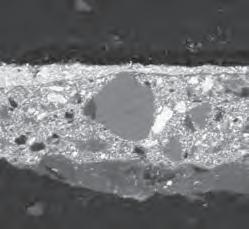
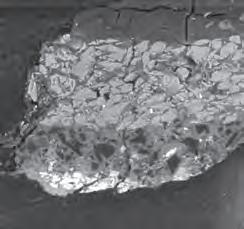
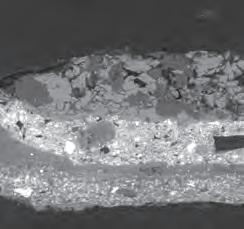
15. Paint cross section outside the inscribed line showing two phases of blue/green azurite crystals, one circled in white.



16. Paint cross section of the green background inside the inscribed area showing a single phase of azurite crystals.




17. Paint cross section on the shoulder showing a thin layer of leadbased paint from armour with grey/green background from the l ower painting and a two-phase azurite pigment circled in white. (© Art Gallery of New South Wales, Paula Dredge).
18. Purple indicates the areas of copper-based azurite background containing arsenic (outside the inscribed line and upper shoulder). Red indicates the area of copper-based azurite background that does not contain arsenic. Green indicates the area of copper-based azurite background not containing arsenic but repainted. (© Art Gallery of New South Wales, Paula Dredge).




Focus
THE BURLINGTON MAGAZINE | 165 | JANUARY 2023 12
on Bronzino
a b c a c b
index finger and thumb are extended, perhaps resting on or holding an unknown object. A second right hand may also be visible in an upper position but the overlap with the folds of the sleeve at the elbow makes it difficult to interpret.
Both copper and arsenic maps indicate that there was a background in place for the lower painting before being hidden by the deep green curtain of Cosimo I de’ Medici in armour (see Figs.12 and 13). This first background is imaged most clearly at the proper right shoulder showing an area underneath the thin paint layer that depicts the armour (see Fig.12). This shows that the azurite pigment containing arsenic, which was later used to complete the background of the upper portrait (between the inscribed line and the outer edge of the panel), also appears in the lower portrait (visible at the shoulder) and may indicate the use of the same batch of azurite pigment for both paintings. A cross section taken from this area shows that the background colour
36 Resizing panels, both enlarging and reducing, to incorporate changes to compositions during painting is apparent in the examination of several other paintings by Bronzino and was evidently part of the artist’s practice. For instance, an additional strip on the left side of An allegory with Venus and Cupid permitted the extension of Cupid’s wing and the addition of
the forearm of Jealousy; see Plazzotta and Keith, op. cit. (note 22), p.95, fig.40. Portrait of a young man (1550–55; Nelson-Atkin Museum of Art, Kansas City) is believed to have been cut down during the process of altering the composition; see E.W. Rowlands: The Collections of the Nelson-Atkins Museum of Art: Italian Paintings 1300–1800, Kansas City
of the lower portrait was a pale, cool grey made from carbon black, lead white and a small amount of the azurite containing the arsenic anomaly (see Fig.17).
Other elemental maps, such as the lead and mercury maps, clarify the contours of the sitter’s cloak and broad hat (see Figs.8 and 9). The elegant garments as well as the book indicate that the sitter was a member of the elite whose appearance is reminiscent of the aristocrat and scholar depicted in an earlier portrait by Bronzino, Ugolino Martelli (1537–38; Staatlische Museen, Gemäldegalerie, Berlin).38 The art historian Elizabeth Cropper has studied the influence of Bronzino’s teacher and mentor, Jacopo Carruci, known as Pontormo (1494–1557), on his pupil’s early portraits.39 Comparing Bronzino’s Portrait of Guidobaldo della Rovere (1532; Galleria Palatina, Palazzo Pitti, Florence) with Pontormo’s Portrait of a halberdier (1529–30; J. Paul Getty Museum, Los Angeles), she notes that it is the ‘head and shoulders that are closely replicated here. The threequarters format, the way the head is set on the shoulders, the center line of the chest, [. . .] the simplicity of the green curtained background, and, above all, the direct gaze, all confirm that Bronzino had his teacher’s most recent portrait in mind’.40 Pontormo’s influence was evidently still being felt in the lower portrait Bronzino began on the Sydney panel, notably in
and Seattle 1996, pp.181–88, no.22.
37 See Simon 1987, op. cit. (note 9), p.388.
38 Inv. no.338A, oil on panel, 102 by 85 cm. Further comparisons with the lower subject can be made with Bronzino’s earlier portraits, most noticeably his Portrait of a young man with a book (1530s; Metropolitan Museum of Art, New York, inv. no.29.100.16, oil on
panel, 95.6 by 74.9 cm).
39 E . Cropper: Pontormo: Portrait of a halberdier , Los Angeles 1997.
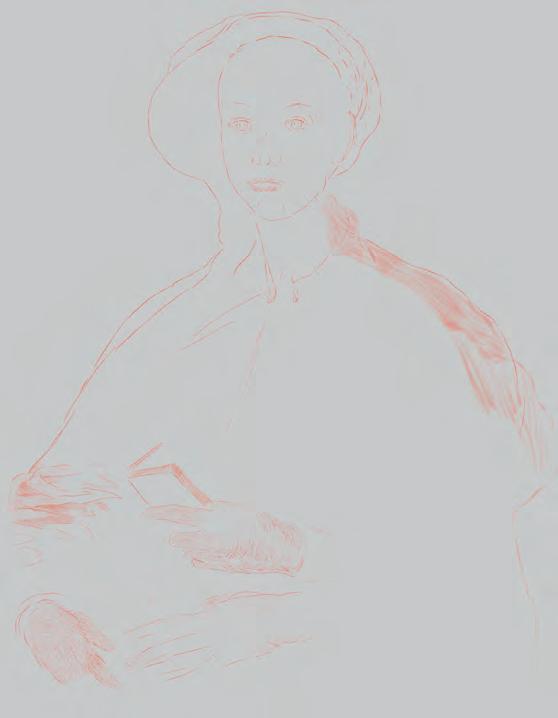
40 Galleria Palatina, Palazzo Pitti, Florence, inv. no.21941, oil on panel, 114 by 86 cm.; and J. Paul Getty Museum, Los Angeles, inv. no.89.PA.49, oil on panel transferred to canvas, 95.3 by 73 cm. See Cropper, op. cit. (note 39), p.90.
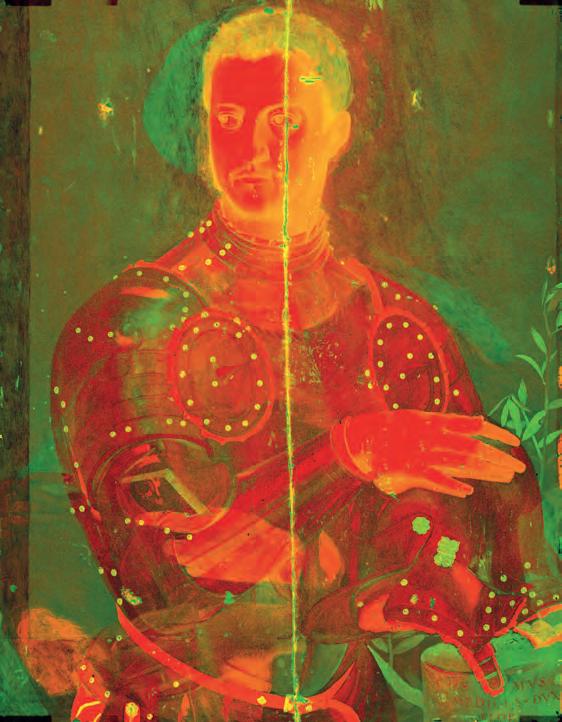
the burlington magazine | 165 | january 2023 13
Bronzino’s portrait of Cosimo I de’ Medici in armour
19. Composite XRF scan map of Fig.1 showing mercury (red) and iron (green). (© Art Gallery of New South Wales).
20. Red line trace of all features present in the infra-red image and XRF iron, copper, lead and mercury maps of Fig.1 that are not visible on the painting. (© Art Gallery of New South Wales, Simon Ives).
the compositional and chromatic similarities.41 The lower painting shares striking similarities with another portrait by Pontormo which is generally held to depict Cosimo I de’ Medici, Portrait of Cosimo I de’ Medici (Fig.21). There is a noted correspondence of the overall design, the contour of the sitter’s shoulders, and aspect of the head and facial features, and most compellingly, the lower pair of hands, though Bronzino places them further to the left. These comparisons suggest that Bronzino may have had this particular portrait by Pontormo in mind in his first conception sketched on the Sydney panel.
Given Bronzino’s well-documented propensity for radically reshaping his compositions, one can only speculate on what form the final image might have taken had it been completed. The overpainted figure – with his seated pose, black garb, book in hand and frontal gaze, set against a pale neutral background – may be placed between Bronzino’s early compositions still influenced by Pontormo and a later painting of an unidentified sitter, Portrait of a young man (Fig.24).42 The similarity of the overall composition and the sitter’s dress as well as the facial likenesses are compelling.
A rare drawing by Bronzino, Head of a man (Fig.22), which has been identified as being a study for the Nelson-Atkins Portrait of a
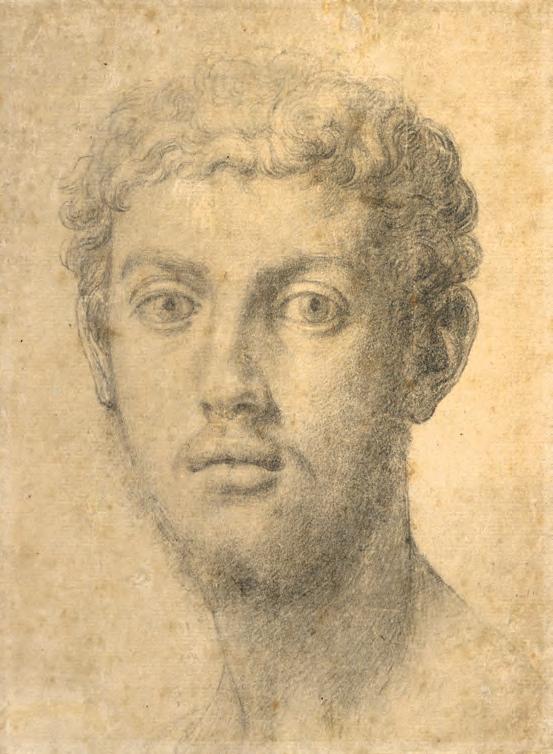
21. Portrait of Cosimo I de’ Medici, half-length, in a black slashed doublet and a plumed hat, holding a book, by Jacopo Pontormo. c.1537–
38. Oil (or oil and tempera) on panel, 100.6 by 77 cm. (Private collection; Bridgeman Images).
22. Head of a man, by Agnolo Bronzino. c.1550–55. Black chalk on paper, 13.8 by 10.3 cm. (J. Paul Getty Museum, Los Angeles).
young man, was digitally rescaled and layered with a tracing of the face of Sydney lower painting (Fig.23). 43 The degree of alignment of the facial features is remarkable, with the rounded eyes and the contours of the face matching almost exactly. Furthermore, the soft hat and black cloak, the overall posture of the sitter, the shape of the outer contour of his shoulders as well as the position of his right hand suggest a close proximity between the two compositions (see Fig.24). Any direct relation to the Nelson-Atkins Portrait of a young man and the Getty drawing is complicated, however, by the fact that the unfinished Sydney portrait was carried out at least five years before the accepted date (c.1550–55) of the Nelson-Atkins portrait.
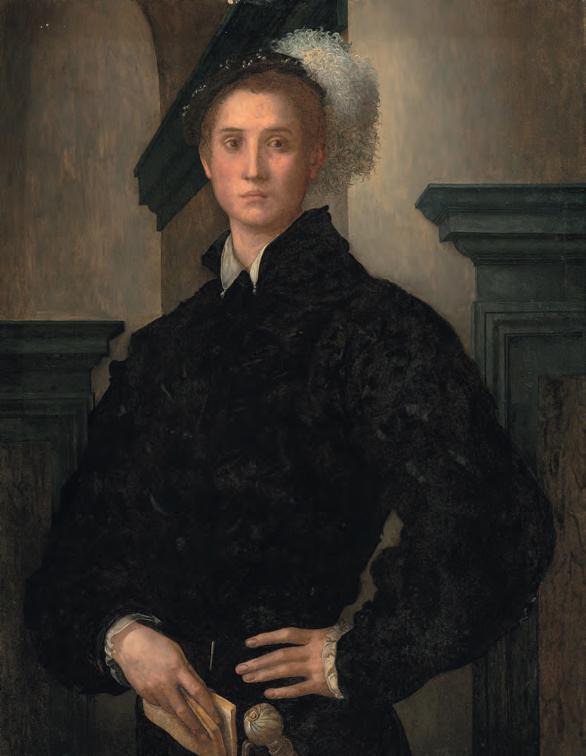
Details of the development of the Nelson-Atkins portrait were revealed by a thorough technical study conducted in the early 1990s.44
In an intriguing reversal of the sequence discovered on the Sydney panel, the study showed that the young man portrayed in a cloak had been initially conceived wearing armour. The sitter’s left hand was initially absent, hidden behind an ovoid shield with the right hand resting on something, possibly a helmet. The sitter then underwent a radical change of costume, exchanging the armour for a doublet, and finally the cloak and hat, which are similar to those worn by the subject of the lower Sydney painting. The Nelson-Atkins young man’s hands hold a sword, while the Sydney sitter rests his lower right hand on something not apparent or not depicted. Bronzino’s capacity to radically transform a single work from a figure in armour to one in a cloak and hat, as revealed by the examination of the Nelson-Atkins portrait, is interesting to keep in mind when considering the Sydney panel. The hidden portrait mapped
the burlington magazine | 165 | january 2023 14
Focus on Bronzino
23. Fig.22 superimposed on the face of the Sydney lower painting red line trace in Fig.20. (Photograph © Art Gallery of New South Wales, Simon Ives).
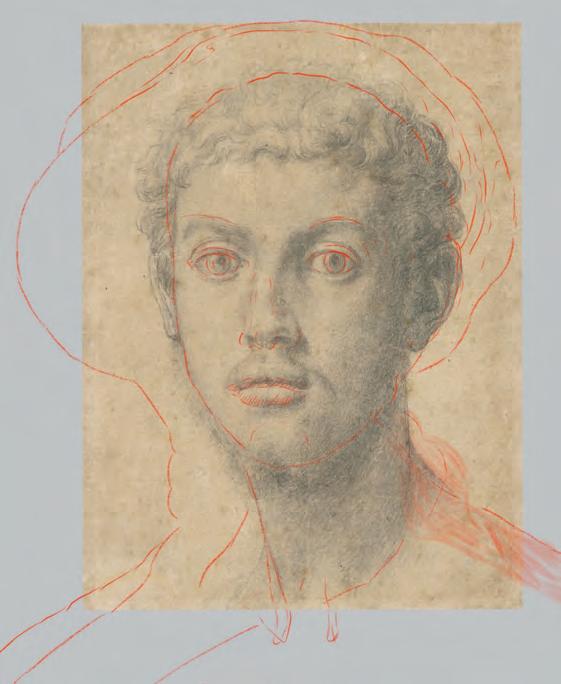
24. Portrait of a young man, by Agnolo Bronzino. 1550–55. Oil on panel, 85.73 by 68.58 cm. (Nelson-Atkins Museum of Art, Kansas City), and Fig.20 superimposed. (Photograph © Art Gallery of New South Wales, Simon Ives).
at the Synchrotron is of sufficient clarity to reveal the dynamic working method inherent in Bronzino’s creative process. The multiple hands along with the variations in the face also support Simon’s identification of two conceptions of a single portrait in progress.
If the likeness to Cosimo is accepted, the lower painting could be read as a preceding attempted portrait of the duke as an elegant gentleman and scholar rather than a warrior. If this concept was then rejected by Bronzino for a more forceful depiction of the duke in armour, in greater accord with the requirements for ‘a man capable of battle but triumphing through peaceful means’, the latter was originated on a new panel, the portrait in the Uffizi.45 Alternatively, it is possible that the lower Sydney painting is the development of an unrelated portrait of a young Florentine nobleman, whose identity is currently unknown. This initial attempt was eventually abandoned, and the panel was instead used to expand the primary half-length Uffizi composition to create the primary three-quarter-length version of Cosimo I de’ Medici in armour. If the lapse of time between the execution of the two portraits of the Sydney panel is still unclear, the similar chemical composition of the azurite used in the background of both suggests some proximity. However, the resemblance of the lower Sydney painting to the Nelson-Atkins Portrait of a young man – the similarity of the composition and the apparent use of the Getty drawing as the basis for the sitter’s face in both cases as well as the comparable neutral coloured background – suggests that the two paintings are related. It is possible, therefore, that the Nelson-Atkins panel represents the completion of the abandoned portrait, which was not, therefore, a depiction of Cosimo.46

Although ultimately not carried out, the decision to reduce the three-quarter-length format may have been a response to Cosimo’s preference for a replica without additional inventions, as in the case of the replica altarpiece for Eleonora di Toledo’s chapel. Or perhaps Bronzino was unsatisfied with the extended composition, because either of its awkward placement of the hips, necessitated by a need to show the broncone attached to the tree trunk, or the overall composition being squeezed into a less than ideal pre-determined size. These modifications have been revealed as artistic deliberations rather than simple copying errors and they indicate an original composition that was worked on by the master. In undertaking the portrait of the young duke using the format of a panel that had already been partially painted, Bronzino achieved an enduring archetype, the most successful portrait of the recently appointed ruler of Florence.
41 Other indications of Bronzino’s early style, such as an architectural background, are, however, absent.
42 Nelson-Atkins Museum of Art, Kansas City, inv. no.49-28, oil on panel, 85.7 by 68.6 cm.
43 J. Paul Getty Museum, Los Angeles, inv. no.90.GB.29, black chalk on paper, 13.8 by 10.3 cm. On this drawing and its link to the Nelson-Atkins painting, see C.C. Bambach et al.: exh. cat.
The Drawings of Bronzino, New York (Metropolitan Museum of Art) 2010, pp.204–05, no.54.
44 See Rowlands, op. cit. (note 22), pp.181–88, no.22.
45 Simon, op. cit. (note 5), p.535.
46 Since the submission of the
present article, a further attempt has been made to identify the sitter of the Nelson-Atkins portrait. In K. Christiansen and C. Falciani, eds: exh. cat. The Medici, Portraits and Politics 1512–1570, New York (Metropolitan Museum of Art) 2021, pp.256–57, the authors propose to identify the sitter with Francesco Guadagni, a young nobleman descendant of the newly established Florentine branch of the Guadagni family, and the rising son of one of Bronzino’s important patrons. This identification would consolidate the hypothesis of the sitter’s Sydney lower painting as a young aristocrat representative of the new Florentine society.
the burlington magazine | 165 | january 2023 15
Bronzino’s portrait of Cosimo I de’ Medici in armour
23. Fig.22 superimposed on the face of the Sydney lower painting red line trace in Fig.20. (Photograph © Art Gallery of New South Wales, Simon Ives).

24. Portrait of a young man, by Agnolo Bronzino. 1550–55. Oil on panel, 85.73 by 68.58 cm. (Nelson-Atkins Museum of Art, Kansas City), and Fig.20 superimposed. (Photograph © Art Gallery of New South Wales, Simon Ives).
at the Synchrotron is of sufficient clarity to reveal the dynamic working method inherent in Bronzino’s creative process. The multiple hands along with the variations in the face also support Simon’s identification of two conceptions of a single portrait in progress.
If the likeness to Cosimo is accepted, the lower painting could be read as a preceding attempted portrait of the duke as an elegant gentleman and scholar rather than a warrior. If this concept was then rejected by Bronzino for a more forceful depiction of the duke in armour, in greater accord with the requirements for ‘a man capable of battle but triumphing through peaceful means’, the latter was originated on a new panel, the portrait in the Uffizi.45 Alternatively, it is possible that the lower Sydney painting is the development of an unrelated portrait of a young Florentine nobleman, whose identity is currently unknown. This initial attempt was eventually abandoned, and the panel was instead used to expand the primary half-length Uffizi composition to create the primary three-quarter-length version of Cosimo I de’ Medici in armour. If the lapse of time between the execution of the two portraits of the Sydney panel is still unclear, the similar chemical composition of the azurite used in the background of both suggests some proximity. However, the resemblance of the lower Sydney painting to the Nelson-Atkins Portrait of a young man – the similarity of the composition and the apparent use of the Getty drawing as the basis for the sitter’s face in both cases as well as the comparable neutral coloured background – suggests that the two paintings are related. It is possible, therefore, that the Nelson-Atkins panel represents the completion of the abandoned portrait, which was not, therefore, a depiction of Cosimo.46

Although ultimately not carried out, the decision to reduce the three-quarter-length format may have been a response to Cosimo’s preference for a replica without additional inventions, as in the case of the replica altarpiece for Eleonora di Toledo’s chapel. Or perhaps Bronzino was unsatisfied with the extended composition, because either of its awkward placement of the hips, necessitated by a need to show the broncone attached to the tree trunk, or the overall composition being squeezed into a less than ideal pre-determined size. These modifications have been revealed as artistic deliberations rather than simple copying errors and they indicate an original composition that was worked on by the master. In undertaking the portrait of the young duke using the format of a panel that had already been partially painted, Bronzino achieved an enduring archetype, the most successful portrait of the recently appointed ruler of Florence.
41 Other indications of Bronzino’s early style, such as an architectural background, are, however, absent.
42 Nelson-Atkins Museum of Art, Kansas City, inv. no.49-28, oil on panel, 85.7 by 68.6 cm.
43 J. Paul Getty Museum, Los Angeles, inv. no.90.GB.29, black chalk on paper, 13.8 by 10.3 cm. On this drawing and its link to the Nelson-Atkins painting, see C.C. Bambach et al.: exh. cat.
The Drawings of Bronzino, New York (Metropolitan Museum of Art) 2010, pp.204–05, no.54.
44 See Rowlands, op. cit. (note 22), pp.181–88, no.22.
45 Simon, op. cit. (note 5), p.535.
46 Since the submission of the
present article, a further attempt has been made to identify the sitter of the Nelson-Atkins portrait. In K. Christiansen and C. Falciani, eds: exh. cat. The Medici, Portraits and Politics 1512–1570, New York (Metropolitan Museum of Art) 2021, pp.256–57, the authors propose to identify the sitter with Francesco Guadagni, a young nobleman descendant of the newly established Florentine branch of the Guadagni family, and the rising son of one of Bronzino’s important patrons. This identification would consolidate the hypothesis of the sitter’s Sydney lower painting as a young aristocrat representative of the new Florentine society.
the burlington magazine | 165 | january 2023 15
Bronzino’s portrait of Cosimo I de’ Medici in armour
focus on bronzino
Bronzino’s ‘Petrarch’ retrieved: new light on Bartolomeo Bettini’s ‘camera’
In about 1531 Bronzino was commissioned by the banker Bartolomeo Bettini to paint portraits of Dante, Petrarch and Boccaccio for a room in his house in Florence. All were believed lost until the rediscovery in 2002 of the ‘Dante’. A painting of Petrarch is here identified as a record of Bronzino’s composition and it is argued that an anonymous painting of Boccaccio may be derived from the third of Bettini’s portraits.
by jeroen stumpel
In 1941 the italian journal L’Arte published black-and-white photographs of a pair of oval paintings in a private collection in Italy that were described as portraits of Dante Alighieri and Petrarch by Pontormo (Figs.1 and 2). There are more recent colour photographs of them in the Fondazione Federico Zeri, Bologna (Figs.4 and 5), where the paintings are attributed to Giovanbattista Naldini (c.1535–91).1 This may well be correct, but the source of the compositions is almost certainly Agnolo Bronzino (1503–72). In 2002 a larger painting of Dante by Bronzino, which is obviously the
prototype for the oval portrait of the poet, was discovered in an Italian private collection and published by Philippe Costamagna (Fig.3).2 The close correspondence between the two paintings makes it more than likely that the oval pendant of Petrarch also derived from a composition by Bronzino. It will be argued here that this can be confirmed by an intriguing picture in an Italian private collection, published here for the first time (Fig.8), the composition of which clearly seems to be the model 1 and 2. Portraits of Dante and Petrarch published as works by Pontormo. (From L’arte, November 1941, pp.xvii and xix).
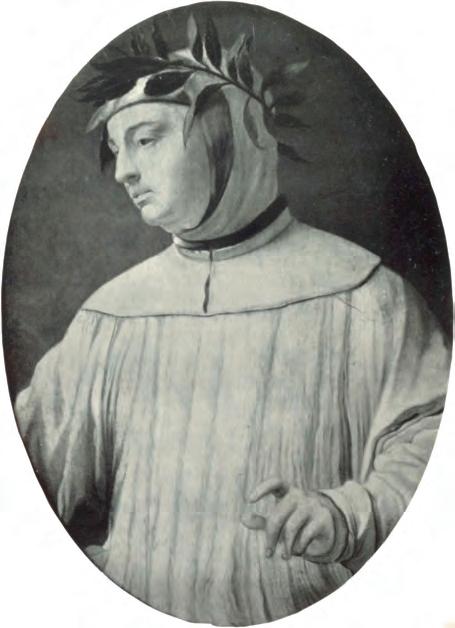
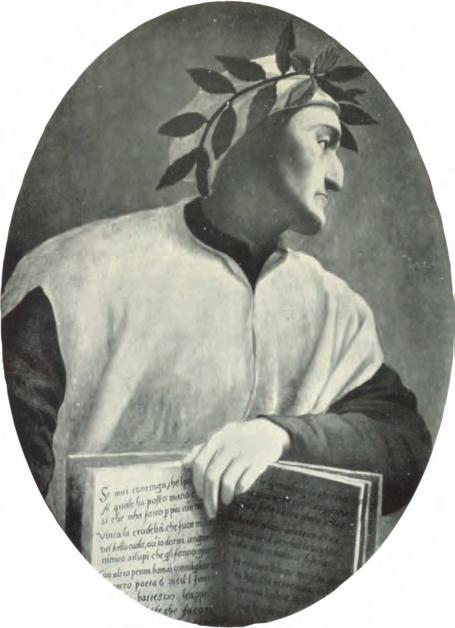
the burlington magazine | 165 | january 2023 16
for the oval version. Its discovery also sheds new light on the series of paintings to which Bronzino’s Dante originally belonged.


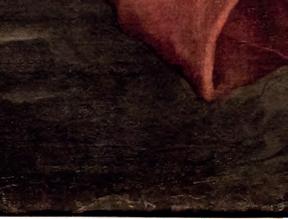

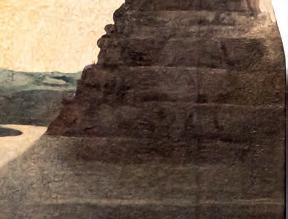
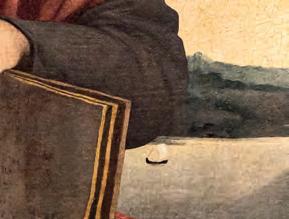
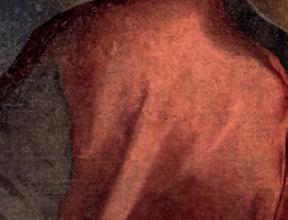

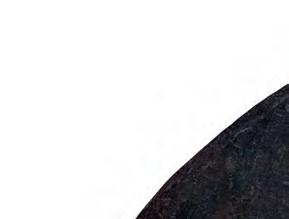
The painting, which is on canvas, depicts Petrarch, half-length, seen from a low viewpoint. Crowned with a poet’s laurel wreath, he is dressed in a manner familiar from images of Petrarch from the fourteenth century onwards, with a cap and cape to denote he had taken minor orders and acquired a canonical bene ce.3 The head, parts of which are beautifully painted, clearly surpasses the oval in quality and mood (Figs.6 and 7). Discussion of the authorship of the painting is however hampered by its less than pristine condition. No de nitive judgment can be made until it is cleaned and a technical examination
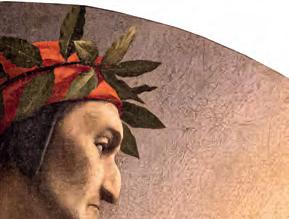
The author is much indebted to the Dutch University Institute for Art History (NIKI) in Florence for the opportunity to conduct this research.
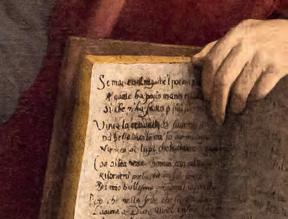
1 The reproductions in L’Arte are mentioned (not reproduced) in J.K.
Nelson: ‘Dante portraits in sixteenthcentury Florence’, Gazette des BeauxArts 120 (1992), pp.64–71. According to


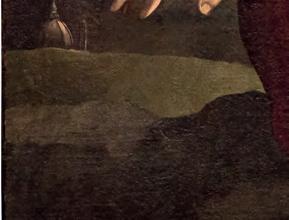
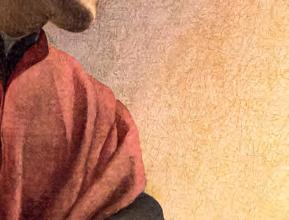
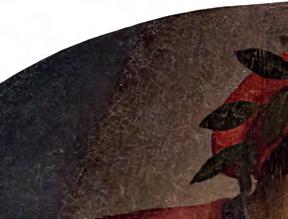
the information accompanying the photographs in the Fondazione Federico Zeri, the paintings were formerly in the collection of Marchese G. Capponi, Florence, and were subsequently offered at the Mercato Antiquario, Milan, in 1970. The author is very grateful to Sanne Wellen for informing him about the presence of these
3. Allegorical portrait of Dante, by Agnolo Bronzino. c.1532. Oil on canvas, 130 by 136 cm. (Private collection).

can be made, but the present owners are reluctant to embark on such initiatives. There are compelling reasons, however, to argue that at the very least the painting records an important composition by the young Bronzino that was hitherto known only from references to it in the sixteenth century.
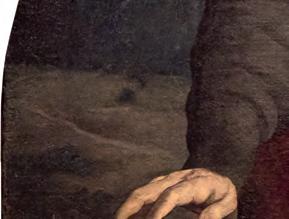
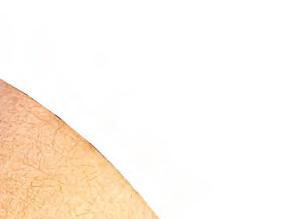
Two well-known passages in Giorgio Vasari’s Lives relate the circumstances of how in about 1531 Bronzino was commissioned to paint these portraits. Having returned to Florence from Pesaro, where he had painted ‘a number of gures in oils on the spandrels of a vault’ in the Villa
photographs in the Fondazione Federico Zeri.
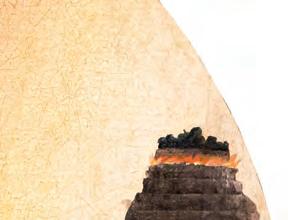
2 P. Costamagna: ‘De l’idéal de beauté aux problèmes d’attribution: vingt ans de recherché sur le portrait florentin au XVIe siècle’, Studiolo, revue d’histoire de l’art de l’académie de France à Rome 1 (2002), pp.193–220, at pp.208–09.
3 For the iconography of Petrarch’s
portraits, see, for example, S. Pinto: ‘Petrarca nel tempo’ in E. Bordignon Favero, ed.: Per Maria Cionini Visani: scritti di amici, Florence 1977, pp.143–46; and C.B. Strehlke: exh. cat. Pontormo, Bronzino and the Medici: The Transformation of the Renaissance Portrait in Florence, Philadelphia (Museum of Art) 2004.
THE BURLINGTON MAGAZINE | 165 | JANUARY 2023 17
4. Dante Alighieri, attributed to Giovanbattista Naldini. 1550–1600. Oil on panel. (Photograph Fondazione Federico Zeri, Bologna).
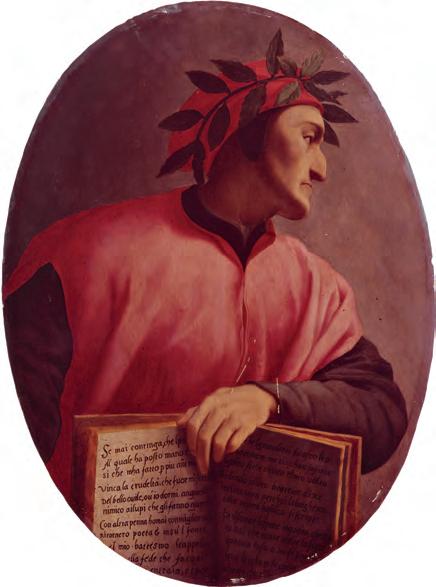
5. Petrarch, attributed to Giovanbattista Naldini. 1550–1600. Oil on panel. (Photograph Fondazione Federico Zeri, Bologna).
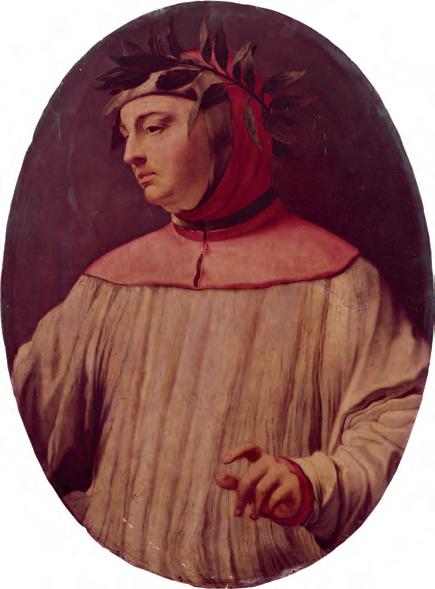
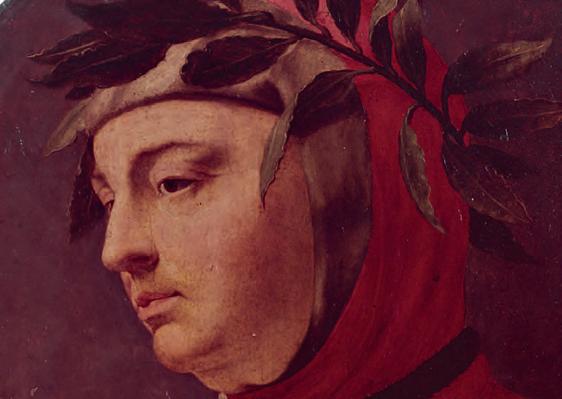
Imperiale,4 he was asked by the banker Bartolomeo Bettini to undertake a similar commission by painting ‘certain lunettes in a chamber, the portraits of Dante, Petrarch, and Boccaccio, half-length figures of great beauty’.5 In the next sentence Vasari tells us that Bronzino, ‘having finished these paintings’, engaged to make a number of other portraits for different patrons. That he produced at least three paintings for Bettini is confirmed by a passage in Vasari’s Life of Pontormo in which it is recorded that Michelangelo, who was Bettini’s ‘suo amicissimo’ (‘most dear friend’)
made for him a cartoon of a nude Venus with a Cupid who is kissing her, in order that he might have it executed in painting by Pontormo and place it in the centre of a chamber of his own, in the lunettes of which he had begun to have painted by Bronzino figures of Dante, Petrarch and Boccaccio, with the intention of having there all the other poets who have sung of love in Tuscan prose and verse.6
4 ‘Lavorò anche all’Imperiale, villa del detto duca [Guidobaldo della Rovere], alcune figure a olio ne’peducci d’una volta’. They are in the so-called Sala dei Semibusti (where they remain); see G. Vasari: Le vite de’ più eccellenti pittori scultori ed architettori, ed. G. Milanesi, Florence 1878–85, VII, p.595.
5 ‘i quali quadri finiti, ritrasse Bonacorso Pinadori’, ibid., pp.291–95.
6 ‘che il Buonarotti suo amicissimo gli fece un cartone d’una Venere ignuda con un Cupido che la bacia, per farla fare di pittura al Pontormo, e metterla in mezzo a una sua camera, nelle lunette della quale aveva cominciato a fare dipignere dal Bronzino, Dante, Petrarca e Boccaccio, con animo di farvi gli altri poeti che hanno con versi e prose toscane cantato d’Amore’, ibid., VI, p.277, transl. G.C. Du Vere: The Lives of the Most Eminent Painters, Sculptors, and Architects, London 1912–15, repr. New York 1976. For an attempt at a reconstruction of the camera, see
R. Compton: ‘“Omnia vincit amor”: the sovereignty of love in Tuscan poetry and Michelangelo’s Venus and Cupid’, Mediaevalia 22 (2012), pp.229–60. For an excellent essay on Bettini, see R. Aste: ‘Bartolomeo Bettini e la decorazione della sua “camera” fiorentina / Bartolomeo Bettini and his Florentine “chamber” decoration’, in F. Falletti and J. Katz Nelson, eds: exh. cat. Venere e Amore: Michelangelo e la nuova belleza ideale / Venus and Love: Michelangelo and the New Ideal of Beauty, Florence (Galleria dell’Accademia) 2002, as well as the more extensive treatment in R. Aste: ‘A merchant-banker’s ascent by design: Bartolomeo Bettini’s cycle of paintings by Michelangelo, Pontormo, and Bronzino for his Florentine camera’, unpublished PhD thesis (City University of New York, 2015), available at www. academicworks.cuny.edu/gc_etds/841, accessed 2nd December 2022; this includes a full bibliography concerning the camera.
6. Detail of Fig.8, showing Petrarch’s face.
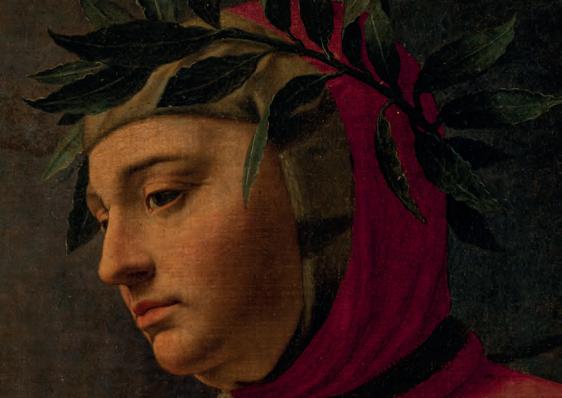
7. Detail of Fig.5, showing Petrarch’s face.
Opposite
8. Allegorical portrait of Petrarch, here attributed to a follower of Bronzino. c.1550? Oil on canvas, 110.6 by 124 cm. (Private collection).
18
the burlington magazine | 165 | january 2023
Bronzino’s ‘Petrarch’ retrieved
This painting by Pontormo is generally identified as the Venus and Cupid in the Galleria dell’Accademia, Florence (Fig.10).
The portraits of the poets painted by Bronzino for Bettini were all considered lost until Costamagna’s discovery of the portrait of Dante.7 The composition was already known from a replica in the National
Gallery of Art, Washington (Fig.9), which is believed to date from the sixteenth century, and may perhaps have been painted by Bronzino or his workshop. It lacks the rounded top of the original, which is related to the lunette for which it was painted, and is on panel whereas the original is on canvas. In the composition, Dante looks away from the viewer, while
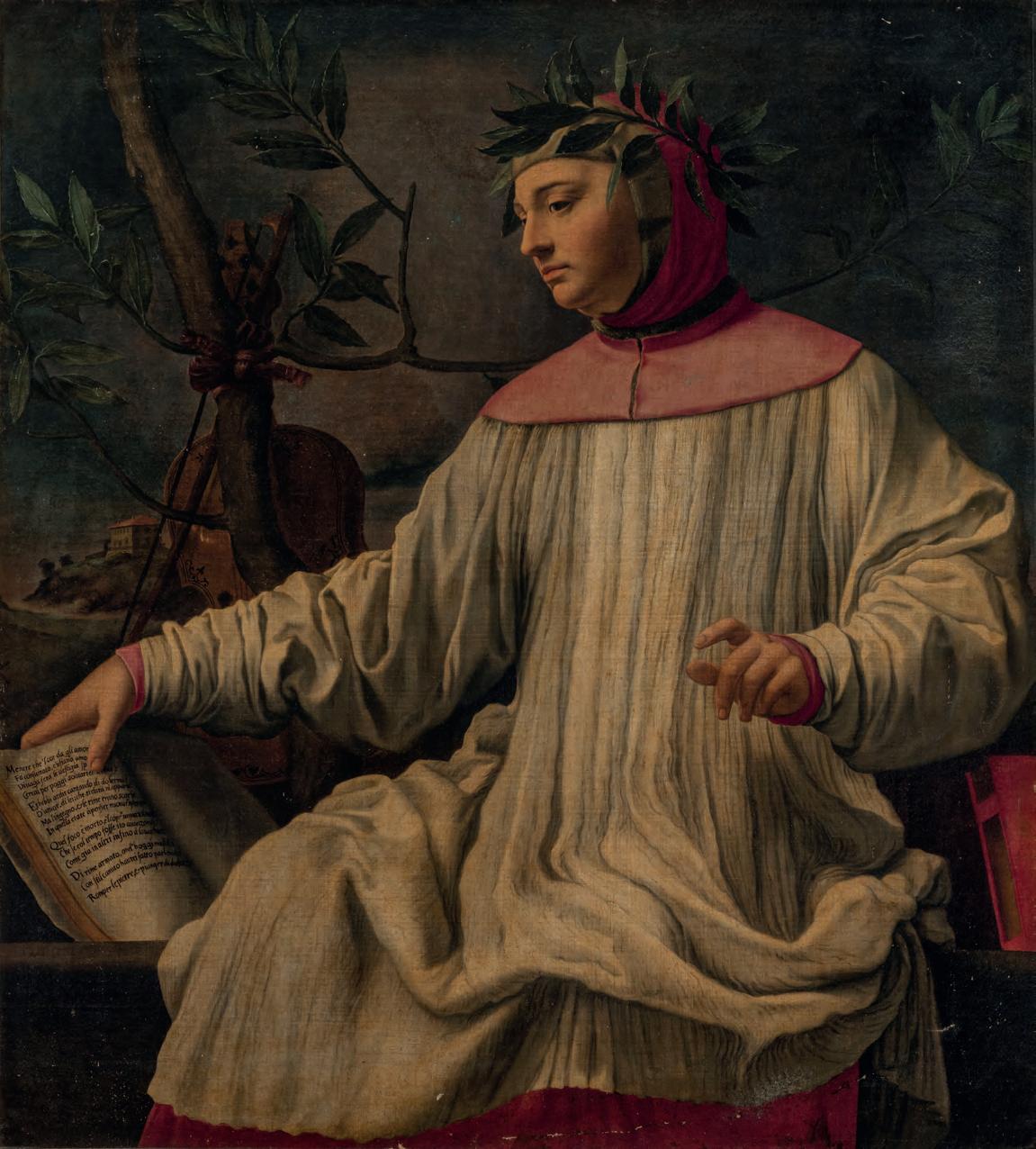
the burlington magazine | 165 | january 2023 19
9. Allegorical portrait of Dante, by the workshop of Bronzino. 1 550–1600? Oil on panel, 126.9 by 120 cm. (National Gallery of Art, Washington).
10. Venus and Cupid, by Jacopo Pontormo, based on a cartoon by Michelangelo. c.1532–33. Oil on panel, 194 by 128 cm. (Galleria dell’Accademia, Florence; Bridgeman Images).

11. Detail of Fig.6, probably showing Petrarch’s house in the Vaucluse.
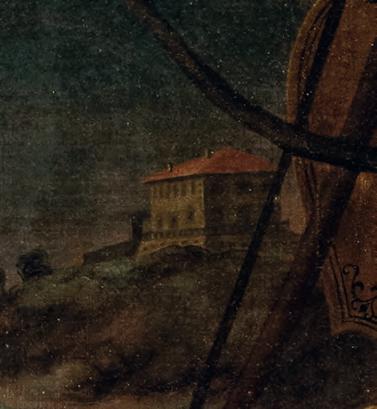
12. Detail of Fig.6, showing a lira da braccio tied to a laurel tree.
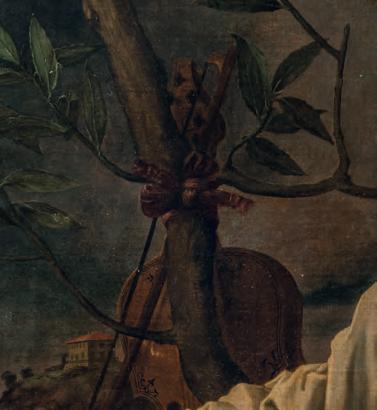
13. Detail of Fig.6, showing Petrarch holding an open book.

the open book in his hand legibly shows a large part of the opening of Canto 25 of the Paradiso. The correspondence with the newly discovered Petrarch composition is striking. Pose, proportion, mood and viewpoint are all similar. Petrarch also holds an open book, on which is written in an elegant script poem number 304 from the Canzoniere (also known as sonnet number 263). As in the Dante portrait, the atmosphere is rather dark and there is a distant landscape in dusk. In both portraits a single building is visible in the background, tiny because of its distance. In the Dante it is the cupola of Florence Cathedral. In the Petrarch it is probably the poet’s famous small house in the Vaucluse, lovingly described by him both in his letters and in the Canzoniere (Fig.11). It was there that he wrote much of his poetry and famously planted laurels as a tribute to his beloved Laura.8 Although the quotation from the Paradiso in the Dante portrait is damaged, enough is visible to establish that the script is practically identical to that of the poem in the portrait of Petrarch.9
The Petrarch commission came rather early in Bronzino’s development as a painter, when he was about twenty-eight years old. Yet the painting, even though it is likely to be a copy, seems to incorporate in a mature form distinctive traits of the artist’s long career. The rendering of the face, for example, with soft and careful transitions of flesh tones from the shadowed parts to the rosy cheeks, includes a subtle spot of light on the lower jaw, apparently a diffused reflection from the poet’s white gown. This subtly painted, finely draped gown is reminiscent of the depictions of comparable refined folds in Bronzino’s Portrait of a lady with a dog (c.1532–33; Städel Museum, Frankfurt), or the famous Laura Battiferri (1552; Palazzo Vecchio, Florence). The elongated hands and the emphatic foreshortening of the left arm are equally Bronzinesque, as are the partially closed – almost drooping – lids and the way the meeting of the delicately painted lips is indicated with a surprisingly emphatic black line.
The inclusion of an open book with text that is rendered in almost pedantic detail, as in the Dante portrait, indicates that this may have been a central motif in the series of portraits for Bettini. An early Florentine
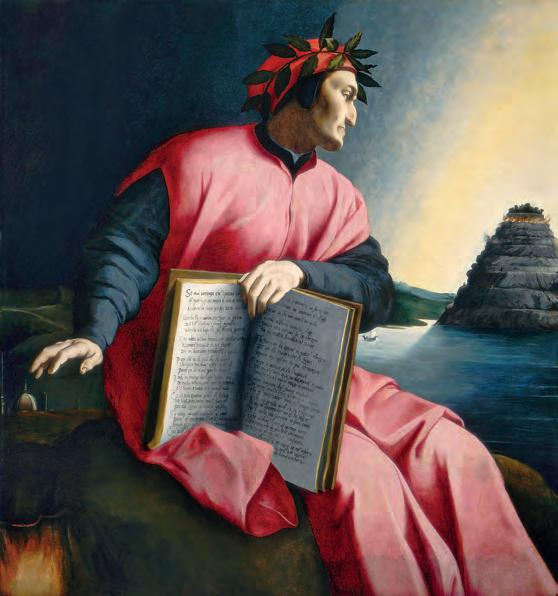
Focus
the burlington magazine | 165 | january 2023 20
on Bronzino
9. Allegorical portrait of Dante, by the workshop of Bronzino. 1550–1600? Oil on panel, 126.9 by 120 cm. (National Gallery of Art, Washington).
10. Venus and Cupid, by Jacopo Pontormo, based on a cartoon by Michelangelo. c.1532–33. Oil on panel, 194 by 128 cm. (Galleria dell’Accademia, Florence; Bridgeman Images).

11. Detail of Fig.6, probably showing Petrarch’s house in the Vaucluse.

12. Detail of Fig.6, showing a lira da braccio tied to a laurel tree.

13. Detail of Fig.6, showing Petrarch holding an open book.

the open book in his hand legibly shows a large part of the opening of Canto 25 of the Paradiso. The correspondence with the newly discovered Petrarch composition is striking. Pose, proportion, mood and viewpoint are all similar. Petrarch also holds an open book, on which is written in an elegant script poem number 304 from the Canzoniere (also known as sonnet number 263). As in the Dante portrait, the atmosphere is rather dark and there is a distant landscape in dusk. In both portraits a single building is visible in the background, tiny because of its distance. In the Dante it is the cupola of Florence Cathedral. In the Petrarch it is probably the poet’s famous small house in the Vaucluse, lovingly described by him both in his letters and in the Canzoniere (Fig.11). It was there that he wrote much of his poetry and famously planted laurels as a tribute to his beloved Laura.8 Although the quotation from the Paradiso in the Dante portrait is damaged, enough is visible to establish that the script is practically identical to that of the poem in the portrait of Petrarch.9
The Petrarch commission came rather early in Bronzino’s development as a painter, when he was about twenty-eight years old. Yet the painting, even though it is likely to be a copy, seems to incorporate in a mature form distinctive traits of the artist’s long career. The rendering of the face, for example, with soft and careful transitions of flesh tones from the shadowed parts to the rosy cheeks, includes a subtle spot of light on the lower jaw, apparently a diffused reflection from the poet’s white gown. This subtly painted, finely draped gown is reminiscent of the depictions of comparable refined folds in Bronzino’s Portrait of a lady with a dog (c.1532–33; Städel Museum, Frankfurt), or the famous Laura Battiferri (1552; Palazzo Vecchio, Florence). The elongated hands and the emphatic foreshortening of the left arm are equally Bronzinesque, as are the partially closed – almost drooping – lids and the way the meeting of the delicately painted lips is indicated with a surprisingly emphatic black line.
The inclusion of an open book with text that is rendered in almost pedantic detail, as in the Dante portrait, indicates that this may have been a central motif in the series of portraits for Bettini. An early Florentine

Focus
the burlington magazine | 165 | january 2023 20
on Bronzino
14. Proposed reconstruction of original placement of Figs.3 and 8. 15. Cosimo I de’ Medici as Orpheus, by Agnolo Bronzino. c.1537–39. Oil on canvas, 93.7 by 76.4 cm. (Philadelphia Museum of Art; Bridgeman Images).

example of such a device is a portrait attributed to Andrea del Sarto of a young woman holding an open book in which poems by Petrarch are legible (1528; Gallerie degli U zi, Florence). This motif recurs most emphatically, however, in works by Bronzino. From at least his portrait of Lorenzo Lenzi onwards (1528; Castello Sforzesco, Milan), books and booklets, both with or without legible texts, are a distinctive feature of his portraits, such as Ugolino Martelli (c.1535; Gemäldegalerie, Berlin), Lucrezia Panciatichi (1545; U zi, Florence) and Laura Battiferri. The motif became, one might argue, a vehicle par excellence of orentinità in Bronzino’s portraits of living people, but it had already been fully explored in the ctive portraits for Bettini.
The portrait of Petrarch has clearly been lined in the not-too-distant past and so it is possible that the canvas was not its original support. It is, however, notable that the original Dante portrait is also on canvas, which Bronzino used relatively rarely, and the comparable decorative sequence he painted for the Villa Imperiale at Pesaro is also on canvas. The original Dante is about ten centimetres wider than the Petrarch, but the latter looks as though it has been cut on both sides. The cropped elbow seems unnatural, as does the way the book is missing a small part on the left. A hypothetical addition of the ends of the book and of the elbow brings the painting very close in size to the original Dante painting.

7 Costamagna, op. cit. (note 2). See entry by R. de Giorgi in C. Falciani and A. Natali, eds: exh cat. Bronzino:Painter and Poet at the Court of the Medici, Florence (Palazzo Strozzi) 2010–11, p.206. See also A. Natali, ed.: . . .Con altra voce ritornerò poeta: il ritratto di Dante del Bronzino alla Certosa di Firenze / The Portrait of Dante by Bronzino at the Certosa of Florence, Florence 2020; and the entry by J. Siemon in K. Christiansen and C. Falciani, eds: exh. cat. The Medici, Portraits and Politics, 1512–1517, New York (Metropolitan Museum of Art) 2021, pp.164–66.
8 For a thorough discussion of the reputation of this house and other lieux de mémoire of Petrarch, see J.B. Trapp: ‘Petrarchan places: an essay in the iconography of commemoration’, Journal of the Warburg and Courtauld Institutes 69 (2006), pp.1–50.
9 In the Petrarch painting the letters seem to have been partly but accurately restored. For a fine essay with
















reference to the use of writing in the work of Bronzino and his circle, see E. Cropper: ‘Pontormo and Bronzino in Philadelphia: a double portrait’, in Strehlke, op. cit. (note 3), pp.1–34 and pp.67–69, entries for cat. nos.6 and 7.



10 See, most recently, R. Speck and F. Neumann, eds: Klug und von hehrer Gestalt: Petrarca Bildnisse aus sieben Jahrhunderten, Cologne 2018.

11 For the lira da braccio, see A. Hajdecki: Die italienische Lira da Braccio: eine kunsthistorische Studie zur Geschichte der Violine, Mostar 1892, repr. Amsterdam 1965; and S. Scott Jones: The Lira de Braccio, Bloomington 1995. The well-known treatise M. Praetorius: Syntagma Musicum Theatrum Instrumentorum seu Sciagraphia, I–III, Wittenberg and Wolfenbüttel 1614–20, makes it clear that the bow used for the lira da braccio corresponds exactly to the bow hanging from the laurel stem in the Petrarch painting, see ibid.: II (‘De Organographia’), no.XX.
If a lunette comparable to that of the Dante is added to the top the result is a tentative but convincing pendant (Fig.14). Cleaning and thorough technical examination of the Petrarch might reveal whether it has been trimmed and whether traces of a lunette top remain.




The iconography of Petrarch has been well researched. 10 The composition presented here appears to be richer in allegorical allusions than the great majority of the portraits of the poet. Behind Petrarch for instance, there is a string instrument and its bow, which are tied to a laurel tree by means of a reddish ribbon (Fig.12). This is a lira da braccio, an antecedent of the violin, used for accompanying singing during the fteenth and sixteenth centuries.11 It appears in a number of paintings of the time, such as Dosso Dossi’s Apollo and Daphne (1524; Galleria Borghese,

THE BURLINGTON MAGAZINE | 165 | JANUARY 2023 21
Rome), but most significantly in this context in a painting by Bronzino of Cosimo I in the guise of Orpheus (Fig.15). The lira da braccio behind Petrarch is very similar to the one Cosimo is playing; it could almost be the other side of the same object. Its role, however, is entirely different. The instrument is not being used to please the ears of listeners, as in the portrait of Cosimo, but is tied to a tree, where it is mute. This intriguing concetto is no doubt intended to indicate the strong tie between Petrarch’s poetic lira and his lover and muse, Laura. This interpretation is supported by the lines in Petrarch’s open book (Fig.13).12 In this late poem from the Canzoniere, written many years after the death of Laura, Petrarch looks back on the poetry of his youth, when Laura was still alive and his heart was consumed by an amorous fire. His verse had been in a sense feeble and erratic (‘ma l’ingegno et le rime erano scarse / in quella etate ai pensier’ novi e ’nfermi’). Now the fire is dead, ‘covered by a small piece of marble’ (‘Quel foco è morto, e ’l copre un picciol marmo’). If she had lived on, he would have made verses with power (‘armato’), that would cause ‘stones to break with my words, and weep with sweetness’ (‘con stil canuto avrei fatto parlando / romper le pietre, et pianger di dolcezza’). The poem is both a lament for Laura and a meditation on the author’s poetics.
Although the sonnet was not among Petrarch’s most famous, it was well known and appreciated. Pietro Bembo singled it out for analysis in his Prose della Volgar Lingua (1525), for instance, and both Adrian Willaert and Orlando di Lasso composed madrigals using the text.13 Yet it is not clear why this poem was chosen for the painting, nor is it known if it was selected by Bettini or Bronzino, who was both a poet himself and an expert on Petrarch.14 Assuming that the texts chosen for the series were related programmatically, some connection with the choice of the canto in the Dante portrait would be expected. The first lines of Dante’s text read: ‘If it ever happens that the sacred poem / To which both heaven and earth have set their hands, / So that it made me thin for many a year, / Should overcome the cruelty which shuts me out / From that lovely fold, where I slept, a lamb, / The enemy of wolves who war against it; / With a different voice now, and with different fleece / I shall come back poet’.15
Dante is referring here to his banishment from the city and an imagined return. The choice of this passage for Bettini’s Dante has so far been discussed only in terms of its political implications. The mention of banishment has been connected to the fact that Bettini had been among the supporters of the republic that had in 1530 been so violently replaced by the rule of Alessandro de’ Medici. Possibly as a result, Bettini left Florence for Rome some four years after the probable date of the painting of Dante 16 But there always was something incongruous about this explanation for the choice of the text from the Paradiso. If Bettini were expecting to be expelled from Florence shortly, why would he order such a decorative allusion to banishment for a room in the very palazzo that he would soon be forced to leave behind? The Petrarch sonnet provides a context for the quotation from Dante that is not based on the political circumstances
12 G. Contini and D. Ponchiroli, eds: “Il Canzoniere” di Francesco Petrarca, Turin 1964, 1992 (rev. edn), p.378. The closed book with a crimson cover partly visible behind the poet and under his left arm has no title shown, but in the context of the painting as dicussed in the present article it could be the Trionfi, with its meditations on love and death.
13 P. Bembo: Opere in volgare, Florence 1961, ed. M. Marti, pp.337–38.
14 The seminal study of Bronzino as a poet is D. Parker: Bronzino, Renaissance Painter as Poet, Cambridge 2000.
15 ‘Se mai continga che ’l poema sacro / al quale ha posto mano e cielo e terra,
/ sì che m’ha fatto per molti anni macro, / vinca la crudeltà che fuor mi serra / del bello ovile ov’io dormi’ agnello, / nimico ai lupi che li danno guerra; / con altra voce omai, con altro vello / ritornerò poeta [. . .]’, D Alighieri: Divina Commedia, III, canto 25, transl. C.H. Sisson, Oxford and New York 1981.
16 See R. Leporatti: ‘Venere, Cupido e I poeti d’Amore / Venus, Cupid and the Poets of Love’, in Falletti and Katz Nelson, op. cit. (note 6), pp.64–89. Here, although the idea of ‘twofold love’, earthly and celestial, is discussed, ‘the political significance’ is stressed as being inescapable: ‘just a few months after the fall of the Republic: Bettini, an active partisan, lived in fear of being
of the patron. This new perspective corresponds better not only with the Petrarch portrait, but also with the iconography of the Venus, which, according to Vasari, was painted by Pontormo for Bettini after Bronzino had been set to work on the camera.
Since the Petrarch poem contains no reference to banishment, it is unlikely that this was intended to be the topic linking the portraits. It is striking that in the case of the Dante the author refers to his own poetry, just as Petrarch does in his sonnet, and that there too the poet states that now, late in his life and poetic career, his poetry may change, and could henceforth be of a different nature: ‘With a different voice now, and with different fleece I shall come back poet’ (‘con altra voce omai, con altro vello ritornerò poeta’). The return Dante referred to was not just a possible return to Florence, but also, in a more general sense, a return from his privileged visit to Paradise and his meeting there with Beatrice, who had died years before. Both passages, therefore, refer to poetics and to stylistic changes in relation to the death of a beloved woman who was also a muse. Both authors in addition make clear how their devotion to their respective loved one continued after she had died. It seems, therefore, that there was a shared theme in the painted texts. Their correspondence is close
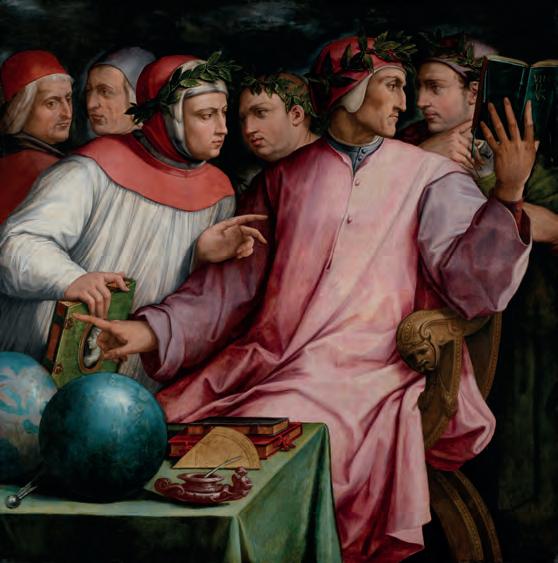
forced to share in Dante’s same fate’, ibid., p.72.
17 For discussions about the meaning of the Bettini Venus, see, for instance, Falletti and Katz Nelson, op. cit. (note 6); Leporatti, op. cit. (note 16); Aste 2015, op. cit. (note 6), pp.134–74; and Compton, op. cit. (note 12).
18 ‘Le rime, le quai già fece sonore / la voce giovinil ne’ vaghi orecchi / e che movien de’ mia pensier parecchi / a quel desio che m’infiammava il core, / scrivendole come dettava Amore, / Àn facto chiocce gli anni gravi et vecchi, / Poscia che morte ruppe quelli specchi, / Da’ quai forza prendea lo mio vigore / E, come ‘l viso angelico tornossi / al regno là, dond’era a noi venuto / per
farne fede dell’altrui bellezza, / e i passi miei di drieto a llui fur mossi, / né rima poi né verso m’è piaciuto, / né altro che ‘l seguir la sua altezza’, A.F. Massèra, ed.: Giovanni Boccaccio, La caccia di Diana e le Rime, Turin 1914. pp.140–41.
19 For the requirements for membership, see Aste 2015, op. cit. (note 6), pp.45–54 and 61. It was possible to gain entrance with the translation of a Latin text into Tuscan, but there is no indication that Bettini was a classicist.
20 See R. Aste: ‘Bettini’s splendore: the camera’s physical and social functions’, in idem 2015, op. cit. (note 6), pp.175–208.
Focus on Bronzino the burlington magazine | 165 | january 2023 22
16. Six Tuscan poets, by Giorgio Vasari. c.1544. Oil on panel, 132.1 by 131.1 cm. (Minneapolis Institute of Art; Bridgeman Images).
Bronzino’s ‘Petrarch’ retrieved
enough to imply that it was intentional and meant to be noticed, although the fact that the paintings were installed high up in lunettes makes one question how legible they would have been in reality. In a general sense the theme recalls many statements about love made at this time, both verbal and visual, and in particular the common distinction between two kinds of love: one lower and earthly, and the other sublime and celestial. This also appears to be a main theme of Michelangelo’s enigmatic design for Pontormo’s Venus. Bettini’s camera may have been intended as a visual display of such a notion about the nature of love as well as a celebration of the tre corone fiorentine ‘who have sung of love’.17
When discussing Bronzino’s portraits of Dante, Petrarch and Boccaccio for Bettini, Vasari refers rather ambiguously to the intention of adding ‘all the other poets who have sung of love in Tuscan prose and verse’. Boccaccio’s reputation as a vernacular poet has been overshadowed by the success of the Decameron, which is in prose. If he were portrayed by Bronzino with poetry that would have fitted with the programme of Bettini’s camera, what might it have been? Boccaccio wrote entire series of sonnets in a Petrarchan or Dantesque vein, and he had his own equivalent of Beatrice and Laura, a lady nicknamed Fiammetta (little flame) although unlike Dante and Petrarch, he had a sexual relationship with his adored lady and muse. Her early death led to a number of moving verses. So, Boccaccio, like Dante and Petrarch, has a poetic œuvre split in two – before and after the death of his muse. His corpus of sonnets also contains a reference to a change in the poet’s voice after the death of Fiammetta. In a sonnet that has intertextual relations both to Dante and Petrarch, Boccaccio recalls ‘The verses that once my youthful voice / Made resound in willing ears / On a par to the desire that enflamed my heart / Writing them as Amor dictated’, and reflects that in his ‘grave and elder years’, after the death of his beloved, they seem like ‘cackle’.18 The sonnet’s sequel tells us how the poet now aspires to follow her into the celestial sphere,
17. Petrarch, by a follower of Cristofano di Papi dell’Altissimo. c.1560. Oil on panel, 63 by 49 cm. (Palazzo Pitti, Florence; courtesy Gabinetto Fotografico delle Gallerie degli Uffizi).

18. Dante, by a follower of Cristofano di Papi dell’Altissimo. c.1560. Oil on panel, 63 by 49 cm. (Palazzo Pitti, Florence; courtesy Gabinetto Fotografico delle Gallerie degli Uffizi).
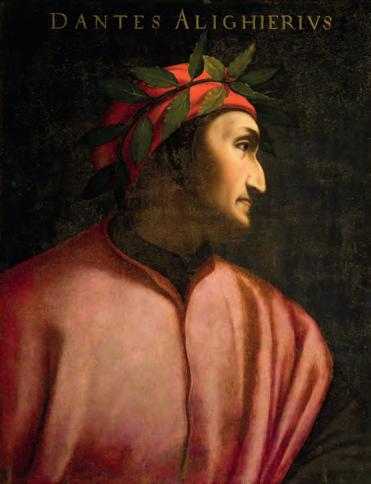
19. Boccaccio, by a follower of Cristofano di Papi dell’Altissimo. c.1560. Oil on panel, 65 by 51 cm. (Palazzo Pitti, Florence; courtesy Gabinetto Fotografico delle Gallerie degli Uffizi).

‘To pay our homage to that other beauty’, concluding that ‘Song or verse pleased me no longer / Other than the following of her loftiness’. This is reminiscent of Dante’s altro vello e altro voce after his encounter with Beatrice in Paradise, or Petrarch’s more mature style, stil canuto, developed after the death of Laura. The inclusion of such a poem in the portrait of Boccaccio would have given coherence to what has been suggested may have been the programme of the camera, but it is also quite possible that the portrait deferred to Boccaccio’s reputation as primarily a prose writer and incorporated no poetry at all.
As Michelangelo’s trusted banker, Bettini is mentioned a number of times in the artist’s letters from Rome to his cousin Leonardo in Florence in the 1540s. In the same years Benedetto Varchi wrote a long scholarly commentary on one of Michelangelo’s sonnets, the famous ‘Non ha l’ottimo artista alcun concetto’ (‘Nothing the best of artists can conceive’) According to a letter of 1549 from Michelangelo to Leonardo, the commentary was forwarded to the artist in Rome through Bettini as an intermediary, indicating that he was more than a banker and belonged to a circle of Florentines, including Varchi and Michelangelo, who were deeply interested in poetry and art. Varchi’s Due Lezzioni (1549) was not only dedicated to Bettini but even contained a sonnet in his honour. Bettini was admitted as a member of the Accademia Fiorentina, founded by Cosimo I in 1542, and he came to be a kind of cultural ambassador in Rome. Membership of the Accademia was granted only to someone who had submitted poetry.19 Bettini presumably had tried his hand at writing poems himself, probably by the time he ordered the decoration of his camera on the themes of love and poetry; it is tempting to speculate even that he had a personal reason for this choice. It is possible, however, as suggested above, that the programme was Bronzino’s invenzione, given his literary expertise, the frequency with which he introduced books into his works and the complete originality of these portrait compositions.
Consideration of the room’s programme raises the important question of the function of the camera for which these works were destined. If an allusion to love enduring beyond death was intended, such a theme would have been most appropriate for a camera da letto (bedroom), but a case has also been made that it was a camera privata or studiolo. Richard Aste has recently presented an overview of the various arguments in favour of either possibility.20 Given Vasari’s reference to additional portraits being planned for the room, and considering the position of the tre corone in high lunettes
the burlington magazine | 165 | january 2023 23
20. Proposed reconstruction of Figs.3, 8 and 22 as they might have appeared in the camera of Bartolomeo Bettini.

21. Allegorical portrait of Dante, by Carlo Dolci after Agnolo Bronzino. Red and black chalk on paper, 23.2 by 20.1 cm. (Fitzwilliam Museum, Cambridge; Bridgeman Images).
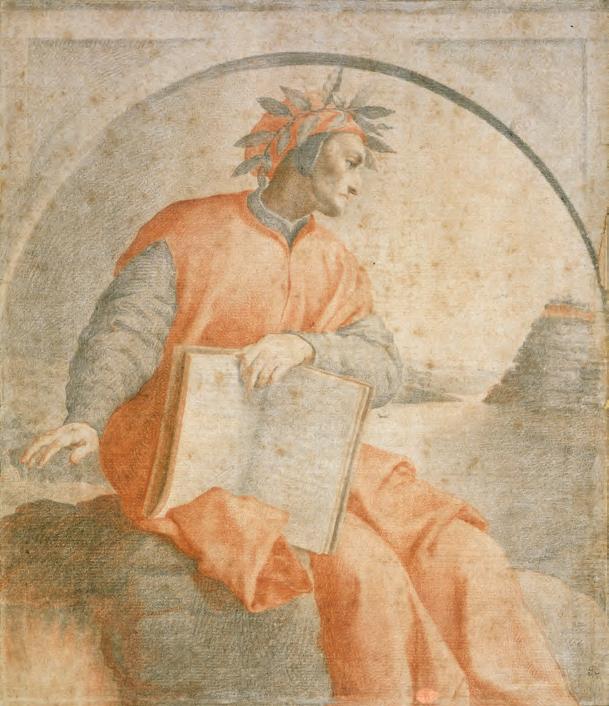
22. Boccaccio holding a copy of the ‘Decameron’, attributed to a follower of Cristofano di Papi dell’Altissimo. c.1570. Oil on canvas, 70 by 94.2 cm. (Private collection).
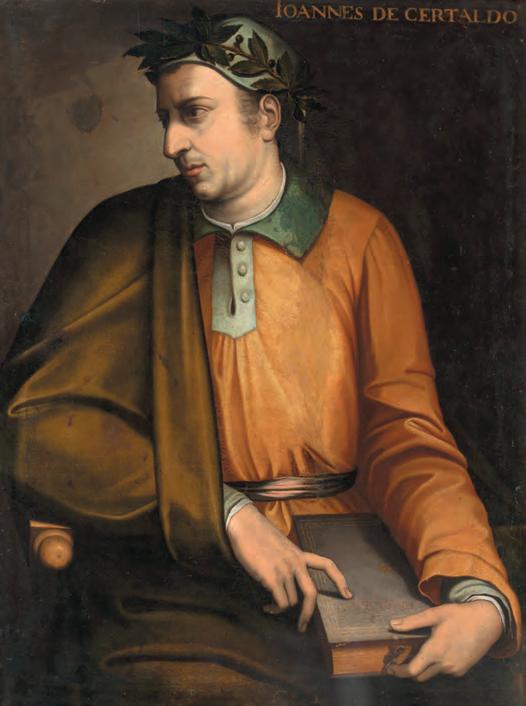



and the fact that they are portrayed with books, an arrangement like a studiolo seems more likely – also because Vasari, as we have seen, mentions that more portraits had been planned. Evidence, however, is lacking; we do not even know the location of Bettini’s house at this time.


















Now that the appearance of Bronzino’s Petrarch has been rediscovered, it is tempting to speculate about the appearance of the third of Bettini’s tre corone, the portrait of Boccaccio. Extrapolating from the Dante and Petrarch, it seems likely that it would have incorporated the following features: a seated half-length gure wearing a laurel crown, not looking straight at the spectator, slightly seen from below and accompanied by an open book with legible text. There is no obvious trace of such a prototype among the known Boccaccio portraits,21 but these di er considerably from each other and there appears to be no clearly established Boccaccio type.22




It has been hypothesised that when Vasari painted his Six Tuscan poets (Fig.16) for Luca Martini – who in 1555 had his portrait painted by Bronzino (Palazzo Pitti, Florence) – he may have based the Petrarch and Boccaccio

Focus
THE BURLINGTON MAGAZINE | 165 | JANUARY 2023 24
on Bronzino
on Bronzino’s portraits, an idea supported by the fact that Vasari had briefly been in Bronzino’s workshop and was apparently well-informed about Bettini.23 However, Vasari’s Dante does not resemble Bronzino’s, and now that Bronzino’s Petrarch composition has been identified, it is clear that this was not a model for the Six Tuscan poets either.
There is also no connection between the Bronzino compositions and the portraits of the three poets in the famous series of copies made by a follower of Cristofano di Papi dell’Altissimo for Cosimo de’ Medici of portraits in Paolo Giovio’s celebrated museum in Como, the majority of which are now preserved in the Galleria degli Uffizi, Florence. However, a comparable but lesser-known series of portraits by an unknown painter (or painters), now in Palazzo Pitti, Florence, includes a close variant not just of Bronzino’s Dante, but of Petrarch as well (Figs.17 and 18). It might be assumed, therefore, that the Boccaccio in the series (Fig.19) might also be an echo of a composition by Bronzino, but it is in fact derived largely from the older Boccaccio in the Giovio series.
Bettini’s Dante and Petrarch make it clear that Bronzino created new portraits for his patron, without any reliance on copying. Among their innovatory qualities is a vision of the poets that was appropriate for their placement in high lunettes and emphasised their elevated status and detachment from earthly concerns, features that are lacking in the Boccaccio in the Altissimo series. The head of Boccaccio in Vasari’s Six Tuscan poets, by contrast, conforms surprisingly well with such an elevated view, making it sit rather awkwardly within the group. It clearly relates to a different spatial context, one that might conceivably accord with Bettini’s camera.
In 2004 a painting of Boccaccio was sold at Sotheby’s, London, which has many features that correspond with Bettini’s Dante and Petrarch portraits (Fig.22).24 It is half-length and the sitter, who wears a laurel crown and looks away from the viewer, holds a book, probably the Decameron, which, however, is closed. The facial features are different from other imaginary Boccaccio portraits, although the pose corresponds with the figure of Boccaccio in Vasari’s Six Tuscan poets. While at first sight there is little to connect this portrait with Bronzino, elements that point to his period or circle include the style of the furniture, the way the chair is foreshortened, the sideways glance and the exaggeratedly elegant treatment of the hands, which can be compared to those in Bronzino’s portraits painted around the same time as the Dante and Petrarch (Figs.23–26). Although cropped, the figure sits surprisingly well in the company of Dante and Petrarch (Fig.20) and so, despite the fact that it does not include a poem, it seems possible to the present author that it is derived from Bronzino’s Boccaccio lunette.25 In all three cases it seems that the light, as indicated by the cast shadows, more or less comes from the upper right, which may suggest the presence of a window there in the original setting.
Bronzino’s paintings for Bettini’s camera were appreciated and copied, as is evident from the copy of the Dante portrait on panel in Washington. A seventeenth-century drawing convincingly attributed to Carlo Dolci (1616–86) is a copy of the complete composition (Fig.21).26 As far as the present author is aware, no drawings of the portrait of Petrarch have been preserved, but, as discussed above, the Petrarch in
21 For the iconography of Boccaccio, see V. Kirkham: ‘L’immagine del Boccaccio’, in V. Branca, ed.: Boccaccio visualizzato: narrare per parole e per immagini fra Medioevo e Rinascimento, Turin 1999, I, pp.83–144.
22 If a possible source has to be sought for a model of a portrait of Boccaccio, the most likely candidate,
because of its accessibility and authority, would perhaps be the fresco by Andrea del Castagno painted c.1450 for Palazzo Vecchio, now in the Uffizi.
23 See, among others, Aste 2015, op. cit. (note 6), p.49.
24 Sale, Sothebys, London, Old Masters Sale, 16th April 2002, lot 224, described as ‘Portrait of Boccaccio, half-length, by a follower
Clockwise, from top left
23. Detail of Ugolino Martelli, by Agnolo Bronzino, showing the sitter’s left hand. 1536–37. (Gemäldegalerie, Berlin; Bridgeman Images).

24. Detail of Laura Battiferro, by Agnolo Bronzino, showing the sitter’s right hand. 1552. (Palazzo Vecchio, Florence; Bridgeman Images).
25. Detail of Fig.22, showing Boccaccio’s hands.
26. Detail of Guidobaldo della Rovere, by Agnolo Bronzino, showing the sitter’s right hand. c.1544–45. (Palazzo Pitti, Florence; Bridgeman Images).
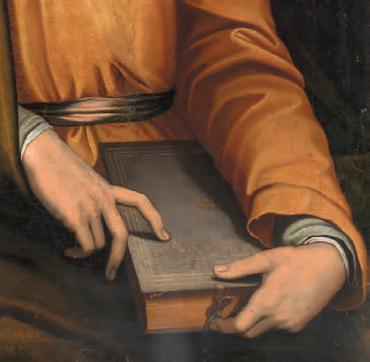
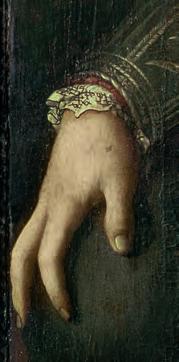

the sixteenth-century series of portraits uomini famosi is based on the Bronzino type and the prestige of the composition is confirmed by the oval copy attributed to Naldini. Whatever the state and status of the newly identified Petrarch painting, this hitherto unknown image may not only deepen our understanding of this important early phase of Bronzino’s career, but also, more significantly, provides a better idea of what has been called ‘one of the most influential decorative programs of the sixteenth century’, devoted to the three greatest of Tuscan poets, Dante, Petrarch and Boccaccio, devised by three of the greatest painters of the Tuscan cinquecento, Michelangelo, Pontormo and Bronzino.27
of Cristofano dell’Altissimo’.
25 The author is grateful to Stijn Stumpel for invaluable help in developing this visual hypothesis, as well as for the initial tentative reconstructions of Figs.14 and 20.
26 For this drawing, see, for example, D. Scrase: ‘A drawing of Dante after Bronzino by Carlo Dolci in the Fitzwilliam Museum, Cambridge’,
in M.T. Caracciolo, ed.: Hommage au dessin: Mélanges offerts à Roseline Bacou, Rimini 1996, pp.204–09. For a drawing by Bronzino related to the painted portrait, see C.C. Bambach, J. Cox-Rearick and G.R. Goldner, eds: exh. cat. The Drawings of Bronzino, New York (Metropolitan Museum of Art) 2010. 27 Aste 2015, op. cit. (note 6), p.1.
the burlington magazine | 165 | january 2023 25
Bronzino’s ‘Petrarch’ retrieved
focus on bronzino
A portrait of the Lady Isabella by the hand of Bronzino
The recent re-emergence of a portrait of a woman attributed in the past both to Bronzino and to Allori has allowed it to be attributed firmly to Bronzino. It is here argued that the sitter was Isabella de’ Medici Orsini, a daughter of Cosimo I de’ Medici and Eleonora di Toledo, and that the painting can probably be identified as a portrait of Isabella by Bronzino recorded in the Medici Guardaroba in the Palazzo Vecchio, Florence, in 1560.
by bruce edelstein
Apainting identified as a ‘Portrait of a lady in black, holding a book, three-quarter-length’ was sold in May 2021 at Sotheby’s, New York, with an attribution to Alessandro Allori.1 Following its purchase by the current owner, new technical images were made and the painting underwent conservation.2 Freed from a disfiguring, aged yellow varnish, the picture has revealed itself to be a significant Florentine portrait of the second half of the sixteenth century (Fig.2). It will be argued here that the work was executed not by Allori (1535–1607), but by his master, Agnolo Bronzino (1503–72). Furthermore, the improved legibility of the sitter’s features may now permit her identification as Isabella de’ Medici Orsini (1542–76), one of the most fascinating of the daughters of Duke of Florence, later Grand Duke of Tuscany, Cosimo I de’ Medici, and his consort, Eleonora di Toledo. It will be suggested that the painting is thus very likely the one listed in a 1560 inventory of the Medici Guardaroba in Palazzo Vecchio as ‘A portrait of the Lady Isabella by the hand of Bronzino’. The painting exhibits damage and losses along all its edges. Due to the presence of attached wood strips around all sides of the painting, the original edges are not currently visible. It nonetheless seems likely that the work has been cut down, especially along the bottom. Trimming presumably occurred to some extent along all sides to insure a centred placement of the sitter. Given the painting’s current dimensions, 103.8 by 83.7 centimetres,3 it was originally probably very close in size to Bronzino’s most famous female portrait, Eleonora di Toledo with her son
The author would like to thank the friends and colleagues with whom he discussed the attribution of the painting and the identification of its sitter, including Annika Finne, Antonio Geremicca, Simone Giordani, Roberta Orsi Landini, Elizabeth Pilliod and Carol Plazzotta. A special thanks to David Franklin for his challenging comments and helpful suggestions.
1 Sale, Sotheby’s, New York, Master Paintings, 20th May 2021, lot 24, available at www.sothebys.com/en/buy/ auction/2021/master-paintings/portraitof-a-lady-in-black-holding-a-book-three, accessed 5th December 2022.
2 The treatment was carried out from July 2021 to July 2022. The technical photographs were executed by the Thierry Radelet laboratory. Postconservation photography was made by Claudio Giusti.
3 These are the average height and width for the panel, which is not entirely regular. The dimensions differ from those provided by Sotheby’s for the sale (106.7 by 83.8 cm.), which are closer to the dimensions including the wood strips that border its edges, added during a previous conservation campaign (105.7 by 85.4 cm.).
1. Eleonora di Toledo with her son Giovanni, by Agnolo Bronzino. c.1545. Oil on panel, 115 by 96 cm. (Gallerie degli Uffizi, Florence).
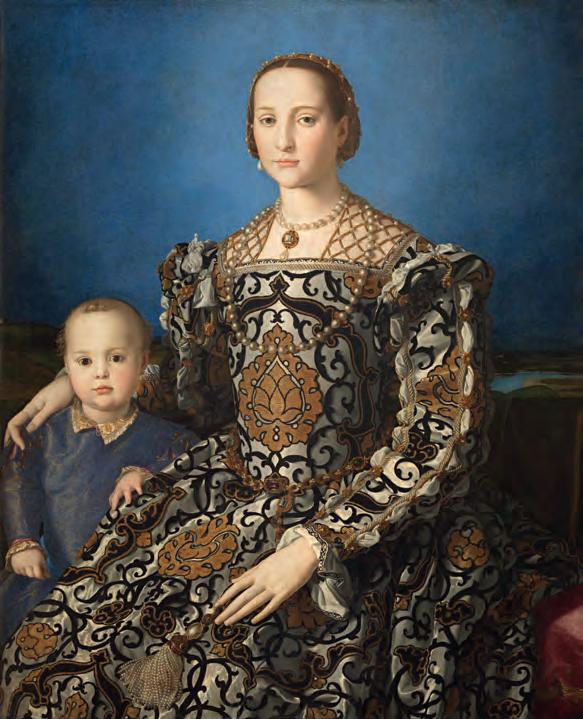
Opposite
2. Portrait of a woman, here identified as Isabella de’ Medici Orsini, here attributed to Agnolo Bronzino. c.1560. Oil on panel, 103.8 by 83.7 cm. (Private collection; courtesy Claudio Giusti).
2023 26
the burlington magazine | 165 | january

the burlington magazine | 165 | january 2023 27
Giovanni (Fig.1), which is 115 by 96 centimetres.4 This was likely a standard size for Bronzino’s larger portraits, as his Eleonora di Toledo with her son Francesco (c.1550; Museo Nazionale di Palazzo Reale, Pisa) is almost identical in height and width, at 114 by 95 centimetres.5
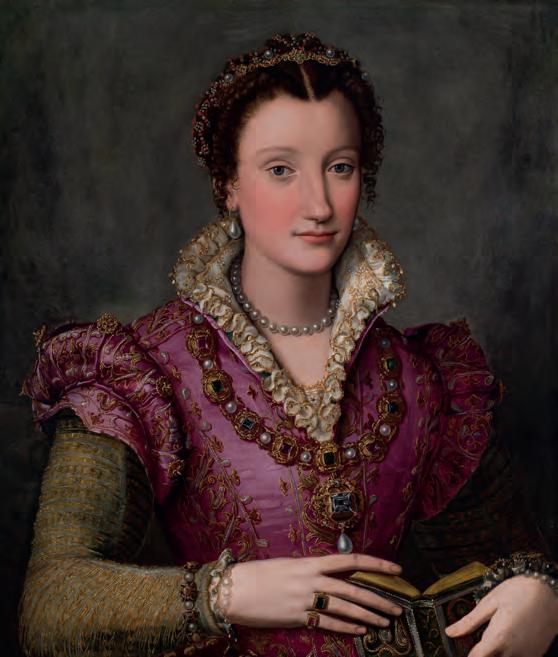
The portrait’s verso offers little information regarding its original appearance, attribution or the identification of the sitter since the panel was thinned at some point in its history and cradled.6 This may have occurred around the time that the painting was with the Arthur U. Newton Gallery in New York in 1935. The cradle has been removed during the conservation for the present owner and replaced by two crossbars, which were applied with a series of springs to regulate the movement of the panel.

Finely painted in oil on wood panel, the stately, composed nature of the sitter and the classic format of the portrait suggest a carefully planned composition, with little indication of doubt or rethinking on the part of
4 Gallerie degli Uffizi, Florence, inv. no.1890, 748.
5 See entry by E. Pilliod in K. Christiansen and C. Falciani, eds: exh. cat. The Medici: Portraits and Politics, 1512–1570, New York (Metropolitan Museum of Art) 2021, p.146, no.28. The slight difference in height indicated here was confirmed by the museum in Pisa.
6 The panel’s current depth is 1.4 cm.
7 B. Edelstein: ‘Miraculous encounters: Pontormo from drawing to painting’, in idem and D. Gasparotto, eds: exh. cat.
Miraculous Encounters: Pontormo from Drawing to Painting, Florence (Gallerie degli Uffizi), New York (Morgan Library
and Museum) and Los Angeles (J. Paul Getty Museum) 2018–19, pp.17–61, at pp.41–42.
8 C. Plazzotta and L. Keith: ‘Bronzino’s “Allegory”: new evidence of the artist’s revisions’, THE BURLINGTON MAGAZINE 141 (1999), pp.89–99, at p.90.
9 E.W. Rowlands: The Collection of the Nelson-Atkins Museum of Art: Italian Paintings, 1300–1800, Seattle 1996, pp.181–88, no.22. See also entry by C. Plazzotta and N. Turner in idem and L. Hendrix: European Drawings 3: Catalogue of the Collections, Los Angeles 1997, pp.16–17, no.7; Plazzotta and Keith, op. cit. (note 8), p.90; entry by
the artist. This refined surface successfully conceals an extraordinarily free underdrawing, numerous pentimenti and important adjustments throughout the portrait (Fig.4). The underdrawing visible in the infrared reflectogram (IRR) appears to have been executed almost entirely freehand and no evidence for the use of a complete cartoon, such as the characteristic marks left by pouncing, has been identified. Some of the lines visible around the head, especially the diagonal marks at the base of the neck, near the necklace and the upper portions of the partlet, appear slightly more mechanical. These suggest the use of a partial cartoon for the size and position of the head. Such a generic workshop tool appears to have been employed by Bronzino and his assistants in the execution of various female portraits of similar scale. Some of the lines indicating earlier positions for the fingers of the sitter’s proper left hand and the orientation of the book she holds also suggest tracing, unlike those of her proper right hand, which appear to be drawn freehand with a carbon-based medium, likely charcoal. Evidence for the use of partial cartoons has been found in several portraits by Bronzino’s master, Jacopo Pontormo (1494–1557).7 In those works, the partial cartoons were for faces or hands, suggesting a standard workshop practice transmitted from one generation to the next. The most arresting areas of draughtsmanship in the underdrawing are visible in the grotesque masks that terminate the armrests of the throne and in the hands, which were significantly rethought by the artist while painting. The mask of the left armrest, the only one entirely preserved in the painting, is characterised by an exceptional liveliness, which is free, exploratory and humorous. In the final painting, the face, which is far more humanoid in the drawing, has been rendered more beastly, a monstrous fusion of bat, pig and dog. The position of the hands and the arrangement of the fingers were moved and adjusted at least once before arriving at the solutions visible on the surface of the portrait. The fingers of the sitter’s proper right hand were raised and lengthened, concealing
the burlington magazine | 165 | january 2023 28
Focus on Bronzino
3. Portrait of a young lady, probably Camilla Martelli de’ Medici, by Alessandro Allori. 1570s. Oil on canvas mounted on board, 68.6 by 59.1 cm. (Saint Louis Art Museum).
4. Infra-red reflectogram of Fig.2. (Courtesy Thierry Radelet Laboratory).
to a greater extent the image of the subject on the portrait medal hanging from the chain she wears. The fingers of her left hand were unfurled from a more closed position around a more vertically orientated book. All these changes increase the elegance of the hands and augment the sense of relaxed composure in the movements of their fingers.
The continuous reworking of ideas in the process of painting, in such strong contrast to the refined surfaces of his works, is now recognised as a characteristic of Bronzino’s method. As Carol Plazzotta and Larry Keith observed in their ground-breaking study of An allegory with Venus and Cupid (c.1545; National Gallery, London), ‘Even when painting portraits ostensibly based on life, Bronzino habitually revised his initial ideas during painting’.8 One well-known example of this can be seen in the Portrait of a young man (c.1550–55) in the Nelson-Atkins Museum of Art, Kansas City, in which the costume visible in the X-radiograph of the painting was altered at least twice, from a figure in all’antica classicising armour to one wearing the latest contemporary fashions.9
G.R. Goldner in C.C. Bambach, ed.: exh. cat. The Drawings of Bronzino, New York (Metropolitan Museum of Art) 2010, p.204, no.54; entry by A. Beyer in Christiansen and Falciani, op. cit. (note 5), pp.254–57, no.75. The work is usually dated to c.1550 or 1550–55, although Beyer has suggested an earlier dating of c.1545–50.
10 Saint Louis Art Museum, inv. no.9:2017. The IRR is available at www. slam.org/wp-content/uploads/2018/09/ allori-infrared.jpg, accessed 5th December 2022. Two details visible in the IRR executed during the conservation of the Lady with a cameo
attributed to Allori in the Uffizi (Fig.10 in the present article) were published as figs.6 and 8 in M. Signorini: ‘Restoration of the “Lady with a cameo”’, in A. Natali: The Lady with a Cameo: Ortensia de’ Bardi da Montauto, a Portrait by Alessandro Allori, Florence 2006, pp.78–101, at pp.90 and 94. The former, confined to the area of the face and shoulders of the figure, similarly shows few signs of rethinking and may contain traced lines indicating the use of a cartoon; the latter does contain several pentimenti in the position of both hands and the cameo but these are extremely controlled and do not evince the lively,
5. Portrait of a young man, by Agnolo Bronzino. Mid-1530s or early 1540s? Oil on panel, 96 by 75 cm. (Metropolitan Museum of Art, New York; Bridgeman Images).
6. Infra-red reflectogram of Fig.5.
By contrast, the later Portrait of a young lady, probably Camilla Martelli de’ Medici, attributed to Bronzino’s beloved adopted son Allori, and painted in the 1570s (Fig.3), shows far fewer pentimenti and much more extensive use of a cartoon, carefully traced onto the ground.10
A particularly compelling comparison is provided by Bronzino’s Portrait of a young man, in the Metropolitan Museum of Art, New York, which may have been painted more than two decades before the Portrait of a lady in black (Fig.5).11 The inclusion of grotesque masks in both compositions and the importance of the glamorous black textiles in each sitter’s costume links the two works from very different moments in Bronzino’s career. In the case of the Young man, the comparison is facilitated by an IRR (Fig.6).12 In both portraits the position of the hands and arrangement of the fingers
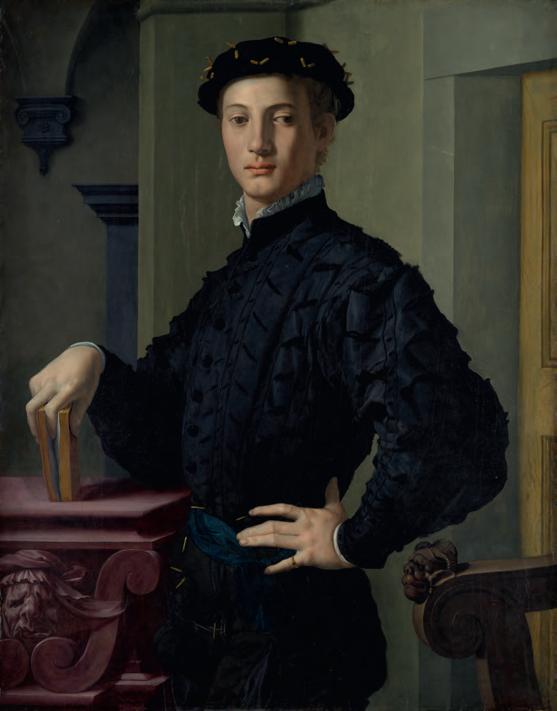
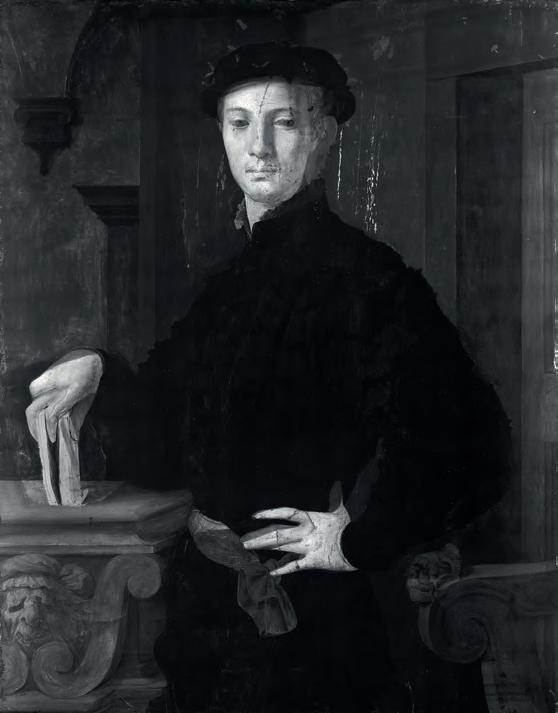
exploratory nature of the underdrawing in the Portrait of a lady in black 11 On the various dates proposed for the painting, see Beyer, op. cit. (note 9), pp.176–79, no.41. Bronzino’s numerous changes to the composition of the Portrait of a young man were noted as early as 1932, shortly after the painting entered the Metropolitan’s collection, when it was sent to the Fogg Museum of Art at Harvard University to be X-rayed; see A. Burroughs: ‘Bronzino X-rayed’, Creative Art 7 (1932), pp.222–24. 12 This was executed in April 2009; see entry by C.C. Bambach in C. Falciani and A. Natali, eds: exh. cat. Bronzino:
Artist and Poet at the Court of the Medici, Florence (Palazzo Strozzi) 2010–11, p.262, no.V.4. Images of the overall IRR and details from it are included on the museum’s website as figs.1–5, available at www.metmuseum. org/art/collection/search/435802, accessed 5th December 2022. It would naturally be helpful to be able to compare to IRRs for other female portraits by Bronzino closer in date to the work seen here but these are difficult to obtain. It is hoped that more museums will follow the Metropolitan’s example of publishing technical photography in their online databases.
the burlington magazine | 165 | january 2023 29
A Bronzino portrait of Isabella de’ Medici Orsini
in the underdrawing differs from the finished painting. Also comparable is the freedom of draughtsmanship in the rendering of the grotesque masks, although what is visible in the underdrawing of the head on the lady’s arm-rest appears even more animated than what can be seen in the IRR of the armrest and table in the New York portrait.13
The IRR of the New York portrait highlights an aspect of Bronzino’s technique that confirms his masterful understanding of the painter’s craft. He understood the importance of leaving reserves in his paintings for the subsequent application of specific colours, a standard practice at the time. In altering the positions of the fingers in the work, he found himself confronting the challenge of painting the extremely light tonality of flesh tones over an area that had already been painted black. In the Metropolitan portrait this process is now visible on the surface of the painting, appearing as bands of distinct colour in the central two fingers of the sitter’s left hand, an effect that has become visible over time as the paint layer has thinned. However, Bronzino also exploited this obstacle, for example, in the repositioning of the thumb of the same hand. This digit, resting against the figure’s side, is in deep shadow, an effect that is achieved partly through his painting of the thumb over the already executed black textile. Bronzino similarly turned this problem to his advantage in the painting of the ends of the two external fingers, with their fingernails also cast in shadow, and in the hollows between the central fingers and the external ones, where shadows would naturally appear.

The IRR of the Lady in black reveals that the artist originally drew the hands smaller, and better proportioned to the body. The pale flesh tones painted over the areas left in reserve are also easy to distinguish. In the lady’s proper right hand, the extension of the digits beyond the medal placed them over the black damask of her gown. On the painted surface, these areas read as a cooler tonality, cast in light shadow, giving increased three-dimensional volume to the curvature of the fingers. Although the areas of damage at the lower edge of the panel preclude our evaluation of the artist’s exploitation of the dark underpainting of the extended digits of her left hand, the expanded portion of the palm between the thumb and the wrist demonstrates how this was used to suggest an area of shadow, reinforcing the plasticity and relief of the hand.
Bronzino’s consciousness of the distinct tonalities that would be created by painting a light colour over a dark preparation find confirmation in the eyes as seen in the New York IRR.14 He darkened the ground of the reserve for the sclera of the eyes. This would appear to be counterintuitive for an area destined to be painted in white, but it facilitated his ability to render those areas of the eye with a cooler tonality, distinct from the white of the linen of the young man’s collar. This can all be paralleled in the IRR of the Lady in black, in which the white of the eyes similarly contrasts with the creamier whites of the sitter’s partlet and pearls.
13 For a detailed discussion of the underdrawing of the Metropolitan portrait and Bronzino’s numerous changes, see C.C. Bambach: ‘Theory and practice in Bronzino’s drawings’, in idem, op. cit. (note 9), pp.35–49, at p.47; and idem, op. cit. (note 12), pp.176–79, no.41.
14 The author thanks Annika Finne for discussing the technical photographs and for these observations about the painting of light tones over areas of dark underpainting.
15 This appears to be a distinguishing feature of Bronzino’s technique, as Allori seems to have employed somewhat less dark preparations
under the sclera of his portraits; compare, for example, the IRR of the portrait in Saint Louis, cited in note 10.
16 ‘era suo proprio ritrarre dal naturale quanto con più diligenzia si può imaginare’, G. Vasari: Le vite de’ più eccellenti pittori scultori ed architettori, transl. G. du C. de Vere: Lives of the Painters, Sculptors and Architects, London 1912, ed. D. Ekserdjian, New York 1996, II, p.871.
17 On this dichotomy, see S. Wellen: ‘Bronzino’s portrait of Antonio Lapi: a hypothetical identification with considerations of chronology and costume in Bronzino’s male portraits’,
In Bronzino’s portraits this technique for preparing to paint the faces renders them mask-like in the IRR images, a characteristic that has also been observed in his finished works.15 However, we should not let the artifice of these compositions and the painter’s numerous strategies to present his sitters as perfect incarnations of sprezzatura – the effortlessness that should characterise the actions of the ideal courtier as defined by Baldassare Castiglione – distract us from what all these observations confirm: Bronzino was deeply interested in certain aspects of naturalism, especially the rendering of distinct tactile sensations by capturing in paint specific effects of light on different surfaces. It was surely this quality in Bronzino’s portraits that Giorgio Vasari recognised when he stated, ‘it was his particular and peculiar field to portray from life with the greatest diligence that could be imagined’. 16 Bronzino’s
I Tatti Studies in the Italian Renaissance 21 (2018), pp.389–421, at pp.389–90.
18 For example, The descent into limbo by the Master of the Osservanza (previously attributed to Sassetta), c.1445 (Harvard Art Museums, Cambridge MA); see C. Alessi and P. Scapecchi: ‘Il “Maestro dell’Osservanza”: Sano di Pietro o Francesco di Bartolomeo?’, Prospettiva 42 (1985), pp.13–37, at pp.36–37, note 119.
19 For their wedding in Chicago in 1923, see ‘Northesk wedding today’, New York Times (19th July 1923), p.15.
20 Catalogue of Pictures by Old Masters and Drawings, the Property
of the Rt. Hon. the Earl of Northesk, removed from Ethie Castle, Arbroath, N.B. [ ] which will be sold by auction by Messrs. Christie, Manson & Woods… at their Great Rooms, London, July 13, 1928, London 1928, p.3, no.5.
21 A photograph of the painting from the Ehrich galleries in the Frick Art Reference Library (hereafter cited as FARL) is dated June 1931 and labelled Bronzino 722-6L. However, a handwritten note on the reverse of a photograph at the Fondazione Federico Zeri (hereafter cited as FFZ), inv. no.84709, records that the work was in the Ehrich Galleries prior
Focus
the burlington magazine | 165 | january 2023 30
on Bronzino
7. Portrait of a lady (Cassandra Bandini?), by Agnolo Bronzino. c.1550–55. Oil on panel, 109 by 84 cm. (Galleria Sabauda, Turin).
Bronzino portrait of Isabella de’ Medici Orsini
aristocratic and aloof sitters hardly seem to embody any characteristics of naturalism to our eyes, but that must have been precisely what made them so prized by his contemporaries.17 This is also one of the aspects of Bronzino’s style that distinguishes it from Allori’s, a matter that must be more fully addressed before a firm attribution of the Lady in black can be made. As the style of both painters naturally evolved over time, the date of the portrait should first be examined, clues for which emerge in part from its history and a close examination of the sitter’s identity.
A more complete provenance for the painting may now be proposed. Before the end of the nineteenth century, the work was in the collection of the Earls of Northesk at Ethie Castle in Arbroath, Scotland. It is likely that the portrait was purchased by William Hopetoun Carnegie (1794–1878), who became 8th Earl of Northesk in 1831. He collected medieval and Renaissance Italian paintings, many of which he acquired while living in Palazzo Poli, Rome, where he resided from approximately 1850 to 1870.18 Some of these, and others presumably collected by previous generations of the family, were consigned by David Carnegie, 11th Earl of Northesk, to an important sale in 1928, possibly prompted by concerns over the costs that would ensue from the his impending divorce from his first wife, Jessica Ruth Brown Reinhard, who had been a dancer with the Ziegfeld Follies.19 The fifth lot of the thirty-eight paintings sold at that time was attributed to Bronzino and identified as a ‘Portrait of a Lady, in embroidered black dress, with white lace chemisette, pearl necklace and gold chains, holding a book in her left hand. On panel – 41 in. by 39 ½ in.’.20
The work appears to have been purchased at the Christie’s sale by the Ehrich Galleries of New York, who owned the work by 1930.21 By 1936, it was with the Arthur U. Newton Gallery in New York, and was displayed publicly as a portrait of Eleonora di Toledo in October of that year.22 A brief review of the exhibition in the New York Times extolled the merits of the picture in glowing terms as ‘typical of Bronzino’s art’: ‘The flesh tones under creamy lace at the throat and shoulders demand admiration’.23 Notes on three photographs of the painting in the Fototeca Zeri, Bologna, provide further information about its early ownership.24 According to these notes, the work’s next location was the Van DiemenLilienfeld Galleries. An immigrant from Germany, Karl Lilienfeld opened his gallery in New York in 1925. From 1932 he also directed the New York branch of the Berlin-based Van Diemen galleries in 1932. A fusion of the two under the name ‘Van Diemen-Lilienfeld Galleries’ occurred in 1936, after the Berlin headquarters were liquidated by the Nazis in 1935.25 Thus, Lilienfeld probably saw the portrait when it was displayed in 1936 and acquired it for the new Van Diemen-Lilienfeld Galleries, where it was presumably purchased by the ancestors of the previous owners.
Historic photographs, probably executed in connection with the various sales, in both the Frick Collection’s Photoarchive, New York, and the Fototeca Zeri confirm that the painting was attributed to Bronzino
to 1930. The 1928 sale date would thus appear to be correct.
22 The gallery is named incorrectly on the FARL photograph as ‘Arthur W. Newton Gallery, London’, rather than Arthur U. Newton, New York, an error repeated in the entry for the recent Sotheby’s sale, op. cit. (note 1).
According to the notes on this photograph, Newton stated in February 1936 that he acquired the work in 1935 in London. However, given the presence of the painting in New York prior to 1931, this seems unlikely.
23 H.D.: ‘Old Masters’, New York Times (7th October 1936), p.25. The author thanks Elizabeth Pilliod for this precious reference and for discussing
the provenance of the work.
24 FFZ, inv. no.37450, available at www.catalogo.fondazionezeri.unibo.it, accessed 5th December 2022. The author thanks Enrico Ghetti for his kind assistance in researching the photographs in the Zeri archive.
25 For the history of the Van DiemenLilienfeld Galleries, see the Van Diemen-Lilienfeld Galleries Archive, National Gallery of Art, Washington, available at www.library.nga.gov/ discovery/fulldisplay/ alma991764133804896/01NGA_ INST:IMAGE, accessed 5th December 2022.
26 FFZ inv. no.84709: ‘Se fiorentino c.1570’.
during each of these passages of ownership, although Federico Zeri himself doubted the attribution and identified the portrait only as a Florentine work of c.1570.26 One photograph bears the stamp of the Van Diemen-Lilienfeld Galleries, and an annotation in English that states the work is ‘From the Family Collection of the Earl of Northesk, Ethie Castle, Arbroath, Scotland’, records its correct dimensions in inches and notes that the painting had been seen by Lionello Venturi, who confirmed the attribution to Bronzino.27 An anonymous handwritten note on the photograph that Zeri received from the Frick Art Reference Library, New York, recorded that the same attribution had been made by Hermann Voss.28
It is not surprising that the arresting young lady depicted in the portrait was misidentified in the early twentieth century as Eleonora di Toledo, first wife of Cosimo I de’ Medici. This would have been an obvious name to associate with a painting by Bronzino or one of his followers of a seated, aristocratic woman in an elaborate sixteenth-century court costume adorned with pearls and jewels. This identification may be rapidly excluded through comparison with any of the many known portraits of Eleonora. However, several aspects of the picture suggest that the sitter must be someone closely associated with her: the format, derived from the one invented by Bronzino specifically to represent the duchess; the pearl-encrusted snood worn by the young lady, which was a privilege reserved for the ladies of Eleonora’s court;29 and the physiognomy of the person depicted, which offers some analogies to the duchess’s own, although it may also be argued that these are the result of abstractions intended to emphasise contemporary ideals of female beauty.30
The textile of the elaborate gown worn by the sitter mixes floral motifs of cornflower or carnation and heart-shaped leaves, sometimes also identified as caper leaves. These vegetal motifs emerge from a crown, which may suggest a heraldic reading offering clues to the sitter’s identity. However, this may be excluded since the type of damask depicted was produced throughout the sixteenth century in Florence. A very similar example may be seen in the lining of a garment recovered from the tomb of the Duke of Gravina Ferdinando Orsini in San Domenico Maggiore, Naples, who died in 1549.31 This confirms the popularity of this textile among Spanish and Neapolitan elites, who regularly acquired their textiles from Florence, which were of higher quality than those available locally.
The same damask, in red rather than black, appears to have been used to construct the zimarra , or overdress, of the sitter in the Portrait of a lady in Turin (Fig.7), a work that has also occasionally been misidentified as a portrait of Eleonora di Toledo, but is generally thought to represent Cassandra Bandini.32 The magnificence of the Turin portrait may render it difficult for us to recognise the relative rank of the two sitters. The distinctions in the nature of the snoods
27 FFZ inv. no.84710: ‘Vide Professor Venturi’. 28 FFZ inv. no.84708. This was presumably communicated orally or in now-lost correspondence, as the work is not cited in H. Voss: Die Malerei der Spätrenaissance in Rom und Florenz, Berlin 1920, or in other essays by Voss that address Bronzino or his contemporaries.
29 R . Orsi Landini: ‘Snoods and hairstyles’, in idem and B. Niccoli: Moda a Firenze, 1540–1580: lo stile di Eleonora di Toledo e la sua influenza, Florence 2005, pp.135–40.
30 E. Cropper: ‘On beautiful women, Parmigianino, Petrarchismo, and the vernacular style’, The Art Bulletin
58 (1976), pp.374–94.
31 R . Orsi Landini: Moda a Firenze, 1540–1580: lo stile di Cosimo I de’ Medici, Florence 2011, pp.43–44, fig.8b. The author thanks Roberta Orsi Landini for her assistance in identifying the textile and the costume’s style, likely place of origin and dating.
32 First identified as Cassandra Bandini in the entry by C. Johnston in D. Franklin, ed.: exh. cat. Leonardo da Vinci, Michelangelo, and the Renaissance in Florence, Ottawa (National Gallery of Canada) 2005, pp.244–45, no.85. See also Beyer, op. cit. (note 9), pp.266–67, no.82.
the burlington magazine | 165 | january 2023 31
A
8.
9.
worn by each lady are an especially important clue: the lady in the Turin portrait has an unornamented hairnet attached to a simple pearl headband, whereas the Lady in black has a far more elaborate diadem and her hair is braided with long strings of pearls below the gold thread of her snood.33 Only one motif in the damask worn by the Young lady in black may point to something related to her identity. Directly over her abdomen, where the bodice ends above the elaborate gold belt and ample skirt, there appears to be a stylised version of the
33 Orsi Landini, op. cit. (note 29), p.108, caption to fig.45, noting that the Turin lady’s costume ‘reveals none of the signs of her rank’, and especially that ‘her clothes do not feature any golden ornament or embroidery’. The use of such jewel-encrusted headbands was not unique to the highest ranks of the aristocracy but it was an exclusive privilege of Eleonora’s daughters, as can be seen in Bronzino’s portrait of Maria de’ Medici in the Uffizi (inv. no.1890, 1572), and of her ladies-inwaiting, as can be seen in the portrait of Juana Guevara Ramirez di Montalvo, attributed to a follower of Bronzino, in the Worcester Art Museum, MA, inv. no.1910.20.
34 C.P. Murphy: Isabella de’ Medici: The Glorious Life and Tragic End of a
Renaissance Princess, London 2008, pp.17–18, notes that Isabella was born less than six months after Bia’s premature death and that she was immediately recognised even by those outside the court as a replacement for the loss of Cosimo’s beloved first daughter.
35 Orsi Landini, op. cit. (note 29), pp.84–85.
36 See most recently the entry by J. Siemon in Christiansen and Falciani, op. cit. (note 5), pp.198–201, no.50.
37 C. Plazzotta: ‘Bronzino’s Laura’, THE BURLINGTON MAGAZINE 140 (1998), pp.251–63, at p.257.

38 Rowlands, op. cit. (note 9), pp.186–87. Only Eleonora di Toledo would be depicted in an outdoor setting, and only once, in the grand Uffizi portrait
traditional Medici device of a diamond ring with three feathers. This is quite different from the crown that is woven into the similar textile used in the lining of the Duke of Gravina’s garment. Furthermore, its placement, framed between the two hands and over the sitter’s womb, suggests an explicit pictorial strategy.
Many questions about the sitter could be answered if the artist had rendered legible the portrait medallion hanging from the chain attached to her garment. Bronzino regularly made choices about whether to display or conceal such portraits within a portrait. In this specific case, a reasonable hypothesis may be offered for the subject of the hidden relief. Oval bronze, gilt bronze or gold portrait medallions were extremely rare in sixteenth-century Italy, most surviving examples being round.
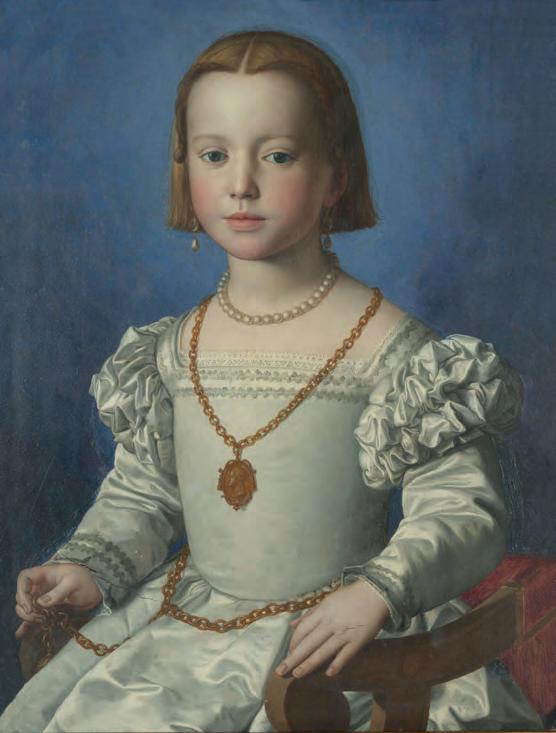
of c.1545. On this, see B. Edelstein: ‘Bronzino’s portrait of Eleonora di Toledo with her son Giovanni: the invention of a secular icon for the early modern state’, in N. Garcia Perez, ed.: Power in Sixteenth-Century Art: Creating and Promoting the Public Image of Early Modern Women, Abingdon (forthcoming).
39 E. Pilliod: Pontormo, Bronzino, Allori: A Genealogy of Florentine Art, New Haven 2001, pp.149–50.
40 S. Lecchini Giovannoni: Alessandro Allori, Turin 1991, p.48.
41 The attribution to Allori was made simultaneously by P. Costamagna: ‘Seconda parte – Les Portraits’, Antichità viva 27, no.1 (1988), pp.23–31, at pp.24–25 (as Ortensia de’ Bardi da Montauto); and G. Langdon: ‘A
reattribution: Alessandro Allori’s “Lady with a cameo”’, Zeitschrift für Kunstgeschichte 52 (1989), pp.25–45. Langdon later suggested an identification of the subject as Giulia de’ Medici, see G. Langdon: Medici Women: Portraits of Power, Love, and Betrayal from the Court of Duke Cosimo I, Toronto 2006, pp.121–36. However, the identification of the subject as Ortensia Montauto de’ Bardi appears more credible, see, among others, Pilliod, op. cit. (note 39), pp.179–82; Natali, op. cit. (note 10); and S. Giordani: entry, in Falciani and Natali, op. cit. (note 12), pp.332–33, no.VII.3.
42 Archivio di Stato di Firenze (hereafter cited as ASF), Guardroba Medicea (hereafter cited as GM) 45, fol.60v: ‘Un ritratto della Signora
Focus on Bronzino the burlington magazine | 165 | january 2023 32
Bia de’ Medici, by Agnolo Bronzino. c.1542–45. Oil on panel, 64 by 48 cm. (Gallerie degli Uffizi, Florence).
Laura Battiferri, by Agnolo Bronzino. c.1560. 83 by 60 cm. (Museo di Palazzo Vecchio, Florence; Bridgeman Images).
One notable exception is depicted in a well-known work by Bronzino, his posthumous portrait of Bia, Cosimo I’s first daughter, born out of wedlock prior to his marriage to Eleonora and raised at court with his other children until her premature death in 1542 (Fig.8). Bia prominently wears an oval portrait medallion of her father to confirm her lineage. Although no examples are known to survive, Bia’s portrait confirms at least the possibility that one was executed shortly after Cosimo’s elevation to the ducal title in 1537. A similar object might well have belonged to other princely children.34
If the medallion worn by the Lady in black was indeed intended to be understood as a portrait of Cosimo, it would not have needed to be legible to be recognisable at the Medici court. The form, and presumably the identity of the sitter, would have made its subject clear. All these clues suggest that the sitter was someone very close to both Cosimo and Eleonora, and that her relationship to them went beyond the bonds of friendship and servitude that connected the duchess to her ladies-inwaiting. In addition, the style of the garment worn by the lady, in which the bodice is longer than those seen in portraits of the 1540s, indicates a date around 1560 for the portrait.35 This date is also suggested by the style of the work, which may be compared to Bronzino’s remarkable portrait of Laura Battiferri (Fig.9), generally thought to have been painted at this time.36 In this portrait of his friend, then the most important female poet in Florence, Bronzino chose to depict her in profile, an archaic pose that emphasised her distinctive appearance and its similarities to that of Dante Alighieri.37 Both portraits are uncompromising in depicting the specificity of the features of two women whose prominent noses did not conform to contemporary ideals of female beauty. Yet, both display Bronzino’s sympathy for his sitters, conveying their beauty as transmitted through the elegance of their posture and gestures, as well as through the erudition implied by the books they display. The monochrome setting of each work – a pearl grey in the Portrait of Laura Battiferri, a sage green in the Portrait of a lady in black – also link them. By the 1560s, Bronzino had long abandoned the complex architectural environments that characterised his portraits of the 1530s and early 1540s, generally preferring to depict his sitters against a neutral background.38
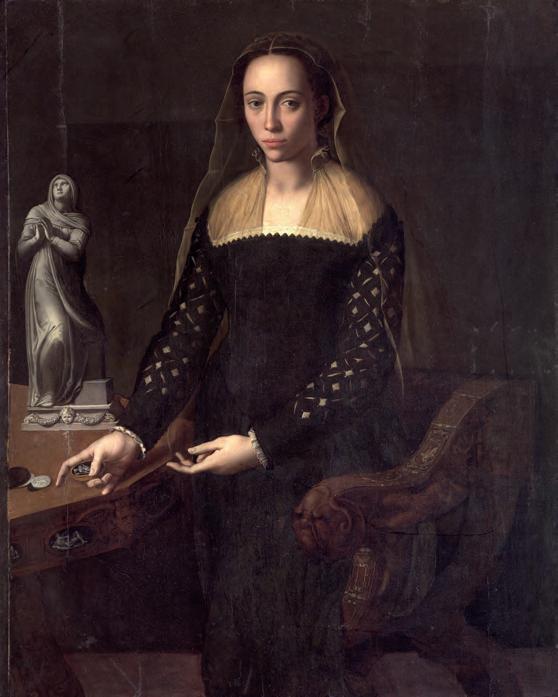
A date of c.1560 for the painting inevitably presents an attribution problem, as it was the year that Allori returned to Florence from Rome, where he had mostly been since 1554, following the end of his pupillage with Bronzino.39 By now an affirmed master, Allori began working autonomously for important patrons. However, he continued to collaborate with Bronzino, and also executed replicas and variants of portraits after the master’s prototypes.40 This has led to many thorny attribution questions, as Allori’s excellence, particularly in the representation of the tactile qualities of textiles and jewels, frequently rivals that of Bronzino’s own
Isabella di mano del Bronzino’. First published by J.H. Beck: ‘Bronzino nell’inventario mediceo del 1560’, Antichità viva 11 (1972), pp.10–12, at p.10, see also ASF, GM 65, fol.162 left, similarly listed as ‘Uno ritratto della Illustrissima Signora Isabella di man del Bronzino’, also published by P. Barocchi and G. Gaeta Bertelà: Collezionismo mediceo e storia artistica: Da Cosimo I a Cosimo II (1540–1621), Florence 2002, I, p.203.
43 K . Langedijk: The Portraits of the Medici: 15th–18th Centuries, Florence 1981–87, II, pp.1091–98. Her no.63,2 (Gallerie degli Uffizi, inv.1890, no.1500) and no.63,16 (Gallerie degli Uffizi, inv. no.1890, 1495), together with both of her uncertain identifications, may be excluded as portraits of
Isabella. See. L. Goldenberg Stoppato: ‘Appunti “fiorentini” per il Corpus della Ritrattistica degli Orsini,’ in C. Mazzetti di Pietralata and A. Amendola, eds: Gli Orsini e i Savelli nella Roma dei Papi: Arte e mecenatismo di antichi casati dal feudo alle corti barocche europee, Cinisello Balsamo 2017, pp.313–33, at p.318.
44 Langdon, op. cit. (note 41), pp.146–70. The works are depicted in her plates 11 (as Isabella de’ Medici Orsini with her son Virginio, by Alessandro Allori, but identified by the Wadsworth Atheneum as Portrait of a noblewoman and her son, ID 1988.14) and 12 (as Isabella de’ Medici Orsini with a dog, by Alessandro Allori, private collection).
dazzling technique. A useful comparison is offered by the Portrait of a lady with a cameo in the Uffizi, long thought to be by Bronzino but convincingly attributed to Allori (Fig.10).41 This work bears an inscription stating that it was executed in Rome in 1559 and thus offers a precise comparison between the Portrait of a lady in black and Allori’s style as a portrait painter at this moment. The method of modelling through chiaroscuro resulting in the more abstracted forms of the face and hands is especially characteristic, as are the somewhat fussier ornamental details of the chair and table. By this date, Bronzino had developed a more streamlined approach to his portrait settings, concentrating on the meticulous rendering of details of costume while maintaining his unique capacity to depict the three-dimensional forms of the body and hands. Allori’s attention to textiles and accessories may rival that of his master, but he is less concerned with the sculptural modelling of the body; the hands, in particular, while characterised by the contour lines of his strong draughtsmanship, generally appear flatter.
In the 1560 inventory of the Medici Guardaroba, reference is made to a painting that has not previously been convincingly identified by scholars: ‘A portrait of the Lady Isabella by the hand of Bronzino’.42 Is it possible that the Lady in black is this very painting? The question is not easily resolved but numerous pieces of evidence appear to confirm that identification. The known iconography of Isabella de’ Medici is highly problematic. In her magisterial study of Medici portraiture, Karla Langedijk identified seventeen possible portrait types of Isabella, several of which cannot be of the same sitter.43 Gabrielle Langdon added two works to Langedijk’s corpus, neither of which convincingly accord with a single physiognomy and are to be rejected as portraits of Isabella.44 Langdon was nonetheless correct in
10.
the burlington magazine | 165 | january 2023 33
A Bronzino portrait of Isabella de’ Medici Orsini
Portrait of a lady with a cameo, by Alessandro Allori. Oil on panel, 123 by 97 cm. (Galleria degli Uffizi, Florence; Bridgeman Images).
stating that any identification of a new portrait representing Isabella must be based on one of the securely identifiable works. Of these, the most secure is the portrait of Isabella in the Nationalmuseum, Stockholm (Fig.12). 45 This work has been variously attributed to Bronzino, to his school or considered a copy after an autograph work by him. 46 The painting’s condition is poor, with significant losses, possibly the result of damage during a fire, with large areas of infill and retouching, even after its most recent conservation in 1997. 47 Unfortunately, no technical photographs were taken during that campaign that might offer further evidence regarding its attribution. Still, its quality is very high, with some beautiful passages of original painting surviving, such as the lace of the partlet and in the features of the sitter, including the ringlets of hair along the sides of her forehead in front of her ears. Following a recent examination of the painting, and considering its damaged state, the present author would argue that there is no reason to exclude it from Bronzino’s œuvre.

The question of the Stockholm portrait’s attribution is not irrelevant to the questions at hand. Several of the same pictorial strategies have been used by the painter in both works. In particular, the hairline of the girl seen in each painting runs across her forehead,
45 On the portrait, Nationalmuseum inv. no.NM37, see the entry by J. Eriksson in S. Norlander Eliasson et al., eds: Italian Paintings: Three Centuries of Collecting, Nationalmuseum, Stockholm, Ostfildern 2015, I, pp.248–51, no.99.
46 Bernard Berenson first attributed the portrait to Bronzino but later attributed it to his workshop. See A. Emiliani: Il Bronzino, Busto Arsizio 1960, p.72, as by Bronzino; E. Baccheschi: L’opera completa del Bronzino, Milan 1973, p.109, no.171, as likely connected
to the series of miniature portraits on tin attributed to Bronzino and his workshop; Langedijk, op. cit. (note 43), II, p.1095, no.63,5, as school of Bronzino; Langdon, op. cit. (note 41), pp.109–10, 116, and fig.32, as after Bronzino; Eriksson, op. cit. (note 45), as attributed to Bronzino; and D. Gamberini: New Apelleses and New Apollos: Poet-Artists around the Court of Florence (1537–1587), Berlin 2022, pp.107–08, fig.9, as workshop.
47 On the condition of the work and its conservation history, see
11. Portrait medal of Isabella de’ Medici Orsini, by Domenico Poggini. 1560. Bronze, diameter 4.9 cm. (Museo Nazionale del Bargello, Florence).
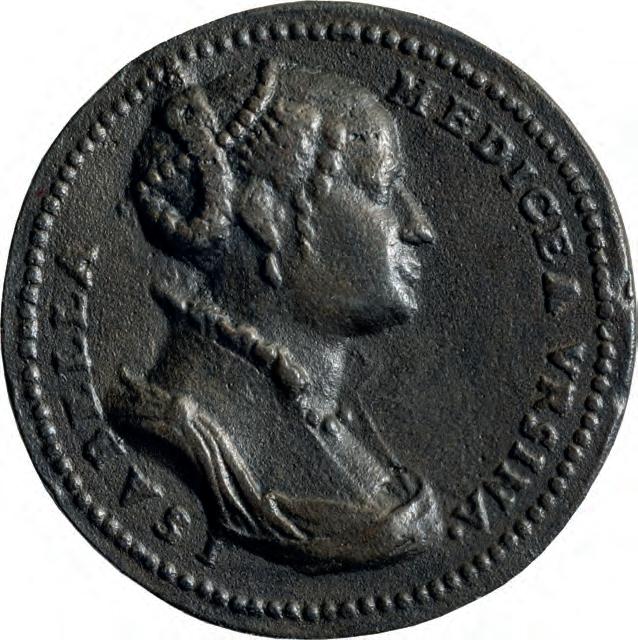
12. Isabella de’ Medici as a young girl, by Agnolo Bronzino. c.1553. Oil on panel, 44 by 36 cm. (Nationalmuseum, Stockholm).
with a parting in the centre. The sides of the forehead and the ears are framed by round curls, which appear to be painted with a very similar technique, in which the artist drew the butt end of the brush through the curls to help define their forms, highlights and shadows. As far as we can tell from her portraiture, Eleonora did not style her hair this way at any point in her lifetime, instead keeping her hair pulled tightly back and kept in a snood. Although a fashion for such ringlets began in the 1550s 48 – the Turin Lady offering just one example – the portrait in Stockholm may actually predate that trend. As this feature appears to be recognisable in all the reliable portraits of Isabella, it can be argued that it was a characteristic of her hair, which may have been naturally curly, resisting being tamed into the perfectly coifed style preferred by her mother. The colour of the hair in both portraits tends towards red, with the somewhat abraded hair in the Stockholm portrait appearing a slightly lighter shade. Other features of the two portraits also accord well for the identification of the Lady in black as Isabella. In all the
Eriksson, op. cit. (note 45), p.248. At the Nationalmuseum, the author would like to thank Carina Fryklund, Curator of Old Master Paintings, Drawings and Prints before 1700, for facilitating his research and Lena Dahlén, Paintings Conservator, for kindly sharing information available in the museum’s files.
48 Orsi Landini, op. cit. (note 31).
49 Eriksson, op. cit. (note 45), p.250. The contract for the betrothal was signed on 11th July 1553; Goldenberg Stoppato, op. cit. (note 43), p.313.
50 B. Edelstein: ‘“La fecundissima
Signora Duchessa”: the courtly persona of Eleonora di Toledo and the iconography of abundance’, in K. Eisenbichler, ed.: The Cultural World of Eleonora di Toledo: Duchess of Florence and Siena, Aldershot 2004, pp.71–97. See also Langdon, op. cit. (note 41), pp.116 and 163.
51 Paolo Giordano was originally offered a choice between Isabella and Lucrezia but opted for the elder of the two sisters. The relationship was remarkably felicitous, as documented by their unusually affectionate
Focus
the burlington magazine | 165 | january 2023 34
on Bronzino
reliable portraits of Isabella, the corners of her mouth turn up past the fleshy portions of her lips. The upper lip has a pronounced Cupid’s bow shape, with a strongly modelled philtrum below the nose. The chin is straight, not cleft, and certainly not receding. The eyes are brown, while the shapes of the eyelids and opening of the eyes, and the forms and colouration of the brows and lashes, are comparable in both works. Undoubtedly the greatest distinction between the physiognomy of the Stockholm Isabella and the Lady in black is her nose. In the latter, the sitter has a significant nose that juts out and descends slightly, casting a shadow over the upper lip.
It has been reasonably suggested that the Stockholm portrait was commissioned at the time of Isabella’s betrothal to Paolo Giordano Orsini in 1553 as a gift for him. 49 The cornucopia-shaped earrings she wears were thus intended to suggest her potential fertility, in addition to connecting her to an iconography of abundance closely associated with her mother, who had already borne ten children by March of that year.50 Whereas portraits of their male children were all commissioned from very young ages, the only portrait of one of the female children initially requested by Cosimo or Eleonora was that of the eldest daughter, Maria. This was probably because Maria was destined from a young age for a prestigious marriage to Alfonso II d’Este, the future duke of Ferrara. When she died prematurely, she was replaced by her younger sister Lucrezia, Isabella in the interim having been chosen by Orsini as his bride.51 This too would seem to confirm that the Stockholm portrait of Isabella was commissioned following her betrothal. No portraits of Lucrezia, for example, appear to have been painted prior to her marriage to Alfonso in 1558.
Isabella was the third child, born in August 1542, and would therefore be about eleven years old in the Stockholm painting. In a portrait painted c.1560 she would have been around eighteen. If she is the sitter in the Portrait of a woman in black , it is possible that the large nose seen in that work was a more recent development in her physiognomy, having emerged during puberty. Confirmation of this is provided by another reliable source for her iconography, the portrait medal of her and her husband by Domenico Poggini, cast precisely in 1560 (Fig.11). Allowing for the differences in scale and media, and the profile pose preferred in medals, one can confirm several aspects of Isabella’s appearance as recognised by contemporaries: the prominence of her nose, the shape of her chin and even the curls descending along the side of her face.52 We may also note that she appears surprisingly matronly for a woman of eighteen. This accords with the mature appearance of the sitter in the Lady in black , which is appropriate for the gravitas of the aristocratic subject, as well as reflecting the generally more adult appearance of youth in sixteenthcentury portraiture.
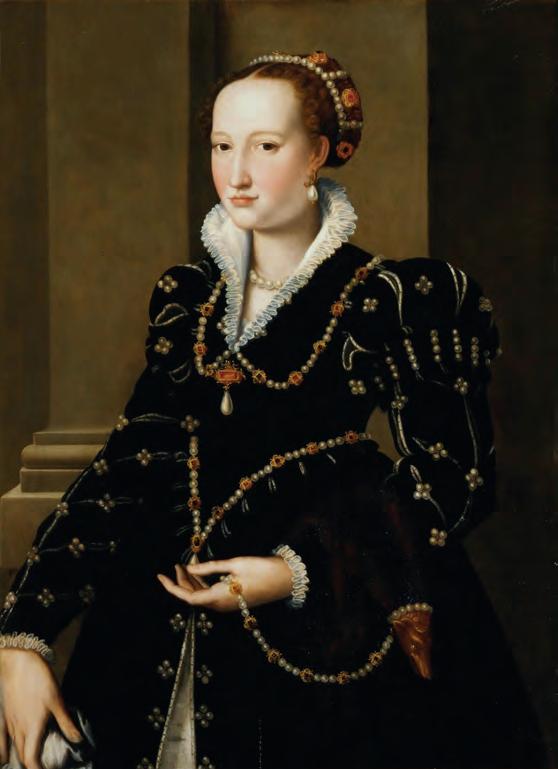
For the sake of brevity, it is not possible to compare the Lady in black with each of the portraits currently identified as depicting Isabella. However, it is worth considering one more example, a
correspondence; see E. Mori, ed.: Lettere tra Paolo Giordano Orsini e Isabella de’ Medici (1556–1576), Rome 2019.
52 The prominent nose and curls of hair along the side of her forehead also appear in a later portrait of Isabella, formerly at Schloss Ambras and now in the Kunsthistorisches Museum in Vienna. See Langedijk, op. cit. (note 43), II, p.1092 fig.63,3; and Langdon, op. cit. (note 41), p.149 and fig.46.
53 However, for the intriguing suggestion that the work should be
attributed to a lesser-known student of Bronzino, Alessandro Pieroni, see Goldenberg Stoppato, op. cit. (note 43), p.318.
54 Langedijk, op. cit. (note 43), II, pp.1093–94, fig.63,4; and Langdon, op. cit. (note 41), pp.157–59.
55 ASF, GM 28, published as C. Conti: La prima reggia di Cosimo I de’ Medici nel Palazzo già della Signoria di Firenze descritta ed illustrata coll’appoggio d’un Inventario inedito del 1553 e coll’aggiunta di molti altri documenti, Florence 1893.
painting usually attributed to Alessandro Allori (Fig.13). 53 Allowing for distinctions in the quality of the two portraits, and the greater level of abstraction in the Palazzo Pitti painting, it can be seen that that the nose is nonetheless important, and that its tip descends over the upper lip, which is of a prominent Cupid’s-bow shape with the philtrum in strong relief. The sides of the mouth curve up, the chin is similarly shaped and the hairstyle displays the strong central parting, straight brow line and descending ringlets. The many surviving replicas and variants of the Palazzo Pitti portrait suggests its success with the sitter, who may well have appreciated the flattering idealisation of her distinctive features.54
The 1560 inventory offers few clues to confirm that the work listed in it is the Lady in black . Unlike some registers, this one does not include the size of the works. However, the work described in 1560 is clearly identified as having been painted by Bronzino. An analysis of numerous Medici Guardaroba registers covering a significant period of time offers some confirmation that this identification is reasonable. No portrait of Isabella is recorded in the Medici Guardaroba prior to 1560. This is perhaps surprising, given the likelihood that the Stockholm portrait was executed c.1553. A major and well-studied inventory of Palazzo Vecchio was taken in that year.55 Nor is the painting described in any of the subsequent Guardaroba registers documenting additions to the Medici collections between 1553 and 1560. This suggests that
the burlington magazine | 165 | january 2023 35
A Bronzino portrait of Isabella de’ Medici Orsini
13. Portrait of Isabella de’ Medici Orsini, by Alessandro Allori. After 1560. Oil on panel, 99 by 70 cm. (Gallerie degli Uffizi, Florence).
the Stockholm painting never entered the Guardaroba but was sent directly to Orsini in Rome immediately upon its completion. This hypothesis would seem to be confirmed by the lack of replicas of it in Florence,56 and may be further supported by the fact that the wellknown portraits of Isabella’s siblings as children are generally clustered together in the inventories and specified as having been made ‘when he (or she) was little’.57
The reference to the portrait of Isabella by Bronzino in the 1560 register thus likely records a work that had just been executed and consigned to the Guardaroba. Confirmation for this may be provided by comparison with another register compiled at the same time, which makes clear that both inventories were ordered to take stock at the end of the tenure of Mariotto Cecchi as guardarobiere. In the ‘Spoglio’ (compendium) of the registers kept by Cecchi through to the end of his administration, on 17th August 1560, there is no reference to a portrait of Isabella, although many of the same paintings are recorded in both this volume and the 1560 inventory.58 The inventory in which Bronzino’s portrait appears was compiled under the supervision of the ducal Depositario Generale Antonio de’ Nobili and was begun on 1st July 1560.59 This means that the painting was completed in the second half of the year.
The painting appears again in only one other inventory in which the keeper of the Guardaroba also registered the consignment of objects, usually indicating their destination and use, for example as gifts, for display in one of the ducal residences or as models lent to artists to make replicas.60 However, the departure of the painting from the storage areas of the Palazzo Vecchio is not recorded there. Still, it must have been removed because it does not appear in subsequent registers, suggesting that it remained only briefly in the storage areas of the Palazzo Vecchio.61 Isabella resided almost exclusively in Florence following her marriage, except for a brief period in Rome, which apparently she disliked.62 In her absence, she sent several portraits of herself to her husband in Rome. Paolo acknowledged the receipt of one of these in 1562.63 This could well be Bronzino’s portrait, so soon after it was presumably executed. If the work was sent to Rome, this would help to explain why it subsequently disappeared. Sometime after Isabella’s
56 Eriksson, op. cit. (note 45), pp.249–50, notes the existence of a copy in a private collection. However, this would seem to be a nineteenthcentury replica by the German painter Friedrich Müller, whose signature may be on the reverse.
57 In ASF, GM 65, fol.162 left, the portrait of Isabella immediately follows ‘Un ritratto dell’Illustrissimo principe [Francesco]’ and ‘Un ritratto dell’Illustrissimo Signor Don Gratia [Garzia]’, both of which are specified as depicting them ‘quando era piccolo’, in addition to recording that they were ‘di man del Bronzino’.
58 ASF, GM 46.
59 ASF, GM 45.
60 ASF, GM 65.
61 A painting that was either the Stockholm portrait or a related work is recorded once, in one of the 1570 inventories; see ASF, GM 75, fol.62
right: ‘Uno quadro con hornamento di nocie della signora donna Isabella quando era banbina’. In another copy of the inventory taken the same year, the painting is specified as a ‘quadretto’, which may suggest that it was a now-lost replica executed for the miniature series of portraits on tin produced by Bronzino and other
members of his workshop; see ASF, GM 73, fol.45 left.
62 A . Amendola: Gli Orsini e le arti in età moderna: collezionare opera, collezionare idee, Milan 2019, p.135.
On her distaste for the Orsini castle in Bracciano, see Murphy, op. cit. (note 34), pp.82–85. Isabella travelled to Rome on three occasions: in the train of her parents, for their reception by the Pope in 1560; with her father again in 1570, for his elevation to the title of Grand Duke; and for the start of the Holy Year in 1575. See B. Furlotti: A Renaissance Baron and his Possessions: Paolo Giordano I Orsini, Duke of Bracciano (1541–1585), Turnhout 2012, p.13, note 36. 63 Ibid., p.16.
64 Furlotti records three portraits of Isabella consigned to the Roman convent of Torre de’ Specchi, documented in inventories taken after Orsini’s death in 1585, Furlotti, op. cit. (note 62), p.16, esp. note 51. Already in February 1556, during his first trip back to Rome after his transfer to the Medici court in Florence, Paolo begged Isabella to send him her portrait, see Mori, op. cit. (note 51), pp.63–64.
65 Eriksson, op. cit. (note 45), pp.248–49. On Byström and his
death in 1576, Orsini consigned her portraits to a convent, possibly to prepare his Roman palace to welcome his mistress and later second wife, Vittoria Accoramboni.64 One of Bronzino’s portraits of Isabella may have been among these, although both may have ultimately found their way onto the Roman art market by a similar route. The Stockholm painting has a documented Roman provenance from the collection of the sculptor Johan Niklas Byström, who probably acquired it around 1825 while living in the city.65 The Scottish provenance for the later portrait suggests that it too was purchased in Rome during the slightly later residence of the 8th Earl of Northesk.
The consummation of Isabella’s marriage in 1558 would have been a possible motivation for commissioning a portrait of her from Bronzino. However, another more likely reason occurred in October 1560, when Orsini’s title was upgraded to Duke of Bracciano, following negotiations with Pope Pius IV that were already under way by June of that year. This was what inspired the production of Poggini’s medal.66 Bronzino’s reliance on a portrait type invented for Eleonora, then, was not simply a rhetorical device but a pictorial choice made to celebrate Isabella’s new status as a duchess. This may also explain why he opted for another change to his initial composition, visible in the X-radiograph of the painting (Fig.14). He originally depicted Isabella’s sleeves as attached to her bodice by bows, which were then eliminated and substituted with gold clasps. The choice simplified the contour of the costume, making it appear less fussy and less youthful, more appropriate to a mature woman who was prepared to lead as a head of state. Similar clasps appear on the bands joining the sleeves to the bodice of Eleonora’s more elaborate costume in the Uffizi portrait, in both cases a luxury accessory that emphasised the sitter’s status.
For one of these two occasions, in either 1558 or 1560, the court intellectual Benedetto Varchi, a close friend of Bronzino, wrote a sonnet in celebration of Isabella and her military husband, ‘Nuova casta Ciprigna e nuovo Marte’ (‘New chaste Cypris and new Mars’). The poem is well known to art historians for Varchi’s celebration of Bronzino’s ‘educated pen being equal to his erudite brush’, a reference to the artist’s exceptional talents as both painter and poet.67 Varchi’s poem has been studied by numerous scholars, who have attempted to connect it to
collection, see also S. Ekman: ‘The collecting sculptor: the rediscovered paintings from the Byström Collection in the Nationalmuseum’, in Norlander Eliasson, op. cit. (note 45), pp.233–47. 66 Murphy, op. cit. (note 34), pp.78–79.
67 For Varchi’s poem and Bronzino’s reply, see Gamberini, op. cit. (note 46), pp.207–08, lines 14–15; and A. Geremicca: Agnolo Bronzino: “La dotta penna al pennel dotto pari”, Rome 2013, p.257, LXV–LXVI: ‘la dotta penna al pennel dotto pari’.
68 See, among others, M. Rossi: ‘“… that naturalness and Florentinity (so to speak)”: Bronzino: language, flesh and painting’, in Falciani and Natali, op. cit. (note 11), pp.177–93, at p.177; Gamberini, op. cit. (note 46), pp.107–108. See Geremicca, op. cit. (note 67), pp.74, 94–95, 173 and 175; and D.
Parker: Bronzino: Renaissance Painter as Poet, Cambridge 2000, pp.87–88.
69 ‘Farne doppia potete eterna storia’; ‘ond’a doppio per voi l’Arno si gloria’.
70 As Furlotti notes, the portrait sent by Isabella to Paolo Giordano in 1562 was intended to be part of an exchange. On 18th October he wrote to Isabella acknowledging the receipt
of her portrait; on 19th October he wrote again, promising to send one of himself soon, stating, ‘Every night I sleep with your portrait and it is most dear to me’; Furlotti, op. cit. (note 62), p.16, note 50 (translation by the author), p.186; for complete transcriptions, see Mori, op. cit. (note 51), pp.129–33. The deaths of two of Isabella’s brothers and her mother in the following months may have interrupted the project to commission a pendant portrait.
71 Gamberini, op. cit. (note 46), pp.108–09. It is especially relevant that the example of a recusatio by Bronzino in response to a sonnet written by another contemporary, Gherardo Spini, belied his feigned inability to rise to the challenge posed by Spini regarded his famous portrait of Laura Battiferri. That painting is generally dated to 1560, see Siemon, op. cit. (note 36). Thus, the production of the two portraits and the two poetic exchanges would have been exactly contemporary.
72 Orsini was also close to Varchi, who began but left unfinished a series of unpublished poems dedicated to the 1558 consummation of the marriage to Isabella. Varchi also
Focus
the burlington magazine | 165 | january 2023 36
on Bronzino
the production of a double portrait of Isabella and Orsini.68 However, the references in the sonnet to something ‘double’ are not to a double portrait but to Bronzino’s unique ability to depict with both pen and brush, with which ‘you can make eternal history double’ and ‘for which the Arno glories doubly for you’.69
Varchi’s poem is couched as an incitement to Bronzino to depict the young couple, possibly in a pair of pendants of which only the portrait of Isabella was completed.70 In her recent study of poet artists at the Medici court, Diletta Gamberini has observed that poems like Varchi’s were often ex post facto creations to celebrate a work already executed or underway.71 Isabella was considered particularly erudite and had close ties to Varchi’s literary circle.72 Indeed, the book she holds in the portrait, given its size and the nature of its binding, with the charming grotesque mask clasps that hold it shut, is very likely to have been understood as a book of poetry.73 Varchi’s poem begins with an homage to the ‘new chaste Cypris’ Isabella. The Cypriot in question is naturally Venus, who in most ancient accounts first came to shore on the island following her birth when Saturn’s genitalia fell into the foam of the sea.74 If we look back at the portrait, and reconsider the artist’s obsessive reworking of the positions of the hands to get them precisely correct, we may observe that although he has portrayed Isabella seated, he has clearly given her the gesture of a Classical Venus pudica 75 In the culture of mid-sixteenth-century Florence, this would have been instantly recognisable. Clothed, and not nude like the ancient statues that inspired the artist, Isabella is indeed a ‘chaste Venus’, appropriate for the young wife who incarnates the goddess of love but does so decorously, within the bounds of marital fidelity. This gesture frames
a portion of Isabella’s costume and the body implied beneath it, around her womb. By May 1560, Isabella was pregnant, although she lost the child by September, a month before she and her husband were received by Pius IV to confirm their elevation as Duke and Duchess of Bracciano.76
The witty, literary, Classical reference implicit in the gesture is typical of both Bronzino and Varchi’s poetry. We should expect Varchi to have recognised the intent behind his friend’s concept, and the reference in the sonnet is indeed apt for the painting. Of course, the allusion to Classical sculpture draws the portrait into the ongoing debates over the paragone that Varchi promoted among the artists of the Florentine court. Bronzino was one of the artists he invited directly to reply to his query about the relative merits of painting and sculpture.77 The compositional choice may, however, have been made knowing that it would have been especially appreciated by Orsini, who began collecting antiquities at just this moment, some of which were sent as gifts to the Florentine court.78
If the attribution of the Lady in black to Bronzino and the sitter’s identification as Isabella de’ Medici are accepted this would make it among the last major portraits he executed. Tasked with completing numerous large-scale devotional works, and to design a significant portion of the ephemera for the festivities of 1565 that accompanied the marriage of Cosimo and Eleonora’s son Francesco I de’ Medici to Johanna of Austria, the painter-poet had little time to devote to portraiture subsequently. Into this void would step his students, of whom only Allori rivalled his talents. Allori was particularly favoured as a portrait painter by the women of the Medici court, presumably for his ability to paint luxury textiles and jewels with much of the same dazzling effect as his master. That these depictions were also more idealising may have contributed significantly to his patrons’ satisfaction with his work. Yet, Bronzino’s greater naturalism distinguishes his portraits from those of his students, along with his unrivalled capacity to depict the behaviour of textiles and create a credible, haptic presence for contemporary costumes. The Portrait of a lady in black may now be recognised for who she really is, ‘a portrait of the lady Isabella by the hand of Bronzino’.
dedicated his 1562 anthology Sonetti contro gli Ugonotti to him, in addition to an unpublished manuscript collection of Latin poetry; Furlotti, op. cit. (note 62), pp.6–7; and Gamberini, op. cit. (note 46), p.106, note 300. On Isabella’s erudition, see Furlotti, op. cit. (note 62), p.9; and E. Mori: ‘Isabella de’ Medici e Paolo Giordano Orsini: la calunnia della corte e il pregiudizio degli storici’, in G. Calvi and R. Spinelli, eds: Le donne Medici nel sistema europeo delle corti XVI–XVIII secolo, Florence 2008, II, pp.537–50, at p.550.
73 See Beyer, op. cit. (note 9), pp.176–79, no.41. The appearance of the volume is particularly close to that held by Carlo Rimbotti in his portrait by Salviati; ibid., pp.187–88, no.45. This suggests the likelihood that both painted books were specifically intended to be recognisable as petrarchini
74 R .E. Bell: Women of Classical Mythology: A Biographical Dictionary, Oxford 1993, p.54; and E. Tripp: The Meridian Handbook of Classical Mythology, New York 1970, p.57.
75 The pose is related to that developed by Bronzino for his Eleonora di Toledo with her son
Francesco in the Palazzo Reale in Pisa, although the positioning of the hands more emphatically underlines the connection to the ancient sculptural type in the portrait of Isabella.
76 Isabella’s first pregnancy, documented in March 1559, was similarly unsuccessful, see E. Mori: L’onore perduto di Isabella de’ Medici, Milan 2011, pp.99, 104 and 119–20.
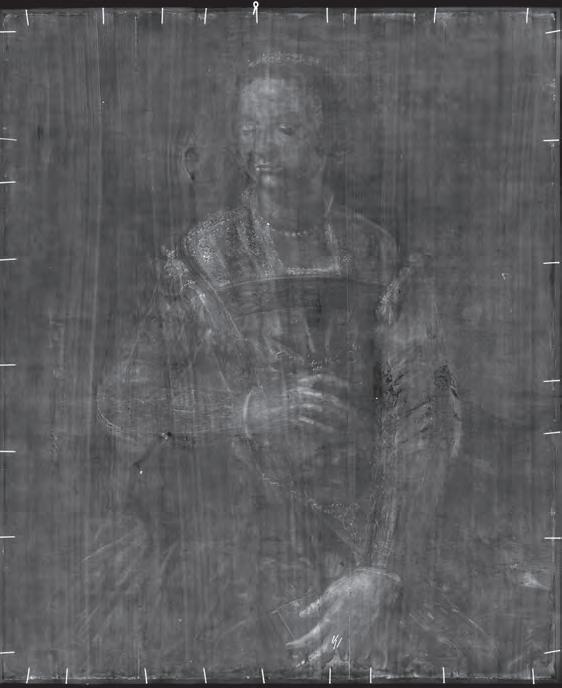
77 For Bronzino’s reply, see ‘Al molto dotto M. Benedetto Varchi mio onorando’, in P. Barocchi, ed.: Pittura e scultura nel Cinquecento, Livorno 1998, pp.66–69.
78 Amendola , op. cit. (note 62), pp.136–37. Isabella herself subsequently commissioned Vincenzo Danti to carve a Venus with two Cupids (Casa Buonarroti, Florence); ibid., 137–39. On Orsini’s collection of antiquities, see B. Furlotti: ‘Collezionare antichità al tempo di Gregorio XIII: il caso di Paolo Giordano Orsini’, in C. Cieri Via, I.D. Rowland and M. Ruffini, eds: Unità e frammenti di modernità: arte e scienza nella Roma di Greogrio XIII Boncompagni (1572–1585), Pisa 2012, pp.197–216.
the burlington magazine | 165 | january 2023 37
A Bronzino portrait of Isabella de’ Medici Orsini
14. X-radiograph of Fig.2. (Courtesy Thierry Radelet Laboratory).
discoveries in the parma baptismal registers: i
Parmigianino as godfather
The first of three articles presenting discoveries in the Parma baptismal registers relating to artists in the first half of the sixteenth century identifies the occasions on which Parmigianino stood as godfather and explores their significance for understanding his social networks.
by mary vaccaro
Baptismal registers are repositories of potentially rich, though often understudied, documentary evidence about artists in early modern Europe. Because the Christian ritual of baptism operates both vertically and horizontally – the sponsor becomes not only a spiritual parent (patrinus or matrina) of the child but also a co-parent (compater or commater) with the child’s parents – the resulting kinship, known as compaternitas, has long offered a fundamental way to forge and solidify alliances among friends, neighbours and business associates. This article is the first of a tripartite series that gleans information from the registers of the Parma Baptistery to map the social networks of Francesco Mazzola, called Parmigianino (1503–40), and other artists active in the city during the first half of the sixteenth century, as well as to elucidate one of his most intriguing portraits.
The present article builds on the discovery of an entry, published in 2007, involving Parmigianino as godfather for the daughter of the painter Michelangelo Anselmi (1491–c.1556), brought to the font in September 1532 (see Appendix 2 below).1 As it turns out, this was neither the first nor the only time that Parmigianino served in such a capacity. Hitherto
This essay and the others in the series are dedicated to the memory of the author’s dear friend and colleague Rick Brettell.
1 See M. Vaccaro: ‘Artists as godfathers: Parmigianino and Correggio in the baptismal registers of Parma’, Renaissance Studies 21 (2007), pp.366–76.
2 For bibliography on baptism and coparenthood in early modern Europe, see Ibid., pp.366–69. Recent studies include G. Alfani: Fathers and Godfathers: Spiritual Kinship in Early-Modern Italy, Burlington VT 2009, transl. C. Calvert; G. Alfani and V. Gourdon, eds: Spiritual Kinship, 1500–1900, London 2012; and G. Alfani, V. Gourdon and I. Robin, eds: Le Parrainage en Europe et en Amérique: Pratiques de longue durée (XVIe–XXIe siècle), Brussels 2015.
3 M. Lopez: Il Battistero di Parma, Parma 1864, pp.116, 137–38, notes 54
and 298. For more on the dogmani, see Ordinarium ecclesiae Parmensis e vetustioribus excerptum reformatum a MCCCCXVII, Parma 1866, pp.71–76.
4 This preface (by Don Francesco Cassola) no longer survives, for which see A. Bianchi: ‘L’archivio del Battistero di Parma’, in G. Zacchè, ed.: Porta Fidei: le registrazioni pretridentine nei battisteri tra Emilia Romagna e Toscana (atti di convegno), Modena 2014, p.161. Yet it was transcribed in its entirety by A. Pezzana: Storia della città di Parma continuata da Angelo Pezzana, Parma 1847, III, appendix, p.13, doc.V; see also the still-extant preface (by Don Gabriele Pelosi, dated 1st January 1487) to the second baptismal register (1487–1504), ibid., appendix, pp.81–82, doc.XIII.
5 No comprehensive analysis of the city’s baptismal registers exists. For a broad overview of the provincial
the burlington magazine | 165 | january 2023
unknown register entries, transcribed and discussed here, reveal that he stood as godfather at least three more times during the last decade of his life for the offspring of fellow artists and architects. Significantly, the documents attest to his ongoing ties to a larger community and challenge the popular narrative told by Giorgio Vasari in the 1568 edition of his Lives of the Artists, in which Parmigianino’s supposed obsession with alchemy distracted him from work and turned him into an unkempt savage.
By the end of the sixteenth century, Tridentine reforms had begun to regulate the sacrament of baptism by limiting the number of godparents to one or, at the most, one of each sex for every child, and obliging parishes to maintain official written records. Earlier case studies of European cities reveal a diversity of regional practices that make generalisations prior to the Council of Trent difficult. Previously, depending on local tradition, babies might have had as many as twenty (or more) godparents. So, too, record-keeping varied widely from place to place and could be desultory or non-existent.2
In 1459, to keep track of familial relations and avoid the possibility of consanguineous marriage, the commune of Parma decided to mandate the registration of its baptisms. It appointed two of its anziani (elders), who
ecclesiastical records, see A. Moroni et al.: I libri parrocchiali della provincia di Parma, Parma 1985, esp. pp.48–50.
6 The first register lacks the years 1462, 1465–68, 1471–75, 1477 and 1482–83 in their entirety, as well as parts of the years 1464, 1470, 1479 and 1481, see Lopez op. cit. (note 3), p.138, note 54.
7 Local usage of one girl’s name (Antea) will be discussed in the final essay of this series. For other applications of data from the baptismal registers, see, for example, G. Hanlon: Death Control in the West 1500–1800: Sex Ratios at Baptism in Italy, France and England, London 2022, esp. pp.62–75, with bibliography.
8 I. Affò: Vita del graziosissimo pittore Francesco Mazzola detto il Parmigianino, Parma 1784, p.12. See also ibid., p.10, note 1, for his incisive rebuttal to a critic lamenting that ‘c’importa pochissimo sapere se il
Padre del Parmigianino fosse Filippo o Giacomo; s’egli nascesse alli 11 di Gennajo o ai 13; se questa o quella gli servisse al battesimo di Comare’.
9 E. Scarabelli Zunti: ‘Documenti e memorie di belle arti parmigiane’, Parma, Biblioteca della Soprintendenza ai Beni Artistici e Storici di Parma e Piacenza, MS 102, consisting of ten volumes on which he worked for a halfcentury until his death in 1893. Only the first volume, which spans the years 1050–1450 was published posthumously, see E. Scarabelli Zunti: Documenti e memorie di belle arti parmigiane, ed. S. Lottici, Parma 1911. See also F. Dall’Asta: ‘Indici di “Memorie e documenti di belle arti parmigiana” di Enrico ScarabelliZunti, “coltissimo archivista parmense”’, Aurea Parma 76 (1992), pp.230–47; and Aurea Parma 77 (1993), pp.34–52 and 147–58.
10 L. Testi: ‘Una grande pala di
38
in turn delegated the task (with compensation) to clerics, presumably the special rank of the Parma clergy known as the dogmani, whose work revolved around the Baptistery in Parma.3 The first baptismal register begins in that year, its preface confirming the decree to log the names of children and their parents, along with the godparents, who were required to be at least twenty-five years of age.4
A careful survey of the earliest registers that collectively span almost a century (1459–1545) gives insight into the pre-Tridentine baptismal customs in Parma.5 The extant records can be fragmentary, especially in the initial volume (1459–86), where entire years are missing.6 Not only does the handwriting change over time – understandably since different scribes undertook the task even during the same period – but so does the basic information provided in the entries. For example, originally only the father tends to be identified as the parent of a given infant. By 1506, however, the mother’s first name also regularly appears, along with her relationship to the father, the most common designation being uxor (wife), yet other labels, such as concubina or amica, suggest that marriage was hardly a requirement. Two or three godparents (at least one of each sex) are typically listed per child, although there are often more, especially for the offspring of eminent families. Indeed, the registers yield fascinating data about socio-historical topics ranging from the frequency of out-of-wedlock births to the relative popularity of names given to babies in Parma.7
Baptismal records also shed light on the everyday lives of artists such as Parmigianino. As early as the eighteenth century the erudite local historian Padre Ireneo Affò pointed to their importance for establishing the painter’s correct birthdate.8 In the next century Enrico Scarabelli Zunti mined the baptismal registers as part of his ambitious compilation of archival documents, laying essential groundwork about artists active in Parma.9 In 1908–10 Laudedeo Testi made genealogical trees for Parmigianino’s earlier extended family as well as for the branch continued by his artist-cousin Girolamo Mazzola Bedoli (c.1505–69), albeit without mention of godparents.10 In 1932 Giovanni Copertini first published the fully transcribed entry for Parmigianino’s baptism, along with a list of his siblings’ birthdays drawn from the registers.11 The entries for these infants have since been published by Marzio Dall’Acqua, who rightly emphasised their value in helping to understand the family’s social status.12
Parmigianino’s father, Filippo (c.1460–1505), and two of his uncles, Pier Ilario and Michele, were painters with impressive connections. 13 For example, Ippolito Lalatta – a member of the Consiglio Generale (town council) and an oft-appointed anziano – stood as godfather for Parmigianino and one of his older brothers,14 and the renowned Scipione
Girolamo Mazzola, alias Bedoli detto anche Mazzolino’, Bolletino d’Arte 2 (1905), pp.369–85, and idem: ‘Pier Ilario e Michele Mazzola: notizie sulla pittura parmigiana dal 1250 c. alla fine del secolo XV’, Bolletino d’Arte 4 (1910), pp.49–67 and 81–104, esp. pp.89–104. The present author’s survey of the registers has resulted in the addition of two daughters to Pier Ilario’s five known children (Francesca, baptised 14th July 1522; and Antonia, baptised 10th September 1530). Also found was another daughter of Pier Ilario’s son-inlaw Girolamo Mazzola Bedoli (Maria Caterina, baptised 20th December 1530), as well as one of her brothers previously thought to have been born elsewhere (Fabio Camillo, baptised in Parma on 3rd September 1547).
11 G. Copertini: Il Parmigianino, Parma 1932, I, p.49, note 1.
12 See M. Dall’Acqua: ‘I Mazzoli:
relazioni sociali di una famiglia di artisti parmigiani’, in L. Fornari Schianchi, ed.: Parmigianino e il manierismo europeo (atti di convegno internazionale di studi), Milan 2002, pp.45–49. Baptismal entries for the children of Pier Ilario and Michele Mazzola have never been published, but perhaps they should: for example, Abbess Giovanna da Piacenza (the patron of Correggio’s so-called Camera di San Paolo, c.1518) was one of five distinguished godparents of Michele’s daughter Giovanna Paola Donella in August 1516. It can hardly be a coincidence that this abbess enlisted Michele to paint in her convent around the same time: for the relevant document of payment, dated 17th November 1519, see C. Prestianni: ‘Un documento inedito sulla committenza di Giovanna da Piacenza nel Monastero di San Paolo’, Aurea Parma 93 (2009), pp.113–32.
1. Self-portrait, imposed on preliminary studies for two canephori of the Steccata, by Parmigianino. Pen and brown ink on paper, 10.7 by 7.5 cm. (Chatsworth House, Derbyshire; reproduced by permission of Chatsworth Settlement Trustees; Bridgeman Images).

Dalla Rosa, nephew and universal heir of the powerful canon of Parma Cathedral and apostolic protonotary Bartolomeo Montini, and perhaps best-known today in connection with the artist Correggio, was godfather to two other siblings.15 Fellow artists were also entrusted with the honour:
13 Filippo had at least ten children, nine of whom appear in the registers between1490 and 1505. For the transcriptions, see M. Dall’Acqua: ‘Parmigianino: i documenti’, in M. Chiusa: Parmigianino, Milan 2001, pp.218–28, at p.218, and idem: ‘Fonti e regesti documentari’, in V. Sgarbi: Parmigianino, Milan 2003, pp.222–29, at p.222. The godparents for one daughter (Maria Caterina, baptised 15th August 1499) are transcribed incorrectly, and belong to a male infant whose baptism follows immediately after hers in the registers: the girl’s godparents were Francesco Zangrandi and Agnese Pisani.
14 Ippolito Lalatta was one of two godfathers to Filippo’s firstborn son, Giovanni Martino (baptised 19th October 1494); this boy’s other godfather (speciales vir dominus Jacopo Baiardi) was even more famous, and part of an elite family that later
patronised Parmigianino. See C. Cecchinelli: ‘Badesse, potere, arte e riforma nel Monastero di San Paolo tra quattrocento e cinquecento’, in M. Bola and S. Rossi, eds: Il Monastero di San Paolo a Parma, Parma 2020, pp.205–81, at p.264, note 377.
15 Scipione Montino Dalla Rosa stood as godfather for Filippo’s daughter Ginerva (baptised 28th September 1496) and his son Giovanni Geronimo (baptised 26th May 1498). The same boy’s godmother was Caterina Montini.
For Scipione Dalla Rosa and his family, see A. Talignani: ‘La Cappella Montini nella Cattedrale di Parma: un unicum di forme, colori ed epigrafi nella “periferia”’, in G. Periti, ed.: Emilia e Marche nel Rinascimento: l’identità visive della ‘periferia’, Arzano San Paolo 2005, pp.119–79; and Cecchinelli, op. cit. (note 14), esp. pp.227–38, with bibliography.
the
magazine | 165 | january 2023 39
burlington
one of Filippo’s co-parents was a prominent goldsmith named Giovan Francesco Bonzagni, who later enlisted Parmigianino to return the favour.16 Incidentally, the latter’s aunt Masina was married to Andrea Guidorossi, another goldsmith.17
Although he seems neither to have married nor to have had offspring of his own, Parmigianino was a godfather. Until now, only one case has been discussed, somewhat confusedly, in the literature. It was thought that he brought Anselmi’s son to the font in 1532 and that the boy received the name Francesco in his honour. The two artists did become co-parents that year, but the baptism involved instead one of Anselmi’s daughters, as the discovery of the relevant register entries in 2007 makes clear.18 The son, who was christened as (Antonio) Francesco, with a different godfather (Tommaso Pirolli) in 1530, was more likely the namesake of a grand-uncle who had adopted and instituted the painter as his universal heir.19 Michaelangelo Anselmi fathered a surprisingly large brood of children and built a wide network of co-parents, a matter to be discussed in the next essay of this series. Here, the focus will remain on Parmigianino, who assumed the role of godfather more extensively than has been recognised.
Although christened Girolamo Francesco Maria Mazzola, Parmigianino went by a shortened version of his full name, and contemporary legal documents refer to him as Francesco Mazzola. This name (or a slight variant thereof) appears as the godfather of record nearly a dozen times in the Parma Baptistery registers that span the first three decades of the sixteenth century.20 It is imperative to err on the side of caution when attempting to make a positive identification, however, because of possible homonyms. At least one person in Parma had a similar name, as the entry for a child born posthumously to Francesco Mazzola and his wife Giovanna in 1536 (four years before Parmigianino’s death) demonstrates.21 So, too, the ‘Franciscus de Mazolis’ who is listed as a godfather in 1523 cannot be a match, as the artist had just turned twenty, and godparents in Parma were required to be twenty-five years old or older.22 Parmigianino would have been of age after his return from a brief stint in Rome and Bologna in 1530, but whether he is the same Francesco Mazzola thrice listed in the registers that year unfortunately cannot be ascertained due to lack of information about the other co-parents.23 Still, he can be identified with confidence in no fewer than three new entries that date from 1531 until 1538, as these involve fellow artists and architects.
It is almost certainly he who brought Cesare, the newborn son of Giovan Francesco Bonzagni and his wife, Maria Caterina, to the
16 It has gone unremarked that Bonzagni brought Filippo’s son Geronimo Mazzola to the font on 12th Febuary 1501.
17 For the specific documentary references, see Testi 1910, op. cit. (note 10), pp.101–102; and Dall’Acqua, op. cit. (note 12), p.48. David Ekserdjian astutely observed the relevance of this connection to Parmigianino’s drawings for jewellery and metalwork, see D. Ekserdjian: Parmigianino, New Haven and London 2006, pp.253–58.
18 Vaccaro, op. cit. (note 1), pp.371–73, with previous bibliography; see Appendix 2 for a slightly revised transcription.
19 Ibid., p.373 (transcribed). The connection to the avuncular name is here made for the first time.
For legal documents regarding Anselmi and his uncle Francesco, see E. Fadda: Michelangelo Anselmi,
Turin 2004, pp.58–59.
20 The present author has found eleven entries that list a godfather by this name in the period 1523–38 but will here focus only on those in which the artist can be firmly identified.
21 Archivio della Fabbrica della Cattedrale di Parma, Registri di Battesimo, 1536–45, vol.5, fol.14v. The present author has been unable to identify this father whose daughter (‘posthuma filia Ioannis Francisci de Mazollis et Joanne uxoris’) was baptised on 28th May 1536. The artist had an older brother named Giovanni Geronimo, born in 1498 and still alive in 1517, when the brothers arranged with uncle Pier Ilario for their sister Ginevra’s dowry. Scribes could (and did) confuse names: at least one baptismal entry that surely involves Parmigianino refers to him as ‘Giovanni Francesco’, for which see below.
font in January of 1531 (see Appendix 1). Although details about the other godparents, Giorgio Bosco and Sulpizia Bichi, remain obscure, the father belonged to a family of renowned local goldsmiths. Bonzagni served as an anziano and oversaw the Zecca di Parma (civic mint).24 Two of his older sons, Giovan Giacomo and Giovan Federico, continued to practise the trade, later relocating to Rome to work for Pope Paul III Farnese, as did their nephew, Lorenzo Fragni.25
Moreover, as noted above, Giovan Francesco Bonzagni had already established ties with the Mazzola clan, having stood as godfather for one of Parmigianino’s brothers three decades earlier. That Parmigianino likewise became a co-parent, thereby further reinforcing the bonds of kinship between their families, points to the tight-knit communities among artists and artisans working in Parma.26 Interestingly, the baptismal register refers to ‘magister Franciscus de Mazollis’. The honorific ‘ magister’ is found in subsequent entries that can be firmly linked to him, for example, the aforementioned baptism of Anselmi’s daughter in 1532.
A few years later, in 1535, Parmigianino may have served as godfather as many as three times. Although these entries use the honorific magister, nothing is known of the parties involved in the first two baptisms that took place that year, frustrating efforts to identify him positively.27 There can be scant doubt over his participation in the third baptism, however, and the minor variation of his name (‘Giovanni Francesco’) in the relevant entry must be a scribal lapse (see Appendix 3). This is because in this case, the father was one of the painter’s closest friends, Damiano Pieti.
Among the earliest translators and illustrators of Leon Battista Alberti’s learned De Re Aedificatoria, Piete – also an architect himself – was responsible for preparing the setting in S. Maria dei Servi, Parma, for the so-called Madonna of the long neck (c.1534–40; Galleria degli Uffizi, Florence).28 Indeed, the document dated 1534 that is often mistakenly thought to be the contract for the celebrated altarpiece actually concerns Pieti’s architectural modifications to its chapel.29 He was also a steadfast guarantor of his friend’s notoriously protracted fresco project in the nearby church of S. Maria della Steccata during the same years.30
Thus, it comes as no surprise that in September 1535 Parmigianino brought the newly born son of Pieti and his amica Mattea to the font. Little can be said of the godmothers, Rosa Carri and Orsolina Perfetti, but the second godfather was Giovanni Francesco Testa (1506–90), a notable master of wood marquetry and an architect–engineer.31 Five
22 This baptism of ‘Franciscus filius Petri Ioannis de Ferrariis et Lucretie uxoris’ took place on 6th April 1523. On the communal decree of 1459 that set the age limit for godparents, see above. Exceptions could be made, however, as appears to have been the case for Bernardo Bergonzi (to be discussed in the second instalment of this series).
23 The entries record the baptism of children from three different families, respectively, on 29th August and twice on 18th September 1530. A godmother (Lucrezia Baiardi) in one case shares the surname of an elite family linked to the artist, but little more can be said about her or any of the other co-parents. Parmigianino may not be the godfather, given the omission of the honorific magister that appears in entries that are more securely identifiable with him.
24 See entry by G. Pollard in
Dizionario Biografico degli Italiani, XII, Rome 1970, pp.481–82, with previous bibliography.
25 For a useful genealogical tree of the Bonzagni family, without mention of Cesare (who presumably died young), see A. Ronchini: ‘I Bonzagni e Lorenzo da Parma coniatori’, Periodico di numismatica e sfragistica per la storia d’Italia 6 (1874), pp.318–29, esp. p.329. It should be noted, however, that he was still alive and living with his parents and other family members in 1545, the town census of that year listing his age as thirteen; see Archivio di Stato di Parma Comune, busta 1933, ‘Estimo civile, Descrizione degli abitanti di Parma, Vicinanza di Sant’Alessandro’. 26 The registers reveal, for example, that Giovan Francesco Bonzagni took the sculptor Giovan Francesco D’Agrate’s daughter Paola Cornelia to the font on 18th December 1525.
the burlington magazine | 165 | january 2023 40
Discoveries in the Parma baptismal registers
one of Filippo’s co-parents was a prominent goldsmith named Giovan Francesco Bonzagni, who later enlisted Parmigianino to return the favour.16 Incidentally, the latter’s aunt Masina was married to Andrea Guidorossi, another goldsmith.17
Although he seems neither to have married nor to have had offspring of his own, Parmigianino was a godfather. Until now, only one case has been discussed, somewhat confusedly, in the literature. It was thought that he brought Anselmi’s son to the font in 1532 and that the boy received the name Francesco in his honour. The two artists did become co-parents that year, but the baptism involved instead one of Anselmi’s daughters, as the discovery of the relevant register entries in 2007 makes clear.18 The son, who was christened as (Antonio) Francesco, with a different godfather (Tommaso Pirolli) in 1530, was more likely the namesake of a grand-uncle who had adopted and instituted the painter as his universal heir.19 Michaelangelo Anselmi fathered a surprisingly large brood of children and built a wide network of co-parents, a matter to be discussed in the next essay of this series. Here, the focus will remain on Parmigianino, who assumed the role of godfather more extensively than has been recognised.
Although christened Girolamo Francesco Maria Mazzola, Parmigianino went by a shortened version of his full name, and contemporary legal documents refer to him as Francesco Mazzola. This name (or a slight variant thereof) appears as the godfather of record nearly a dozen times in the Parma Baptistery registers that span the first three decades of the sixteenth century.20 It is imperative to err on the side of caution when attempting to make a positive identification, however, because of possible homonyms. At least one person in Parma had a similar name, as the entry for a child born posthumously to Francesco Mazzola and his wife Giovanna in 1536 (four years before Parmigianino’s death) demonstrates.21 So, too, the ‘Franciscus de Mazolis’ who is listed as a godfather in 1523 cannot be a match, as the artist had just turned twenty, and godparents in Parma were required to be twenty-five years old or older.22 Parmigianino would have been of age after his return from a brief stint in Rome and Bologna in 1530, but whether he is the same Francesco Mazzola thrice listed in the registers that year unfortunately cannot be ascertained due to lack of information about the other co-parents.23 Still, he can be identified with confidence in no fewer than three new entries that date from 1531 until 1538, as these involve fellow artists and architects.
It is almost certainly he who brought Cesare, the newborn son of Giovan Francesco Bonzagni and his wife, Maria Caterina, to the
16 It has gone unremarked that Bonzagni brought Filippo’s son Geronimo Mazzola to the font on 12th Febuary 1501.
17 For the specific documentary references, see Testi 1910, op. cit. (note 10), pp.101–102; and Dall’Acqua, op. cit. (note 12), p.48. David Ekserdjian astutely observed the relevance of this connection to Parmigianino’s drawings for jewellery and metalwork, see D. Ekserdjian: Parmigianino, New Haven and London 2006, pp.253–58.
18 Vaccaro, op. cit. (note 1), pp.371–73, with previous bibliography; see Appendix 2 for a slightly revised transcription.
19 Ibid., p.373 (transcribed). The connection to the avuncular name is here made for the first time.
For legal documents regarding Anselmi and his uncle Francesco, see E. Fadda: Michelangelo Anselmi,
Turin 2004, pp.58–59.
20 The present author has found eleven entries that list a godfather by this name in the period 1523–38 but will here focus only on those in which the artist can be firmly identified.
21 Archivio della Fabbrica della Cattedrale di Parma, Registri di Battesimo, 1536–45, vol.5, fol.14v. The present author has been unable to identify this father whose daughter (‘posthuma filia Ioannis Francisci de Mazollis et Joanne uxoris’) was baptised on 28th May 1536. The artist had an older brother named Giovanni Geronimo, born in 1498 and still alive in 1517, when the brothers arranged with uncle Pier Ilario for their sister Ginevra’s dowry. Scribes could (and did) confuse names: at least one baptismal entry that surely involves Parmigianino refers to him as ‘Giovanni Francesco’, for which see below.
font in January of 1531 (see Appendix 1). Although details about the other godparents, Giorgio Bosco and Sulpizia Bichi, remain obscure, the father belonged to a family of renowned local goldsmiths. Bonzagni served as an anziano and oversaw the Zecca di Parma (civic mint).24 Two of his older sons, Giovan Giacomo and Giovan Federico, continued to practise the trade, later relocating to Rome to work for Pope Paul III Farnese, as did their nephew, Lorenzo Fragni.25
Moreover, as noted above, Giovan Francesco Bonzagni had already established ties with the Mazzola clan, having stood as godfather for one of Parmigianino’s brothers three decades earlier. That Parmigianino likewise became a co-parent, thereby further reinforcing the bonds of kinship between their families, points to the tight-knit communities among artists and artisans working in Parma.26 Interestingly, the baptismal register refers to ‘magister Franciscus de Mazollis’. The honorific ‘ magister’ is found in subsequent entries that can be firmly linked to him, for example, the aforementioned baptism of Anselmi’s daughter in 1532.
A few years later, in 1535, Parmigianino may have served as godfather as many as three times. Although these entries use the honorific magister, nothing is known of the parties involved in the first two baptisms that took place that year, frustrating efforts to identify him positively.27 There can be scant doubt over his participation in the third baptism, however, and the minor variation of his name (‘Giovanni Francesco’) in the relevant entry must be a scribal lapse (see Appendix 3). This is because in this case, the father was one of the painter’s closest friends, Damiano Pieti.
Among the earliest translators and illustrators of Leon Battista Alberti’s learned De Re Aedificatoria, Piete – also an architect himself – was responsible for preparing the setting in S. Maria dei Servi, Parma, for the so-called Madonna of the long neck (c.1534–40; Galleria degli Uffizi, Florence).28 Indeed, the document dated 1534 that is often mistakenly thought to be the contract for the celebrated altarpiece actually concerns Pieti’s architectural modifications to its chapel.29 He was also a steadfast guarantor of his friend’s notoriously protracted fresco project in the nearby church of S. Maria della Steccata during the same years.30
Thus, it comes as no surprise that in September 1535 Parmigianino brought the newly born son of Pieti and his amica Mattea to the font. Little can be said of the godmothers, Rosa Carri and Orsolina Perfetti, but the second godfather was Giovanni Francesco Testa (1506–90), a notable master of wood marquetry and an architect–engineer.31 Five
22 This baptism of ‘Franciscus filius Petri Ioannis de Ferrariis et Lucretie uxoris’ took place on 6th April 1523. On the communal decree of 1459 that set the age limit for godparents, see above. Exceptions could be made, however, as appears to have been the case for Bernardo Bergonzi (to be discussed in the second instalment of this series).
23 The entries record the baptism of children from three different families, respectively, on 29th August and twice on 18th September 1530. A godmother (Lucrezia Baiardi) in one case shares the surname of an elite family linked to the artist, but little more can be said about her or any of the other co-parents. Parmigianino may not be the godfather, given the omission of the honorific magister that appears in entries that are more securely identifiable with him.
24 See entry by G. Pollard in
Dizionario Biografico degli Italiani, XII, Rome 1970, pp.481–82, with previous bibliography.
25 For a useful genealogical tree of the Bonzagni family, without mention of Cesare (who presumably died young), see A. Ronchini: ‘I Bonzagni e Lorenzo da Parma coniatori’, Periodico di numismatica e sfragistica per la storia d’Italia 6 (1874), pp.318–29, esp. p.329. It should be noted, however, that he was still alive and living with his parents and other family members in 1545, the town census of that year listing his age as thirteen; see Archivio di Stato di Parma Comune, busta 1933, ‘Estimo civile, Descrizione degli abitanti di Parma, Vicinanza di Sant’Alessandro’. 26 The registers reveal, for example, that Giovan Francesco Bonzagni took the sculptor Giovan Francesco D’Agrate’s daughter Paola Cornelia to the font on 18th December 1525.
the burlington magazine | 165 | january 2023 40
Discoveries in the Parma baptismal registers
Parmigianino as godfather
years later, the painter Francesco Maria Rondani (1490–before 1557) stood as godfather for another of Pieti’s sons, further underscoring a close network of colleagues and professional acquaintances.32 The baby was given his brother’s name, Giovan Battista Timoteo, suggesting that Parmigianino’s godchild had died in the interim.
bonds of kinship. So, too, does the name that Giuseppe Zanguidi gave another of his sons, born less than a year after his mentor’s death, and christened as Francesco, surely in Parmigianino’s honour.35
Thus, in the near-dozen mentions of Francesco Mazzola as godfather found in registers of the Parma Baptistery, at least four almost certainly – and perhaps other entries – refer to the artist. For almost a decade before his departure for Casalmaggiore, various friends and colleagues – a goldsmith, an architect and a loyal assistant among them – entrusted him with the honour of bringing their children to the font. The scenario that emerges from such information defies the still-popular tale first spun by Vasari. According to him, Parmigianino’s all-consuming obsession with alchemy led to his ignominious downfall as the once-graceful painter turned into a hirsute savage. The baptismal registers offer a decidedly more positive picture, better aligned with the elegant self-portrait (Fig.1) that Parmigianino drew during these very years, a measure of his abiding sociability and the esteem with which compatriots continued to embrace him as kin.36 appendix
Finally, on 14th October of 1538, Parmigianino (‘magister Franciscus de Mazollis ’) was once again a godfather, this time for a boy named Giovanni Sincero, born the same day to Giuseppe Zanguidi (b.1509) and his wife, Sara (see Appendix 4). In 1538, Giuseppe – the son of a local woodcarver named Bartolomeo and the future father of the betterknown painter Jacopo Zanguidi, called Bertoja (1544–74) – was assisting Parmigianino at S. Maria della Steccata, one of three devoted followers whom the master subsequently appointed as his testamentary heirs.33 He may also have accompanied Parmigianino to Casalmaggiore, to which the latter fled to escape his legal woes with the Steccata confraternity and where he unexpectedly died soon thereafter, in August 1540.34 At all events, the newly discovered baptismal entry confirms their deep
Transcriptions of entries in the Parma baptismal registers that can be firmly connected with Parmigianino 37
1. Archivio della Fabbrica della Cattedrale di Parma, Registri di Battesimo, 1521–35, 25th January 1532, vol.4, fol.193v.
Cesar filius Ioannis Francisci de Bonzagnis et Marie Catherine uxoris, nascitur 21 et baptizatur 25 ianuarii, compatres venerabilis dominus Georgius de Boscho et magister Franciscus de Mazollis et domina Suptilia de Bichis.
2. Archivio della Fabbrica della Cattedrale di Parma, Registri di Battesimo, 1521–35, 9th September 1532, vol.4, fol.226v.38
Maria Catherina filia magistri Michaelis Angeli de Anselmis et domina Hipolite uxoris, nascitur 8 et baptizatur 9 septembris, compatres magister Franciscus de Mazollis et domina Antonia de Borris et domina Anna de Gualandris.
27 The first two baptisms took place on 11th April and 23rd April 1535, respectively.
28 Although Pieti is documented as an architect–engineer of some prominence in Parma, nothing survives except for his illustrated manuscript translation of Alberti’s treatise signed and dated in 1538, Biblioteca Municipale, Reggio Emilia, MSS. Rari G 3; see B. Adorni: L’abbazia benedettina di San Giovanni Evangelista, Parma 1979, pp.49–54, with bibliography. On the depiction of architecture by painters in the School of Parma, including discussion of Pieti and Parmigianino, see F. Tonelli: ‘Per Correggio, Parmigianino, Anselmi, Bedoli e l’architettura’, in Parmigianino e la Scuola di Parma (atti di convegno), Viadana 2004, pp.47–74.
29 M. Vaccaro: Parmigianino, The Paintings, Turin and London 2002, p.184.
30 M. Dall’Acqua: ‘Il Parmigianino alla Steccata documentazione’, in B. Adorni, ed.: Santa Maria della Steccata a Parma, Parma 1982, pp.137–50.
31 For Testa, see entry by B. Adorni in Dizionario Biografico degli Italiani, XCV, Rome 2019, pp.513–14, with previous bibliography.
32 Archivio della Fabbrica della Cattedrale di Parma, Registri di Battesimo, 1536–45, March 1540, vol.5, fol.145r: ‘Ioannes Baptista Timotheus domini Damiani de Pietta et Mathee concubine nascitur 26 februarii et baptizatur 9 martii, compatres dominus Franciscus Marius de Rondanis et dominus Ioannes Antonius de Smaiatis et domina Paula de Gabbis’. The entries make clear that the woman (Mattea) who bore both of Pieti’s sons was not married to him. Rondani’s network
3. Archivio della Fabbrica della Cattedrale di Parma, Registri di Battesimo, 1521–35, 7th September 1535, vol.4, fol.301v.39
Ioannes Baptista Thimoteus filius ser Damiani de Apieta et Mathee amice, nascitur 8 augusti et baptizatur 7 septembris, compatres magister Ioannes Franciscus de Mazollis et magister Ioannes Franciscus de Testis et Rosa de Carris et Ursolina de Perfectis.
4. Archivio della Fabbrica della Cattedrale di Parma, Registri di Battesimo, 1536–45, 14th October 1545, vol.5, fol.98v.
Ioannes Sincerus filius Ioseph de Zandeguidis et Sarre uxoris, nascitur et baptizatur 14 octobris, compatres magister Franciscus de Mazollis et domina Iosepha de Anzollis et domina Iacoba de Pizis.
of co-parents will be discussed in the second essay in the present series.
33 He is likely the assistant Giuseppe (‘gargium de magistro Francesco Mazola’) mentioned in the entry in the Steccata account book for 30th March 1538, see A. Talignani: ‘Dalla cerchia di Parmigianino alla corte di Ottavio Farnese: esordi e affermazione di Giambattista Barbieri scultore’, in M. Chiusa, ed.: Affreschi nascosti a Parma: Bertoja e Mirola al palazzo del Giardino (atti del convegno), Parma 2018, pp.68–74, esp. note 18, with bibliography.
34 E. Fadda: ‘Da Parma a Casalmaggiore: Parmigianino ultimo atto’, in S. Ferino-Pagden, ed.: exh. cat. Parmigianino e la practica dell’alchimia, Casalmaggiore (Centro Culturale Santa Chiara) 2003, pp.40–44. In any case, Zanguidi would certainly not have been a minor at the time: born on 21st January
1509, and baptised four days later, he was thirty-one years old in August 1540.
35 Vaccaro, op. cit. (note 1), p.372 (transcribed). See also Scarabelli Zunti, op. cit. (note 9), MS 103, III, fol.422r.
36 Devonshire Collection, Chatsworth, Derbyshire, inv. no.790A; see A. Gnann: Parmigianino, die Zeichnungen, Petersberg 2007, I, p.480, no. 809, with bibliography.
37 The present author is very grateful to Dario Brancato for checking and improving the transcriptions.
38 Previously published in Vaccaro, op. cit. (note 1). The transcription here is slightly revised.
39 As noted above, the scribe confused Parmigianino’s name and perhaps elided it with that of the other godfather, Giovanni Francesco Testi.
the burlington magazine | 165 | january 2023 41
Sicilian silver in Malta: an eighteenthcentury ciborium in Mdina
A ciborium in the cathedral museum in Mdina is here identified as a work by the Sicilian silversmith Decio Furnò, made in Syracuse in 1781–82. It was commissioned by a Knight of the Order of St John of Jerusalem, Fra’ Corrado Arezzo e Zacco.
by roberta cruciata
Research into an outstanding silver ciborium (Fig.1) in the Cathedral Museum of Mdina, the ancient capital of Malta, its maker and the circumstances of its commissioning, has allowed the present author to return to the subject of the historical and artistic links between the decorative arts of Sicily and Malta. 1 The islands have similarly cosmopolitan and inclusive cultures as well as many parallels and common points in their historical, political and economic stories. Investigation of the links between them regularly produces new surprises, such as the recent discovery of archival records concerning one of the most celebrated of all Sicilian goldsmiths, Leonardo Montalbano, who was active between the late sixteenth and mid-seventeenth centuries.2 These documents reveal that Montalbano spent almost a decade in Malta. In 1629 he embarked from Sicily to work in Alexandria, then a city in the Ottoman Empire, but following an attack on his ship near Candia (modern Crete) by Barbary corsairs he was imprisoned in Tripoli, where he was kept for three months until a ransom had been paid in the form of a loan by a group of French and Arab merchants. He then found his way to Malta, where he remained until the loan had been repaid by the guild of gold- and silversmiths in Palermo.3 This discovery is an important addition both to the knowledge of Montalbano’s life and, since during his years in Malta he had to work to pay off his debt, it opens up new avenues of research concerning the decorative arts in Sicily and the eastern Mediterranean.
The author expresses her gratitude to Jeremy Warren for his friendship and support. Heartfelt thanks to Revd. Edgar Vella, Curator of the Mdina Cathedral Museum, for advice and generous assistance, and also to Mario Mintoff for supplying the photographs for this article. Further thanks are due to Joan Abela, Silvano Barraja, Anthony Casha, Francesco Ciminato, Marquess Nicholas de Piro, Mario Gauci, Alessandra La Manna, Carlo Pastena and Salvatore Spica.
1 Inv. no.1631. See R. Cruciata: Intrecci preziosi: arti decorative Siciliane a Malta 1565–1798, Palermo 2016.
2 M.C. Di Natale: ‘Montalbano’, in idem,
ed.: Arti decorative in Sicilia: dizionario biografico, Palermo 2014, II, pp.440–41.
3 Notarial Archives Valletta, Malta, Not. Michele Vella R 475/12, 27.i.1639 (it was not possible to consult this document as at the time of publication the Archives are closed for refurbishment, a project that has been under way for several years) and Archivio di Stato, Palermo, fondo Notai Defunti, Not. M. Giordano, vol.1294, Stanza II, ff.483r–485v, 29. vi.1639, ‘esso Leonardo Montalbano dieci anni et mesi uno essendosi partito dal regno di Sicilia per andarsene Inalexandria d Egitto per esercitare larte sua di
1. Ciborium, by Decio Furnò. 1781–82. Silver, gilded silver and velvet, 69 by 66 cm. (Cathedral Museum, Mdina; photograph Mario Mintoff).
The context for the ciborium is the flow of people and works of art, both sacred and secular, across the region, as exemplified by the story of Montalbano.4 Patronage was exercised across national borders by the church, aristocratic individuals and such bodies as the Sovereign Military Hospitaller Order of St John of Jerusalem, based in Rhodes and Malta, which played an important role in the story of the ciborium.5
A ciborium is a portable container for the communion wafers that were traditionally consecrated on Holy Thursday, for use on Good Friday. This example is made from silver, partly gilded and with some cast elements; the body is formed from silver sheet cut to form openwork panels that have been applied to a crimson velvet ground and fixed to a wooden carcass. Formerly in use in the Cathedral of St Paul, Mdina, it was for a long time stored in the so-called ‘cathedral strong room’, and it was exhibited in the museum in the late twentieth century.6 The ciborium was thought to have been made in Sicily in the eighteenth century, an assessment based partly on the historical ties between the two islands but largely on stylistic comparisons with similar works made in Sicily. The eighteenth century in Sicily was a period of great exuberance in art and decoration, as is evident, albeit with some differences between the eastern and western parts of the island, across a broad range of media, not least silver, although in the
aurifice essendo a candia estato preso da Vascelli Corsari di Tripoli di barbaria econdotto schiavo Indetto luoco dove e rimasto siche trimesi sono estato riscattato da Mercanti Francesi e Mori per la somma di scudi treccento e sessanta di questa moneta [. . .] il detto Leonardo si trova qui Inmalta da dove no’ puol partire Stante che si tro=va In credito dalli suddetti Mercanti che l hanno riscattato Intripoli’. For kidnapping and ransom in the Mediterranean, see J. Abela: Hospitaller Malta and the Mediterranean Economy in the Sixteenth Century, Woodbridge 2018, esp. pp.198–201.
4 See G. Galasso: ‘La mobilità delle persone nel Mediterraneo: qualche osservazione preliminare’, Mediterranea Ricerche Storiche 7 (2006), pp.209–12.
5 See Cruciata, op. cit. (note 1); and idem: ‘Committenze ospitaliere d’arte decorativa siciliana: coralli barocchi e argenti rococò’, in C. Vella, ed.: At Home in Art: Essays in Honour of Mario Buhagiar, Malta 2016, pp.273–88.
6 The ciborium was part of the Museum’s collections by 2001.
See E. Vella: General Inventory Cathedral Museum Mdina: Metals, Furniture, Miscellaneous, VII, Malta 2001, unpaginated.
42
the burlington magazine | 165 | january 2023
Sicilian silver in Malta: an eighteenthcentury ciborium in Mdina
A ciborium in the cathedral museum in Mdina is here identified as a work by the Sicilian silversmith Decio Furnò, made in Syracuse in 1781–82. It was commissioned by a Knight of the Order of St John of Jerusalem, Fra’ Corrado Arezzo e Zacco.
by roberta cruciata
Research into an outstanding silver ciborium (Fig.1) in the Cathedral Museum of Mdina, the ancient capital of Malta, its maker and the circumstances of its commissioning, has allowed the present author to return to the subject of the historical and artistic links between the decorative arts of Sicily and Malta. 1 The islands have similarly cosmopolitan and inclusive cultures as well as many parallels and common points in their historical, political and economic stories. Investigation of the links between them regularly produces new surprises, such as the recent discovery of archival records concerning one of the most celebrated of all Sicilian goldsmiths, Leonardo Montalbano, who was active between the late sixteenth and mid-seventeenth centuries.2 These documents reveal that Montalbano spent almost a decade in Malta. In 1629 he embarked from Sicily to work in Alexandria, then a city in the Ottoman Empire, but following an attack on his ship near Candia (modern Crete) by Barbary corsairs he was imprisoned in Tripoli, where he was kept for three months until a ransom had been paid in the form of a loan by a group of French and Arab merchants. He then found his way to Malta, where he remained until the loan had been repaid by the guild of gold- and silversmiths in Palermo.3 This discovery is an important addition both to the knowledge of Montalbano’s life and, since during his years in Malta he had to work to pay off his debt, it opens up new avenues of research concerning the decorative arts in Sicily and the eastern Mediterranean.
The author expresses her gratitude to Jeremy Warren for his friendship and support. Heartfelt thanks to Revd. Edgar Vella, Curator of the Mdina Cathedral Museum, for advice and generous assistance, and also to Mario Mintoff for supplying the photographs for this article. Further thanks are due to Joan Abela, Silvano Barraja, Anthony Casha, Francesco Ciminato, Marquess Nicholas de Piro, Mario Gauci, Alessandra La Manna, Carlo Pastena and Salvatore Spica.
1 Inv. no.1631. See R. Cruciata: Intrecci preziosi: arti decorative Siciliane a Malta 1565–1798, Palermo 2016.
2 M.C. Di Natale: ‘Montalbano’, in idem,
ed.: Arti decorative in Sicilia: dizionario biografico, Palermo 2014, II, pp.440–41.
3 Notarial Archives Valletta, Malta, Not. Michele Vella R 475/12, 27.i.1639 (it was not possible to consult this document as at the time of publication the Archives are closed for refurbishment, a project that has been under way for several years) and Archivio di Stato, Palermo, fondo Notai Defunti, Not. M. Giordano, vol.1294, Stanza II, ff.483r–485v, 29. vi.1639, ‘esso Leonardo Montalbano dieci anni et mesi uno essendosi partito dal regno di Sicilia per andarsene Inalexandria d Egitto per esercitare larte sua di
1. Ciborium, by Decio Furnò. 1781–82. Silver, gilded silver and velvet, 69 by 66 cm. (Cathedral Museum, Mdina; photograph Mario Mintoff).
The context for the ciborium is the flow of people and works of art, both sacred and secular, across the region, as exemplified by the story of Montalbano.4 Patronage was exercised across national borders by the church, aristocratic individuals and such bodies as the Sovereign Military Hospitaller Order of St John of Jerusalem, based in Rhodes and Malta, which played an important role in the story of the ciborium.5
A ciborium is a portable container for the communion wafers that were traditionally consecrated on Holy Thursday, for use on Good Friday. This example is made from silver, partly gilded and with some cast elements; the body is formed from silver sheet cut to form openwork panels that have been applied to a crimson velvet ground and fixed to a wooden carcass. Formerly in use in the Cathedral of St Paul, Mdina, it was for a long time stored in the so-called ‘cathedral strong room’, and it was exhibited in the museum in the late twentieth century.6 The ciborium was thought to have been made in Sicily in the eighteenth century, an assessment based partly on the historical ties between the two islands but largely on stylistic comparisons with similar works made in Sicily. The eighteenth century in Sicily was a period of great exuberance in art and decoration, as is evident, albeit with some differences between the eastern and western parts of the island, across a broad range of media, not least silver, although in the
aurifice essendo a candia estato preso da Vascelli Corsari di Tripoli di barbaria econdotto schiavo Indetto luoco dove e rimasto siche trimesi sono estato riscattato da Mercanti Francesi e Mori per la somma di scudi treccento e sessanta di questa moneta [. . .] il detto Leonardo si trova qui Inmalta da dove no’ puol partire Stante che si tro=va In credito dalli suddetti Mercanti che l hanno riscattato Intripoli’. For kidnapping and ransom in the Mediterranean, see J. Abela: Hospitaller Malta and the Mediterranean Economy in the Sixteenth Century, Woodbridge 2018, esp. pp.198–201.
4 See G. Galasso: ‘La mobilità delle persone nel Mediterraneo: qualche osservazione preliminare’, Mediterranea Ricerche Storiche 7 (2006), pp.209–12.
5 See Cruciata, op. cit. (note 1); and idem: ‘Committenze ospitaliere d’arte decorativa siciliana: coralli barocchi e argenti rococò’, in C. Vella, ed.: At Home in Art: Essays in Honour of Mario Buhagiar, Malta 2016, pp.273–88.
6 The ciborium was part of the Museum’s collections by 2001.
See E. Vella: General Inventory Cathedral Museum Mdina: Metals, Furniture, Miscellaneous, VII, Malta 2001, unpaginated.
42
the burlington magazine | 165 | january 2023

the burlington magazine | 165 | january 2023 43

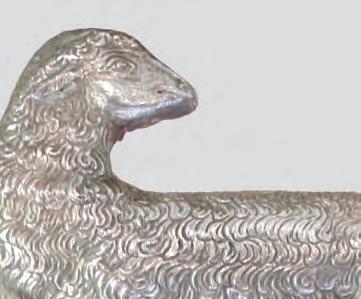

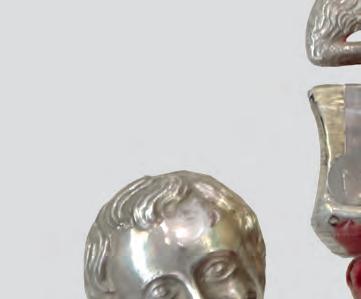
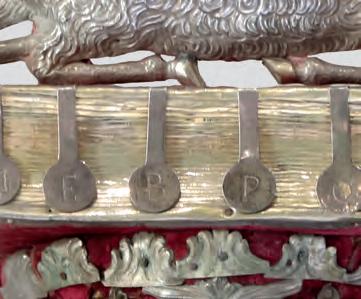



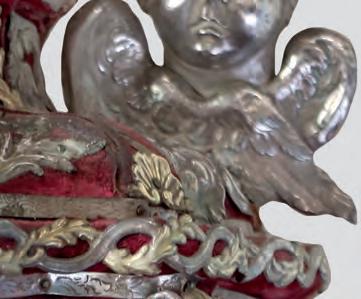
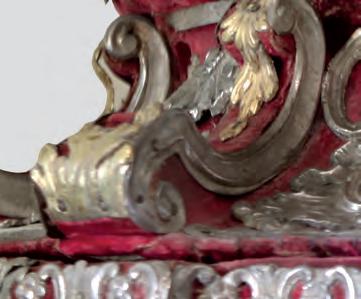
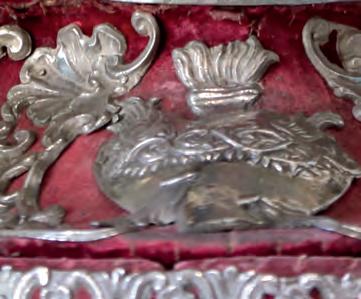




THE BURLINGTON MAGAZINE | 165 | JANUARY 2023 44
Sicilian silver in Malta
latter part of the century, and in line with Neo-classical fashions across Europe, there was also a growing taste for smooth undulating surfaces that eschewed applied ornament.7
The ciborium exemplifies the style, favoured by both ecclesiastical and aristocratic patrons, known as barocchetto, which emerged from the long and glorious tradition of the Baroque in Sicily that ultimately harks back to an ancient Roman heritage that was never entirely forgotten.8 The ciborium demonstrates a distinctive feature of barochetto in the way that elements of decorative fantasy have been grafted onto an older repertoire. These features include the ruddy heads of winged cherubim, projecting outwards and formed fully in the round (Fig.2); foliate decoration and phytomorphic elements, onto which have been added, with a fine sense of balance, rocaille elements; cartouches of symmetrical form and irregular contours; shells with stepped surfaces; and floral garlands and C-shaped volutes, now concave and now convex, forms that were diffused throughout Europe during this period by means of French and German prints (Fig.3).9 The result no doubt appealed to the older generation of Maltese clergy with their attachment to past traditions, even though, as in Sicily, by the last quarter of the eighteenth century Maltese patrons were beginning to cast admiring glances towards the Neo-classical novelties of Rome, London and Paris.
In the course of research on the ciborium a number of marks were discovered, not all of which are legible. Confirming that it is Sicilian, they reveal that it was made between 1781 and 1782 in Syracuse, so helping to demonstrate that the city’s decorative arts were not as exclusively tied to the Neo-classicism of Roman imports or local imitations of that style as had been believed. The hallmark is the triple mark for Syracuse commonly used during this period, including the warranty mark with the arms of the city, an eagle in profile with its left wing raised, its right wing lowered and its feet grasping a bundle of thunderbolts (Fig.4). 10 The ciborium can be dated from the mark of the consul of the city’s gold- and silversmiths, whose duties included the supervision of their workshops, as well as the assaying of the alloys being used. His term of office lasted for one year. Generally the mark comprises the initials of the goldsmith who was serving as consul, followed by the final two digits of the year he was in office. There are two different marks of this type on the ciborium, perhaps suggesting that the work on it was particularly lengthy, NSC81 (Fig.6) and GACH82 (Fig.5), of which the second is more difficult to interpret because it is heavily abraded. Neither has previously been published. Compared to the discoveries that have been made concerning other centres in Sicily, the consular marks of Syracuse and the gold- and silversmiths to whom they refer are under-researched.11
The NSC81 mark appears to be the same as one recorded by Maria Accascina on two other works, the steps of the high altar in Syracuse Cathedral and the frame of an altar card in S. Giovanni,
7 See R. Cruciata: ‘Silver from Catania for Malta in the early nineteenth century’, in M. Sagona, ed.: International Perspectives on the Decorative Arts in Nineteenth-century Malta, Malta 2021, pp.48–59. For goldsmiths’ work in Palermo in the eighteenth and nineteenth centuries, see M.C. Di Natale: ‘I La Villa, argentieri e orafi palermitani tra XVIII e XIX secolo’, in N. Cleopazzo and M. Panarello, eds: “Oltre Longhi”: ai confini dell’arte: scritti per gli ottant’anni di Francesco Abbate, Roccagloriosa 2019, pp.359–66.
8 M. Accascina: Oreficeria di Sicilia dal XII al XIX secolo, Palermo 1974, p.388.
9 S. Grasso and M.C. Gulisano: ‘Forme e divenire del Rococò nella produzione delle botteghe argentarie a Palermo’, in idem, eds: exh. cat. Argenti e cultura Rococò nella Sicilia Centro Occidentale 1735–1789, Lübeck (St. Annen-Museum) 2007–08, pp.39–83, at pp.50–76.
10 See M. Accascina: I marchi delle argenterie e oreficerie Siciliane, Busto Arsizio 1976, pp.171–84. See also G. Agnello: ‘Capitoli e ordinamenti degli
Opposite 2. Detail of Fig.1, showing the cherubim’s heads and other decorative elements.
3. Cartouche nouveau, by Pierre-Edme Babel. Mid-eighteenth century. Engraving, 20.5 by 16 cm. (Biblioteca centrale della Regione siciliana ‘Alberto Bombace’, Palermo, with the kind permission of the Assessorato regionale dei Beni Culturali e dell’Identità Siciliana, Dipartimento Beni Culturali e dell’Identità Siciliana).
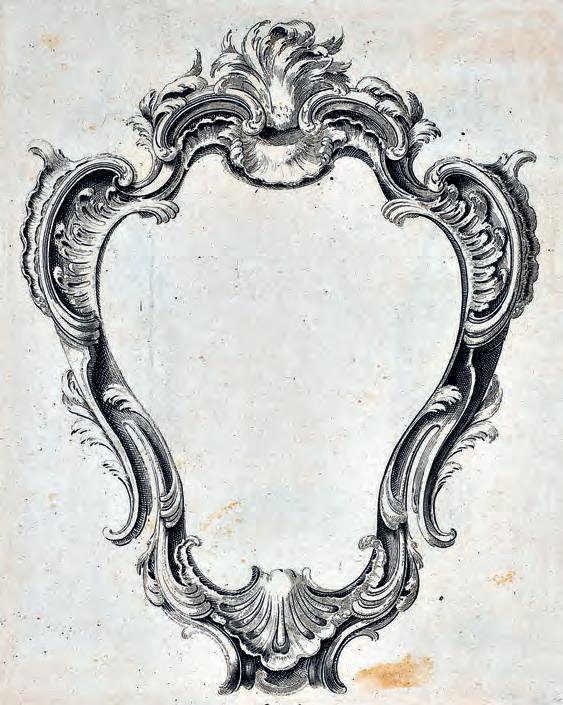
Sortino, although she read it as MSC81 and accordingly attributed it to Michele Scardamaglia.12 He was a member of a well-known family (also recorded as ‘Scaramaglia’) originally from the area around Messina, where they worked for a large part of the seventeenth century before some members moved elsewhere, 13 possibly Syracuse, 14 following the eruption of anti-Spanish disturbances in July 1674 and the subsequent restoration of order by the authorities in Madrid.15 The consul for 1781 in the mark on the Mdina ciborium could have been a member of this family, but it is not likely to have been Michele who, apart from anything else, was a silversmith, and the consuls of the silversmiths
orafi e degli argentieri dal XV al XVIII secolo’, Archivi: archivi d’Italia e rassegna internazionale degli archivi XXIII, fasc.1 (1956), pp.99–115.
11 For Palermo, see, for example, S. Barraja: I marchi degli orafi e orafi di Palermo dal XVII ad oggi, Palermo 1996.
12 Accascina, op. cit. (note 10), pp.174 and 179.
13 See G. Chillè: ‘Giuseppe Scardamaglia (Scaramaglia)’, ‘Michele Scardamaglia (Scaramaglia)’ and ‘Michele Scardamaglia jr.’, in Di
Natale, op. cit. (note 2), II, p.557.
14 For the presence of masters from Messina in Syracuse, see G. Agnello: ‘Argenti e argenterie del settecento I’, Per l’arte sacra VI, fasc.1 (1929), pp.12–25; and idem: ‘Argenti e argenterie del settecento II’, Per l’arte sacra VI, fasc.6 (1929), pp.151–65.
15 S. Di Bella, ed.: La rivolta di Messina (1674–78) e il mondo mediterraneo nella seconda metà del seicento, Cosenza 2001; L.A. Ribot García: La monarquía de España y la guerra de Mesina (1674–1678), Madrid 2002.
the burlington magazine | 165 | january 2023 45
Sicilian silver in Malta
latter part of the century, and in line with Neo-classical fashions across Europe, there was also a growing taste for smooth undulating surfaces that eschewed applied ornament.7
The ciborium exemplifies the style, favoured by both ecclesiastical and aristocratic patrons, known as barocchetto, which emerged from the long and glorious tradition of the Baroque in Sicily that ultimately harks back to an ancient Roman heritage that was never entirely forgotten.8 The ciborium demonstrates a distinctive feature of barochetto in the way that elements of decorative fantasy have been grafted onto an older repertoire. These features include the ruddy heads of winged cherubim, projecting outwards and formed fully in the round (Fig.2); foliate decoration and phytomorphic elements, onto which have been added, with a fine sense of balance, rocaille elements; cartouches of symmetrical form and irregular contours; shells with stepped surfaces; and floral garlands and C-shaped volutes, now concave and now convex, forms that were diffused throughout Europe during this period by means of French and German prints (Fig.3).9 The result no doubt appealed to the older generation of Maltese clergy with their attachment to past traditions, even though, as in Sicily, by the last quarter of the eighteenth century Maltese patrons were beginning to cast admiring glances towards the Neo-classical novelties of Rome, London and Paris.
In the course of research on the ciborium a number of marks were discovered, not all of which are legible. Confirming that it is Sicilian, they reveal that it was made between 1781 and 1782 in Syracuse, so helping to demonstrate that the city’s decorative arts were not as exclusively tied to the Neo-classicism of Roman imports or local imitations of that style as had been believed. The hallmark is the triple mark for Syracuse commonly used during this period, including the warranty mark with the arms of the city, an eagle in profile with its left wing raised, its right wing lowered and its feet grasping a bundle of thunderbolts (Fig.4). 10 The ciborium can be dated from the mark of the consul of the city’s gold- and silversmiths, whose duties included the supervision of their workshops, as well as the assaying of the alloys being used. His term of office lasted for one year. Generally the mark comprises the initials of the goldsmith who was serving as consul, followed by the final two digits of the year he was in office. There are two different marks of this type on the ciborium, perhaps suggesting that the work on it was particularly lengthy, NSC81 (Fig.6) and GACH82 (Fig.5), of which the second is more difficult to interpret because it is heavily abraded. Neither has previously been published. Compared to the discoveries that have been made concerning other centres in Sicily, the consular marks of Syracuse and the gold- and silversmiths to whom they refer are under-researched.11
The NSC81 mark appears to be the same as one recorded by Maria Accascina on two other works, the steps of the high altar in Syracuse Cathedral and the frame of an altar card in S. Giovanni,
7 See R. Cruciata: ‘Silver from Catania for Malta in the early nineteenth century’, in M. Sagona, ed.: International Perspectives on the Decorative Arts in Nineteenth-century Malta, Malta 2021, pp.48–59. For goldsmiths’ work in Palermo in the eighteenth and nineteenth centuries, see M.C. Di Natale: ‘I La Villa, argentieri e orafi palermitani tra XVIII e XIX secolo’, in N. Cleopazzo and M. Panarello, eds: “Oltre Longhi”: ai confini dell’arte: scritti per gli ottant’anni di Francesco Abbate, Roccagloriosa 2019, pp.359–66.
8 M. Accascina: Oreficeria di Sicilia dal XII al XIX secolo, Palermo 1974, p.388.
9 S. Grasso and M.C. Gulisano: ‘Forme e divenire del Rococò nella produzione delle botteghe argentarie a Palermo’, in idem, eds: exh. cat. Argenti e cultura Rococò nella Sicilia Centro Occidentale 1735–1789, Lübeck (St. Annen-Museum) 2007–08, pp.39–83, at pp.50–76.
10 See M. Accascina: I marchi delle argenterie e oreficerie Siciliane, Busto Arsizio 1976, pp.171–84. See also G. Agnello: ‘Capitoli e ordinamenti degli
Opposite 2. Detail of Fig.1, showing the cherubim’s heads and other decorative elements.
3. Cartouche nouveau, by Pierre-Edme Babel. Mid-eighteenth century. Engraving, 20.5 by 16 cm. (Biblioteca centrale della Regione siciliana ‘Alberto Bombace’, Palermo, with the kind permission of the Assessorato regionale dei Beni Culturali e dell’Identità Siciliana, Dipartimento Beni Culturali e dell’Identità Siciliana).

Sortino, although she read it as MSC81 and accordingly attributed it to Michele Scardamaglia.12 He was a member of a well-known family (also recorded as ‘Scaramaglia’) originally from the area around Messina, where they worked for a large part of the seventeenth century before some members moved elsewhere, 13 possibly Syracuse, 14 following the eruption of anti-Spanish disturbances in July 1674 and the subsequent restoration of order by the authorities in Madrid.15 The consul for 1781 in the mark on the Mdina ciborium could have been a member of this family, but it is not likely to have been Michele who, apart from anything else, was a silversmith, and the consuls of the silversmiths
orafi e degli argentieri dal XV al XVIII secolo’, Archivi: archivi d’Italia e rassegna internazionale degli archivi XXIII, fasc.1 (1956), pp.99–115.
11 For Palermo, see, for example, S. Barraja: I marchi degli orafi e orafi di Palermo dal XVII ad oggi, Palermo 1996.
12 Accascina, op. cit. (note 10), pp.174 and 179.
13 See G. Chillè: ‘Giuseppe Scardamaglia (Scaramaglia)’, ‘Michele Scardamaglia (Scaramaglia)’ and ‘Michele Scardamaglia jr.’, in Di
Natale, op. cit. (note 2), II, p.557.
14 For the presence of masters from Messina in Syracuse, see G. Agnello: ‘Argenti e argenterie del settecento I’, Per l’arte sacra VI, fasc.1 (1929), pp.12–25; and idem: ‘Argenti e argenterie del settecento II’, Per l’arte sacra VI, fasc.6 (1929), pp.151–65.
15 S. Di Bella, ed.: La rivolta di Messina (1674–78) e il mondo mediterraneo nella seconda metà del seicento, Cosenza 2001; L.A. Ribot García: La monarquía de España y la guerra de Mesina (1674–1678), Madrid 2002.
the burlington magazine | 165 | january 2023 45
Sicilian silver in Malta
4. Detail of Fig.1, showing the mark of Syracuse (an eagle in profile), the consul’s mark, NSC81, and the maker’s mark, DF.
5. Detail of Fig.1, showing the consul’s mark, NSC81, and the maker’s mark, DF.
6. Detail of Fig.1, the mark of Syracuse (an eagle in profile) and the consul’s mark, GACH82.
7. Detail of Fig.1, showing the consul’s mark, NSC81, and the maker’s mark, DF.38
were usually goldsmiths. Moreover, Nicola was a name consistently used by many generations of this family; for example, the silversmith Nicola Maria, documented in Messina in 1665.16 If the initial letter is read as ‘N’ the mark could therefore refer to one of his descendants. The second unpublished consular mark, GACH82, may well refer to a member of the Chindemi family, also originally from Messina but which also moved to Syracuse, where they were active for around two centuries from at least 1739.17 In the course of the eighteenth century, Syracuse experienced a lively cultural revival, which encouraged artists to move there in response to demand for their specialised skills. 18 At least two members of the Chindemi family, Ascensio (Senzio) and Michele, worked on prestigious commissions alongside Decio Furnò, an outstanding silversmith of Messinese origin who was working in Syracuse during this period. 19
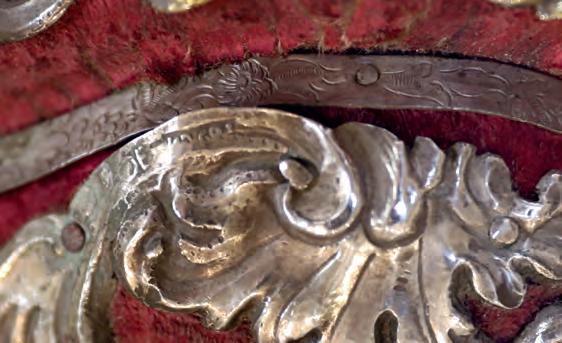
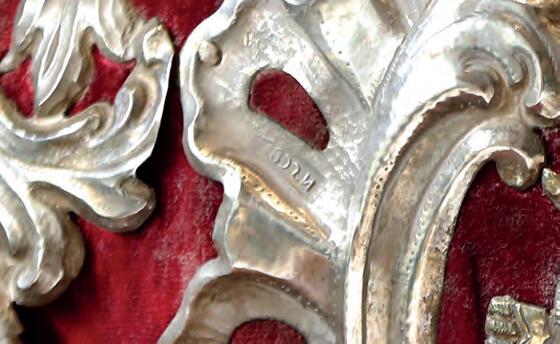

There is little doubt that Furnò was the maker of the ciborium. It bears in several places the maker’s mark formed of the initials DF (Fig.7), which is effectively his signature. The attribution is supported by comparison with securely documented works. Although his date of birth is unknown, Decio’s life seems to have spanned almost the entire eighteenth century since he is documented as working in Messina, Palermo and Syracuse between 1726 and 1792, which was probably the year he died.20 It was most likely an outbreak in 1743 of the plague in Messina and Reggio Calabria that forced him to leave his native city for Syracuse, where he gradually became one of the city’s principal silversmiths. He is usually associated with the repair and restoration of liturgical silver, his most celebrated commission of this type being his work, together with Ascensio Chindemi, in 1763 on the silver reliquary casket of St Lucy for Syracuse Cathedral. He was also, however, a prolific maker who undertook a number of prestigious commissions for the cathedral.21 Among them were the great cross for the high altar in 1763 and a pair of portable candelabra made in 1768,22 both designed by the Syracuse painter Mauro Troia, with whom Furnò worked regularly. He also made for the cathedral two monstrances, in 1771 and 1776 respectively; the steps of the high altar made between 1765 and 1781 (which feature the same marks as the Mdina ciborium), also designed by Troia, in which appear ornamental forms that recall Messinese barocchetto, forms that are seen in Syracuse only during the final quarter of the eighteenth century following the earthquake that
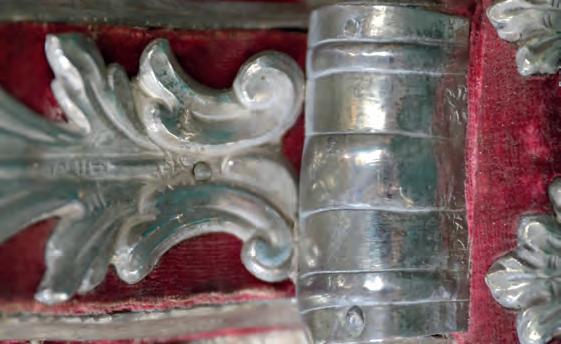
16 G. Chillè: ‘Nicola Maria Scardamaglia (Scaramaglia)’, in Di Natale, op. cit. (note 2), II, p.557.
17 G. Agnello: ‘Orafi e argentieri dei secoli XVI, XVII e XVIII’, Archivi: archivi d’Italia e rassegna internazionale degli archivi XXIII, fasc.2–3 (1956), pp.265–94, at pp.271–76. See also D. Ruffino: ‘Ascensio (Senzio) Chindemi’, ‘Michele Chindemi’, ‘Placido Chindemi’, and ‘Vincenzo Chindemi’, in Di Natale, op. cit. (note 2), I, pp.130–31.
18 See Agnello, op. cit. (note 17), pp.265–94; and idem: ‘Ricerche archivistiche per la storia dell’arte: oafi e argentieri dei secoli XVI, XVII e XVIII II’, Archivi: archivi d’Italia e rassegna
internazionale degli archivi XXIII, fasc.4 (1956), pp. 343–61.
19 Agnello, op. cit. (note 17), pp.274–75.
20 L . Bertolino: ‘Indice degli orafi e argentieri di Palermo’, in M.C. Di Natale, ed.: exh. cat. Ori e argenti di Sicilia dal quattrocento al settecento, Palermo (Albergo dei Poveri) 2000–01, p.401;
G. La Licata: ‘Indice degli orafi e argentieri di Messina’, in ibid., p.407; and D. Ruffino: ‘Indice degli orafi e argentieri di Siracusa’, in ibid., p.412.
21 Agnello, op. cit. (note 17); and idem, op. cit. (note 18), pp.343–47. See also S. Lanuzza: ‘Il Rococò nelle argenterie della Sicilia sud orientale’, in Grasso
the burlington magazine | 165 | january 2023 46
Sicilian
silver in Malta
4. Detail of Fig.1, showing the mark of Syracuse (an eagle in profile), the consul’s mark, NSC81, and the maker’s mark, DF.
5. Detail of Fig.1, showing the consul’s mark, NSC81, and the maker’s mark, DF.
6. Detail of Fig.1, the mark of Syracuse (an eagle in profile) and the consul’s mark, GACH82.
7. Detail of Fig.1, showing the consul’s mark, NSC81, and the maker’s mark, DF.38
were usually goldsmiths. Moreover, Nicola was a name consistently used by many generations of this family; for example, the silversmith Nicola Maria, documented in Messina in 1665.16 If the initial letter is read as ‘N’ the mark could therefore refer to one of his descendants. The second unpublished consular mark, GACH82, may well refer to a member of the Chindemi family, also originally from Messina but which also moved to Syracuse, where they were active for around two centuries from at least 1739.17 In the course of the eighteenth century, Syracuse experienced a lively cultural revival, which encouraged artists to move there in response to demand for their specialised skills. 18 At least two members of the Chindemi family, Ascensio (Senzio) and Michele, worked on prestigious commissions alongside Decio Furnò, an outstanding silversmith of Messinese origin who was working in Syracuse during this period. 19



There is little doubt that Furnò was the maker of the ciborium. It bears in several places the maker’s mark formed of the initials DF (Fig.7), which is effectively his signature. The attribution is supported by comparison with securely documented works. Although his date of birth is unknown, Decio’s life seems to have spanned almost the entire eighteenth century since he is documented as working in Messina, Palermo and Syracuse between 1726 and 1792, which was probably the year he died.20 It was most likely an outbreak in 1743 of the plague in Messina and Reggio Calabria that forced him to leave his native city for Syracuse, where he gradually became one of the city’s principal silversmiths. He is usually associated with the repair and restoration of liturgical silver, his most celebrated commission of this type being his work, together with Ascensio Chindemi, in 1763 on the silver reliquary casket of St Lucy for Syracuse Cathedral. He was also, however, a prolific maker who undertook a number of prestigious commissions for the cathedral.21 Among them were the great cross for the high altar in 1763 and a pair of portable candelabra made in 1768,22 both designed by the Syracuse painter Mauro Troia, with whom Furnò worked regularly. He also made for the cathedral two monstrances, in 1771 and 1776 respectively; the steps of the high altar made between 1765 and 1781 (which feature the same marks as the Mdina ciborium), also designed by Troia, in which appear ornamental forms that recall Messinese barocchetto, forms that are seen in Syracuse only during the final quarter of the eighteenth century following the earthquake that

16 G. Chillè: ‘Nicola Maria Scardamaglia (Scaramaglia)’, in Di Natale, op. cit. (note 2), II, p.557.
17 G. Agnello: ‘Orafi e argentieri dei secoli XVI, XVII e XVIII’, Archivi: archivi d’Italia e rassegna internazionale degli archivi XXIII, fasc.2–3 (1956), pp.265–94, at pp.271–76. See also D. Ruffino: ‘Ascensio (Senzio) Chindemi’, ‘Michele Chindemi’, ‘Placido Chindemi’, and ‘Vincenzo Chindemi’, in Di Natale, op. cit. (note 2), I, pp.130–31.
18 See Agnello, op. cit. (note 17), pp.265–94; and idem: ‘Ricerche archivistiche per la storia dell’arte: oafi e argentieri dei secoli XVI, XVII e XVIII II’, Archivi: archivi d’Italia e rassegna
internazionale degli archivi XXIII, fasc.4 (1956), pp. 343–61.
19 Agnello, op. cit. (note 17), pp.274–75.
20 L . Bertolino: ‘Indice degli orafi e argentieri di Palermo’, in M.C. Di Natale, ed.: exh. cat. Ori e argenti di Sicilia dal quattrocento al settecento, Palermo (Albergo dei Poveri) 2000–01, p.401;
G. La Licata: ‘Indice degli orafi e argentieri di Messina’, in ibid., p.407; and D. Ruffino: ‘Indice degli orafi e argentieri di Siracusa’, in ibid., p.412.
21 Agnello, op. cit. (note 17); and idem, op. cit. (note 18), pp.343–47. See also S. Lanuzza: ‘Il Rococò nelle argenterie della Sicilia sud orientale’, in Grasso
the burlington magazine | 165 | january 2023 46
Sicilian
silver in Malta
struck Reggio and Messina in 1783; and two decorative elements that frame the high altar frontal made in 1752 by Angelo Maria Spinazzi, a silversmith from Piacenza working in Rome.23 Furnò’s last work for the high altar of the cathedral was begun in 1792 and was completed by the silversmith Giuseppe Luca.24
However, the work by Furnò that is technically, compositionally and stylistically closest to the Mdina ciborium was not made for Syracuse. This is a small ciborium that incorporates a small throne for the exposition of the Host (Fig.9), which Furnò completed in 1773 for the church of the Carmelite monastery of S. Marco, Enna, for a total cost in silver of 309 ounces, 27 tares and 2 grains, of which 50 ounces were the silversmith’s payment.25 Both ciboria are highly ornamented, especially in the central doors, with an exuberant mingling of materials and colours. The documentation related to the creation of the Enna ciborium assists an understanding of how the Mdina example would have been made, which is especially valuable given the absence of such documentation for that ciborium. It seems clear that both objects were the work of a number of hands; Furnò would have collaborated as necessary with a range of specialists, including wax modellers, gilders and workers in wood and textiles. The visual and haptic contrast between the silver and the crimson velvet, the colour of choice for solemn furnishings, was extremely popular at this time, as it created optical effects that evoked the great ephemeral machines of Baroque festivities, performances and other spectacles. Similar effects can be found in seventeenth- and eighteenth-century altar doors, altar frontals, the bindings of liturgical books and other liturgical objects manufactured in both Sicily and Malta.
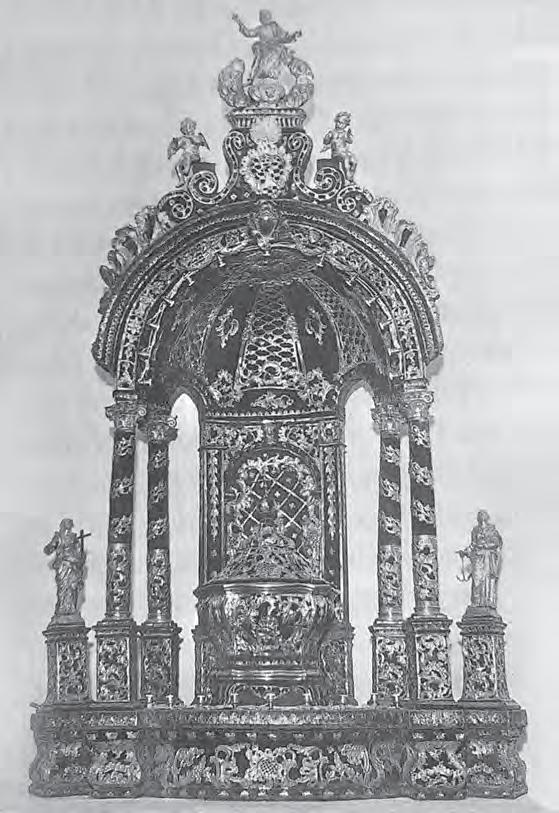
and Gulisano, op. cit. (note 9), pp.123–35, at p.130; S. Terzo: ‘Decio (Desio, Desiderius) Furnò (Forno)’, in Di Natale, op. cit. (note 2), I, p.263.
22 For these works, see M. Russo, ed.: ‘Le suppellettili ecclesiastiche’, in exh. cat. Pro mundi vita: Eucaristia e arte nel Duomo di Siracusa, Siracusa (Cappella Sveva dell’Arcivescovado di Siracusa) 2000, pp.86 and 92–93.
23 E. Mauceri: ‘Documenti artistici siracusani’, Archivio storico per la Sicilia Orientale V, fasc.1 (1908), pp.80–85; G. Agnello and S.L. Agnello: Siracusa barocca, Caltanissetta and Rome 1961, pp.27–29.
24 For Giuseppe Luca, see D. Ruffino:
‘Giuseppe Luca’, in Di Natale, op. cit. (note 2), II, p.384.
25 R . Lombardo: La Chiesa e il Monastero di San Marco le Vergini di Enna tra storia, arte e devozione, Enna 1999, pp.135–39; P. Russo: ‘Nuovi documenti riguardanti alcuni argenti inediti, noti o poco noti, del settecento Siciliano’, in S. Rizzo, ed: exh. cat. Il tesoro dell’isola: Capolavori siciliani in argento e corallo dal XV al XVIII secolo, Prague (Wallenstein Riding School) 2004, pp.1,083–90, at. pp.1084 and 1,088–89, doc.5. At the time of publication the ciborium is temporarily housed in the Prefecture of Enna.
8. Detail of Fig.1, showing the interior of the ciborium and the later taffeta lining.
9. Ciborium and throne, by Decio Furnò. 1772–73. Silver, gilded silver, copper and velvet, height 175 by 100 by 55 cm. (S. Marco, Enna; photograph Rocco Lombardo).
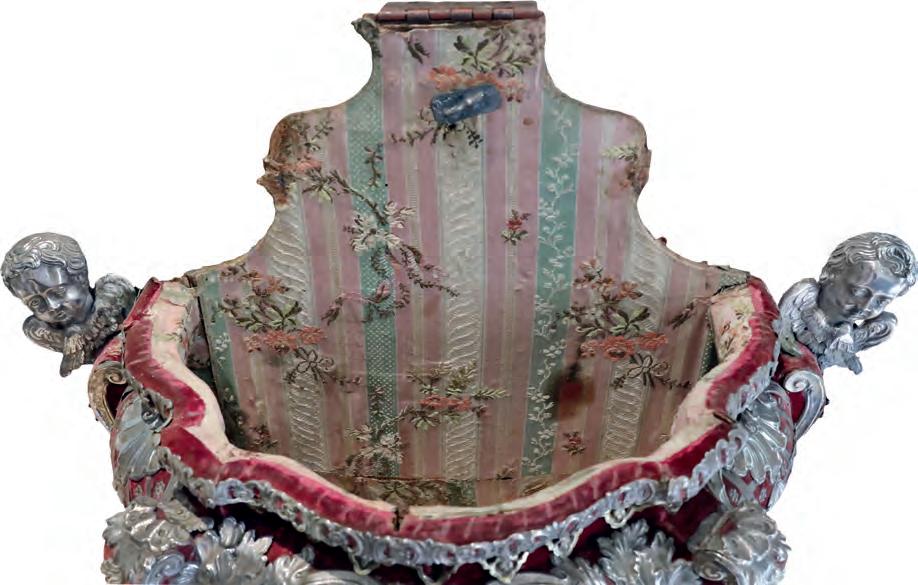
the burlington magazine | 165 | january 2023 47
Sicilian silver in Malta
All of these objects are made of sheet silver that has been embossed, chased, cut out to form openwork and engraved before being fixed with silver pins onto a velvet surface stretched over a wooden carcass.26 The interior of the carcass of the Mdina ciborium is lined with a textile dating from the late eighteenth or early nineteenth centuries in poor condition (Fig.8). In the Louis XVI style, and probably originally made for a secular purpose, it is a taffeta in woven brocade à liage repris.27 It is likely that that the ciborium was originally lined with velvet, in order to maintain the decorum of the object during its use, which involved the cover being lifted. Furnò probably designed the Enna ciborium himself, as he does not mention design drawings in the list of expenses he drew up in connection with its making, in which the other craftsmen involved in its manufacture are accurately noted.28 Although the precise circumstances of its commission remain unknown, it is very probable that Furnò also designed the ciborium in Malta. In fact, this seems to have been common practice, as in the case of the lost silver and crimson velvet ciborium commissioned by the priest Don Antonio Landolina, Procurator General for the high altar of the Carmelite monastery church of S. Teresa in Syracuse. Here the silversmith Vincenzo Chindemi also designed the
26 See G. Travagliato: ‘Paliotto’, in M.C. Di Natale, ed.: exh. cat. Splendori di Sicilia: arti decorative dal Rinascimento al Barocco, Palermo (Albergo dei Poveri) 2001, pp.456–59, no.148; R. Vadalà: ‘Paliotto’, in idem pp.456–59, no.149; and J. Farrugia: Antique Maltese Ecclesiastical Silver, Malta 2001, I.
27 The author thanks Maurizio Vitella for this information.
28 Russo, op. cit. (note 25), pp.1,088–89, doc.5.
29 Agnello, op. cit. (note 17), pp.272 and 286.
30 See G. Moroni: Dizionario di
erudizione storico-ecclesiastica, Venice 1853, LXIV, pp.87–90. For the Maltese context, see Farrugia, op. cit. (note 26), pp.52–56.
31 Cathedral Archives, Mdina, Misc.218, inventory 1815, fols.31–32: ‘un grande Tosello, si dice Girandola, che si colloca nell’altar Maggiore per l’esposizione del S[antis]s[i]mo Sagramento, tutto a piancia d’argento collocato sopra il velluto cremesi, con fogliami anche d’argento, e puttini’
See also Cathedral Archives, Mdina, Misc.220, Inventario generale degl’Ori, Argenti, Gioie, Reliquie, e Supellettili appartenenti alla S. Arcivescovile
10. Detail of Fig.1, showing the cartouche with the coat of arms of the Arezzo family.
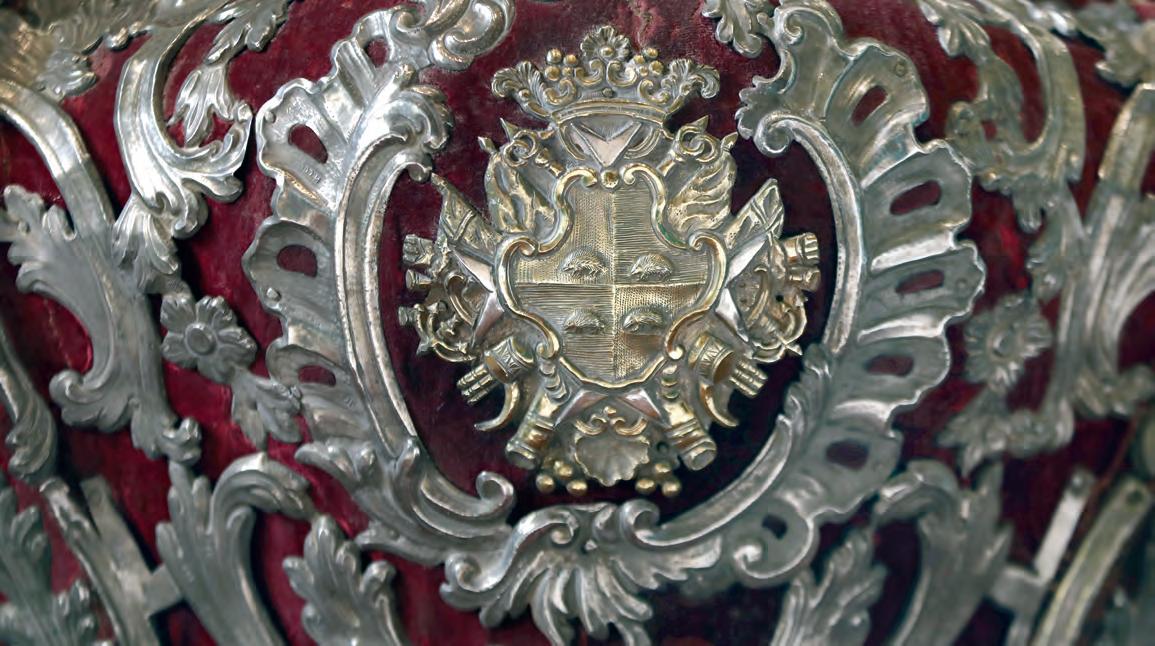
entire object, with the exception of the two lateral putti, the models for which had been sent to him by an unnamed architect in Noto.29
Both these ciboria by Furnò are based on a model that developed in the post-Tridentine period, with four feet forming a plinth supporting an urn in polygonal form, the cover of which may be raised to allow the chalice containing the Host to be placed inside; once this is done, the ciborium is locked with a key and then exposed to worshippers.30 The cover of the Mdina ciborium, which shares the same polygonal form as the main body, is crowned with a finely modelled and chased Agnus Dei seated upon a book, from which are suspended straps bearing the first six of the seven Seals of Revelation that prefigure the second coming of Christ.
The Mdina ciborium is first documented in an inventory of the cathedral drawn up in 1815, in which it is recorded that it was then in use on the high altar.31 The ciborium usually present in the cathedral was made in 1752 by the masters Giovanni Andrea Troisi (brother of Pietro Paolo) and Annetto Pullicino, so completing the commission for a small throne for the
Chiesa Cattedrale di Malta 1853, fol.23, in which it is recorded as a ‘Tosello grande, d[etto] Girandola, qual collocasi nell’Altar Maggiore, nell’Esposizione del S[antis]S[i]mo Sacramento tutto a pianca d’Argento, sopra Velluto cremesi, con foliami, a puttini d’Argento, de quali manca un piccolissimo pezzo in un fiocco destro’.
32 Farrugia, op. cit. (note 26), pp.53–
54; J.A. Briffa: Pietro Paolo Troisi (1686–1750): A Maltese Baroque Artist, Malta 2009, pp.33–37; M. Sagona: ‘Ornamental and decorative drawings for Malta 1600–1900: problems, reflections and insights’, in S. de Cavi,
ed.: Dibujo y ornamento: trazas y dibujos de artes decorativas entre Portugal, España, Italia, Malta y Grecia. Estudios en honor de Fuensanta García de la Torre, Cordova and Rome 2015, pp.469–89, at p.476.
33 R . Grana Scolari: Cenni storici sulla città di Modica, Modica 1895, pp.399–400.
34 A. Ferris: Memorie dell’inclito Ordine gerosolimitano esistenti nelle isole di Malta, Malta 1881, p.304; D. Munro: Memento Mori: A Companion to the Most Beautiful Floor in the World, Malta 2005, p.50. It is now possible to
the burlington magazine | 165 | january 2023 48
Sicilian silver in Malta
exposition of the sacrament on Holy Thursday. This object, a remarkable example of a Baroque apparatus, is based on a design furnished in 1727 by Pietro Paolo Troisi, a notable Maltese silversmith who also worked as sculptor, medallist, draughtsman, engraver and as Master of the Mint, but was completed only after his death in 1751 under the direction of the Maltese painter Francesco Vincenzo Zahra.32
One further feature of the ciborium remains to be discussed, the presence, at the centre of the frontal compartment, of the coat of arms of a noble family (Fig.10). These arms also appear on one of the tombstones that make up the remarkable pavement of the Co-Cathedral of St John the Baptist in Valletta, the church of the Order of St John of Jerusalem (Fig.11). Placed to the left of the main entrance, this marks the grave of Fra’ Corrado Arezzo e Zacco from Modica (1719–82), who was received into the Order in 1732.33 As recorded on the tombstone, he subsequently rose to become a Knight of Justice, Commander and, finally, Bailiff during the rule of the Spanish Grand Master Francisco Ximenes de Texada (1773–75).34 On the ciborium Fra’ Corrado’s coat of arms is surrounded by the accoutrements of his rank in the Order, consisting of a shield of a vaguely quadrilobed form subdivided into four fields, each occupied by a hedgehog facing in the same direction; the two above represent faith, charity and clemency, and the two below symbolise virtue, fortitude and justice.35 The shield is superimposed upon the eight-pointed Cross of Malta and is surmounted by a marquess’s crown.
Fra’ Corrado was a member of a noble Arezzo family, originally from Rome, which had moved to Sicily as a result of strategic marriages that had provided them both titles and lands.36 The son of Teresa Zacco and Raimondo Arezzo, governor of the county of Modica and superintendent of the royal patrimony in Palermo, he began his military career alongside his brother Orazio, who would not only go on to inherit the marquessate, but would also receive highly prestigious military appointments from the Bourbon monarchs. Corrado, on the other hand, quickly turned his back on the secular military life in order to join the Order, in which he enjoyed great success. His family benefited from a very close relationship with the Order of St John over several centuries. As well as boasting a remarkable number of Knights and several Commanders (among the Arezzo of Syracuse, the principal branch of the family, these included the brothers Fra’ Francesco Saverio and Fra’ Bartolomeo Arezzo della Targia, the latter buried in the chapel of the Venerable Langue of Italy in the CoCathedral), the family was responsible for the foundation of at least two Commanderies, that of St John the Baptist or Scorsonara in Ragusa (Sicily), established in 1626 by Fra’ Blandano Arezzo e la Rocca, of the Barons of Serri, and that of Martinez in Palazzolo Acreide, Sicily, founded on 7th December 1641 by Don Lucio Martinez d’Aragona, Arezzo della Targia.37
Given its date, it is possible that the ciborium was commissioned to celebrate the election in 1780 of the new bishop Vincenzo Labini (1735–1807), who had formerly been conventual chaplain to the Order. Fra’ Corrado Arezzo died in Palermo in July 1782, at the age of sixty-three, and
verify the suggestion published some two decades ago that the ciborium, then considered to be Maltese in origin, was given by Fra’ Corrado Arezzo, see N. de Piro: Malta Influence and Patronage: A Convergence on the Metropolitan Cathedral and Museum, Malta 2000, p.153.
35 M. Arezzo di Trifiletti: Il sigillo di famiglia: un passato ritrovato, Rome 2020.
36 F. Mugnos: Teatro genealogico delle famiglie nobili titolate feudatarie ed antiche nobili del fidelissimo regno di sicilia viventi ed estinte, Palermo 1647, I, pp.84–86. See also V. Palizzolo
Gravina: Il blasone in Sicilia ossia raccolta araldica, Palermo 1871–75, p.78; and A. Mango di Casalgerardo: Nobiliario di Sicilia, Palermo 1912.
37 S. Distefano: ‘Palazzolo (Acreide) Commenda Martinez’, in L. Buono and G. Pace Gravina, eds: La Sicilia dei cavalieri: le istituzioni dell’Ordine di Malta in età moderna (1530–1826), Rome 2003, pp.221–23; and G. Pace: ‘Ragusa Commenda San Giovanni Battista o Scorsonara’, in idem, pp.258–59. See also F. D’Avenia: ‘Le commende gerosolimitane in Sicilia: patrimoni ecclesiastici, gestione aristocratica’, in idem, pp.35–89.
it is not known if the the ciborium was received in Malta before or after his death. It is hoped that future archival discoveries will throw fresh new light on this and other outstanding questions, but despite the paucity of documentation, the ciborium is a significant work, which exemplifies the decorative and expressive richness of late eighteenth-century Sicilian silver.
11. Tombstone of Fra’ Corrado Arezzo e Zacco. Sicilian(?), after 1782. Polychrome marble, 228 by 107 cm. (Co-Cathedral of St John the Baptist, Valletta; © St John’s Co-Cathedral Foundation).
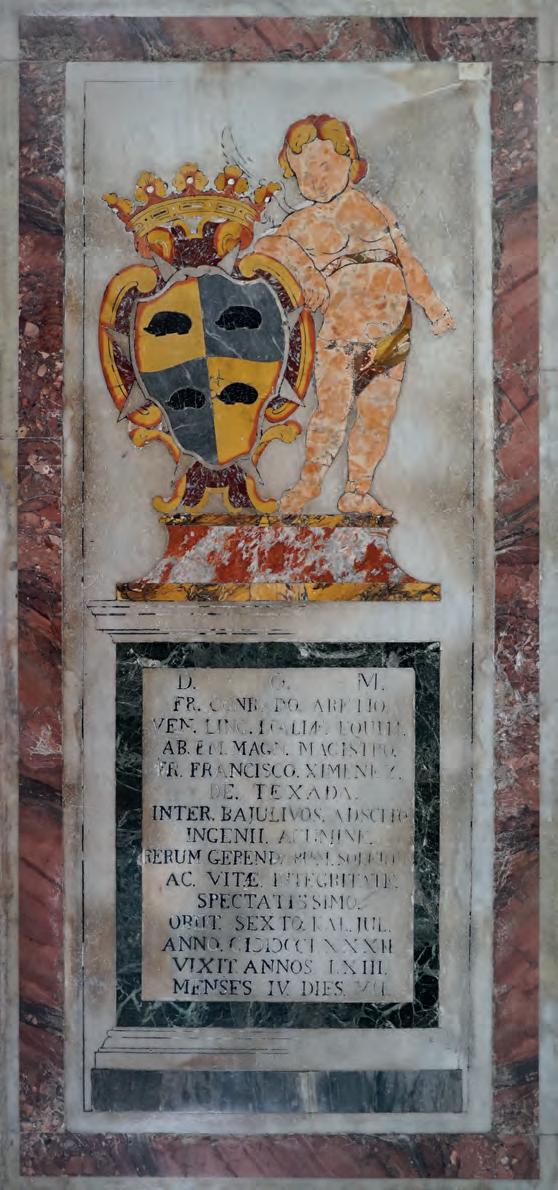
the burlington magazine | 165 | january 2023 49
Sicilian silver in Malta
The many faces of Mary Magdalene
An exhibition held in Forlì in 2022 explored in a comprehensive fashion the way that the complex figure of Mary Magdalene has been depicted in art from the early Middle Ages to the present day – as Christ’s leading female disciple, as witness of the Crucifixion and the risen Christ at Easter, as apostle to the apostles, as an embodiment of repentant female sexuality and as an object of erotic fascination
by susan haskins
Mary magdalene is a mysterious and misunderstood figure. Growing out of a conflation of three different female characters in the gospels, which began in the early Christian centuries, her identity was made concrete by Gregory the Great in the late sixth century; later, she was endowed with an eventful life following Christ’s death. The different ways artists of all periods have approached this multi-faceted figure was the focus of the first major comprehensive exhibition since 1986 on representations of the saint in art, held at the Musei San Domenico, Forlì (27th March–10th July).1 Beginning spectacularly in the vast nave of the former Dominican conventual church, founded in the thirteenth century, which now forms part of the Musei San Domenico, it continued ingeniously in the conventual buildings and cloisters. Its aim, and that of the accompanying catalogue, was defined by Maurizio Gardini, president of the organising institution, the Fondazione Cassa dei Risparmi di Forlì, as being to bring a ‘new and better understanding of her image through its variations and interpretations over the centuries and to stimulate an original investigation into her figure’ (p.12).
The catalogue is divided into two parts. The first consists of eighteen essays written by Gianfranco Brunelli, the exhibition’s director general, the three curators of the exhibition – Cristina Acidini, Fernando Mazzocca and Paola Refice – and fourteen scholars drawn from Italian academic institutions, museums and heritage bodies; the second comprises the mostly excellent entries, which have up-todate bibliographies, and high-quality colour reproductions for all the almost two hundred exhibits. The essays and the catalogue section are organised both chronologically and thematically, although confusingly they do not always relate to each other clearly and sometimes overlap, and there is no index to help.
Brunelli’s opening essay offers an overview of representations of Mary Magdalene up to the present day, arguing that she has been misrepresented since the beginnings of Christianity. Providing a helpful distillation of the gospel accounts, he discusses Mary Magdalene’s biblical role as a disciple and her presence at the Crucifixion and at the tomb of the risen Christ, whose first witness she was (her name ‘Magdalene’
1. Crucifixion, by Masaccio. c.1426. Tempera on panel, 83 by 63 cm. (Museo di Capodimonte, Naples; Bridgeman Images).
indicates that she came from Magdala, a fishing village by the Sea of Galilee). He examines her subsequent conflation by Gregory the Great in Homilies XXV and XXXIII, given in probably 591, with two other figures in the gospels: Mary of Bethany, the sister of Martha and Lazarus (John 11:1–2 and 12:3); and ‘the sinner’ who washed Christ’s feet, dried them with her hair (Luke 7:36–50) and anointed them, whom Gregory identified as a repentant prostitute. He thus created the tripartite figure of Mary Magdalene as she has been understood by Catholics since then. Brunelli discusses her role as an apostle, mentioned in Gnostic texts, the celebration of her as the ‘apostle to the apostles’ in Hippolytus’s Commentary on the Song of Songs (235) and the comments on her by the early Church fathers. The essay is not entirely free from error. The scene of Mary Magdalene meeting the risen Christ (also known as the Noli me tangere, from John 20:17) is not represented, as claimed, on Early Christian sarcophagi. The ‘meeting of Mary Magdalene with the risen Christ’ on the fourth-century sarcophagus of San Celso in S. Maria dei Miracoli, Milan, is in fact the scene of an angel with the two Marys –Mary Magdalene and the ‘other Mary’ (Matthew 27: 61), who is usually identified as ‘Mary the mother of James and Joses’ (Matthew 27:56) or the Virgin Mary. Nor does the Noli me tangere appear on the ivory diptych of the Passion in the Museo del Duomo, Milan, where the two Marys meet the angel, and subsequently Christ, in the so-called Chairete scene (Matthew 28:1–8).2
Although none of the essays that follows is groundbreaking, they mostly offer sound background information for those unfamiliar with the cult and iconography of Mary Magdalene. They begin with Francesca Licordari’s useful examination of the gamut of Classical female precursors, whose gestures came to inform the way the saint was
1 Catalogue: Maddalena: Mistero e imagine. Edited by Cristina Acidini, Gianfranco Brunelli, Fernando Mazzocca and Paola Refice. 350 pp. incl. 544 col. ills. (Silvana Editoriale,
Milan, 2022), €36.10. ISBN 978–88–366–5100–9.
2 V. Vannucci: Maria Maddalena: Storia e iconografia nel Medioevo dal III al XIV secolo, Rome 2012, pp.63–67.
50
the burlington magazine | 165 | january 2023

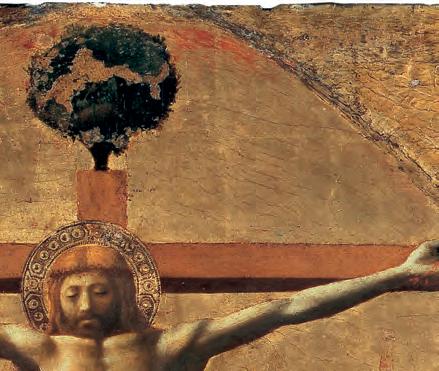

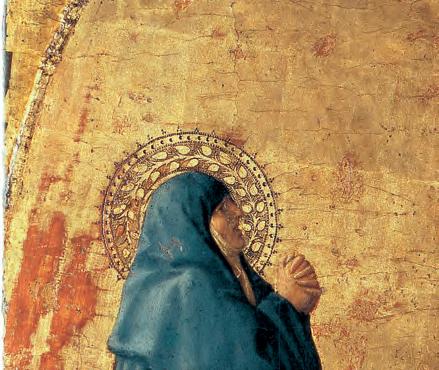
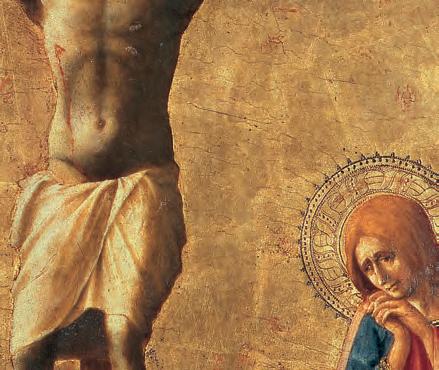



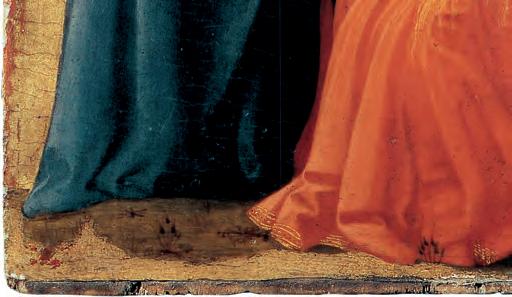
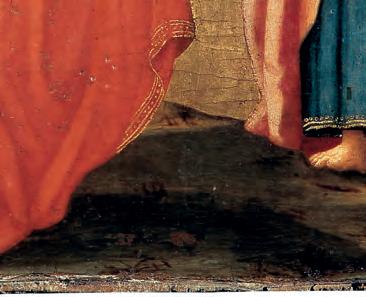
THE BURLINGTON MAGAZINE | 165 | JANUARY 2023 51
represented, in particular, the gure-types dubbed the ‘maenad under the Cross’ by Edgar Wind – a woman with arms raised in frenzied anguish and profound mourning – and ‘Venus in sackcloth’ by Mario Praz.3 The title of Re ce’s essay, ‘Un lungo preambolo: il medioevo’, is unfortunate;
3 E. Wind: ‘The maenad under the Cross I: comments on an observation by Reynolds’, Journal of the Warburg Institute 1 (1937), pp.70–71; and M. Praz: Secentismo e marinismo in Inghilterra: John Donne-Richard Crashaw, Florence 1925, cited in H.J.C. Grierson:
Cross-Currents in English Literature of the XVIIth Century, London 1948, p.181. See also M.M. Malvern: Venus in Sackcloth: The Magdalen’s Origins and Metamorphoses, Carbondale IL, 1975.
4 See J. Leroy: Les manuscrits syriaques à peintures conservés
2. St Mary Magdalene with eight scenes from her life, by the Magdalene Master. 14th century. Tempera on panel, 164 by 76 cm. (Galleria dell’Accademia & Museo degli Strumenti Musicali, Florence; Bridgeman Images).
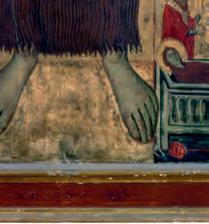

by calling the Middle Ages a ‘preamble’ it belies the importance of medieval art to the subject. It also wrongly implies that the exhibition’s focus is primarily on Renaissance and later art. Nonetheless, the author provides a useful account of the depiction of Mary Magdalene between the third century and the thirteenth. Problems with the identi cation of gures occur here as well. For example, a youthful Christ shown on an early fth-century ivory panel together with the two Marys (Museo delle Arti Decorative, Milan) is described as an angel. Moreover, a nimbed female gure in purple, depicted in the lower register of the Cruci xion miniature from the Rabbula codex (586; Biblioteca Medicea Laurenziana, Florence Plut. 1.56, fol.13r) is not Mary Magdalene. Although the gure, accompanied by another woman, is depicted meeting the angel at the empty tomb and encountering Christ (Matthew 28:1–8), the same gure – dressed in purple – is also shown standing beneath the Cross with St John in the Cruci xion scene in the upper register. This su ests that the gure represents the Virgin Mary, re ecting a widespread Syriac tradition of identifying her with one of the Marys at the tomb, in a deliberate imposition of her gure on that of Mary Magdalene, especially in the latter’s encounters with Christ.4
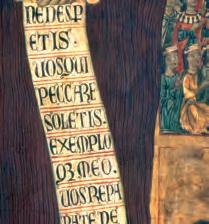
Re ce’s essay ends with a discussion of a panel by the Magdalene Master (Maestro della Maddalena; no.3.10; Fig.2), which includes small images showing scenes from the saint’s Life on either side of a depiction of her as a hair-clad penitential gure. By the time the panel was painted, c.1280–85, Mary Magdalene was the pre-eminent model of repentance for Christians. This image provides the link to the next essay, Secondino Gatta’s account of the later legend of the saint’s missionary activity in Marseilles – which the catalogue refers to as her apostolate – followed by her penitential retreat to a grotto, clad only in her hair and nally her death. Francesco Brasa provides a useful summary of the story of St Mary of Egypt and her con ation with Mary Magdalene’s already complex gure in the ninth century and highlights the fact that the ‘summit of Christian asceticism’ was considered to be the ‘removal of clothes [in a] return to terrestrial paradisal nudity’ (p.60), a phenomenon that was to greatly colour the Magdalene’s image. Alessandro Tomei’s excellent ‘La Maddalena di Giotto’ is an introduction to the rst full fresco cycle dedicated to Mary Magdalene, in the Lower Church at Assisi. He links its commission to the authenti cation of her relics at Saint-Maximin in Provence by Boniface VIII in 1295, to the Golden Legend (compiled before 1298) by Jacobus de Voragine and to Franciscan devotion to the saint as a model of repentance, mysticism and the eremitical life.




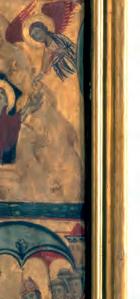
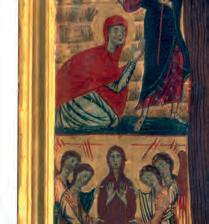

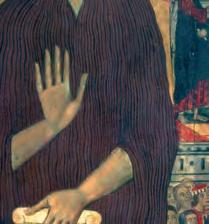
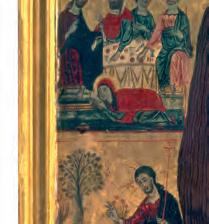
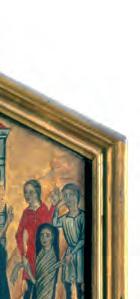
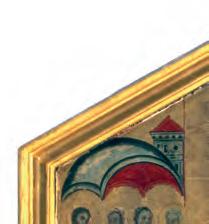
A second essay by Re ce o ers an introduction to the variegated gure of Mary Magdalene in the fteenth century. She considers the saint in her role as a patron of confraternities and congregations, her fundamental role in sacre rappresentazioni, which gave rise to sculpted life-size Lamentation groups, discussed in an essay by Virna Ravaglia, and the fashion for women to be depicted as Mary Magdalene, such as Catherine of Brabant, apparently portrayed as the saint in Rogier
dans les bibliothèques d’Europe et d’Orient: contribution à l’étude de l’iconographie des églises de langue syriaque, Paris 1964, pp.151–52; and M.R. James: The Apocryphal New Testament, Oxford 1920, p.88. See also R. Murray: Symbols of Church and Kingdom: A Study in Early Syriac
Tradition, Cambridge 1975, pp.329–35.
5 A. Warburg: ‘Delle “Imprese amorose” nelle più antiche incisioni fiorentine’, in idem: The Renewal of Pagan Antiquity: Contributions to the Cultural History of the European Renaissance, transl. D. Britt, Los Angeles 1999, pp.169–83, at p.174.
THE BURLINGTON MAGAZINE | 165 | JANUARY 2023 52
The many faces of Mary Magdalene
van der Weyden’s Braque polyptych (c.1452; Musée du Louvre, Paris). Donatello’s wooden sculpture of the penitent Magdalene (c.1450; Museo dell’Opera del Duomo, Florence), which was not in the exhibition, is the progenitrix of the equally hirsute and ha ard representations of the saint that followed it, in Antonio Pollaiuolo’s fresco of a beautiful elderly woman, carried to heaven by angels (c.1455–60; Museo della Pala del Pollaiolo, Sta ia Senese; no.5.5) and sculptures by Bu iano (c.1440; S. Maria Maddalena, Pescia; no.5.1), Don Romualdo da Candeli (1455; Museo della Collegiata di S. Andrea, Empoli; no.5.3), Francesco da Sangallo (1519; Museo Diocesano di Santo Stefano al Ponte, Florence; no.5.8) and Andrea della Robbia (c.1495–1505; S. Jacopo, Borgo a Mozzano; no.5.9).
In the exhibition these sculptures functioned as sentinels anking a long corridor outside the former convent cells, in which some of the most beautiful images of Mary Magdalene on show were exhibited. Among them were Masaccio’s aming, anguished, v-shaped gure below the Cruci xion (no.5.13; Fig.1) and the cleverly paired pietàs by Giovanni Bellini (1472–74; Musei Vaticani, Rome; no.5.16) and Marco Palmezzano (c.1500; Museo Civico di Palazzo Chiericati, Vicenza; no.5.17), moving depictions of Mary Magdalene as mourner and caritative myrrhophore, bent over the dead Christ’s wounds, her ointment jar held in the hand

3. Mary Magdalene from the sculptural group Lamentation, by Guido Mazzoni. c.1483–85. Polychrome terracotta. (Chiesa del Gesù, Ferrara; photograph Nicholas Pickwoad).
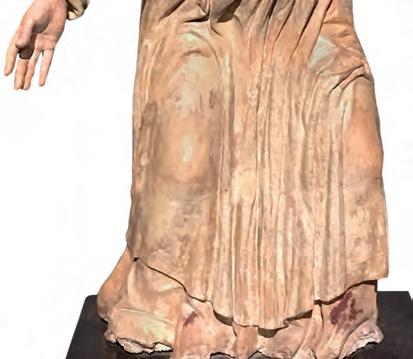

4. Noli me tangere, attributed to Jacopo Pontormo. c.1532. Oil on canvas, 175 by 133 cm. (Casa Buonarroti, Florence; Bridgeman Images).

of Nicodemus and Joseph of Arimathea. These depictions are ably analysed by Acidini in her essay ‘Nel cinquecento, tra classicismo e inquietudine’, in which she also discusses representations of the ‘heroine of the gospels’ (p.97) by, among others, Luca Signorelli and Raphael; she includes an excellent study of the Noli me tangere in paintings by Fra Angelico, Titian, Corre io and, above all, Federico Barocci (1590; Gallerie degli U zi, Florence; no.6.26), with its wondrous ‘dialogue of glance and gesture’ (p.103).
Acidini emphasises that the posture of the standing Magdalene in Jacopo Pontormo’s Noli me tangere (no.6.23; Fig.4) was, as Federico Giannini explains in the entry on the painting, based on a lost cartoon by Michelangelo for a painting that had been commissioned on behalf of Vittoria Colonna, which Pontormo executed under Michelangelo’s supervision. It seems that both Michelangelo and Pontormo were unaware of a similar, slightly earlier interpretation of the scene by Hans Holbein (1526–28; Royal Collection). Mary Magdalene’s garb, however, is not ‘modern’, as Acidini claims (p.104), but a type of ctive all’antica garment, one that Aby Warburg described as a ‘sprightly ideal costume, all’antica [. . .] or of those dancing maenads, consciously imitated from the antique’.5 Despite what Acidini writes, there is also no evidence that Colonna was in uenced by the treatises of the humanist Jacques Lefèvre, De Maria Magdalena (1518) and De tribus et unica Magdalena disceptatio secunda (1519), in which he aimed to isolate the di erent facets of the tripartite identity of the saint. Although in her writings Colonna celebrated Mary Magdalene as an ‘apostola’, she regarded her, above all, as a repentant sinner and model for

THE BURLINGTON MAGAZINE | 165 | JANUARY 2023 53
The many faces of Mary Magdalene
herself. A corrective should also be added to Giannini’s otherwise excellent catalogue entry for this painting: Michael Hirst explicitly rejected William Wallace’s su estion that Christ ‘follows with his look his own hands and nger while these seem to touch [her] protuberant breast’ on the grounds that it contradicted the underlying sense of the subject.6
Acidini speculates that Mary Magdalene’s mantle in Giovanni Gerolamo Savoldo’s dramatic half-length Mary Magdalene of 1535–40 in the National Gallery, London – a di erent version was shown in the exhibition (1535–40; Gallerie degli U zi; no.6.33) – might be the shroud retrieved from the empty tomb after the Resurrection, providing the saint with the close bodily contact denied to her by the risen Christ. This hypothesis is problematic for a number of reasons; to begin with, the mantle is of silk and not a linen grave cloth. The author does not mention that it is wrapped around her hand and held to her cheek in a standard Classical mourning gesture. Most importantly, Mary Magdalene’s visit to the empty tomb takes place before the Noli me tangere scene and so Christ’s touch had not yet been denied to her.

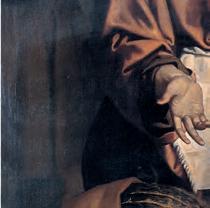
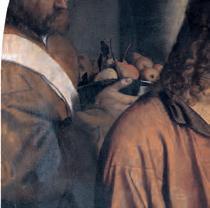
Acidini concludes with the way that Mary Magdalene was transformed into a worldly bella penitente in the courts of northern Italy, her nudity no longer hidden by hair, but exposed in ‘generous fullness’

(p.108) by Lombard followers of Leonardo, such as Giampetrino, who were in uenced by his lost StandingLeda and Kneeling Leda. This development led ultimately to Corre io and Titian, a theme taken up in later essays. In Francesco De Carolis’s catalogue entry for Mariotto di Nardo’s panel of the Trinity with the Virgin and Mary Magdalene (1400–05; Museo della Basilica di S. Maria delle Grazie, San Giovanni Val d’Arno; no.5.12), the Magdalene’s scarlet garments are interpreted as a reference to ‘her sinful condition’ (p.450); the author is unaware that recent work on the colour symbolism of Mary Magdalene has demonstrated that her wearing scarlet relates to the Passion and to caritas, the Christian love of humankind, and faith, not to ‘donne traviate’ (p.99).7
Virna Ravaglia provides an excellent contextual discussion of the Lamentation groups from late fteenth-century Emilia Romagna. She quotes Gabriele D’Annunzio’s description of Mary Magdalene in Niccolo dell’Arca’s polychrome terracotta group in Bologna (p.115, g.1), as a ‘howl turned to stone’ (‘l’urlo pietri cato’; p.119). The gures in such ensembles are extraordinarily life-like, as demonstrated by Guido Mazzoni’s groups, one of which (no.1.10; Fig.3), formed the dramatic focal point of the exhibition’s rst gallery, in the nave of the church. The wonderfully remorseful Magdalene gures in paintings of the supper in the house of the phariseeby Girolamo Romanino (1545; S. Giovanni Evangelista, Brescia; no.6.9) and Moretto da Brescia (no.6.10; Fig.5) are excellentlytreated in Massimo Francucci’s catalogue entries; the paintings were displayed alongside each other in the exhibition to striking e ect. In Moretto’s image of beautiful feminine sorrow, the light falls on the rippling hair of Mary Magdalene, who wears a pleated green satin gown, a white and gold striped scarf and ochre gold mantle. Her left hand tenderly caresses Christ’s foot and her right holds her hair draped over it; her jar of ointment is placed on the ground next to her. The still lifes of bread and wine, prominent on the tables above Mary Magdalene, possess eucharistic symbolism. These works acted as a prelude to paintings in the same room of the repentant Magdalene in the grotto into which she withdrew, by such artists as Titian, Domenico Tintoretto and Bernardo Strozzi.
An essay by Sonia Cavicchiolo explores the way that the depiction of Mary Magdalene changed in the Baroque period, starting with Carava io’s penitent (c.1596–97; Galleria Doria Pamphilj) and Rubens’s weeping gure at the foot of the Cross (1617–19; Musée du Louvre). These gures re ect the saint’s post-Tridentine paradigmatic role as an embodiment of penance in the light of the Church of Rome’s stance on the sacraments, which had been challenged by the Protestants. In Guido Cagnacci’s Conversion of Mary Magdalene (1661; Norton Simon Museum, Pasadena), the semi-nude saint is chastised by her sister Martha, whereas paintings by Georges de la Tour – for example that of c.1640 in the National Gallery of Art, Washington – and Domenico Fetti (c.1617; Galleria Doria Pamphilj, Rome) show her meditating with a skull and book. The exhibition included works by Cagnacci (no.7.28; Fig.7), Alessandro Rosi (c.1670; Gallerie degli U zi; no.7.29) and Simon Vouet (1649; Musée des Beaux-Arts et d’Archéologie, Besançon; no.7.30) showing the bare-breasted saint in a state of spiritual ravishment, or ecstasy, which according to Ignatius of Loyola, was the ultimate aim of meditation, the reunion of the soul with God. Francesco Furini’s penitent Magdalene (Kunsthistorisches Museum, Vienna), painted c.1633, the year that the artist was ordained, shows the saint naked, except for a strategically placed strand of hair. Cavicchiolo describes her as a ‘sinuous nude’ whose ‘eroticism is revealing and disturbing’ (p.131).
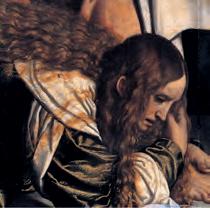

6 M. Hirst: Tre Saggi su Michelangelo, Florence 2004, p.22; and W.E. Wallace: ‘Il “Noli me Tangere” di Michelangelo: tra

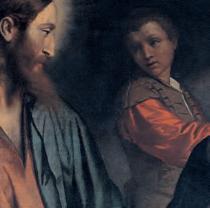

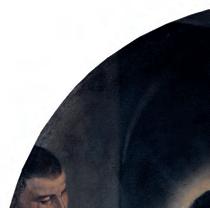
sacro e profano’, Arte Cristiana 76 (1988), pp.443–50, at p.448.
7 See S. Haskins: ‘Foreword’, in M.A.

THE BURLINGTON MAGAZINE | 165 | JANUARY 2023 54
The many faces of Mary Magdalene
5. Supper in the house of the pharisee, by Moretto da Brescia. 1550–54. Oil on canvas, 207 by 140 cm. (S. Maria in Calchera, Brescia; Bridgeman Images).
herself. A corrective should also be added to Giannini’s otherwise excellent catalogue entry for this painting: Michael Hirst explicitly rejected William Wallace’s su estion that Christ ‘follows with his look his own hands and nger while these seem to touch [her] protuberant breast’ on the grounds that it contradicted the underlying sense of the subject.6
Acidini speculates that Mary Magdalene’s mantle in Giovanni Gerolamo Savoldo’s dramatic half-length Mary Magdalene of 1535–40 in the National Gallery, London – a di erent version was shown in the exhibition (1535–40; Gallerie degli U zi; no.6.33) – might be the shroud retrieved from the empty tomb after the Resurrection, providing the saint with the close bodily contact denied to her by the risen Christ. This hypothesis is problematic for a number of reasons; to begin with, the mantle is of silk and not a linen grave cloth. The author does not mention that it is wrapped around her hand and held to her cheek in a standard Classical mourning gesture. Most importantly, Mary Magdalene’s visit to the empty tomb takes place before the Noli me tangere scene and so Christ’s touch had not yet been denied to her.



Acidini concludes with the way that Mary Magdalene was transformed into a worldly bella penitente in the courts of northern Italy, her nudity no longer hidden by hair, but exposed in ‘generous fullness’

(p.108) by Lombard followers of Leonardo, such as Giampetrino, who were in uenced by his lost StandingLeda and Kneeling Leda. This development led ultimately to Corre io and Titian, a theme taken up in later essays. In Francesco De Carolis’s catalogue entry for Mariotto di Nardo’s panel of the Trinity with the Virgin and Mary Magdalene (1400–05; Museo della Basilica di S. Maria delle Grazie, San Giovanni Val d’Arno; no.5.12), the Magdalene’s scarlet garments are interpreted as a reference to ‘her sinful condition’ (p.450); the author is unaware that recent work on the colour symbolism of Mary Magdalene has demonstrated that her wearing scarlet relates to the Passion and to caritas, the Christian love of humankind, and faith, not to ‘donne traviate’ (p.99).7
Virna Ravaglia provides an excellent contextual discussion of the Lamentation groups from late fteenth-century Emilia Romagna. She quotes Gabriele D’Annunzio’s description of Mary Magdalene in Niccolo dell’Arca’s polychrome terracotta group in Bologna (p.115, g.1), as a ‘howl turned to stone’ (‘l’urlo pietri cato’; p.119). The gures in such ensembles are extraordinarily life-like, as demonstrated by Guido Mazzoni’s groups, one of which (no.1.10; Fig.3), formed the dramatic focal point of the exhibition’s rst gallery, in the nave of the church. The wonderfully remorseful Magdalene gures in paintings of the supper in the house of the phariseeby Girolamo Romanino (1545; S. Giovanni Evangelista, Brescia; no.6.9) and Moretto da Brescia (no.6.10; Fig.5) are excellentlytreated in Massimo Francucci’s catalogue entries; the paintings were displayed alongside each other in the exhibition to striking e ect. In Moretto’s image of beautiful feminine sorrow, the light falls on the rippling hair of Mary Magdalene, who wears a pleated green satin gown, a white and gold striped scarf and ochre gold mantle. Her left hand tenderly caresses Christ’s foot and her right holds her hair draped over it; her jar of ointment is placed on the ground next to her. The still lifes of bread and wine, prominent on the tables above Mary Magdalene, possess eucharistic symbolism. These works acted as a prelude to paintings in the same room of the repentant Magdalene in the grotto into which she withdrew, by such artists as Titian, Domenico Tintoretto and Bernardo Strozzi.
An essay by Sonia Cavicchiolo explores the way that the depiction of Mary Magdalene changed in the Baroque period, starting with Carava io’s penitent (c.1596–97; Galleria Doria Pamphilj) and Rubens’s weeping gure at the foot of the Cross (1617–19; Musée du Louvre). These gures re ect the saint’s post-Tridentine paradigmatic role as an embodiment of penance in the light of the Church of Rome’s stance on the sacraments, which had been challenged by the Protestants. In Guido Cagnacci’s Conversion of Mary Magdalene (1661; Norton Simon Museum, Pasadena), the semi-nude saint is chastised by her sister Martha, whereas paintings by Georges de la Tour – for example that of c.1640 in the National Gallery of Art, Washington – and Domenico Fetti (c.1617; Galleria Doria Pamphilj, Rome) show her meditating with a skull and book. The exhibition included works by Cagnacci (no.7.28; Fig.7), Alessandro Rosi (c.1670; Gallerie degli U zi; no.7.29) and Simon Vouet (1649; Musée des Beaux-Arts et d’Archéologie, Besançon; no.7.30) showing the bare-breasted saint in a state of spiritual ravishment, or ecstasy, which according to Ignatius of Loyola, was the ultimate aim of meditation, the reunion of the soul with God. Francesco Furini’s penitent Magdalene (Kunsthistorisches Museum, Vienna), painted c.1633, the year that the artist was ordained, shows the saint naked, except for a strategically placed strand of hair. Cavicchiolo describes her as a ‘sinuous nude’ whose ‘eroticism is revealing and disturbing’ (p.131).


6 M. Hirst: Tre Saggi su Michelangelo, Florence 2004, p.22; and W.E. Wallace: ‘Il “Noli me Tangere” di Michelangelo: tra




sacro e profano’, Arte Cristiana 76 (1988), pp.443–50, at p.448.
7 See S. Haskins: ‘Foreword’, in M.A.

THE BURLINGTON MAGAZINE | 165 | JANUARY 2023 54
The many faces of Mary Magdalene
5. Supper in the house of the pharisee, by Moretto da Brescia. 1550–54. Oil on canvas, 207 by 140 cm. (S. Maria in Calchera, Brescia; Bridgeman Images).
A thoughtful, comprehensive essay by Mazzocca, ‘Tra Neoclassicismo e Simbolismo’, traces Mary Magdalene’s iconographic fortunes from Correggio’s St Mary Magdalene reading (after 1517; private collection) to the naked Magdalenes of the late nineteenth century, encompassing such artists as Sebastiano Conca, Benedetto Luti and Anton Raphael Mengs (who converted to Catholicism at the time he painted his first penitent Magdalene, c.1752). A lost painting by Pompeo Batoni after Correggio of the Magdalene reading was represented in the exhibition by a copy by Józef Wall (1779–82; Castello Reale, Warsaw; no.8.7). The depictions of the naked Magdalene, which were often kept as devotional images in the bedrooms or studioli of royal and aristocratic collectors, were clearly intended for the male gaze. Antonio Canova’s kneeling Penitent Magdalene (no.8.9, not exhibited; Fig.6) and Reclining Magdalene (no.8.10) took the image of the saint to a new level, ‘free of any devotional purpose’ (p.140), to become, we are told, a universal symbol of tormented femininity. As copied in paint by Fernando Cavalleri (1816; Castello Ducale, Agliè; no.8.15) and again by Natale Schiavoni for the Emperor Franz I of Austria (c.1830; Belvedere, Vienna), several variants of which were included in the exhibition, Canova’s Magdalene sheds not only her clothes but also her already tenuous relationship with her
biblical self and even with the legendary naked hermit and penitent in the desert. She becomes instead a kind of ‘modern reincarnation of the motif of melancholy’ (p.143) trapped between a rock and a hard place. For Mazzocca, Francesco Hayez, a ‘libertine’ celebrated for the sensuality of his nudes, depicted the ‘entirely profane’ Magdalene as a ‘true Romantic heroine’, ‘bursting with sensuality’ (p.143).
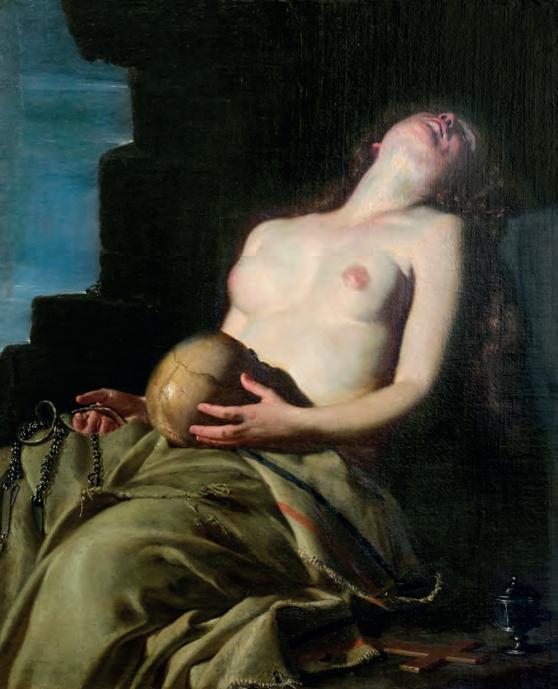
Mazzocca’s essay is accompanied in the catalogue by a phalanx of penitent Magdalenes in paesaggio, which include the ‘disconcerting realism’ (p. 144) of Domenico Induno’s well-endowed anchorite (c.1848–50; private collection; 9.14). There are also Magdalenes in paintings by Victor Orsel (1825; Musée de Poitiers; no.9.2) – in which, according to Stefano Bosi, the saint’s ‘bare breast’ apparently symbolises ‘her eremitical life’ (p.495) –Enrico Scuri (1864; Museo Civico Ala Ponzone, Cremona; no.9.15), which depicts her with a brightly lit bare haunch, and Paul Baudry (1858; Musée d’Arts de Nantes; no.9.18). This sequence culminates in Jean-Jacques Henner’s lubricious nymph (1860; Musée d’Unterlinden, Colmar; no.9.19) and writhing nudes by Jules Joseph Lefèbvre (c.1876; State Hermitage Museum, St Petersburg; no.9.22) and Marius Vasselon (1887; Musée des Beaux Arts, Tours; no.9.23). In such paintings, the depiction of the ‘apostola apostolorum’ has become entirely divorced from any religious function. In the catalogue, this is given a twenty-first-century gloss by Brunelli in his introduction and by Mazzocca in his essay. Mazzocca presents these works as a symbol of modern and provocative femininity which ‘did not fear to show itself in all its erotic character’ (p.144), despite the fact that meditation and melancholy were Romantic motifs, the reason why the subject was adopted by sculptors in this period, such as Pompeo Marchesi in his Penitent Magdalene (1832; Fitzwilliam Museum, Cambridge). Despite the curators’ attempt to justify such paintings as evidence of female sexual liberation, it is hard to avoid seeing them as anything other than pious pornography.
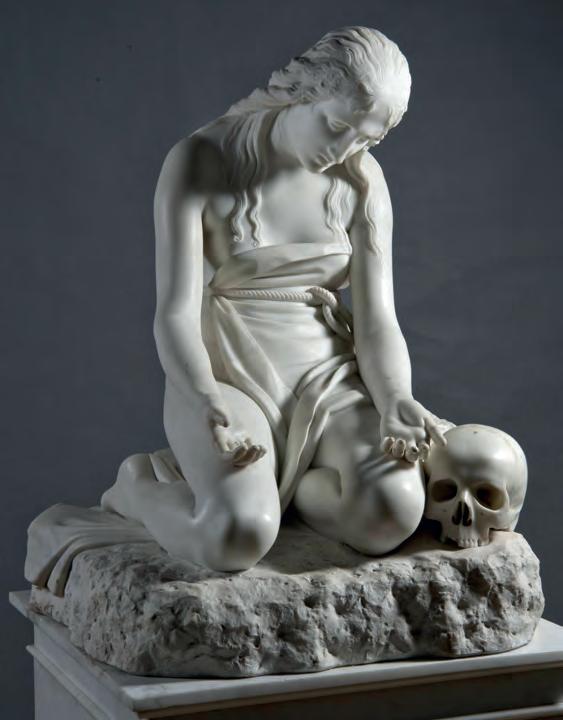
the
magazine | 165 | january 2023 55
The many faces of Mary Magdalene
burlington
Erhardt and A.M. Morris: Mary Magdalene: Iconographical Studies from the Middle Ages to the Baroque,
Leiden and Boston 2012, at p.xxxi; and idem: Mary Magdalen: The Essential History, London 2005, p.147.
6. Penitent Mary Magdalene, by Antonio Canova. 1808–09. Marble, height 95 cm. (State Hermitage Museum, St Petersburg).
7. Penitent Mary Magdalene, by Guido Cagnacci. 1625–27. Oil on canvas, 86 by 72 cm. (Galleria Nazionale d’Arte Antica, Rome; Bridgeman Images).
A thoughtful, comprehensive essay by Mazzocca, ‘Tra Neoclassicismo e Simbolismo’, traces Mary Magdalene’s iconographic fortunes from Correggio’s St Mary Magdalene reading (after 1517; private collection) to the naked Magdalenes of the late nineteenth century, encompassing such artists as Sebastiano Conca, Benedetto Luti and Anton Raphael Mengs (who converted to Catholicism at the time he painted his first penitent Magdalene, c.1752). A lost painting by Pompeo Batoni after Correggio of the Magdalene reading was represented in the exhibition by a copy by Józef Wall (1779–82; Castello Reale, Warsaw; no.8.7). The depictions of the naked Magdalene, which were often kept as devotional images in the bedrooms or studioli of royal and aristocratic collectors, were clearly intended for the male gaze. Antonio Canova’s kneeling Penitent Magdalene (no.8.9, not exhibited; Fig.6) and Reclining Magdalene (no.8.10) took the image of the saint to a new level, ‘free of any devotional purpose’ (p.140), to become, we are told, a universal symbol of tormented femininity. As copied in paint by Fernando Cavalleri (1816; Castello Ducale, Agliè; no.8.15) and again by Natale Schiavoni for the Emperor Franz I of Austria (c.1830; Belvedere, Vienna), several variants of which were included in the exhibition, Canova’s Magdalene sheds not only her clothes but also her already tenuous relationship with her
Leiden and Boston 2012, at p.xxxi; and idem: Mary Magdalen: The Essential History, London 2005, p.147.
biblical self and even with the legendary naked hermit and penitent in the desert. She becomes instead a kind of ‘modern reincarnation of the motif of melancholy’ (p.143) trapped between a rock and a hard place. For Mazzocca, Francesco Hayez, a ‘libertine’ celebrated for the sensuality of his nudes, depicted the ‘entirely profane’ Magdalene as a ‘true Romantic heroine’, ‘bursting with sensuality’ (p.143).

Mazzocca’s essay is accompanied in the catalogue by a phalanx of penitent Magdalenes in paesaggio, which include the ‘disconcerting realism’ (p. 144) of Domenico Induno’s well-endowed anchorite (c.1848–50; private collection; 9.14). There are also Magdalenes in paintings by Victor Orsel (1825; Musée de Poitiers; no.9.2) – in which, according to Stefano Bosi, the saint’s ‘bare breast’ apparently symbolises ‘her eremitical life’ (p.495) –Enrico Scuri (1864; Museo Civico Ala Ponzone, Cremona; no.9.15), which depicts her with a brightly lit bare haunch, and Paul Baudry (1858; Musée d’Arts de Nantes; no.9.18). This sequence culminates in Jean-Jacques Henner’s lubricious nymph (1860; Musée d’Unterlinden, Colmar; no.9.19) and writhing nudes by Jules Joseph Lefèbvre (c.1876; State Hermitage Museum, St Petersburg; no.9.22) and Marius Vasselon (1887; Musée des Beaux Arts, Tours; no.9.23). In such paintings, the depiction of the ‘apostola apostolorum’ has become entirely divorced from any religious function. In the catalogue, this is given a twenty-first-century gloss by Brunelli in his introduction and by Mazzocca in his essay. Mazzocca presents these works as a symbol of modern and provocative femininity which ‘did not fear to show itself in all its erotic character’ (p.144), despite the fact that meditation and melancholy were Romantic motifs, the reason why the subject was adopted by sculptors in this period, such as Pompeo Marchesi in his Penitent Magdalene (1832; Fitzwilliam Museum, Cambridge). Despite the curators’ attempt to justify such paintings as evidence of female sexual liberation, it is hard to avoid seeing them as anything other than pious pornography.

the
magazine | 165 | january 2023 55
The many faces of Mary Magdalene
burlington
Erhardt and A.M. Morris: Mary Magdalene: Iconographical Studies from the Middle Ages to the Baroque,
6. Penitent Mary Magdalene, by Antonio Canova. 1808–09. Marble, height 95 cm. (State Hermitage Museum, St Petersburg).
7. Penitent Mary Magdalene, by Guido Cagnacci. 1625–27. Oil on canvas, 86 by 72 cm. (Galleria Nazionale d’Arte Antica, Rome; Bridgeman Images).
Mazzocca also discusses the new role given to Mary Magdalene in nineteenth-century French religious art as protectress of the nation she had in legend converted, which prompted such works as Christ on the Cross, Calvary by Eugène Delacroix (1835; La Cohue, Musée des Beaux-Arts de Vannes; no.9.5) and Christ the Redeemer by Ary Scheffer (1847–58; Centraal Museum, Utrecht; no.9.11). In contrast, the Swiss Symbolist Arnold Böcklin depicted the saint as a black-veiled figure in Mary Magdalene weeping over the body of Christ (1867; Kunstmuseum, Basel), returning her ‘to her profound tragic self’ (p.149). Mazzocca ends his essay with a discussion of Jean Béraud’s Magdalene in the house of the Pharisee (1891; Musée d’Orsay, Paris; no.9.24), which includes portraits of, for example, Ernest Renan and Alexandre Dumas fils, and shows the Magdalene in the form of the courtesan Liane de Pougy lying (fully clothed) at Christ’s feet.
The essays on Mary Magdalene in the twentieth century include an excellent survey by Elena Pontiggia of the saint’s appearances in Italian art from 1900 to 1960. In the Crucifixion by Renato Guttuso (1941; Galleria Nazionale d’Arte Moderna e Contemporanea, Rome; no.10.17) she is the symbol of humankind’s sorrow, depicted naked like almost everyone else in this painting apart from the Virgin Mary; the painting caused the greatest scandal concerning sacred art in Italy in the first half of the twentieth century. According to Pontiggia, Mary Magdalene resumes her biblical role – which she defines as that of the ‘apostle to the apostles’ – as a central figure with a strong presence in Crucifixions and Depositions in the early twentieth century, images depicting humankind’s sorrow
9.
in existential dramas by Expressionists such as Emile Nolde and Max Beckmann and later on Pablo Picasso, Francis Bacon and several Italian artists including Carlo Carrà and Giorgio de Chirico. Most striking for this reviewer are Fausto Melotti’s bronze Deposition (1933; private collection; no.10.21), in which Christ’s body slithers into the upraised arms of Mary’s half-kneeling figure, and Venanzo Crocetti’s profoundly evocative bronzes Standing Mary Magdalene and Crouching Mary Magdalene (nos.10.23 and 10.24; Fig.8), which show her in agony In her conclusion, Pontiggia notes that Graham Sutherland’s Noli me tangere (no.10.21; Fig.9) depicts the episode in which Christ exhorts Mary Magdalene to announce his resurrection to the apostles, and in which she symbolises therefore ‘mankind’s turn to God’ (p.162). It marks a return to Mary Magdalene’s evangelical identity as the ‘apostle to the apostles’.

The exhibition’s broad chronological range and inclusivity created a significant problem, at least for this reviewer, as the saint’s iconography across the centuries contains so many contradictory meanings that her true (gospel) figure is easily lost unless seen through a historical as well as an art-historical lens. By treating the images primarily as works of art, with little distinction made between them in terms of the historical authenticity of their subject-matter, the ‘apostle to the apostles’ was all too easily replaced by the ‘apostle’ to France, before attention shifted to the penitent Magdalene, clad or otherwise, in the desert. The catalogue argues that Mary Magdalene’s sexuality, once considered a sin, humanised the saint, but many of the paintings depict her in a way that differs little from the voyeuristic and pornographic images of women by nineteenth-century Orientalist artists. By arguing that such works represent a liberating humanisation, the curators continued to shackle her to the male gaze. That said, it was a wonderfully rich exhibition, which made creative use of the great monastic church and its conventual buildings and, together with the catalogue, went a long way to doing justice to Mary Magdalene.
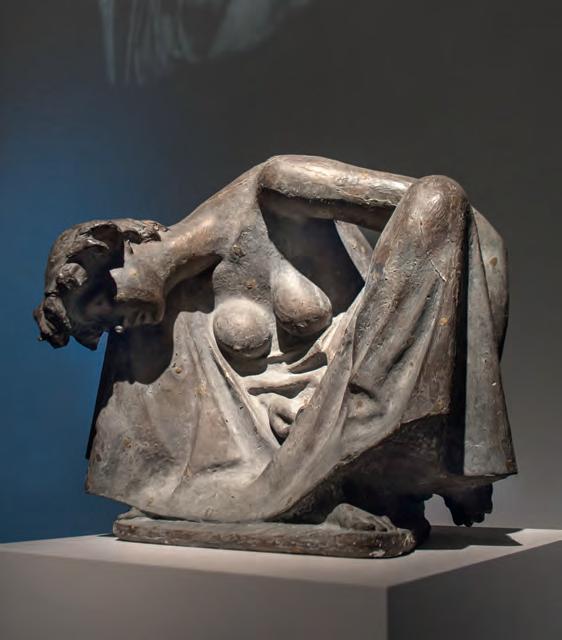
the burlington magazine | 165 | january 2023 56
The many faces of Mary Magdalene
8. Mary Magdalene crouching, by Venanzo Crocetti. 1956. Bronze, height 63 cm. (Fondazione Venanzo Crocetti, Rome).
Christ appearing to Mary Magdalene (Noli me tangere), by Graham Sutherland. 1961. Oil on canvas, 64 by 55.3 cm. (Pallant House Gallery, Chichester; © Pallant House Gallery / Hussey Bequest, Chichester District Council, 1985; Bridgeman Images).
The man who never was – almost
Despite the complications and long delays caused by the pandemic, an impressive number of exhibitions were staged to mark the five-hundredth anniversary of Raphael’s death in 1520. Those in London and Rome were comprehensive in scope, but very different in approach.
by arnold nesselrath
. b. priestley’s play An Inspector Calls, first performed in 1945, has nothing to do with Raphael, except that it is set in 1912 on the evening of 5th April – the day before the anniversary of the artist’s death. The plot concerns a police inspector’s investigation into a young woman’s suicide, with whom each member of the wealthy family he questions was somehow involved; all bear responsibility. After the inspector departs it is revealed that he was a fraud and the case a hoax, at which point the relieved family is told that a young woman has in fact died and a real police inspector is on his way to investigate. As the story begins to repeat itself, facts and fabrications merge.
Raphael is in a way not unlike that young woman. What do we really know about him? No more than two personal letters by him survive, of which only one is autograph. He appears to be a man who never was, and yet his great works in all artistic disciplines – including even archaeological research – are undoubtedly real. That the international celebrations planned to mark the fifth centenary of his death on 6th April 1520 almost never happened because of the pandemic seems symptomatic.
What did the events that were eventually staged reveal about the man or the artist? It should be said at once that it is a great tribute to the international museum community that not only the two main anniversary celebrations, the exhibitions in Rome and London, but also many other smaller shows did nonetheless take place and were enjoyed by large audiences. The hosts of those two major exhibitions responded with great efficiency to the unprecedented impasse created by the pandemic. The exhibition Raffaello 1520–1483 opened at the Scuderie del Quirinale, Rome, on 5th March 2020 but had to close after only three days.1 However, all the lenders agreed to double the periods of their loans, ensuring that
1 M. Faietti and F. Lafranconi, eds: exh. cat. Raffaello 1520–1483, Rome (Scuderie del Quirinale) 2020. The present author contributed an essay to the catalogue. The exhibition was reviewed by Patrizia Cavazzini in this Magazine 162 (2020), pp.983–85, and by the present author in The Art Newspaper (10th August 2020).
2 See, in addition to the exhibitions discussed in this article, M. Deldique:
exh. cat. Raphaël à Chantilly: Le maître et ses élèves, Chantilly (Château de Chantilly), 2020; exh. cat. Raphaël à Bayonne: le maître, ses élèves, ses copistes dans les collections du musée Bonnat-Helleu, Bayonne 2020; and A. Cerasuolo et al.: exh. cat. Raffaello a Capodimonte: L’officina dell’artista, Naples (Museo e Real Bosco di Capodimonte) 2021.
3 The July 1984 issue of this Magazine,
after it reopened in June the exhibition could continue for longer than planned, to 30th August, although there were restrictions on visitor numbers. The National Gallery, London, reshuffled its entire schedule and postponed The Credit Suisse Exhibition: Raphael for eighteen months, to April 2022. In both cases, the additional collegial and logistic efforts involved cannot be underestimated. All the other institutions staging anniversary exhibitions faced equivalent difficulties in proportion to their projects. The achievements were a worthy tribute to both Raphael’s genius and the attractive personality for which he was renowned.
Despite the difficulties of grasping his contribution, Raphael has enjoyed the status of an icon of Western culture ever since his death five hundred years ago. Consequently, exhibitions were held – or at least planned – for 2020 from St Petersburg to Chantilly and Columbus, Ohio, and from London to Bayonne and Naples.2 Of those discussed in this article, the present reviewer was able to visit only about half, as a result of restrictions on travel caused by the pandemic, although it was possible to get an idea from online films and presentations of some of those that could not be visited, as well as from their catalogues.
The stakes for this anniversary were high, given the enthusiasm across Europe and the United States for the last major Raphael commemoration, the five-hundredth anniversary of his birth in 1983.3 The events of that year opened up new perspectives on his career, providing the impetus for future scholarly developments, such as John Shearman’s monumental catalogue raisonné of all the documents and other sources concerning Raphael up to the year 1602, published in 2003,4 the Vatican’s comprehensive publication of the Acts of the Apostles tapestries woven for the Sistine Chapel and their restoration, which was begun back in 1982,5 and numerous art-historically
dedicated to Raphael, reviewed many of the events and publications of that year.
4 J. Shearman: Raphael in Early Modern Sources (1483–1602), New Haven 2003, which was reviewed by Tom Henry in this Magazine, 148 (2006), pp.696–98.
5 A .M De Strobel, ed.: exh. cat. Leone
X e Raffaello in Sistina – Gli arazzi degli Atti degli Apostoli, Vatican (Vatican Museums) 2020. The hanging
of Raphael’s tapestries in the Sistine Chapel, as displayed in March 1983, was the subject of a new reconstruction, on display on 14th July 2010, in the light of an exhibition at the Victoria and Albert Museum, see C. Browne and M. Evans with A. Nesselrath: exh. cat. Raphael: Cartoons and Tapestries for the Sistine Chapel, London (Victoria and Albert Museum), 2010; this was repeated 17th–23rd February 2020.
the burlington magazine | 165 | january 2023
57
The man who never was – almost
conceived restorations of such works as the Vatican Stanze, the tapestry cartoons in the Victoria and Albert Museum, London, the Madonna del Baldacchino at Palazzo Pitti, Florence, and Palazzo Alberini, Rome.
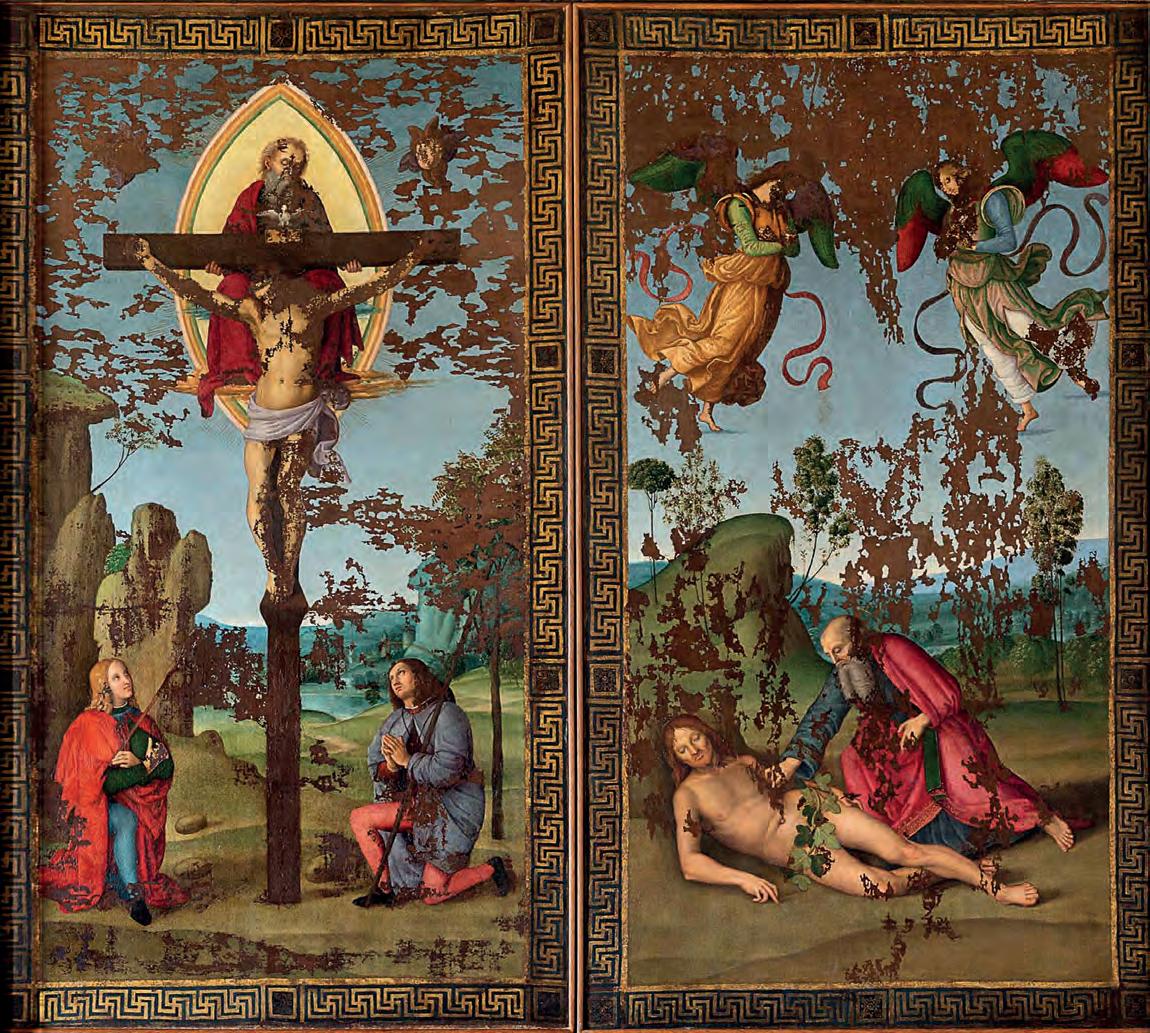
All the exhibitions planned for 2020 had to come to terms with the two astounding exhibitions of Raphael’s drawings organised jointly by the Ashmolean Museum, Oxford, and the Albertina, Vienna, in 2017, as a result of which many sheets were unavailable for lending for reasons of conservation rules.6 There appears to have been no attempt at coordination between those two exhibitions and any of the 2020 projects. As a consequence, the anniversary enterprises remained fragmentary in many of their discourses, since relevant works on specific topics often
1. The Trinity with Sts Sebastian and Roch and The creation of Eve, by Raphael, photographed after its recent restoration. c.1499. Oil on canvas, each 266 by 94 cm. (Pinacoteca Comunale, Città di Castello).
could not be borrowed, making one very grateful for the rare occasions lenders had allowed exceptions from these rules. Some curators developed an intelligent way of working around this restriction, as in the case of an essential component of the exhibition in Rome, Raphael’s Transfiguration (1516–20; Vatican Museums), the painting said to have been exhibited above the artist’s deathbed in 1520; instead of evoking the occasion through the spectacular auxiliary cartoons for the painting two minor studies and some romantic interpretations of the situation by eighteenth and nineteenthcentury artists were shown.
Exhibitions addressing more regional audiences contributed to forming an idea of the master by choosing topics that illustrated related aspects of Raphael’s universal role. For example, the WinckelmannMuseum, Stendal, one of the smallest contributors to the celebrations, mounted a display of prints from its own collection, Vorbild Raffael – mit Geist und Kenntniß des Alterthums begabet, and even in the absence of a
the burlington magazine | 165 | january 2023 58
The man who never was – almost
2. View of the Logge in the Vatican, by Ludwig Gruner. 1844. Chromolithograph, 54.8 by 37.3 cm. (page). (From Fresco Decorations and Stuccoes of Churches and Palaces in Italy during the Fifteenth and Sixteenth Centuries, with Descriptions by Lewis Gruner, London 1844; Royal Collection Trust; © HM King Charles III 2023).
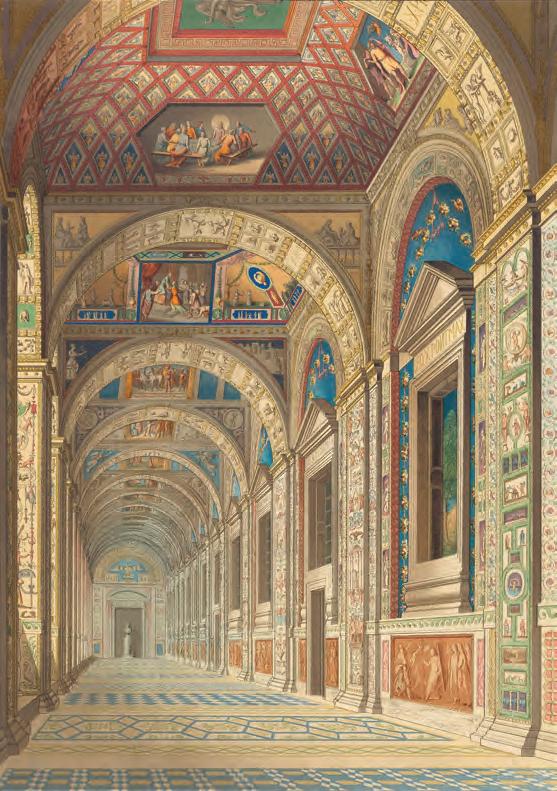
catalogue was able to demonstrate their educational importance for local culture. Raphael painted his earliest known altarpieces for an Umbrian town of a similar scale to Stendal, Città di Castello. The town revisited old glories by restaging the exhibition on the young Raphael seen there in 1983, albeit with more loans of works by him.7 It succeeded in presenting several fresh aspects of the young artist, including a judicious digital reconstruction of his St Nicholas of Tolentino altarpiece (1501), of which only fragments survive in various collections, following the damage it incurred during an earthquake in 1789.
Among the four paintings by Raphael for Città di Castello the only one that has remained in the town until the present day is a doublesided canvas banner (gonfalone), which underwent fresh conservation for the exhibition (Fig.1). The disconcerting results reveal not only that restoration carries technical risks but also that the removal of later overpaint can have an irreversible impact on a work. In 1952 the banner underwent restoration intended to remove all the additions made since Raphael’s time. The exhibition’s catalogue contains two considered essays on the challenge presented by the resulting lacunae in the banner’s paint surface. The task of improving the visually unhappy effects of the removal of the overpaint had prompted an earlier conservation campaign, in 2006, when the late Anna Maria Marcon, an experienced restorer who worked at the Istituto Centrale di Restauro, Rome, stated the danger of ‘forging a state of preservation’, creating confusion about which areas were damaged and making the underdrawing illegible by partial infills.8 Modern digital technology would have made it possible to create an image of what the banner might have looked like without interventions on the original.
Berlin offered a pair of exhibitions, each of which impressively revealed Raphael’s genius in a nutshell, one of drawings by him in the collection of the Kupferstichkabinett, the other a display at the Gemäldegalerie of its five early Madonnas, which were accompanied by the first-ever international loan from the National Gallery, London, of the Madonna of the pinks (1507).9 The Kunsthalle in Hamburg unveiled an unexpected tradition of local collectors, who in this Protestant environment assembled prints by and after this overtly papal artist as well as early photographs of his works.10 The exhibition also included a colour lithograph by Ludwig Gruner, published in 1844, which documents the lost original majolica floor made by Luca della Robbia the Younger to Raphael’s design for the Vatican Logge (Fig.2), and culminated in a display of the museum’s own five supposed autograph drawings.
Dresden exhibited its set of the tapestries woven at the manufactory at Mortlake from Raphael’s cartoons for the Sistine Chapel following their acquisition in 1623 by the future Charles I (Fig.3). This focused exhibition
6 C. Whistler and B. Thomas, eds: Raphael: The Drawings, Oxford (Ashmolean Museum) 2017; and A. Gnann, ed.: exh. cat. Raphael, Vienna (Albertina) 2017–18, both exhibitions were reviewed by Tom Henry in this magazine, 160 (2018), pp.226–33.
7 A.M. Mercalli and L. Teza: exh. cat. Raffaello Giovane a Città di Castello e il suo sguardo, Città di Castello (Pinacoteca Comunale) 2021.
8 A .M Marcone: ‘Lo Stendardo della Trinità: tecniche di esecuzione e intervento di restauro’, in T. Henry and F.F. Mancini, eds:
exh. cat. Gli esordi di Raffaello tra Urbino, Città di Castello e Perugia, Città di Castello (Pinacoteca Comunale) 2006, p.154.
9 Accompanying publication: D. Korbacher: Raphael in Berlin: Masterpieces from the Kupferstichkabinett and The Madonnas of the Gemäldegalerie, Berlin 2020.
10 A . Stolzenburg and D. Klemm: exh. cat. Raffael – Wirkung eines Genies, Hamburg (Hamburger Kunsthalle) 2021. A British parallel was an exhibition at the Lightbox,
addressed the topic to which the celebrations in several instances will probably make one of their lasting contributions to scholarship.11 Casts from ancient Roman sculptures tried to evoke, slightly theatrically, the stylistic environment in which Raphael created his designs. A remarkable drawing in a private collection of studies including cranes and other birds for one of the cartoons by Giovanni da Udine, one of Raphael’s most important collaborators, known for decades only through photographs, was on show.12
The Victoria and Albert Museum provided scholars with an extraordinary scholarly tool by making a high-resolution recording in colour, 3D and infra-red of the tapestry cartoons – the greatest cycle of High Renaissance paintings outside Italy – available on the internet.13 The refurbishment of the Raphael Gallery sadly lacked the funds to improve the visibility of the cartoons by replacing the coloured protective glass.
Woking, on the collection of reproductions of Raphael’s works formed by Prince Albert, Raphael: Prince Albert’s Passion (3rd October 2020–31st January 2021), reviewed by Michael Hall in this Magazine, 163 (2021), pp.64–67.
11 S. Koja: exh. cat. Raffael – Macht der Bilder: Die Tapisserien und ihre Wirkung, Dresden (Gemäldegalerie Alte Meister) 6th June–30th August 2020. See also S. Koja: exh. cat. Raphael – The Power of Renaissance Imagery: The Dresden Tapestries and their Impact, Columbus OH (Museum
of Art) 2022. The present author contributed an essay to the catalogue. For further recent contributions to the study of Raphael’s tapestries, see A.C. Baiardi and N.F. Grazzini: exh. cat. Sul filo di Raffaello: Impresa e fortuna nell’arte dell’arazzo, Urbino (Galleria Nazionale delle Marche) 2021; and A. Enzensberger, ed.: Apostel in Preussen, Berlin 2020.
12 See L. Mohr, entry in Koja 2022, op. cit. (note 11), pp.54–57, figs.1 and 2.
13 See www.vam.ac.uk/articles/explorethe-raphael-cartoons, accessed 19th December 2022.
the burlington magazine | 165 | january 2023 59
The State Hermitage Museum, St Petersburg, put on its own megashow, Raphael’s Line 1520–2020 (10th December 2020–28th March 2021), which drew on museums and private collections in Russia to display both works by Raphael and his legacy up to the present time, augmented by loans of drawings from major European collections. An unobtrusive installation inside the ostentatious state rooms of the tsars assembled the newly restored frescos by Raphael’s workshop or followers that once decorated the loggia of the Villa Stati-Mattei on Rome’s Palatine Hill. For anyone who could not get to St Petersburg or obtain the accompanying publication Liniia Rafaelia: 1520–2020 (ArtVolkhonka publishing house, Moscow), the inclusion of the room on the Hermitage’s online video tour is a valuable compensation.14 Although a powerful demonstration of the medium, this makes it evident that there is no substitute for first-hand
14 The vir tual tour is available at www.pano.hermitagemuseum. org/3d/html/pwoaen/raphaelmain/, accessed 14th December 2022.
15 A . Nesselrath: Das Fossombroner Skizzenbuch, London 1993, p.31.
16 As stated in the introductory
the burlington magazine | 165 | january 2023 60
examination of these enigmatic frescos. The Hermitage’s marble Dead boy on a dolphin (Fig.5) was not shown in the exhibition, and whatever one thinks of the attribution to Raphael its inclusion could have stimulated new discussion about this enchanting sculpture.15
The anniversary celebrations hinged on the two blockbuster exhibitions in Rome and London, like a pair of batwing doors, unnecessarily competing with each other. Both took a monographic approach and both aimed to present all the artist’s activities. Major efforts were made to market the artist: the Rome exhibition was claimed to be ‘the largest ever devoted to Raphael and one of the most important staged in Italy’ and that in London was advertised as presenting ‘the entire range of Raphael’s artistic production. No exhibition in the UK has ever done this’. One can certainly agree with John Booth, chairman of the National Gallery’s Trustees, who stated in a film promoting the show that ‘this is an important event for the National Gallery, for the artist, and for our understanding of him’, although a dead artist can

panel to the exhibition and the opening text in the booklet accompanying the exhibition.
17 A . Blunt: ‘Art under Capitalism
and Socialism’, in C. DayLewis, ed.: The Mind in Chains, London 1937, pp.103–22, at p.111.
The man who never was – almost
3. St Paul preaching in Athens, by the Mortlake Tapestry Manufactory after a cartoon by Raphael. After 1625. Wool, silk and linen tapestry, 433 by 538 cm. (Gemäldegalerie Alte Meister, Dresden).
hardly gain anything from an exhibition; his works, instead, can have an impact on the present.
Attribution is basic to every art-historical discourse and although it can become excruciatingly tedious, the London exhibition excluded the issue altogether – and with it essential aspects of Raphael’s artistic personality and practice – by adopting, with astounding self-assurance, the principle of displaying only autograph works: ‘All works are by Raphael unless otherwise stated’.16 Of the eighty-eight exhibits, only thirteen were labelled as being by other artists. The Rome exhibition was less selective, and instead propped up its choice of autograph works largely by accepting uncritically many of the ‘permissive’ attributions by Konrad Oberhuber, especially of drawings.
The exhibition in London was beautiful and universally liked. A great display of masterpieces in painting, drawing and engraving, with ample space to enjoy every exhibit, it presented the artist in a traditional way. The exhibition’s wall texts and labels (all reproduced in a useful little booklet for visitors) marketed Raphael with superlative if superfluous slogans – ‘effortless beauty’, ‘precocious ability’, ‘supremely gifted’ –propagating the idea of his tireless ambition and delivering him from any real outside interference.
As in many of the National Gallery’s exhibitions, the ‘power of the patron’ – to use Anthony Blunt’s phrase – is such that the sponsor’s name was included in the exhibition’s official title, The Credit Suisse Exhibition: Raphael 17 The supertitle prevented a meaningful subtitle, which might have conveyed to the general public whether the exhibition sought to do more than offer sheer pleasure. An exhibition is first and foremost an educational enterprise and it would have taken very little to have turned this one into a great exhibition, had the catalogue and wall texts addressed and conveyed its indisputable aesthetic qualities.18 Why, for example, is the painter of the Mond Crucifixion (National Gallery; no.4), one of Raphael’s earliest surviving altarpieces, the same artist as the mature painter of the so-called Self-portrait with his fencing master (Musée du Louvre, Paris; no.88)? Does the exhibition’s phrase ‘universal artist’ really capture Vasari’s portrayal of Raphael as ‘ottimo universale’?
The exhibition started out chronologically, with sections on ‘Early Works’ and ‘Florence & Beyond’, before swiftly switching to an iconographical topic, ‘Madonnas’. This was followed by sections on three patrons, ‘The Pope’s Banker’ and ‘Working for Two Popes’, and one on the School of Athens, which ignored recent research and technical evidence about the Stanze. The next section, with the overall title ‘The Universal Artist’, divided an integrated artist into separate disciplines – ‘Printmaker’, ‘Designer’ and ‘Archaeologist’ – strangely singling out ‘Architect’ under a separate heading. The exhibition moved towards its close with ‘Grand Visions’, introduced by the St Cecilia altarpiece (between 1514 and 1517; Pinacoteca Nazionale, Bologna; no.66), which was followed by one of the tapestries from the Sistine Chapel, St Paul preaching in Athens (1517–19; Vatican Museums; no.65), accompanied by a full-scale replica by Factum Arte of the corresponding cartoon, and ended with ‘Friends & Patrons’ presenting an auxiliary cartoon for the Transfiguration (c.1519–20; private collection; no.86) and five seemingly randomly chosen Roman portraits. It is a good idea to keep the booklet to hand as a compass to guide one’s way through the catalogue, in which the entries are organised according to a presumed chronology. Even allowing for the fact that the exhibition’s discourses were conditioned by the availability of loans, the catalogue is not arranged in a meaningful sequence. One wonders whether this
18
contributed an essay to the catalogue.
19 Ekserdjian and Henry, op. cit. (note 18), p.13.
4. Virgin and Child (‘The Tempi Madonna’), by Raphael. 1507–08. Oil on panel, 75 by 51 cm. (Alte Pinakothek, Munich).
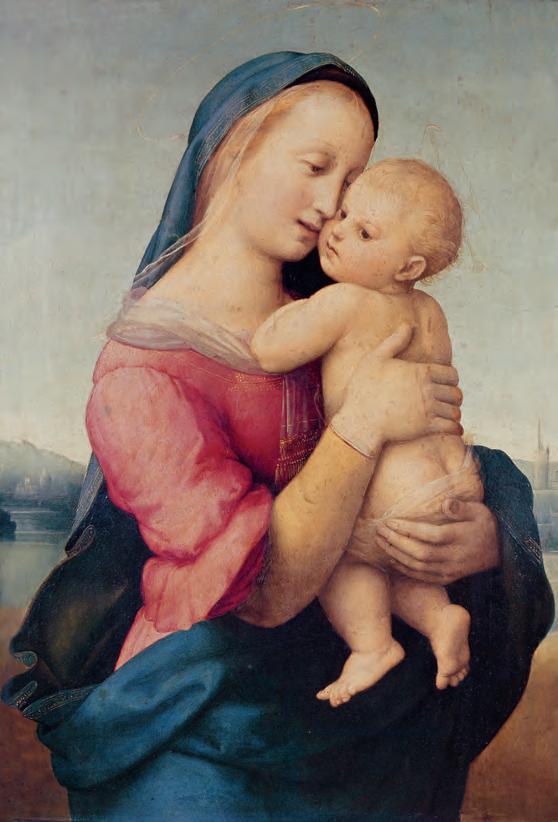
5. Dead boy on a dolphin, attributed to Lorenzetto, after a design by Raphael. Marble, 39 by 106 cm (State Hermitage Museum, St Petersburg).
was the result of an unsuccessful compromise between the exhibition’s curators and the editor of the catalogue in order to ensure the inclusion of catalogue entries, which are deplorably not popular with publishers. It is the purpose of a catalogue, however, to explain why the objects on show were chosen.

the burlington magazine | 165 | january 2023 61
The man who never was – almost
D. Ekserdjian and T. Henry, eds, with M. Wivel: exh. cat. Raphael, London (National Gallery) 2022. The present author
6.
7. St George, by Raphael. c.1505. Oil on panel, 30.7 by 26.8 cm. (Musée du Louvre, Paris).


Opposite
8. Holy Family with a pomegranate, by Raphael. c.1507–08. Pen and ink and black and red chalk on paper, 35.3 by 23.4 cm. (Palais de Beaux-Arts, Lille).
The curators explicitly excluded the topic of Raphael’s workshop, since this ‘would have diluted our appreciation of Raphael’s art’.19 They seem to agree with the old tradition that workshop involvement diminishes a genius, whereas, on the contrary, it is an integral part of an artist’s creativity, and of Raphael’s in particular. At the end of their introductory essay the curators admit this, writing that ‘There is something vaguely dismissive about the phrase “Raphael’s workshop” almost as if its members do not warrant being discussed as individuals’.20 However the only discussion in their introduction of the issue of Raphael’s collaborators concerns printmaking.21 The question of collaboration is paramount right from the beginning of the artist’s career, as revealed bya telling juxtaposition in the exhibition, since it seems inconceivable that the artist of the horses in the Procession to Calvary (Fig.6; no.8) could have painted, supposedly in the same year, the horse in St George (Fig.7; no.12). It is refreshing that Thomas P. Campbell, in his concise catalogue essay on Raphael’s tapestries, is open not only to considering the new reconstruction of the original display of the tapestries in the Sistine Chapel but also to such provocative proposals as Giovanni da Udine having had a creative role in their design.22
In 1968 Shearman criticised ‘the divisive attitude: And, by the way, he was also an architect’ as being ‘fatal’,23 yet the introductory panel to the National Gallery exhibition nonetheless stated ‘He was also a gifted architect’. At the accompanying conference Nicholas Penny effectively challenged this insensitivity by demonstrating Raphael’s ‘completely architectural mind’ at work in the composition of Domenico Alfani’s painting Holy Family with a pomegranate (c.1507–08), for which Raphael provided a drawing, included in the exhibition (Fig.8; no.29). It is not possible to ‘understand’ Raphael if his architectural approach is neglected.
20 Ibid., p.34.
21 D. Ekserdjian and T. Henry: ‘Raphael, the universal artist’, in Ekserdjian and Henry, op. cit. (note 18), pp.13–36, at pp.26–27.
The discussion ignores, however, the illuminating analysis of Raphael’s
printmakers in D. Landau and P. Parshall: The Renaissance Print 1470–1520, New Haven and London 1995.
22 T.P. Campbell: ‘Raphael and tapestry design’, in Ekserdjian and Henry, op. cit. (note 18), pp.91–108.
What the curators thought of architecture became evident in the section entitled ‘Architect’,
wall
of
architectural studies a drawing of a standing nude girl (c.1517–18; Louvre; no.78) made for a fresco in the Psyche Loggia of Agostino Chigi’s villa, today known as the Farnesina, Rome, and by distracting the visitors from the exhibits by the only video in the show, which offered impressions of the Psyche Loggia and some of Raphael’s buildings. The drawing of the girl was promoted in the catalogue and wall label as evidence that ‘Raphael was the first artist since classical antiquity to study the female nude model,24 ignoring Albrecht Dürer’s Female nude of 1493 (Musée Bonnat, Bayonne) and many more. The opportunity was missed to go into detail about how Raphael designed the Chigi Chapel in S. Maria del Popolo, Rome, and its decoration as a coherent ensemble (nos.52 and 63). The model of the reconstruction of the façade of Palazzo Branconio dell’Aquila that had been in the exhibition in Rome was shown here, divorced of context. Fortunately, the catalogue contains a comprehensive essay on Raphael’s architecture written by Caroline Elam with her infallible skill.25
they are at floor
The catalogue’s five introductory essays attempt to summarise research on Raphael over the past forty years, since the publication in 1983 of the great monograph by Roger Jones and Nicholas Penny.26 Attributions, identifications or dates put forward in the exhibition Late Raphael in Madrid and Paris in 2012 are taken for granted without adducing additional evidence or addressing criticisms. These include, for example, the identification of the so-called ‘fencing master’ in the Louvre self-portrait as Giulio Romano and the dating of the portrait of Baldassare Castiglione (Louvre; no.83) to 1519. The inclusion of a leadpoint drawing for a Holy Family with St John the Baptist (private collection; no.58) that was discovered as recently as 2019 was welcome.
There are some oversights in the catalogue, which students should be aware of. For example, Marcantonio’s prints after the Sistine Chapel tapestries were made from the preparatory drawings and not from the tapestries, which arrived in Rome later.27 In the frescos in the Vatican logge each theme is allocated five, not four, scenes, since
23 J. Shearman: ‘Raphael as architect’, Journal of the Royal Society of Arts 116 (1971), pp.369–424, at p.390.
24 D. Ekserdjian: entry in Ekserdjian and Henry, op. cit. (note 18), pp.268–69, no.78, at p.268.
25 C. Elam: ‘Raphael and the
representation of architecture’, in Ekserdjian and Henry, op. cit. (note 18), pp.57–76.
26 R. Jones and N. Penny: Raphael, New Haven and London, 1983.
27 Ekserdjian and Henry, op. cit. (note 18), p.27.
The man who never was – almost the burlington magazine | 165 | january 2023 62
less from the few loans than by the placing high up on the
of two casts
marble reliefs from Cardinal Bibbiena’s bathroom in the Vatican, where
level, by placing amid
Detail of Procession to Calvary, by an unknown collaborator of Rapahel. c.1504–05. Oil on panel, 24.4 by 85.5 cm. (National Gallery, London).

the burlington magazine | 165 | january 2023 63
The man who never was – almost
each concludes with a monochrome scene in the dado.28 The frescos are embedded three-dimensionally in the bays in a gently complex rhythm, through which the grotteschi articulate the architectural system; all is beautifully documented by the album of drawings of the frescos commissioned in the 1550s by Giovanni Battista Armenini (Österreichische Nationalbibliothek, Vienna, Cod. mim. 33). The use of mosaics in the Chigi Chapel was not ‘utterly revolutionary for the period’, since Peruzzi, their likely author, had just designed mosaics for the entire vault of the St Helena Chapel in S. Croce, Rome, between 1495 and 1509, shortly before the Chigi Chapel (Fig.9);29 and Raphael was never ‘supervisor of Roman antiquities and excavations’.30
The multifaceted exhibition in Rome chose an entirely different approach to that in London. It made clear to visitors at the outset that it honoured the fifth centenary of Raphael’s death by starting with a slightly reduced facsimile by Factum Arte of the artist’s tomb in the Pantheon, surrounded by an allusion to his final achievements through both autograph works and later representations of his death; it then daringly told the story of Raphael’s life backwards, as though he were Benjamin Button. Contrary to F. Scott Fitzgerald’s sad short story, however, this was a witty experiment that released the visitor from the tedious art-historical nitty-gritty of artistic development, evolution and progress by proposing a fresh way of looking at the artist’s works and personality. Exploring the exhibition, or parts of it, backwards was a stimulating option, should a visitor have chosen it.
Digital media were employed to contextualise Raphael and his activities and to present a major new scholarly insight into what Raphael describes in his famous letter to Leo X on the remains of ancient Rome.
Next to the five surveys by Antonio da Sangallo the Younger of the imperial fora was an animation in which Alessandro Viscogliosi transformed them into three dimensions, leading visually from the actual topography to an understanding of the effort and skill that Raphael’s famous reconstruction of ancient Rome required. The archaeologist, the architect, the painter and the draughtsman were shown to be integrated in his artistic personality, offering the visitor a dialogue between the different media in which he worked and for which he produced designs. In a different virtual enterprise, the curators exploited the educational impact of juxtaposing an original Sistine Chapel tapestry with a dazzling facsimile of its cartoon, an idea repeated in London with a different pairing of cartoon and tapestry. Although the upper rooms of the Scuderie penalise all their exhibitions because of their low ceilings, they were not the cause of the failure to capture the atmosphere, achievement and aura of the Vatican Stanze. Despite some spectacular works that have never travelled before, such as the portrait of Pope Julius II (1511; National Gallery; no.XI.1) or the Tempi Madonna (no.X.16; Fig.4) – also seen in London – Raphael’s early career seemed slightly to fade away, since the early altarpieces were absent.
Whosoever they might represent, the inclusion of the portraits La donna velata (Fig.10; no.VII.1), the so-called La Fornarina (Galleria Nazionale d’Arte Antica, Rome; no.VII.5) and the clumsy Portrait of a young woman (Musée des Beaux-Arts, Strasbourg; no.VII.4), convincingly proved the opposite of what they were meant to demonstrate, since it was evident that, of the three, La donna velata is the only autograph work. Although
9. Vault of the Chapel of St Helena, S. Croce in Gerusalemme, Rome, designed by Baldassare Peruzzi. 1496–1509. Mosaic. (Alamy).

the burlington magazine | 165 | january 2023 64
The man who never was – almost
it is thirty-nine years since Shearman said the red-chalk drawing of the vision of Ezekiel in the Museo Horne, Florence (no.V.31), ‘ought to go back to Rubens’,31 it was exhibited here again as being by Raphael, possibly reworked by Rubens (‘Raffaello, poi ripreso da Peter Paul Rubens?’). The stiff Girl’s head (no.XI.7) from a private collection does not charm, and even a century and a half after it was first attributed to Raphael the Portrait of a man in the Liechtenstein collection (no.XI.3) cannot convince. Such details do not lessen Raphael’s reputation, changing only the market value of such works. Our view of the artist’s studio practice is, instead, affected by the question whether the St Cecilia drawing (no.V.3; Fig.11) –in Landau’s and Parshall’s brilliant and too often neglected analysis of Raphael’s interaction and legacy with his printmakers such sheets do not constitute a problem, even if not by the master himself;32 on the contrary – or the red-chalk St Paul preaching in Athens (1515–16; Uffizi; no.V.29) are autograph or by Giovan Francesco Penni and Polidoro.
Moving beyond these exhibitions, it would improve our understanding of Raphael greatly if he could finally be freed from the spell of Vasari, who was a well-informed and valid biographer, but is in no way a source. His Life of Raphael, first published in 1550, belongs to
28 Ibid., pp.32. The dado in the fifth bay has been altered and is unclear.
29 T. Henry in Ekserdjian and Henry, op. cit. (note 18), p.236.
30 K . Granavis: ‘Chronology’, in Ekserdjian and Henry, op. cit. (note 17), pp.291–93 at p.293.
31 J. Shearman: ‘Raphael year: exhibitions of paintings and
10. Portrait of a woman (‘La donna velata’), by Raphael. c.1513–14. Oil on canvas, 82 by 60.5 cm. (Palazzo Pitti, Florence).
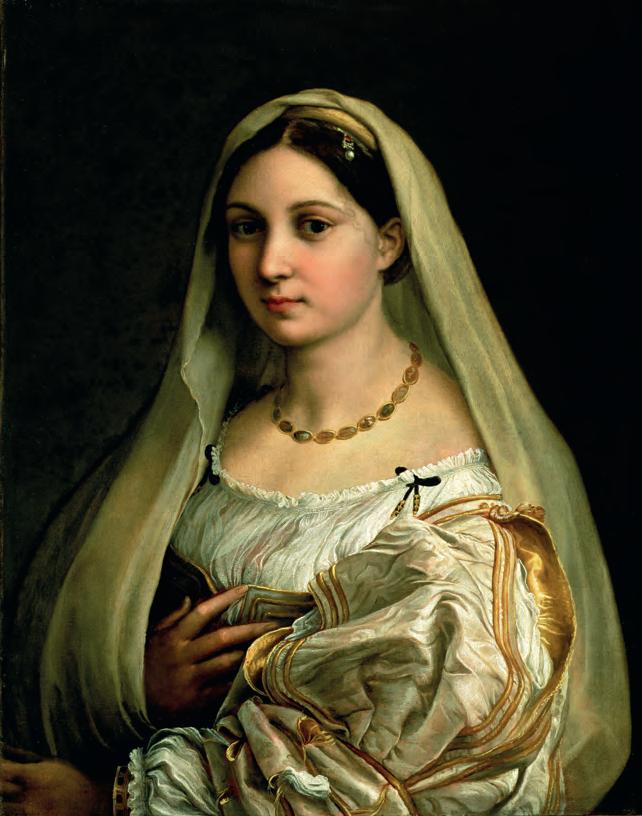
11. St Cecilia, attributed to Giovanfrancesco Penni. c.1514. Graphite, pen and ink and wash with white lead on paper, 26.8 by 16.3 cm. (Petit Palais, Musée des Beaux-Arts de la Ville de Paris).

the artist’s afterlife. Smooth in narrative, but opaque in its references, it distorts our image of the artist and in particular our understanding of his workshop, printmaking and totally of his architecture. Shearman’s compilation of the Raphael documents, the closer knowledge of the artist’s creations gained through hands-on experience during the many restorations, and the 1984 exhibition Raffaello Architetto and its catalogue,33 have laid a strong foundation for an independent reconsideration. The two great anniversary exhibitions presented their Raphaels in the opposite directions of their visitor tours, and not only in their chronological ordering: London promoted Raphael’s genius –quite explicitly – as a commercial product; Rome fostered an intellectual dialogue with an inspiring personality. Ultimately, Raphael died five hundred years ago and we are on our own; his ‘beautiful things help us by being just what they are’.
drawings, THE BURLINGTON MAGAZINE 126 (1984), pp.398–403, at p.398.
32 Landau and Parshall, op. cit. (note 21), p.131.
33 C.L. Frommel et al.: exh. cat. Raffaello Architetto, Rome (Capitoline Museums) 1984, reviewed by Caroline Elam in this Magazine, 126 (1984), pp.452 and 456–57.
the burlington magazine | 165 | january 2023 65
The man who never was – almost
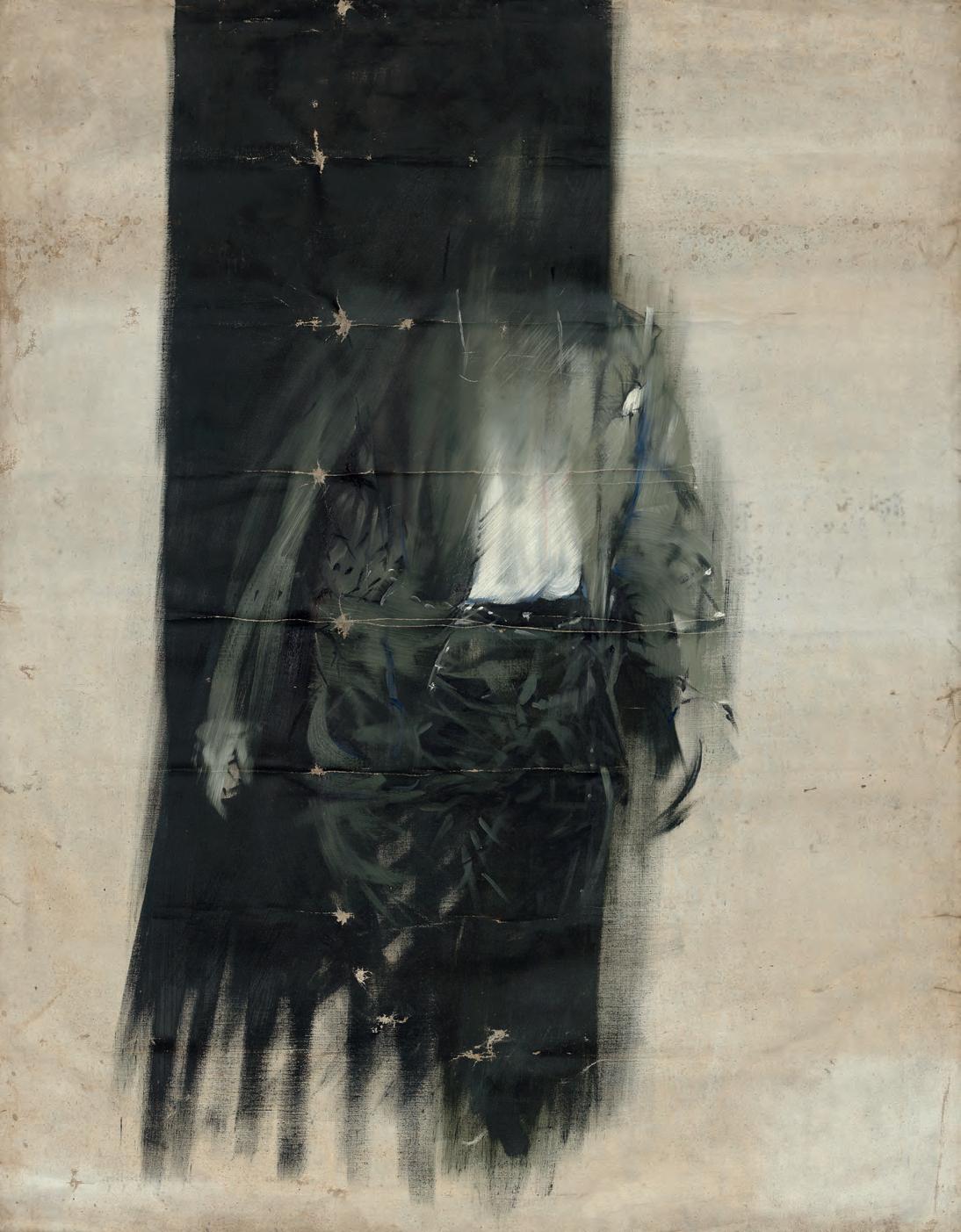
the burlington magazine | 165 | january 2023 66
Exhibitions
Denis Wirth-Miller: Landscapes and Beasts
Firstsite, Colchester
1st October 2022–22nd January 2023
by katharina günther
Curated by James Birch, this retrospective is the largest dedicated to the painter Denis Wirth-Miller (1915–2010) to date, and the first since 2011.1 Of the hundred-or-so works of art, it includes previously unseen pieces by Wirth-Miller and works by his partner, the illustrator Richard Chopping (1917–2008), and his best friend, Francis Bacon (1909–92). The show is accompanied by a richly illustrated catalogue with texts by Birch, Andrew Wilson, Rachel Joyce and the co-executor of Wirth-Miller’s and Chopping’s estates, Jon Lys Turner, who is also their biographer.2 The exhibition aims to heighten Wirth-Miller’s profile but also makes much of Wirth-Miller’s and Bacon’s private and artistic relationship.3 Unfortunately, these two emphases do not sit well together.
Wirth-Miller is best known for his atmospheric depiction of the East Anglian countryside: he skilfully captured the wind-swept trees in the vast landscape as they stoically defy the elements (Fig.2), or the rain closing in on the flat grasslands while an approaching fog softly changes the mood of the scene. He found his signature style early into his career; through his distinctive use of brushstrokes that could be wildly swirling or even and energetic, he was able to depict movement in vegetation, convey the sound and smell of rain on a country road and the touch of a fresh breeze blowing over the estuary. Instead of portraying specific places, his paintings seem to be universal cyphers,
primarily representing a sense of freedom that the artist appears to have found in the open countryside.
Before Wirth-Miller committed himself to painting in 1939, he worked as a fabric designer at the cotton manufacturing company Tootal Broadhurst Lee, Manchester.
During the 1940s he trained at the East Anglian School of Painting and Drawing run by Cedric Morris and Arthur Lett-Haines at Benton End. In his early work, Wirth-Miller experimented with Surrealism and Neo-romanticism, with portraiture, figure painting and still life. He soon focused on landscapes, and in 1944 was included in the group exhibition British Landscape Painting at the Lefevre
Opposite 1. Walking man, by Denis WirthMiller. c.1954.
Oil on canvas, 130 by 99 cm. (Estate of Denis Wirth-Miller; exh. Firstsite, Colchester).
2. Gust of wind, by Denis WirthMiller. 1970–71. Oil on canvas, 76 by 91 cm. (Estate of Denis Wirth-Miller; exh. Firstsite, Colchester).
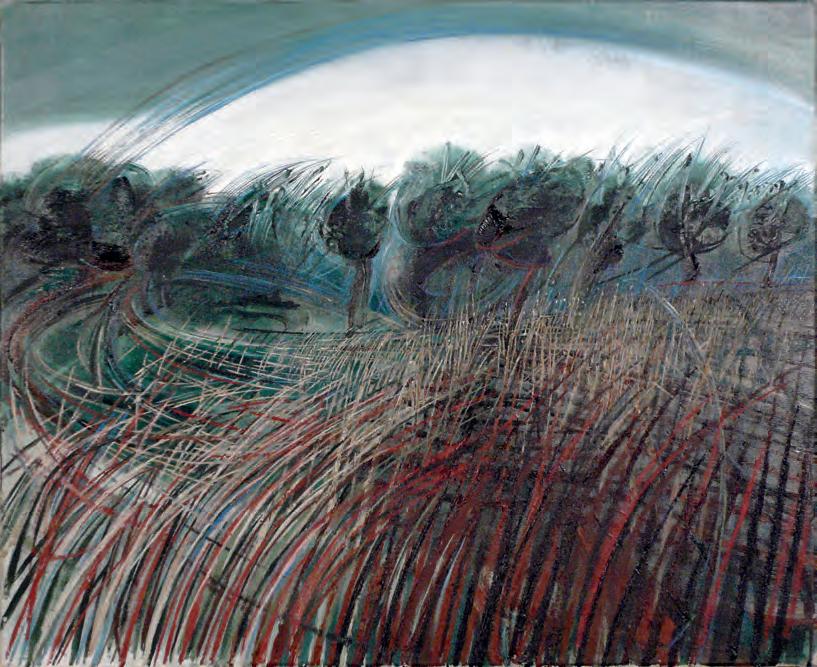
Gallery, London. He also exhibited at other prominent galleries in the city, including the Beaux Arts Gallery, and works by him were acquired by important collections, such as the Arts Council of Great Britain. Yet he never achieved a major breakthrough. WirthMiller abandoned painting in the late 1970s and faded into obscurity.
In the 1940s Wirth-Miller and Chopping bought an old sail store on the quayside of the small town of Wivenhoe, on the Colne Estuary in Essex, which was their home for the remainder of their lives. Well integrated in artistic London bohemia, the couple regularly welcomed illustrious guests, such as the Bloomsbury writer Frances Partridge, the composer Benjamin Britten, and, of course, Bacon, who was probably introduced to them by their mutual friends Robert MacBryde and Robert Colquhoun. Given its proximity to Wivenhoe and its setting within the countryside that provided WirthMiller with the enduring subjects for his paintings, Firstsite is a fitting venue for this exhibition. It is hung roughly chronologically, starting with early
the burlington magazine | 165 | january 2023 67
A comprehensive retrospective reveals the full range of Denis Wirth-Miller’s art, too long overshadowed by his friendship with Francis Bacon
Neo-romantic works and ending with what is presumed to be Wirth-Miller’s last painting, Pink sunset (1978; private collection). Although the exhibition showcases the impressive range of styles that he mastered – his later works border on abstraction and a study of ducks in motion (1969; private collection) recalls Henri Michaux – a certain repetitiveness, especially in his landscapes, is also noticeable. And yet it is a joy to encounter such a comprehensive overview of his little-known career. With many loans coming from private owners and the artist’s estate, it is hoped that some may find their way into public collections and remain on display.
The exhibition integrates two thematic foci, to each of which a separate room is dedicated. The first concerns Wirth-Miller’s dog paintings based on the nineteenthcentury photographic motion studies of Eadweard Muybridge, which he painted in 1953 and 1954. This was a subject and a source of inspiration that he shared with Bacon, who had created similar images of dogs from 1952 onwards. The works are accompanied by a number of unfinished canvases found in Wirth-
3. Dog, by Denis Wirth-Miller. 1954. Oil on canvas, 99 by 129 cm. (Estate of Francis Bacon; exh. Firstsite, Colchester).
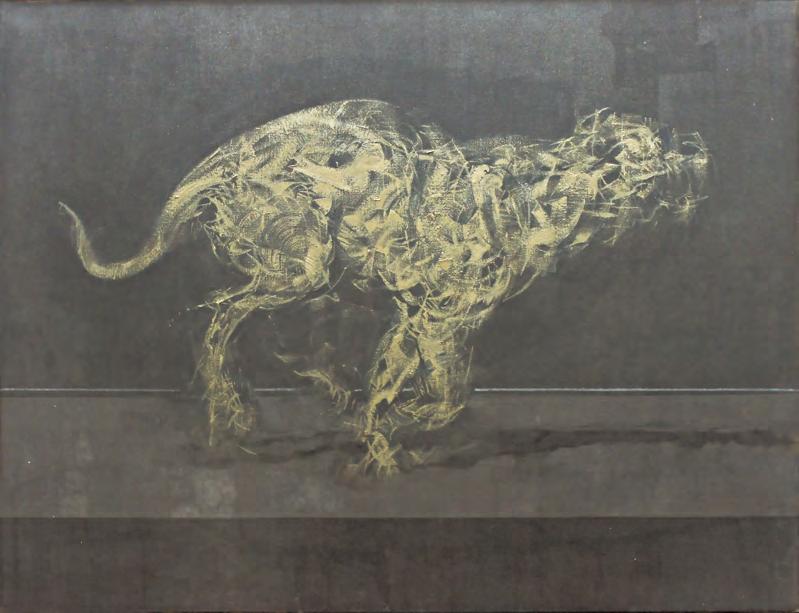
Miller’s studio after his death, as well as sketches and drawings and some of the Muybridge photographs that he used as source material. The studio contents reveal how thoroughly Wirth-Miller explored the subject and how exact and deliberate he was in his preparatory work. For example, he neatly cut out images from a Muybridge sequence and mounted them on a paper support using an elaborate cutting and slotting technique. Other unfinished canvases on display show how Wirth-Miller approached the male nude but unexpectedly also include a strong, eerie picture of a headless suited man walking out of a black void (Fig.1).
The second room focuses on Wirth-Miller’s relationship with Bacon, suggestively juxtaposing works by both. Placing Bacon’s Dog (1952; Tate) next to Wirth-Miller’s painting of the same name (Fig.3) seems an obvious choice, but the placement of Bacon’s Head VI (1949; Arts Council Collection, London) between two Wirth-Miller dog paintings, as well as the inclusion of Bacon’s Study for portrait of Van Gogh VI (1957; Arts Council Collection), would have benefited from further explanation.
A lot of room – perhaps too much – is given to Wirth-Miller’s friendship with Bacon and their alleged artistic exchange. The fact that they were friends is the first thing one learns from the exhibition wall text, and even the title seems unnecessarily close to that of Bacon’s most recent major exhibition, Francis Bacon: Man and Beast at the Royal Academy of Arts, London, in 2022.4 In addition to their notoriously fiery but long-lasting friendship, and their shared interest in dogs and Muybridge, this approach is certainly justified by the fact that Bacon regularly painted in WirthMiller’s studio in Wivenhoe, and that stylistic similarities are evident between some of Bacon’s grassland paintings from the 1950s and WirthMiller’s approach to the subject. In the catalogue Wilson declares that ‘it is recorded that a number of paintings by Bacon in the 1950s have passages painted by Denis Wirth-Miller, just as there is testimony similarly suggesting how small aspects of some of WirthMiller’s paintings from the Studies of Dogs in Movement series were painted by Bacon’ (p.18). Whereas the idea that Wirth-Miller contributed to some of Bacon’s canvases was first suggested in Bacon’s catalogue raisonné from 1964, the proposition that paintings by Wirth-Miller incorporate work by Bacon is made here for the first time.5 It is regrettable that it is not stated which paintings and which passages in them are being referred to, nor is the source of this information, or its precise wording, given. In-depth comparative analysis of specific works would have been helpful. The wall text at the entrance of the show is at odds with the catalogue since it simply (and rightly) states that there has been ‘speculation that they may have had a hand in each other’s canvases’. Ultimately, there appears to be no proof, and similarities between the artists’ works might be no more than an indication of mutual influence, or perhaps appropriation driven by admiration or competition, or simply an expression of shared interests.
The lack of evidence regarding this is indicative of a broader issue: there is little research on Wirth-Miller and on his creative exchange with
Exhibitions the burlington magazine | 165 | january 2023 68
Bacon. For example, the dates of many of his works, especially those found in the studio, are unknown. Conclusive dating of them would not only give us a better understanding of WirthMiller’s development as an artist, but could also help establish the direction of influence between him and Bacon. The same applies to Wirth-Miller’s underexplored working methods and their relationship to his iconography, exemplified by his collection of source material, consisting of books, magazines and loose pages torn from a range of such publications, some of which are included in the exhibition.
Overall, Denis Wirth-Miller: Landscapes and Beasts is a success in providing a well-deserved platform for a gifted, but largely forgotten artist. Putting such an emphasis on the relationship with Bacon, however, is a double-edged sword. Establishing any connection with the infinitely more famous, popular, expensive and critically acclaimed Bacon is guaranteed to attract attention, but risks that this attention will be directed at such aspects of Wirth-Miller’s life and art alone. Searching for parallels to Bacon distracts from studying and appreciating Wirth-Miller’s work in its own right. Due to their obvious similarities, contemporaneous criticism assessed Wirth-Miller’s dog paintings in comparison to Bacon’s, and David Sylvester criticised them as derivative and inferior in quality.6 It appears that even posthumously and as the subtitle of Turner’s biography of Wirth-Miller and Chopping – In Francis Bacon’s Shadow – suggests, there cannot be any Wirth-Miller without Bacon. In this sense, the exhibition is a missed opportunity to let Wirth-Miller step into the light.
1 Catalogue: Denis Wirth-Miller: Landscapes and Beasts. By James Birch, Andrew Wilson, Rachel Joyce and Jon Lys Turner. 120 pp. incl. 113 col. ills. (Firstsite, Colchester, 2022), £20. ISBN 978–0–948252–49–5.
2 J.L. Turner: The Visitors’ Book. In Francis Bacon’s Shadow: The Lives of Richard Chopping and Denis Wirth-Miller, London 2016.
3 See S. Shaw: ‘Foreword’, in op. cit. (note 1), pp.7–8, esp. p.7.
4 Reviewed by Rebecca Daniels in this Magazine, 164 (2022), pp.399–401.
5 R. Alley and J. Rothenstein: Francis Bacon: Catalogue Raisonné and Documentation, London 1964, pp.58–59.
6 See D. Sylvester: ‘Round the London galleries’, The Listener (17th May 1956), p.648.
Vor Dürer: Kupferstich wird Kunst Städel Museum, Frankfurt 28th September 2022–22nd January 2023
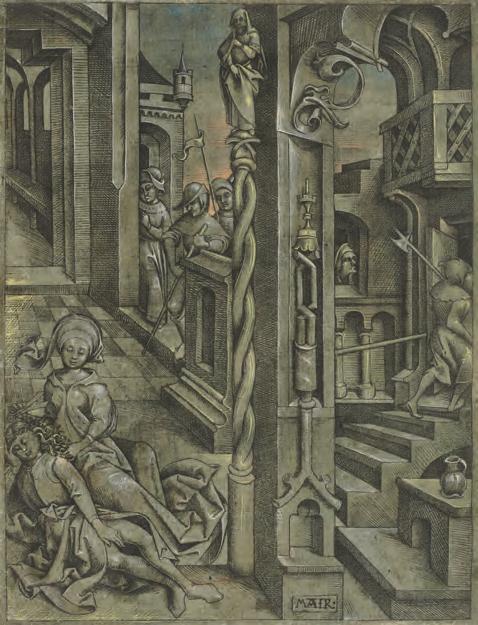 by armin kunz
by armin kunz
‘The Städel’s rich holdings can hardly be counted among the smaller collections’, emphasised Max Lehrs in his survey of fifteenth-century German and Netherlandish prints in smaller collections, which was published in forty-two instalments in the Repertorium für Kunstwissenschaft between 1888 and 1894.1 Given that the Städel Museum, Frankfurt, founded as the Städelsches Kunstinstitut in 1815 and one of the few private museums in Germany, easily counts among the country’s best and most respected in terms of both the quality and range of its collections, it is surprising that Lehrs included the Städel in his survey. Yet Lehrs was focusing on works of which few museums can claim large holdings. In fact, early prints were already rare and sought after during the lifetime of Albrecht Dürer (1471–1528), whose graphic œuvre marked the end of the first century of this new artistic medium. More than 130 years after Lehrs’s publication, the exhibition under review presents 120 prints (and one drawing) from this period, a little less than half of the Städel’s total of 260 early Northern engravings. It has been judiciously organised by Martin Sonnabend, the recently retired curator and head of the Städel’s graphic collection up to 1750.
On entering the exhibition, the visitor first encounters Dürer’s engraving Adam and Eve (the Fall of Man) (1504; cat. no.121). It is presented here as the culmination of the development referred to in the exhibition’s subtitle: how the new technique of repeatedly impressing inked-up images engraved on copper plates onto sheets of paper became perfected and was ultimately recognised as an art form. In the sections that follow Sonnabend presents his material along a more or less chronological timeline, beginning with the earliest work on show, a
depiction of St Wolfgang made by an anonymous printmaker c.1440–60 (no.1). Although the image appears to have been printed from a highly worn plate, its somewhat faint lines suggest that it was in fact produced without the use of a press, which may have been typical of the earliest printed images. Gold- and silversmiths, in whose workshop the technique originated, quickly learned to employ roller presses, to engrave the lines sufficiently deeply and to prepare inks with the right balance of fluidity and tackiness to sit sharply on the paper’s surface and not dissolve along the edge of the line.
In the exhibition, eleven prints by Master ES (active c.1440/50–c.1467; nos.8–18) represent this next phase. It remains unclear whether the letters ‘E’ or ‘ES’, which appear on eighteen of the plates attributed to the same hand on stylistic grounds, refer to the name of the maker in the same way that the monograms ‘MS’ and ‘AD’ later did in the case of Martin Schongauer (c.1445–91) and Dürer. The identity of Master ES, who was active in the Upper Rhine region, remains therefore enigmatic yet his oeuvre comprises nearly 320 prints,
4. Samson and Delilah, by Mair von Landshut. c.1500. Engraving with heightening in various colours on prepared paper, 22.8 by 27.1 cm. (Städel Museum, Frankfurt).
Exhibitions the burlington magazine | 165 | january 2023 69
the burlington magazine | 165 | january 2023 70
which suggests that engraving must have already been an important if not the main element of his artistic practice. Among them are devotional prints, such as the three depicting the Engelweihe, the mystical consecration of the abbey church of Einsiedeln by Christ and the angels in 948 (the Städel owns one of them, the so-called Small Madonna of Einsiedeln from 1466; no.15). When, in 1466, Pope Paul II granted the Benedictine monastery a general indulgence, these engravings could be offered to pilgrims on their way to the Benedictine monastery on the occasion of the annual feast day of the event. Master ES also produced playing cards and prints illustrating motifs to be used in artists’ workshops. Heavy use of inherently fragile paper inevitably often led to the deterioration and discarding of such sheets. As a result, nearly half of this prolific master’s works survive in only one or two impressions, often by accident, in most cases by having been pasted into books.

Given the poor survival rates of early prints, the Städel’s holdings are surprisingly comprehensive. They provide a fairly representative overview of the history of early intaglio printmaking and boast many outstanding impressions and rarities. It was in large part thanks to Johann David Passavant (1787–1861), the curator of the Städel from 1840 until his death, that the collection was ‘systematically augmented according to the available means’2 during the nineteenth century. Coincidentally, the period of growth in this field came to an end at the time Lehrs published his catalogue of the Städel’s holdings in 1891. Sonnabend references merely four noteworthy acquisitions in the twentieth century, with the two most recent ones a gift from 2000, St Margaret by Master BR (no.71), known in only three impressions, and a purchase from 2008, a unique impression of St Catherine reading by Master WAH (no.64).
A good example of the high quality of the collection is Mair von Landshut’s engraving Samson and Delilah (no.78; Fig.4), printed on a sheet of prepared, greenish-grey paper and carefully highlighted with pen
and brush in white, yellow, orange and blue. Of the six surviving impressions of this print, five are embellished in a similar fashion, emulating drawings on coloured paper, which were much sought after by early collectors. None of the other impressions, however, shows the same delicacy in handling as the Städel’s sheet. Equally rare is the Judgment of Solomon by Master BM (no.59; Fig.6). Its size, 29.4 by 42.1 centimetres, is astonishingly large for the period, equalling Christ carrying the cross (no.25) by Schongauer, to whom it is also indebted stylistically. Schongauer’s print is remarkable for its compositional complexity, which is particularly evident in the way that the densely populated scene is embedded into a panoramic landscape. Master BM’s engraving, on the other hand, is characterised by a monumentality of the individual figures that is unrivalled among early northern European prints. A drawing of similar size in the Graphische Sammlungen der Klassik Stiftung Weimar shows the composition in reverse. Attributed to Schongauer in the nineteenth century, it is now considered to be a copy after a lost work by the master.
This relationship between drawing and print raises the more general question of how individual motifs were transmitted. In the carefully researched catalogue, which includes extensive, footnoted entries summarising the relevant scholarship for each print, Sonnabend discusses this and many other overlooked aspects.3 Whereas the exhibition presents a history of the medium in its first century, the catalogue complements this narrative with an account of the historiography. Sonnabend rightly challenges the paradigm of the artist as genius that underlies modern art history, including the study of early prints. In particular, he questions the traditional distinction between ‘masters’ and ‘monogrammists’; the former are credited with the ability to innovate whereas the latter are considered mere copiers. Thus, Master BM, who created the impressive Judgment of Solomon, was relegated to the rank of a ‘monogrammist’. Sonnabend
Opposite
5. A bishop’s crozier, by Israhel van Meckenem. c.1485–95. Engraving, 78.8 by 23 cm. (Städel Museum, Frankfurt).
6. Judgement of Solomon, by Master BM. c.1480–1500. Engraving, 29.4 by 42.1 cm. (Städel Museum, Frankfurt).

argues that this distinction is flawed since the use of models and templates was always an essential element of late-medieval workshop practice. Although reconstructing the transmission of motifs is unquestionably important, it is also necessary to look into the ways such appropriations are used by artists and to define the innovative elements that can be found within every process of copying. This allows a re-evaluation of the technical bravura of works that have too often been relegated to the merely imitative or reproductive.
Accordingly, throughout the exhibition and catalogue all artists are described as ‘masters’. Furthermore, equal space is given to Martin Schongauer and Israhel van Meckenem (c.1440/45–1503), whom Lehrs had considered as a ‘meagre copyist’.4 The prints by these two artists occupy corresponding sections on each side of the main gallery space. Visitors can thus examine the ways in which Van Meckenem adopted Schongauer’s motifs and, in many cases, attempted to outdo his rival. Schongauer’s depiction of the top of a bishop’s crozier, for example, measures 28.6 by 12.8 centimetres (no.57). In Van Meckenem’s version, the subject has been expanded and turned into an example of elaborate
micro-architecture, printed from two plates on two sheets, so that its overall height amounts to 78.8 centimetres (no.101; Fig.5). Van Meckenem also adopted the composition of Schongauer’s Large Crucifixion (cat. fig.66), but set the scene against a dark background, created by an elaborately engraved web of dense crosshatching (no.86). As Sonnabend argues in the catalogue, this demonstrates the technical prowess of Van Meckenem, who was able to create subtle values within the picture plane that appear painterly but nonetheless never deny the metallic character of their engraved source. Towards the end of the exhibition, one is reminded of the important transitional role occupied by Van Meckenem, who emulated the creations of his contemporaries as well as of earlier masters, but also lived long enough to take note of the work of Dürer, who was a generation younger. When copying Dürer’s mysterious print Four nude women (1496; no.117), Van Meckenem showed off his mastery of the burin by rendering subtle passages of shading that are notably different from Dürer’s more linear handling of forms (cat. fig.84); and whereas Dürer thought it sufficient to inscribe his trademark monogram on the print, Van Meckenem signed the plate
prominently below the image with his name and origin – ‘Israhel V.M. tzu boeckholt’ (‘Israhel van Meckenem from Bocholt’) – thereby proudly and confidently advertising his authorship.
Having opened the exhibition with Dürer’s Adam and Eve, Sonnabend closes it with further examples of Dürer’s printmaking up to 1504. The new technique of creating and multiplying images fixed on sheets of paper had now established itself as an autonomous artistic medium. This new art form could be used for the recording of motifs, patterns and pictorial inventions in model books, a task for which drawing had previously been used. Drawing was thus slowly liberated and could be used to capture ideas and to play freely with the possibilities offered by the light touch of the pen on paper – as demonstrated by the delicacy of the linework in the sole drawing that Sonnabend could clearly not resist including. Woman holding a flowery branch (c.1470–80; cat. fig.8) is a pen and ink drawing that has often been attributed to Master ES but is described here more cautiously as the work of an anonymous artist from the Upper Rhine valley. Exploring this process of emancipation further, however, would have needed to be the subject of another exhibition.5
1 M. Lehrs: ‘Der deutsche und niederländische Kupferstich des fünfzehnten Jahrhunderts in den kleineren Sammlungen’, Repertorium für Kunstwissenschaft 14 (1891), pp.384–409, at p.384 (emphasis in the original); Lehrs incorporated this survey into his fundamental Geschichte und kritischer Katalog des deutschen, niederländischen und französischen Kupferstichs im XV. Jahrhundert, Vienna 1908–34.
2 Lehrs 1891, op. cit. (note 10), p.384.
3 Catalogue: Vor Dürer. Kupferstich wird Kunst: Deutsche und niederländische Kupferstiche des 15. Jahrhunderts aus der Graphischen Sammlung des Städel Museums. By Martin Sonnabend. 312 pp. incl. 221 col. ills. (Sandstein Verlag, Dresden, 2022), €49.90. ISBN 978–3–95498–707–8.
4 M. Lehrs: Der Meister mit den Bandrollen: Ein Beitrag zur Geschichte des ältesten Kupferstiches in Deutschland, Dresden 1886, p.31.
5 For the Städel’s collection, this was examined by S. Buck: exh. cat. Wendepunkte deutscher Zeichenkunst: Spätgotik und Renaissance im Städel, Frankfurt 2003–04. Still useful as a concise general overview of the development of drawings from model sheet to free sketch is U. Jenni: ‘Vom mittelalterlichen Musterbuch zum Skizzenbuch der Neuzeit’, in A. Legner, ed.: exh. cat. Die Parler und der schöne Stil 1350–1400: europäische Kunst unter den Luxemburgern. Ein Handbuch zur Ausstellung des Schnütgen-Museums in der Kunsthalle Köln, Cologne (Museen der Stadt Köln) 1978, III, pp.139–41.
Exhibitions the burlington magazine | 165 | january 2023 71
Pisanello: Il Tumulto del Mondo Palazzo Ducale, Mantua 7th October 2022–8th January 2023
by samuel dawson
At a press conference on 26th February 1969, Giovanni Paccagnini, the Superintendent of Fine Arts of Mantua, announced a discovery of some magnitude. Beneath several layers of plaster in a room on the piano nobile of the ducal palace, Paccagnini had revealed the remains of a vast Arthurian mural cycle by the celebrated fifteenth-century artist Antonio di Pucci, better known as Pisanello (c.1394–c.1455). The discovery was remarkable for several reasons. A major work, covering over three hundred square metres, the cycle is one of only three surviving murals by Pisanello. The other two, both in Verona, are an Annunciation (c.1426) flanking the upper parts of the Brenzoni monument in S. Fermo Maggiore and St George and the princess (c.1436) in the Pellegrini chapel of S. Anastasia. The Mantua fresco cycle is the only extant example of a work designed for a court setting by the artist, who was regarded by his contemporaries as the principal court artist of his time. Given the significance of the find, it
was understandable that Paccagnini believed that Pisanello’s chivalric cycle was ‘destined to become [. . .] a new focus of cultural interest for Palazzo Ducale, no less important than the well-known Camera degli Sposi by Mantegna’.1
The frescos, which occupy the four walls of the rectangular Sala del Pisanello, as the hall was already called in an early document, were unveiled in the exhibition Pisanello alla corte dei Gonzaga, organised by Paccagnini in 1972.2 Fifty years later the present exhibition at Palazzo Ducale pays tribute to Paccagnini’s achievement while conceding that Pisanello’s cycle has not quite achieved the status and aroused the public interest that he anticipated. As the director and lead exhibition curator, Stefano L’Occaso, laments in the introduction to the catalogue, ‘if not invited by a guide, visitors tended to pass by [Pisanello’s] paintings, content with a distracted glance at the works, which were distant [from the viewer] and difficult to understand’ (p.7).3 Several factors contributed to this lack of popular appeal. The subject of the cycle is obscure, drawn from a marginal episode in the Lancelot du Lac, and the cycle is unfinished, since Pisanello abandoned the work midway through painting it, leaving for some sections
7. Sala del Pisanello, Palazzo Ducale, Mantua. (Courtesy Palazzo Ducale, Mantua; photograph Vincenzo Bruno).
only the sinopie completed. This has resulted in a stylistic unevenness that is exacerbated by the extensive damage suffered by the paintings. For example, it is hard to comprehend the narrative of the fragment of the great tournament scene on the southeast wall (Fig.7). It combines parts painted in buon fresco and parts a secco, as well as sections in glazed metal leaf and in pastiglia and areas moulded in relief for the insertion of precious jewels (petre contrafacte). In contrast, on the adjacent northeast wall, a highly detailed ‘quasi-sinopia’ in red chalk is likely to have been conceived as a temporary substitute rather than a cursory preparatory sketch that was intended to be finished later.
During a renovation in 2022 of the Sala del Pisanello the height of the floor was raised by over a metre, so that it is now at the level of the fifteenth century floor, and new lighting was installed. As L’Occaso explains in his informative catalogue essay on the room’s original architectural layout, this approach is not only historically accurate but also intended to create an immersive experience. By reducing the distance between the spectator and the mural cycle, visitors can examine the frescos in greater detail and, simultaneously, project themselves into the painting and onto the tournament field. It is now possible, for instance, to observe the artist’s ingenuity in painting one part of a tournament knight on the

WHAT’S ON Our online Calendar is the best guide to exhibitions around the world.
VISIT burlington.org.uk/whats-on

Exhibitions the burlington magazine | 165 | january 2023 72
southeast wall and the other part on the northeast wall.
The display in the hall contains a screen with a digital presentation of the paintings, which visitors can use to navigate and magnify the images, as well as a judicious selection of Pisanello’s drawings and medals. Like the digital images, these smaller works encourage close inspection, which reveals numerous affinities between the loans and the murals; for instance, in terms of its physical and emotive qualities, as revealed in the subject’s downcast eyes, the graceful Woman’s head in profile (cat. no.II; Fig.8), a fragment of a wall painting, can be compared to the portrait of the princess in the fresco on the northeast wall. A detailed study of Gothic crenelated battlements and towers in brown ink (c.1435; Musée du Louvre, Paris, RF519 verso) and the elaborate redchalk castles on the northeast wall demonstrate Pisanello’s interest in architectural details. An exquisite drawing of an Estense knight as falconer (c.1440; Fondation Custodia, Paris; no.XII), wearing an extravagant broad-brimmed headdress, closely compares in his posture and attire to a male figure in the tournament sinopia that has been removed from the wall and is exhibited in the adjacent Sala dei Papi (no.III). The figure has sometimes been identified with Gianfrancesco I Gonzaga (1395–1444), Marquess of Mantua and the patron of the work. In an example of what Andrea de Marchi describes as Pisanello’s ‘irregular wit’ (p.60), the artist contrasts the elegant and dignified bearing of this figure with a diminutive knight also wearing ornate headgear, who charges into the uproar in the lower half of the tournament fresco.
These skilfully curated connections help to answer some of the scholarly questions concerning the dating and unfinished state of the cycle. As Andrea de Marchi argues in the catalogue, the woman’s head in profile may be a fragment from Pisanello’s lost fresco cycle in the Lateran, Rome, which supports the dating of the Mantuan paintings to shortly after Pisanello’s return from
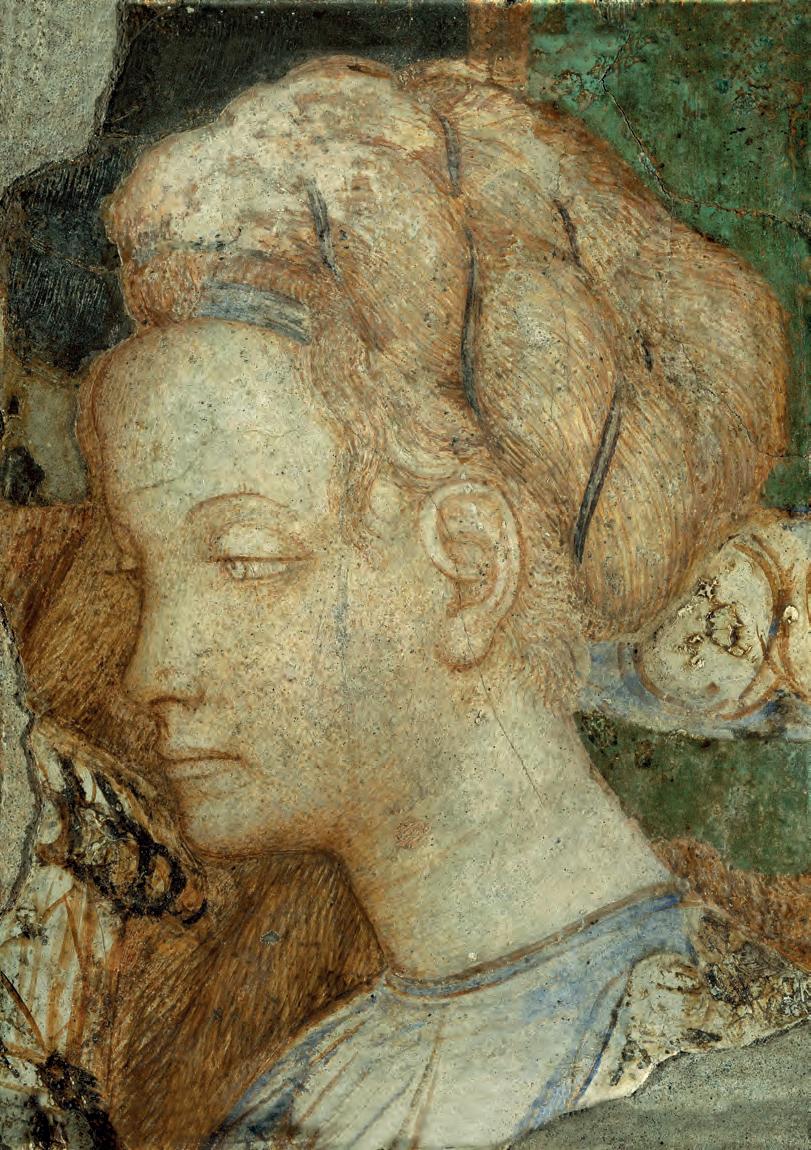
Rome in 1431.4 The meticulously drawn profile-portrait of Emperor Sigismund of Luxemburg (1432–33; Louvre; no.IX) contains the artist’s precise notes on the colouration of the subject’s beard and eyes. The drawing provides a reminder of the emperor’s visit to Mantua in 1433 to confer the marquisate on the house of Gonzaga. As Michela Zurla argues,
8. Woman’s head in profile, by Pisanello. 1430–35. Detached wall painting, 24 by 17 cm. (VIVE – Vittoriano e Palazzo Venezia, Rome; exh. Palazzo Ducale, Mantua).
the deadline set by the esteemed guest’s arrival at the Gonzaga court might explain why Pisanello terminated (or rushed to finish) the painting in the court apartments.
By bringing the Mantuan cycle and Pisanello’s graphic work together, the exhibition also raises the question how the court artist’s frescos might have been viewed by his princely
Exhibitions the burlington magazine | 165 | january 2023 73
9. Detail from Tournament of knights, by Pisanello. 1430–33. Fresco. (Palazzo Ducale, Mantua).

patrons and their humanist advisers in the early fifteenth century. As Michael Baxandall argued in the years the paintings in the Palazzo Ducale were being uncovered, the ‘relative importance of drawing and fresco’ within Pisanello’s œuvre could be seen to be ‘reversed [so] that the role of the fresco included that of reproduction, for a mass audience and in a coarser medium, of a selection of popular themes from his work –Highlights from Pisanello’. Fresco was
a convenient medium in which to showcase the ‘distinctive quality and range of Pisanello’s performance’ as an artist.5 His skills, so evident in his drawings and in his later production as a medallist, could thus be transferred to a large scale. Why else might Pisanello have been set (or set himself) the virtually impossible task of completing the vast commission ‘free hand’, without using a sinopia as a guide, as though it were a grand exercise in panel painting? Bravura
pieces, such as the knight who gazes out at us from the medieval tourney (Fig.9), were designed for recognition.
The exhibition includes rooms on the piano terra of the palace dedicated to the arts in Mantua in the early fifteenth century, which seek to contextualise Pisanello’s creation. They include such important loans as the Virgin and Child with saints Anthony Abbot and George (c.1440; National Gallery, London; no.III) but they lead the visitor away, both physically and conceptionally, from the exhibition’s main focus. Given the close relationship between Pisanello’s mural and panel painting, it would have been better to have placed the panels alongside the drawings and medals in the Sala dei Pisanello. This does not detract from the success of the exhibition. Il Tumulto del Mondo goes some way to fulfil the wishes of Paccagnini, so that future visitors to Palazzo Ducale now have a reason to linger over Pisanello’s great cycle.
1 G. Paccagnini: exh. cat. Pisanello alla corte dei Gonzaga, Mantua (Palazzo Ducale) 1972, p.5.
2 Reviewed by Maria Fossi Todorow in this Magazine, 114 (1972), pp.886, 888 and 891.
3 Catalogue: Pisanello: Il Tumulto del Mondo Edited by Stefano L’Occaso. 176 pages incl. 160 col. + 28 b. & w. ills. (Electa, Milan and Rome, 2022), €30. ISBN 978–88–928–2318–1.
4 See also A. de Marchi: ‘Reconsidering the traces of Gentile da Fabriano and Pisanello in the Lateran Basilica’, in L. Bosman, I.P. Haynes and P. Liverani, eds: The Basilica of Saint John Lateran to 1600, Cambridge 2020, pp.379–99.
5 M. Baxandall: ‘Guarino, Pisanello and Manuel Chrysoloras’, Journal of the Warburg and Courtauld Institutes 28 (1965), pp.183–204, at p.194.
The Tudors: Art and Majesty in Renaissance England Metropolitan Museum of Art, New York
10th October 2022–8th January 2023
by elizabeth goldring
This landmark exhibition, the first in the United States to be devoted to the art of the Tudor courts, begins with a bang. The first objects encountered upon entering the installation are three monumental bronze sculptures: two angels bearing candlesticks (cat. no.16; Fig.10), plus a candelabrumcum-pillar set on a marble base,
Exhibitions
74
the burlington magazine | 165 | january 2023
the shaft of which features Tudor roses, among other decorative motifs (1529–40; St Bavo’s Cathedral, Ghent; no.17). Designed and cast in London by the Florentine Benedetto da Rovezzano, these pieces are among the nine surviving elements of a magni cent, but never completed, tomb for Henry VIII: a commission that originated with, and initially was conceived as a funerary monument for, Cardinal Thomas Wolsey (who, prior to his fall from royal favour in 1529, was arguably the Tudor court’s greatest patron of the arts). Rather thrillingly, these three sculptures are here reunited for the rst time since the early seventeenth century.
The exhibition concludes no less dramatically by bringing together, in one room, four of the most celebrated portraits of Elizabeth I: the Darnley,
executed by an unknown painter (c.1575; National Portrait Gallery, London; no.113); the Ditchley (c.1592; National Portrait Gallery; no.119) and the Rainbow (c.1602; Hat eld House, Hertfordshire; no.120), both attributed to Marcus Gheeraerts the Younger; and the Hardwick, attributed to the workshop of Nicholas Hilliard (c 1599; Hardwick Hall, Derbyshire; no.118). By standing in the right position, viewers can take in all four simultaneously. Regular visitors to the National Portrait Gallery will have grown accustomed over the years to seeing the Darnley and the Ditchley portraits displayed near one another. But it is a rare treat to see four of the most signi cant life-size paintings of the Virgin Queen in a single space, with two more – the Hampden, executed by an unknown
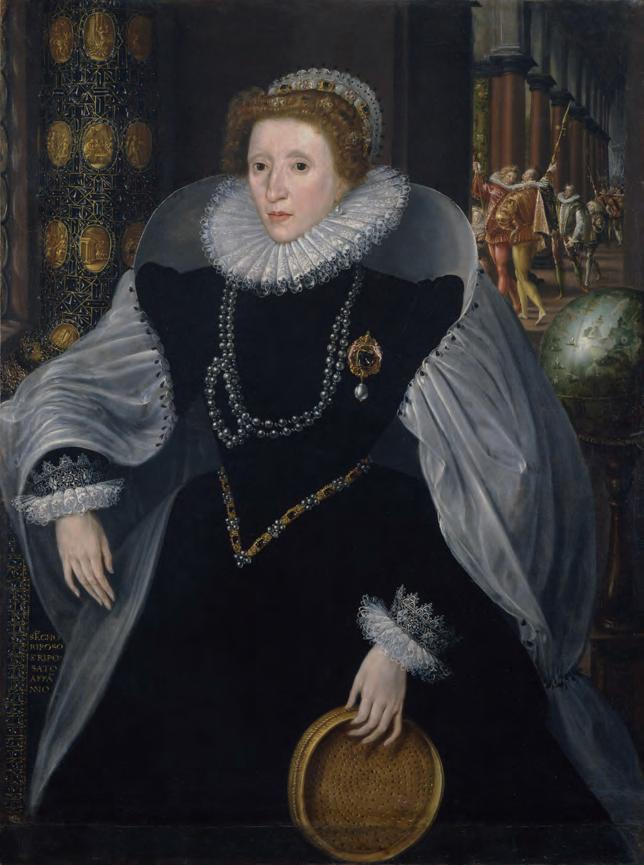
painter in c.1567 (private collection; no.30) and the Sieve, painted by Quentin Metsys the Younger in 1583 (no.114; Fig.11) – hanging just around the corner in an adjacent room. Originally scheduled for 2020, to mark the 500th anniversary of the Field of Cloth of Gold, the opening of this exhibition was delayed by two years because of the COVID-19 pandemic. The Metropolitan Museum’s generously proportioned, high-ceilinged exhibition space gives the displays, and their viewers, room to breathe. The ve galleries are organised thematically into such sections as ‘Inventing a Dynasty’, ‘Splendor’, ‘Public and Private Faces’ and ‘Languages of Ornament’.
Portrait painting, which ourished in England in the wake of Henry VIII’s break with Rome, and its development, at both his court and those of his successors, is vividly illustrated by a dazzling line-up of loans from around the world, including Hans Holbein the Younger’s only surviving autograph painting of Henry VIII (no.9; Fig.12). Among the numerous other oil paintings by Holbein are portraits of Thomas More looking resplendent in his court nery (1527; Frick Collection, New York; no.80); of Robert Cheseman holding a gyrfalcon
10. Angel bearing a candlestick
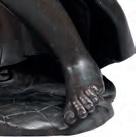


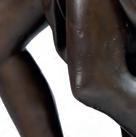

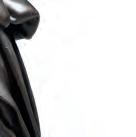
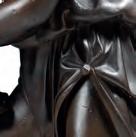
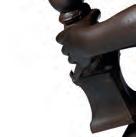


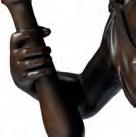



a pair), by Benedetto da Rovezzano. 1524–29. Bronze, 101 by 50 by 33 cm. (Victoria and Albert Museum, London; exh. Metropolitan Museum of Art, New York).
11. Elizabeth I (Sieve Portrait), by Quentin Metsys the Younger. 1583. Oil on canvas, 124.5 by 91.5 cm. (Pinacoteca Nazionale, Siena; exh. Metropolitan Museum of Art, New York).

Exhibitions THE BURLINGTON MAGAZINE | 165 | JANUARY 2023 75
(one of
(1533; Mauritshuis, The Hague; no.81); and of the future Edward VI holding a rattle in place of a sceptre (1538; National Gallery of Art, Washington; no.51). Two miniatures of Henry VIII by Lucas Horenbout (c 1525–27; Fitzwilliam Museum, Cambridge, no.77; and c 1526–27; Royal Collection; no.78) date from the period when the portrait miniature sprang free of the manuscript page, suddenly emerging as an independent art form. A life-size, full-length painting of Henry VIII by Holbein’s workshop (c 1540, Walker Art Gallery, Liverpool; no.11) was executed with recourse to Holbein’s now-lost Whitehall mural (1537). Hans Eworth’s painting of Mary I, painted in 1554, just a few months after she ascended the throne (Society of Antiquaries, London; no.26) was highly influential and much imitated; it was the image upon which most subsequent likenesses of Mary were based.
Nicholas Hilliard’s innovative cabinet miniatures of Anthony Mildmay (c 1590–93; Cleveland Museum of Art; no.74) and Henry Percy, Earl of Northumberland (c 1590–95;
12. Henry VIII, by Hans Holbein the Younger. c.1537. Oil on panel, 28 by 20 cm. (Museo Nacional ThyssenBornemisza, Madrid; exh. Metropolitan Museum of Art, New York).
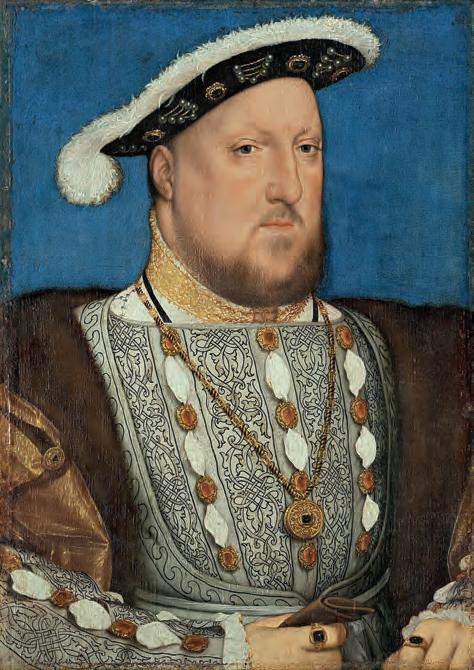
Rijksmuseum, Amsterdam; no.110), appropriated, on a small scale, many of the props and settings traditionally associated with paintings ‘in great’.
But The Tudors is emphatically not just an exhibition of portrait painting. A variety of objects, produced in different media and during different reigns, are freely intermingled. There are terracotta sculptures, ranging from figures of saints produced by the otherwise obscure Thomas the Dutchman for Henry VII’s tomb (Victoria and Albert Museum, London; no.8) to the celebrated portrait bust of John Fisher, the bishop of Rochester (c 1510–15; Metropolitan Museum; no.76) by the Florentine Pietro Torrigiano. There is Chinese porcelain from Burghley House, Lincolnshire, acquired by the Cecil family in the late sixteenth century and now in the Metropolitan Museum’s permanent collection. There are suits of armour commissioned by and for Henry VIII, also drawn from the museum’s rich holdings. There are manuscripts, including a list of the lavish gifts Elizabeth I and her courtiers exchanged at New Year 1585, written on a roll of vellum which, if fully unfurled, would stretch to nearly eleven feet (Folger Shakespeare Library, Washington; no.2). The selection of printed books includes the Coverdale Bible (1535; British Library, London; no.20), shown opened on its Holbein-designed frontispiece, in which Henry VIII is depicted enthroned, handing the bible to a group of kneeling bishops. In addition – although this is by no means an exhaustive list – the museum’s installation includes tapestries; table carpets; gold and silver plate; stained-glass windows; medals; jewels; furniture; clothing; needlework; and numerous works on paper, many of them by Holbein, including designs for plate, jewellery and architectural ornaments as well as for painted portraits. In short, The Tudors offers an embarras de richesses Indeed, it is difficult to imagine how the many and varied textures and materials of Tudor court life could be conjured more effectively in a museum setting.
Given that the organisational principle is not chronological but thematic, it is perhaps a shame that signage is sparse. Visitors who are hazy on their Tudor history may find themselves wishing that the museum had provided more, and more detailed, wall texts and object labels. Help is at hand, however, in the form of the exhibition catalogue, which contains encyclopaedic entries for each object displayed, plus extensive end notes and a bibliography that runs to nearly twenty-five pages.1 In addition, the catalogue features several contextualising essays by Elizabeth Cleland and Adam Eaker, the exhibition curators, which draw out themes such as the ebb and flow of art and artists between England and the Continent in relation to changes in the religious and political landscape. Two concluding essays, by Marjorie E. Wieseman and Sarah Bochicchio, consider the afterlife of the Tudors. Painstakingly researched and beautifully illustrated, this catalogue will be of interest to general readers as well as serving as an essential point of reference for scholars.
The precise composition and disposition of this exhibition will change when it travels on to Cleveland and San Francisco in the course of 2023.2 Visitors to Cleveland, for example, will not be able to see all the high-profile portrait loans displayed in New York. But, unlike visitors to the Metropolitan Museum, they will have the opportunity to view Holbein’s preliminary drawing of Jane Seymour (1536–37; Royal Collection; no.84) alongside his finished painting of her (1536–37; Kunsthistorisches Museum, Vienna; no.85): a tantalising prospect and, for most, a once-in-a-lifetime opportunity.
1 Catalogue: The Tudors: Art and Majesty in Renaissance England. By Elizabeth Cleland and Adam Eaker, with contributions by Marjorie E. Wieseman and Sarah Bochicchio. 352 pp. incl. 300 col. ills. (Metropolitan Museum of Art, New York, 2022), $65. ISBN 978–1–58839–692–1.
2 The exhibition will travel to the Cleveland Museum of Art (26th February–14th May 2023) and the Legion of Honor, Fine Arts Museums of San Francisco (FAMSF) (24th June–24th September 2023).
Exhibitions the burlington magazine | 165 | january 2023 76
Der Maler als Zeichner – der Zeichner als Maler: 300 Jahre Johann Heinrich Tischbein d. Ä. Schloss Wilhelmshöhe, Kassel 28th October 2022–5th February 2023
by heidrun ludwig
This winter three museums in the German state of Hesse are presenting substantial exhibitions that focus on outstanding Baroque painters. The ‘divine’ Guido Reni is on show at the Städel Museum, Frankfurt; the Hessisches Landesmuseum Darmstadt is celebrating the 300th anniversary of Bernardo Bellotto with a major exhibition of the artist’s drawings; and Schloss Wilhelmshöhe – part of the Museumslandschaft Hessen Kassel (MHK), an institution that represents the state’s museums, palaces, castles and parks – has mounted a rewarding and intelligent display of works by Johann Heinrich Tischbein the Elder (1722–89), who was born in the same year as Bellotto.1 Earlier this year, Tischbein’s anniversary was marked with an exhibition of his portraits and landscapes at Museum Schloss Fasanerie, Eichenzell, where visitors could also admire the monumental cycle of paintings depicting a heron chase (c.1766), which the artist created for Schloss Wabern, near Fritzlar, and which is today on permanent display at Schloss Fasanerie.2
Whereas the Schloss Fasanerie exhibition had a scholarly catalogue, the exhibition under review is accompanied only by a booklet aimed at a broad audience.3 To deepen one’s knowledge of the exhibits, visitors have to consult the general Tischbein literature, the MHK’s collection database and the catalogue of the Kulturstiftung des Hauses Hessen.4 This reviewer would have welcomed an in-depth catalogue.
For the exhibition in Schloss Wilhelmshöhe, the curators, Justus Lange and Malena Rotter, have focused on the interplay between drawings, oil sketches and painting in Tischbein’s work. Installed in a large room that has been divided into four sections, the show opens appropriately with an early self-portrait (Fig.13),
from c.1752–55, shortly before or at the beginning of his career as the court painter to Wilhelm VIII of Hesse-Kassel (1682–1760), a passionate collector of art. Tischbein was a member of a large family of artists, of whom the best known is his nephew Johann Heinrich Wilhelm Tischbein (1751–1829), famous for his portrait of Goethe in the Roman Campagna (1787; Städel Museum, Frankfurt). Holding a pen in his hand and a portfolio of drawings on his knees, Tischbein depicts himself sitting in front of an easel on which a sketch for a history painting is visible. Inspired by Maurice Quentin de la Tour’s
pastel portrait of Jean Restout the Younger (1746; Musée du Louvre, Paris), his admission piece to the Académie de peinture et de sculpture, Paris, the self-portrait demonstrates the influences on Tischbein when he was studying in Paris with Carle Vanloo in 1743–48 and in Venice with Giovanni Battista Piazzetta in 1748–51. Tischbein owed the Parisian court painter insights into portraiture, evident in particular in his mastery of the depiction of textiles and ability to lend an imposing presence to his sitters, which impressed even the landgrave. In Venice he had come to appreciate the importance of
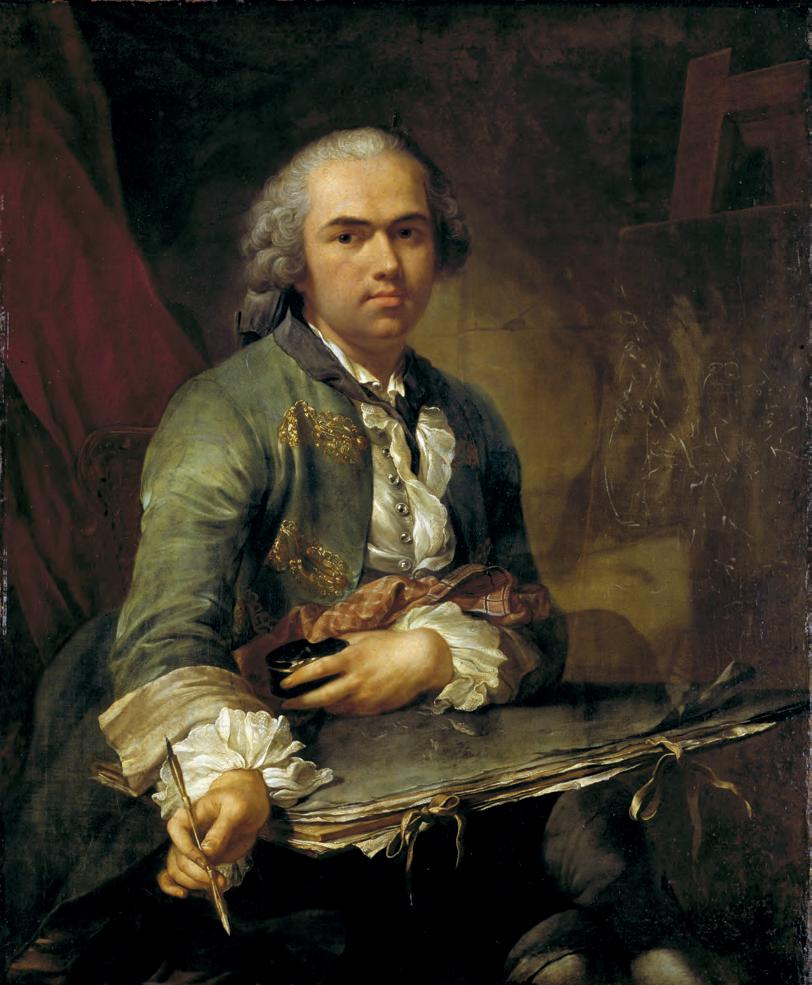
Exhibitions the burlington magazine | 165 | january 2023 77
13. Self-portrait, by Johann Heinrich Tischbein the Elder. c.1752–55. Oil on canvas, 97.5 by 79.3 cm. (Schloss Wilhelmshöhe, Museumslandschaft Hessen Kassel).
drawing in the process of creating paintings, a lesson that would serve him throughout his life. Thinning of the paint due to ageing has revealed a drawing of a male nude on the right side of the canvas. It resembles Piazzetta’s style of drawing, underlining the master’s influence on Tischbein. The self-portrait is displayed alongside two drawings of male nudes (Kunstsammlungen der Universität Göttingen), which Tischbein made in Rome in 1750 and in Venice in 1751.
A number of works in the exhibition demonstrate Tischbein’s interest in oil sketches, as well as drawings, which allowed him to develop the rich flow of ideas that his contemporaries admired. In a largescale portrait of his family (1774–76; private collection) Tischbein highlighted the value of preparatory designs. In the centre of the painting, the artist’s eldest daughter and pupil,

Amalie, looks out towards the viewer, holding in her hand the first design for the painting, which encapsulates the artist’s creation. It is signed and dated and carries the inscription ‘first design of my family painting’.
Tischbein always carefully researched his subjects before starting to prepare his history paintings. His sketches often contain references to literary sources, emphasising the accuracy of his depictions of historical events. He also took advice from learned friends on historical matters. As the son of a baker working in a hospital at Haina, the artist had received hardly any education. Nonetheless, in 1777, he was one of the three founding directors of the Art Academy of Kassel. The great confidence with which he worked is illustrated in the exhibition by an early sketch for Coriolanus taking leave from his family (Graphische
14. Landgravine Philippine of Hesse-Kassel (1745–1800) and Selim Schwartz (?), by Johann Heinrich Tischbein the Elder. c.1774–76. Oil on canvas, 65.3 by 53.4 cm. (Private collection; exh. Schloss Wilhelmshöhe, Museumslandschaft Hessen Kassel).
15. Portrait study of Selim Schwartz (?), by Johann Heinrich Tischbein the Elder. c.1774. Graphite, black and red chalk on paper, 20 by 15.8 cm. (Graphische Sammlung, Schloss Wilhelmshöhe, Museumslandschaft Hessen Kassel).
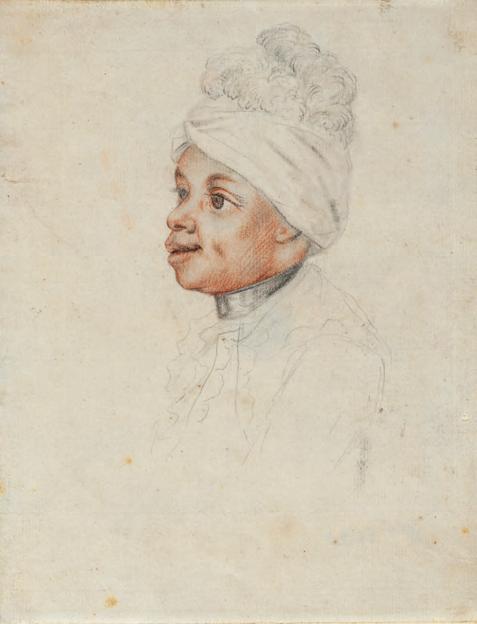
Sammlung, Schloss Wilhelmshöhe). In 1752 Tischbein used it with only minor changes as the basis for a lost history painting for his patron, Johann Philipp Graf von Stadion, and he reused it in 1775 for a second version (Weißensteinflügel, Schloss Wilhelmshöhe) painted for Landgrave Friederich II, Wilhelm VIII’s son. Clearly, he still considered his composition as exemplary twenty years after he had created it.
Of particularly interest are Tischbein’s ‘ricordi’, small portrait heads in red and black chalk, drawn from life. In the exhibition examples of these drawings are combined with the paintings for which they were made. For example, the portrait of the family of the wine merchant and collector Joachim Timmermann, sitting with guests at a concert under a loggia (Gemäldegalerie Alte Meister, Schloss Wilhelmshöhe), painted when Tischbein travelled to Hamburg in 1758 during the Seven Years’ War, is framed by the preparatory portrait heads. As a result of their research for the exhibition, Lange and Rotter were able to identify the sitter of one of Tischbein’s portrait heads, a Black
Exhibitions the
magazine |
78
burlington
165 | january 2023
child (Fig.15), as the servant shown in a portrait of Landgravine Philippine (Fig.14). The servant, dressed in Hesse-Kassel livery, hands Frederick II’s second, then childless, wife a basket of flowers as reference to her blossoming youth. The landgravine holds a bouquet to her heart and looks at the viewer. Her refinement and ostensible wealth seem to compete with the beauty of the delicate boy. It is possible that he was Selim Schwartz, who is documented at the Kassel court in 1774 and 1780. He was brought to Kassel by force and became the landgravine’s servant after completing a Protestant religious education and receiving baptism. Some servants who had been brought to the west by the slave trade made careers at European courts, but others became homeless and unhappy. Selim Schwartz took his life in Fulda on 19th March 1780.
This stimulating exhibition tells many fascinating stories of the creation of Tischbein’s paintings. The present reviewer would have wished for a less crowded hang for the cleverly installed exhibition. The room has the advantage, however, of being located centrally in the magnificent Gemäldegalerie Alte Meister. Thus, after visiting the exhibition, visitors can admire the Dutch and Italian masterpieces that Landgrave Wilhelm VIII acquired for Kassel and that provided inspiration for artists such as Tischbein.
1 The exhibition Guido Reni: The Divine (23rd November 2022–5th March 2023) will be reviewed in a forthcoming issue. For the Bernardo Bellotto exhibition, see M. Haas, ed.: exh. cat. Remember Venice: Bernardo Bellotto zeichnet, Darmstadt (Hessisches Landesmuseum) 2022–23.
2 See M. Miller et al.: exh. cat. Tischbein: Meisterwerke des Hofmalers, Eichenzell (Museum Schloss Fasanerie) 2022, to which this reviewer contributed two entries.
3 Accompanying booklet: Der Maler als Zeichner – der Zeichner als Maler: 300 Jahre Johann Heinrich Tischbein d. Ä. Edited by N. Callebaut et al. 143 pp. incl. numerous col. ills. (Museumslandschaft Hessen Kassel, 2022), €7.50. ISBN 978–3–931787–69–1.
4 See, for example, M. Eissenhauer: exh. cat. 3 x Tischbein und die europäische Malerei um 1800, Leipzig (Museum der Bildenden Künste) and Kassel (Neue Galerie) 2005–06; and P. Tiegel-Hertfelder: ‘Historie war sein Fach’: Mythologie und Geschichte im Werk Johann Heinrich Tischbeins d. Ä. (1722–1789), Worms 1996. See also https://datenbank.museumkassel.de/0/T57180/0/0/2/1/0/objektliste. html?katalogauswahl=Sammlung, accessed 15th December 2022.
Fuseli and the Modern Woman: Fashion, Fantasy, Fetishism Courtauld Gallery, London 14th October 2022–8th January 2023
by kevin salatino
Of Henry Fuseli’s many ‘shockingly indelicate’ drawings, as John Flaxman described them, none is more shocking or more indelicate than his study of a dominatrix using an elaborate strap-on dildo on a figure bent over a chair (Museo Horne, Florence).1 And although that sketch, which he made in Rome in the 1770s, is not included in this riveting exhibition of Fuseli’s drawings of the ‘modern woman’ (organised with the Kunsthaus Zürich), there are enough kindred works to give the visitor a bracing sense of what the eccentric and visionary painter of The Nightmare (1781; Detroit Institute of Arts) was attempting in his moments of greatest graphic liberty and libertinage.2
The famously splenetic Benjamin Haydon memorably described Fuseli’s female protagonists as ‘whores [. . .] with the look of demons [who] have the actions of galvanized frogs’, whereas Fuseli himself, Haydon claimed, ‘was engendered by some hellish monster on the dead body of a speckled hag’.3 So hyperbolic is Haydon’s language that, one speculates, he must have seen at least some of the artist’s controversial drawings, most of which, as Fuseli’s biographer Alan Cunningham assures us, were burnt after his death. ‘Nor do I blame the hand of the widow who kindled it’, Cunningham primly added.4
That widow was Sophia Rawlins, an artist’s model whom Henry married in 1788 when he was forty-seven and she was twenty-five or twenty-six. Of the fifty drawings on view (plus one by John Brown; c.1775–80; cat. no.36), more than half depict the artist’s wife, either literally or allegorically, making the exhibition, in large part, a visual biography of Sophia, the obsessive subject/object of her husband’s affection.5 In most of them she is highly fetishised, sporting extravagant, indeed bizarre, hair or headdresses, and elaborately costumed in either
the latest fashion or in historically inspired inventions. And while her breasts are often exposed, her face whitened and her cheeks heavily rouged à la cortigiana, of all her strange accoutrements, her coiffures take the proverbial cake.
A number of historical sources may be adduced as inspiration for the Fuselian head, including Michelangelo’s teste divine drawings and ancient Roman (Flavian) portrait busts, the putative influences behind, in the first case, an outlandish headdress resembling a pair of ram’s horns (no.7; Fig.16) and, in the second, a hairdo of upswept rows of tight curls that calls to mind the ‘Teddy Boy’ style of the 1950s (1799; Germanisches Nationalmuseum, Nuremberg; no.6).
If, as David Solkin, the curator of this exhibition, speculates in the superb accompanying catalogue, Sophia herself designed and created some of these remarkable concoctions, ‘she deserves to be credited with as much
16. Sophia Fuseli, her hair in large rolls, with pink gloves, in front of a brown curtain, by Henry Fuseli. 1790.
Graphite, brush and watercolour, heightened with white opaque watercolour on paper, 31.6 by 19.7 cm. (Kunsthaus Zürich; exh. Courtauld Gallery, London).
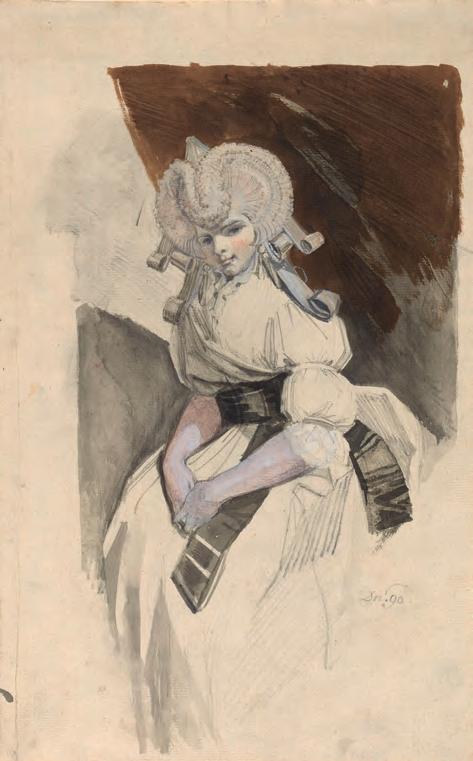
Exhibitions the burlington magazine | 165 | january 2023 79
artistry as her husband’ (p.30). In this reviewer’s opinion the designing and creating were a family affair, but this does not diminish Sophia’s alleged achievement.
Handsomely installed in the Courtauld’s new Denise Coates Exhibition Galleries, with loans from fifteen public institutions and seven private collections, Fuseli and the Modern Woman is a rare opportunity to see a body of work that constitutes, as Solkin revisionistically declares, ‘one of the thematic [. . .] cornerstones of [Fuseli’s] career’ (p.34), ushering in ‘a period of stylistic and technical experimentation without precedent in his practice’ (p.44). Surprisingly, no show devoted to this compelling and provocative material (constituting more than one tenth of approximately 1,300 extant drawings by the artist) has ever been mounted. Divided into three thematic groupings, the exhibition unfolds as both a narrative and a défilé de mode.
The section ‘The Medusa of the Hearth’ focuses, as the wall text indicates, ‘on Fuseli’s fetishistic preoccupation with female hairstyles of extraordinary complexity, [. . .] mainly of his wife’, observing that such ‘displays of artifice were commonly associated with [. . .] courtesans’. It could be argued, of course, that this is the focus of the entire exhibition, but it helps to break up what might otherwise seem a relentless progression of increasingly eccentric femmes fatales into semiotic or iconographic taxonomies. In Fuseli’s profoundly private and performative portrayals of his wife, for example, Sophia can be said to adopt a number of potentially identifiable characters (such as coquette, courtesan, dominatrix or simply fashion plate), presumably known and understood by the Fuselis but now largely irretrievable. She can also be seen to exercise a good deal of personal autonomy.
‘The Other Side of Venus’ explores Fuseli’s images of women (again, mostly Sophia) rendered from behind, a particular fetish of his. A dozen drawings fall into this category, several of which are large, highly finished works in watercolour and gouache (no.27; Fig.17). Sophia’s
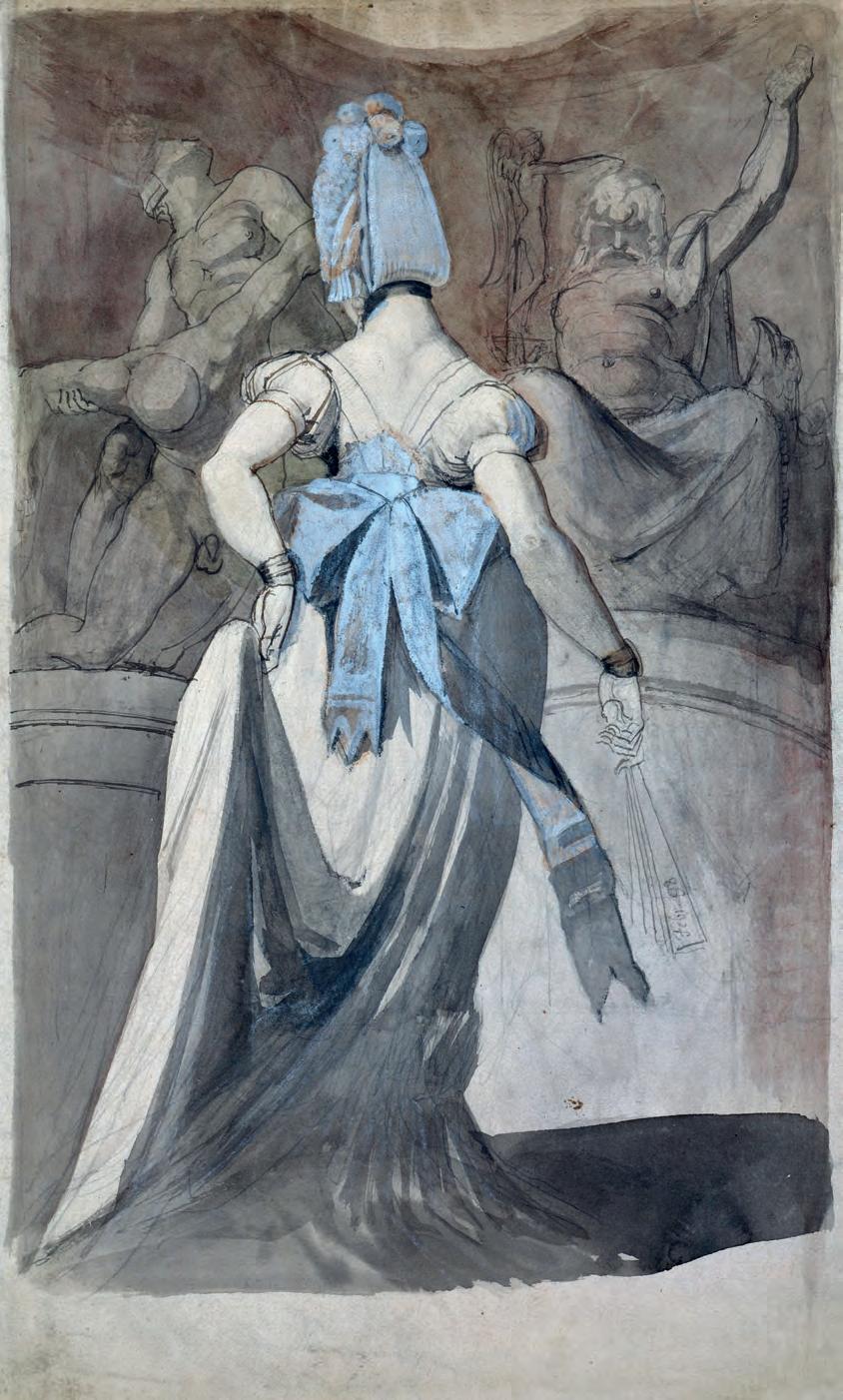
the burlington magazine | 165 | january 2023 80
Exhibitions
majestic swaying figure – an exercise in clothed contrapposto – is rooted to the ground like an oak tree, while her coiffure, seen from the rear, assumes ever more fantastic and suggestively phallic forms. One of this group, the small but powerful Kallipyga (no.24; Fig.18), is among the most objectifying and erotic in the exhibition, its implicit threat of sexual violation implicating both artist and viewer. It depicts Sophia leaning against an altar-like console with ithyphallic supports, staring into a mirror, her skirts hiked up above her waist to expose her buttocks. The floor’s pattern of alternating disembodied male and female genitalia makes plain the drawing’s message.
‘Dangerous Liaisons’, the final section, addresses Fuseli’s unambiguous renderings of courtesans. Again, Sophia clearly posed for some of these, whereas others depict actual (or imagined) sex workers. Still others, the most outré, come from the realm of purest fancy, their startlingly creative and ever-more architectonic head gear defying both gravity and belief. Some of the works in this group, such as The Debutante (1807; Tate; no.41) and Allegory of Vanity (1811; Auckland Art GalleryToi o Tāmaki; no.65), are among the most beautiful in the exhibition, as accomplished as any of Fuseli’s better-known drawings.
A disturbing subcategory in this section depicts women enacting enigmatic rituals of sadistic violence. In them, the artist’s dominatrices (a lifelong obsession) achieve the inevitable Fuselian apotheosis into madwomen and murderesses, blithely indulging in sexual torture, mutilation, dismemberment and infanticide. Most of these are private penseés, unsettling products of Fuseli’s darkest fantasies. Unlike anything else of the time, they are also a testament to his unfettered mind and Gothic sensibility. All of them (indeed, most of the drawings on view), it should be emphasised, were clandestine, shown by Fuseli only to a select few, far too ‘indecent’ ever to have been made public. That they survive at all is miraculous.
Showcasing Fuseli’s graphic invention and abiding strangeness, this deeply intelligent exhibition
Opposite 17. Woman in a sculpture gallery, by Henry Fuseli. 1798. Pen and black ink, brush and watercolour on paper, over graphite, heightened with white opaque watercolour, 41 by 24.7 cm. (Kupferstichkabinett, Staatliche Kunstsammlungen Dresden; exh. Courtauld Gallery, London).
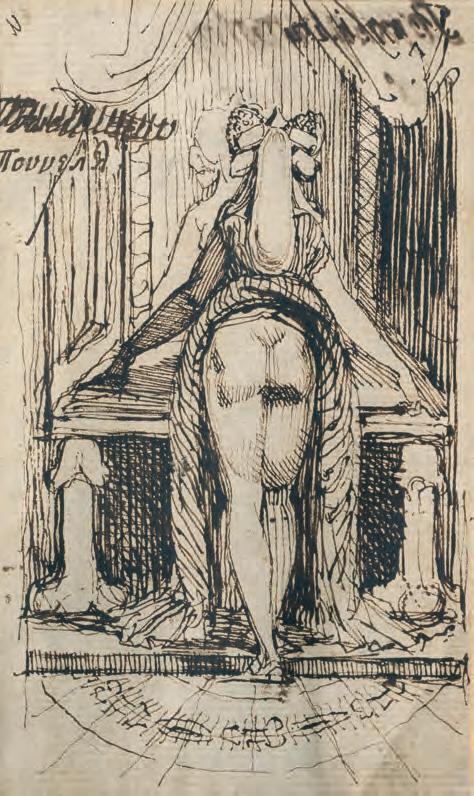
18. Kallipyga, by Henry Fuseli. c.1790–92? Pen and brown ink, 16.3 by 9.4 cm. (Private collection; exh. Courtauld Gallery, London).
and its catalogue are a substantial contribution to Fuseli studies. More significantly, they also enlarge our understanding of proto-Romantic art and thought, expand our perception of the erotic and pornographic in the long eighteenth century and further problematise the depiction, reception and agency of women – modern or not – in a patriarchal age that confined them, in the memorable words of the Fuseli-besotted Mary Wollstonecraft, ‘in cages like the feathered race’, with ‘nothing to do but to plume themselves and stalk with mock majesty from perch to perch’.6
1 John Flaxman’s description concerned a group of ostensibly obscene drawings discovered shortly after Fuseli’s death, as recorded by Benjamin Robert Haydon. See T. Taylor, ed.: Life of Benjamin Robert Haydon, Historical Painter, from his Autobiography and Journals, London 1853, II, p.129.
2 Catalogue: Fuseli and the Modern Woman: Fashion, Fantasy, Fetishism. Edited by David H. Solkin and Ketty Gottardo, with contributions by Jonas Beyer, Mechtild Fend and Ketty Gottardo. 168 pp. incl. 75 col. ills.
(Paul Holberton, London, 2022), £30. ISBN 978–1–913645–29–8.
3 Diary entry for December 1815 in W.B. Hope, ed.: The Diary of Benjamin Robert Haydon, Cambridge MA 1960–63, I, pp.488–89.
4 Cunningham was wrong. Although some of Fuseli’s erotic drawings may have been burned, many clearly were not. A. Cunningham: The Lives of the Most Eminent British Painters, London 1879, I, p.100.
5 The catalogue’s checklist contains sixtyfive drawings, fifty-one of which are on view in London whereas fifty-nine will appear in the exhibition’s second iteration, at the Kunsthaus Zürich (24th February–21st May 2023). Six of the drawings appear only in London, fourteen only in Zürich.
6 S. Tomaselli, ed.: Wollstonecraft: A Vindi-cation of the Rights of Men and A Vindication of the Rights of Woman, Cambridge 2012, p.130.
Modigliani Up
Close Barnes Foundation, Philadelphia 16th October 2022–29th January 2023
by bart j.c. devolder
The Barnes Foundation has selected an ambitious concept for the exhibition that accompanies its centennial celebration, one in which several years of collaborative and interdisciplinary research on the working methods and materials of Amedeo Modigliani (1884–1920) take centre stage.1 It is a unique opportunity to showcase this form of scholarly research, which is still too often buried in the footnotes of catalogues and articles. By making such technical information the raison d’être for this exhibition, the Barnes Foundation deserves praise, as it does also for its success in securing the loans of the fifty works on display. The exhibition is divided into five chronological sections, the first two of which have several sub-sections – an organisational approach that reflects the significant technical shifts in the evolution of the artist’s working process. Each gallery is dazzling and one can only imagine how much more spectacular they would look if the twelve Modigliani paintings in the collection were hung among them, but according to the terms of Albert C. Barnes’s will they cannot be moved.
After a short introductory text, visitors encounter a germane selfportrait of the artist holding a painter’s palette (cat. no.59; Fig.20) and in section 1B they are drawn further into
Exhibitions the burlington magazine | 165 | january 2023 81
the world of Modigliani by an in-theround installation of his sculpted heads (Fig.19). The mise en scène of this section sets the tone for the exhibition’s concept of ‘up close’ looking. In sections 1A and 1C the curators have gathered a selection of paintings from the early stages of Modigliani’s career, when the young and experimental artist often re-used his (and other artists’) canvases. The technical examination using X-radiography, most of which is illustrated in the Barnes Focus mobile guide, helps one understand what lies beneath the painted surfaces. In Antonia (c.1915; Musée de l’Orangerie, Paris; no.9), for example, there is evidence of no fewer than six underlying compositions.
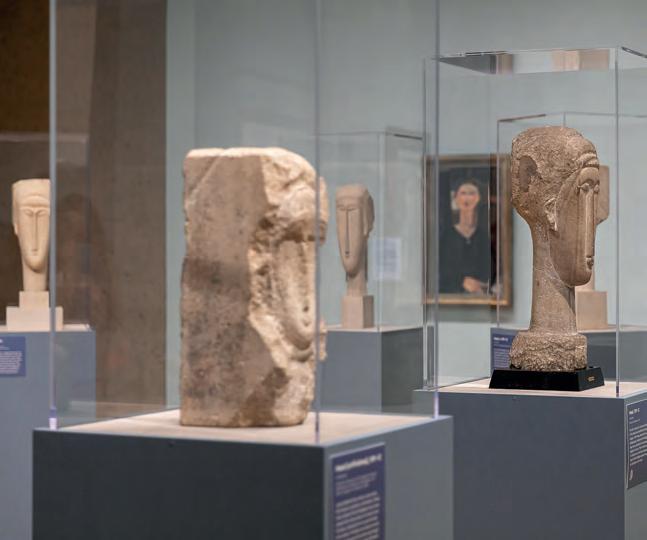
It is evident from the beginning of the exhibition that the organisers assume a certain amount of preexisting knowledge from its visitors regarding artist’s materials and techniques. A section showcasing the materials themselves, such as a historic stretcher and strainer, sculpting tools, pigments and canvas swatches, would have made certain concepts clearer and been a useful accompaniment to the wall texts. In particular, the topic of supports would have benefited from a little more elucidation at the start of the exhibition, as the curators have chosen to list the dimensions
of each painting in correspondence with the size chart for canvases from 1892 by the French purveyor of art supplies Lefranc et Cie. For example, dimensions are not listed as 92 by 64.8 centimetres but as 30 marine haute format. This is an interesting approach, and one that is appropriate for an exhibition of this kind, but it may be confusing for some visitors.
In sections 2A and 2B there is a selection of works that Modigliani created between late 1916 and early 1917, while he was being supported by the Polish art dealer Léopold Zborowski. This patronage resulted in a significant shift in Modigliani’s working methods. He no longer needed to recycle canvases and the ones he had at his disposal were, as a result, more consistent in size. Another technical and visually striking change was his introduction of a blue-grey ground. These colour values complement the pink skin tones, resulting in paintings that appear to glow. Section 2C invites the visitor to compare two works: Elvira resting at a table (c.1918–19; Saint Louis Art Museum; no.44) and Standing nude (Elvira) (c.1918; Kunstmuseum Bern; no.45). The paintings portray the same sitter but are created using remarkably different methods of paint application. Such exercises in close looking can be a powerful method of educating the
19. Installation view of Modigliani Up Close at the Barnes Foundation, Philadelphia, 2022. (Courtesy Barnes Foundation, Philadelphia).
20. Self-portrait, by Amedeo Modigliani. 1919. Oil on canvas, 100 by 64.5 cm. (Museu de Arte Contemporanea da Universidade de São Paulo; exh. Barnes Foundation, Philadelphia).
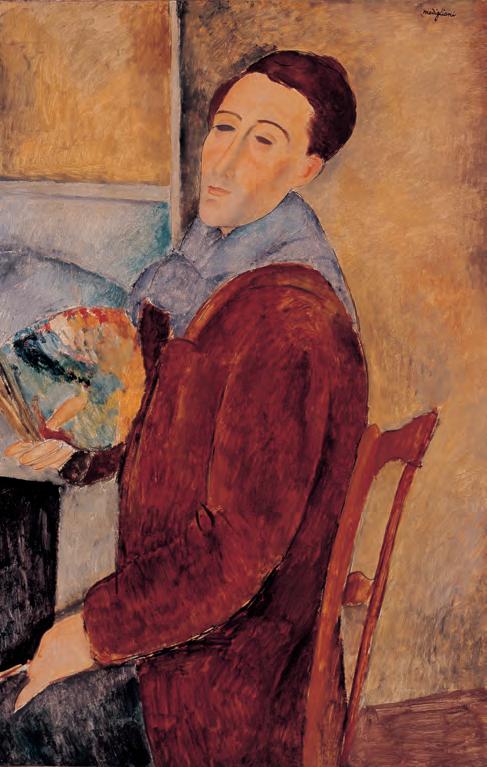
visitor. However, some more guidance could have been offered here, perhaps in the form of macrographs, illustrating the differences in the handling of paint.
Section 3 is novel for its inclusion of three works that do not appear in Ambrogio Ceroni’s 1970 catalogue raisonné.2 Simply on the basis of technical examination and research, there is no clear reason why these works should not be by Modigliani; this section therefore illustrates the limitations of this kind of investigation. Although the material analysis makes a strong case for inclusion in his œuvre, the curators (and authors of the catalogue) take no final decision and embrace the ambiguity. As soon as one enters the following section, a shift in painting materials is instantly palpable. The paintings grouped here were made by the artist after he moved to the south of France in the spring of 1918, which had a major impact on his work as there was only a limited supply of professional models and painting
Exhibitions the burlington magazine | 165 | january 2023 82
materials. Here the paint is more diluted, often used on a white ground, with pencil underdrawings, reinforced lines in the final stages and an overall matte surface. In the final section the curators demonstrate the progress that the artist made in his short career. The format and colour palette of these late paintings are more varied. Such works as Young woman in a yellow dress (Renée Modot) (no.38; Fig.21) fully justify the statement in the wall text: ‘because of his early death at 35 we can only speculate what would have come next in his artistic evolution’.
The present reviewer is a painting conservator who has contributed to several projects that incorporated technical research findings into an exhibition, and therefore was particularly interested in the functionality of the digital guide in this context.3 This guide has proven to be a very successful accompaniment to the works in the permanent galleries of the Barnes Foundation. The opportunity for providing additional text and images without cluttering the walls has great potential for deeper engagement. Considering that the presentation of new technical information is the premise of the exhibition, it is a missed opportunity that not all the works have the corresponding information available in the guide. In the galleries, X-radiographs– smaller than the original works, printed on board and not backlit – are hung on the walls, but these are not all included in the guide. The curtain-viewer function – a cursor that allows the viewer to slide between the image and infra-red reflectography or an X-radiograph – is the guide’s best feature. It is unfortunate that this is not available for every technical image. Moreover, some of the painted details are in rather low resolution, prompting the visitor – perhaps unintentionally – to look instead at the paintings in the galleries. Another missed opportunity is the absence of elemental information obtained through the use of macro X-ray fluorescence scanning (MA-XRF).
However, none of these criticisms apply to the exhibition catalogue.4 This excellent publication is lavishly illustrated and here the paintings
21. Young woman in a yellow dress (Renée Modot), by Amedeo Modigliani. 1918. Oil on canvas, 92 by 60 cm. (Castello di Rivoli Museo d’Arte Contemporanea, Turin; exh. Barnes Foundation, Philadelphia).

and the technical images are each reproduced on one page allowing for direct comparison. It includes a technical glossary and also provides and in-depth study of certain topics, such as thread-count; pigment identification; MA-XRF data; and Modigliani’s works on paper that are absent from the exhibition. Overall, the exhibition and the accompanying publication are the successful culmination of several years of important multidisciplinary research and a model for future comprehensive investigations into artists’ methods and materials. The accompanying in-gallery technology is also a promising way to offer more in-depth information and is an approach that we will likely see more often in the future.
1 For recent technical studies into Modigliani’s working methods and materials, see the series of articles on this subject published in this Magazine, 160 (2018), pp.182–88 and 189–95; 160 (2018), pp.311–18 and 319–24; and 160 (2018), pp.394–99 and 400–07.
2 See A. Ceroni: Amedeo Modigliani: Dessins et Sculptures, Milan 1965; and idem: I dipinti di Modigliani, Milan 1970.
3 Investigating Change in Manet’s Paintings was at Princeton University Art Museum (1st March–12th May 2019). See also J. Ketels and S. Laevers, eds: exh. cat.
Restoration / Revelation: The Exterior Wings of the Ghent Altarpiece, Ghent (Caermersklooster Provincial Culture Center) 2016–17; and E. Kahng, C. Palermo, H. Cooper, A. Bourneuf, C. Poggi, C. Barry and B. Devolder: exh. cat. Picasso and Braque: The Cubist Experiment, 1910–1912, Fort Worth (Kimbell Art Museum) 2011.
4 Catalogue: Modigliani Up Close. Edited by Barbara Buckley, Simonetta Fraquelli, Nancy Ireson and Annette King. 334 pp. incl. 328 col. + 115 b. & w. ills. (Barnes Foundation, Philadelphia, 2022), $50. ISBN 978–0–300–26718–1.
Morris Hirshfield Rediscovered American Folk Art Museum, New York
23rd
September 2022–29th January 2023
by randall morris
Morris Hirshfield (1872–1946) was born in Poland and emigrated to New York at the age of eighteen, where he ran a successful garment and shoe business until economic crisis forced him to sell it. Although he had always wanted to be an artist, he did not begin to paint until the age of sixty-seven. Soon after, Hirshfield was discovered by the visionary dealer Sidney Janis, while he was seeking unknown artists for an exhibition he was curating at the Museum of Modern Art, New York (MoMA). As Richard Meyer recounts in the exhibition catalogue, during an otherwise fruitless visit to the Hudson Walker Gallery, New York, Janis came across two canvases leaning against a wall that the gallery owner had intended to send back to the artist, one of which was Hirshfield’s Angora cat (cat. no.2; Fig.22).1 Janis played a pivotal role in the development of Hirshfield’s career, along with other prominent figures in the New York art world, such as André Breton, who curated exhibitions that included Hirshfield’s work while living in the city in exile during the Second World War.
None of the above can truly prepare the viewer for the impact of Hirshfield’s strange, tightly organised and beautiful work. The drama it evokes is as profoundly cryptic as its textures and surfaces.
Exhibitions the burlington magazine | 165 | january 2023 83
Although many art historians have compared Hirshfield’s work to that of Henri Rousseau (1844–1910), his paintings appear to exist in a completely different world. Rousseau’s viewpoint was oneiric and almost animistic. He sought the landscapes of romantic dreaming, but he was not philosophically a Surrealist; rather, he was naturally surrealistic. Hirshfield had a similar sensibility, but he eschewed the ‘wild’ in favour of a strange rigorous organisation of the world into patterns, which he created through the repetition of marks. His imagery – from the tapestry-like depictions of animals to the (in his mind) idealised and erotic women, for example in The artist and his model
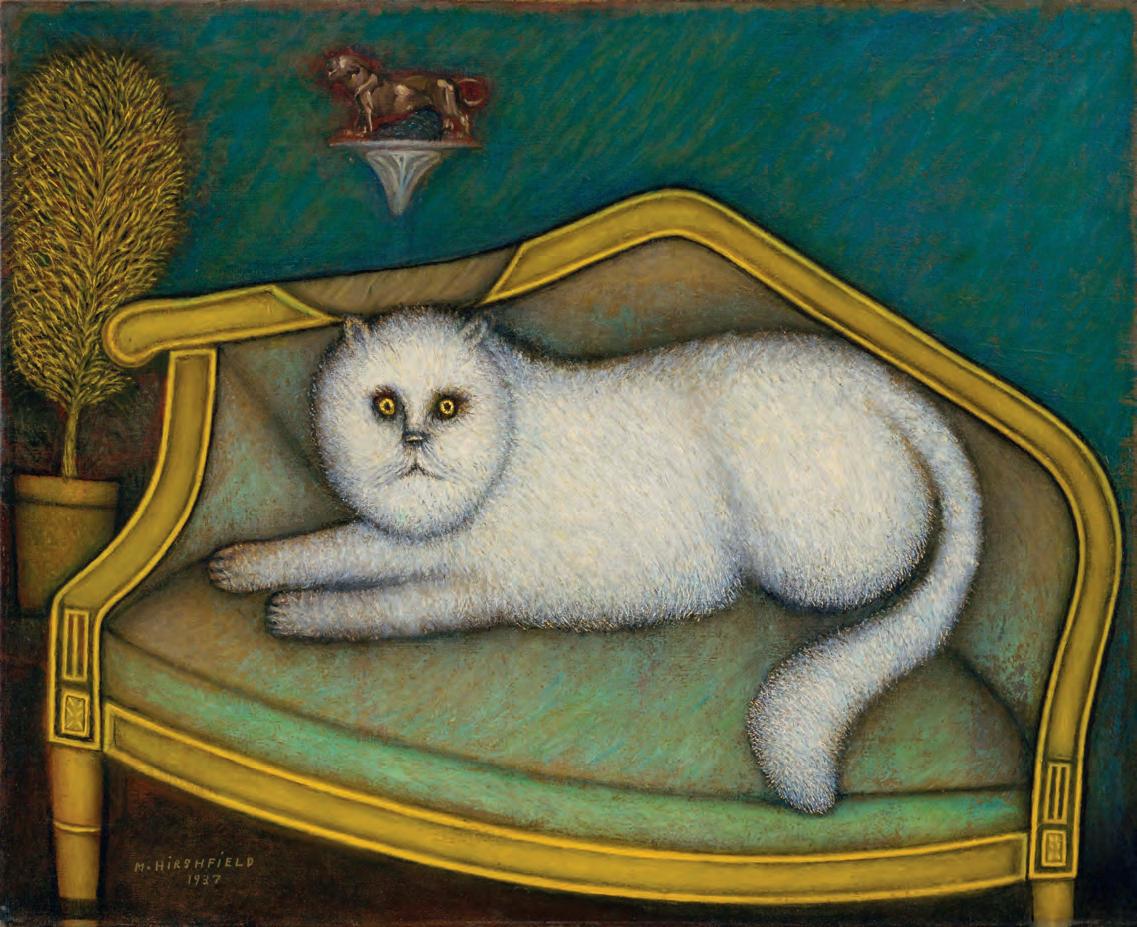
(no.61; Fig.23) – came from a need to compartmentalise the world, utilising his knowledge of fabric design, texture and colour to organise it. Whereas Rousseau’s jungle-like scenes are a portal to wild poetry, almost welcoming a loss of sensory control, Hirshfield’s greenery is tended and manicured, as seen in Parliamentary buildings (no.74; Fig.24). Both artists were masters of rigorous craft, but Rousseau was restless, while Hirshfield was content to find rhythms in his immediate surroundings. However, despite this appearance of rigidity, there still remains a suggestion of the mysterious and the unknowable.
By the time of his death, Hirshfield had completed approx-
imately eighty works, of which around half are in this exhibition. It begins with the earliest works: Angora cat and Beach girl (1937–39; Museum of Modern Art, New York; no.1). The paintings are divided into thematic sections, with such titles as ‘In the Wild’, which examines his fantastical depictions of animals, ‘Strange Beauties’, which gathers together his mesmerising nudes, and ‘Shoes’. A small section focuses on the exhibition First Papers of Surrealism at the Whitelaw Reid Mansion, New York, in 1942, in which Hirshfield took part. Famously, Marcel Duchamp draped the exhibited works in a web of string. New York is the perfect setting for a survey of Hirshfield’s
Exhibitions the burlington magazine | 165 | january 2023 84
22. Angora cat, by Morris Hirshfield. 1937–39. Oil on canvas, 56.1 by 69.2 cm. (Estate of Morris Hirshfield and VAGA at Artists Rights Society, New York; Museum of Modern Art, New York; exh. American Folk Art Museum, New York).
work, allowing the viewer to draw together atmospheric threads regarding the artist’s subject-matter and personal biography. One could argue that Hirshfield worked in three languages: Yiddish, as an immigrant in the United States who succeeded in carving out a niche of relative well-being for himself in his Jewish community; English, in his relationship with business as well as the art world and the relevant subjects that extended past his original garment livelihood, including patented inventions; and Hebrew, which he utilised in a number of his later works, such as Moses and Aaron (of delicious recoil) (1944; Jewish Museum, New York; no.37). Depicting a scene from Exodus, the painting shows Aaron and Moses with a number of stone tablets, which are inscribed with the Ten Commandments in Hebrew.
Obsessiveness is perhaps an overused word in the field of vernacular self-taught artists, but one cannot look at the works in this exhibition without acknowledging the existence of this quality. Much of what has been written about Hirshfield, from the very beginning of his artistic career, is concerned with his misadventures in the realms of modernist and postmodernist revisionism. Most discussions focus on his placement, or displacement, in the art world rather than the contexts and meanings of the work itself, which this exhibition and catalogue attempt to rectify through a more studied involvement with Hirshfield’s paintings and processes. Very little writing, if any, goes beyond merely noting Hirshfield’s highly detailed mark making – a process that is much closer to textiles, Art Brut and vernacular art than to an exploration of mainstream art-historical sources.
By comparison, Meyer’s catalogue, which adopts a personally inflected approach, and also includes a full catalogue by Susan Davidson of the artist’s known works, provides many glimpses into the artist’s world. It is a richer expansion of ideas suggested in the visual exhibition, contextualising the artist and his life anecdotally. Meyer demonstrates that the obsessive nature of Hirshfield’s works deserves
more considered attention: it is one thing to make numerous repetitive stiches in a garment and quite another to be an artist and use that same technique as a method of painting. Considering his background, it is reasonable to assume that Hirshfield referenced accumulative stitching in his brush strokes, but it is also important to understand what he achieved in the process. Textiles, like paintings, are ceremonies of the hand; Hirshfield’s paintings thus allowed him to control his immediate world
23. The artist and his model, by Morris Hirshfield. 1945. Oil on canvas, 111.8 by 86.4 cm. (Estate of Morris Hirshfield and VAGA at Artists Rights Society, New York; exh. American Folk Art Museum, New York).

through a process that one could equate with the laying on of hands – a religious practice that accompanies the conferring of a blessing or authority.
Hirshfield was self-aware enough to understand that his experience in the garment industry provided him with the technique and ability to articulate his thoughts about nature, eroticism, romance and mundane beauty, in addition to affording him an inimitable style that was uniquely his own. Yet, as this exhibition reveals, this resulted in works that possess
Exhibitions the burlington magazine | 165 | january 2023 85
a sense of timelessness and of human universality.
Hirshfield was not interested in memorialising the old world from which he came. Although a number of his paintings reference biblical subjects, they are embellished with his own iconography; they are more akin to commentaries on the Bible than depictions of its subjects. As it was for so many of his generation, the act of simply doing what he wanted was a kind of willed assimilation into a country that represented the potential
of success to so many. Hirshfield went into his bedroom, which was also his studio, closed the door and shut out the world, even to the demands of his immediate family, and emigrated again to a world of his own making, populated by the manifestations of his own desires, obsessively detailed and fantastically recorded.
1 Catalogue: Master of the Two Left Feet: Morris Hirshfield Rediscovered. By Richard Meyer. 320 pp. incl. 204 col. ills. (MIT Press, Cambridge MA and London, 2022), $59.95. ISBN: 978–0–262–04728–9. See esp. pp.64–87.
the burlington magazine | 165 | january 2023 86
Isamu Noguchi
Zentrum Paul Klee, Bern 23rd September 2022–8th January 2023
by penelope curtis
The Zentrum Paul Klee, which was designed by Renzo Piano and opened in 2005, sits on the hills on the outskirts of Bern. Its central hall, measuring 1,616 square metres, resembles something between a hangar and a trade fair, and constitutes one vast space that is barely divided up. Therefore, as the setting for this travelling retrospective dedicated to the sculptor and designer Isamu Noguchi (1904–88), the dominant impression is one of a single œuvre undifferentiated by historical moment. The exhibition’s organisation is thematic, only occasionally falling into chronology, and the absence of any kind of overall narrative thrust could ostensibly be seen as an advantage. Certainly, the many works, which span a career of some sixty years, are given plenty of space and the even, ambient lighting allows for each to be separately apprehended. The way in which the ten sections merge together – and indeed are only tentatively suggested – is a refreshing contrast to an increasingly didactic trend in recent exhibition-making. Nonetheless, it is an approach that results in a large exhibition that offers no clear analysis of this artist’s exceptional production.
24. Parliamentary buildings, by Morris Hirshfield. 1946. Oil on canvas, 91.8 by 71.1 cm. (Estate of Morris Hirshfield and VAGA at Artists Rights Society, New York; Museum of Modern Art, New York; exh. American Folk Art Museum, New York).
The exhibition is notable in that it offers viewers the chance to see Noguchi’s sculptures without vitrines. Only a small number of works, including loans from the Whitney Museum of American Art and the Museum of Modern Art (MoMA), both New York, are under Perspex. The remainder are uncovered and come from one source: the Isamu Noguchi Foundation and Garden Museum, New York. Although there are tremendous advantages for the exhibiting institution in borrowing almost exclusively from one location, it also means that the works – and their interpretations – are largely familiar to those who have a preexisting interest in Noguchi. That
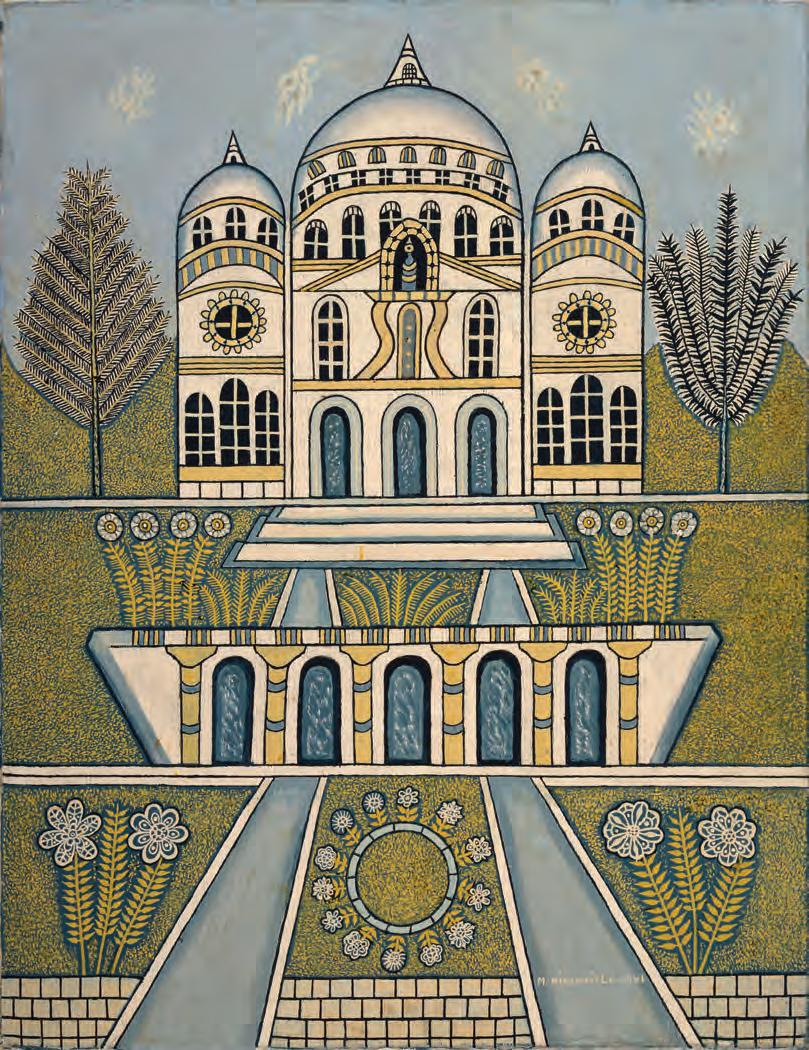
Exhibitions
25. Lunar infant, by Isamu Noguchi. 1944. Magnesite, wood and electric components, 55.9 by 40.6 by 40.6 cm. (Isamu Noguchi Foundation and Garden Museum, New York; photograph Kevin Noble; exh. Zentrum Paul Klee, Bern).
said, the foundation holds so many works that, one imagines, it would be quite possible for curators to provide new readings. However, this is not evident in the exhibition, even if it offers an exceptional opportunity to see substantial groupings of most of the areas that Noguchi worked in. Moreover, the accompanying publication, which is edited by Fabienne Eggelhöfer, Rita Kersting
and Florence Ostende, who each represent one of the three exhibiting institutions, does not reflect the organisation of the exhibition and, given that it contains no list of works, is intended more as a book than a catalogue.1 It contains four short essays – on Noguchi’s time in Europe, his intellectual dialogue with Richard Buckminster Fuller (1895–1983), his ideas of ‘social sculpture’ and his
interpretations of space – as well as a conversation between contemporary sculptors and writers on Noguchi’s work and transnationalism, a section of Noguchi’s photographs, his travels and studios and a chronology.
The sections of the exhibition are organised by loosely connected themes, each of which include up to a dozen works. Best represented across these are the portrait heads Noguchi made of his friends in the 1920s; his drawings and sculptures created in Paris, while he worked as an assistant to Constantin Brancusi; his experimental ceramics from the early 1950s, made after studying traditional techniques with various Japanese ceramicists; his upright compositions from c.1947–59, vertical forms mostly around human height and pierced with smaller parts; and his ‘lunar’ sculptures, experiments with light that he began in the 1940s (Fig.25). Noguchi’s design work is less well represented although his stage designs are touched on by the inclusion of two sets and some props for dance pieces, one for the choreographer Martha Graham and the other for Erick Hawkins, Graham’s husband and fellow choreographer. Although the famous Akari light sculptures hang in profusion from the ceiling, less obtrusively than when they were hung throughout the spaces of the Barbican Art Gallery, London, the
For more writing on recent art, visit Burlington Contemporary, our online platform for the latest research and reviews on contemporary art: contemporary.burlington.org.uk
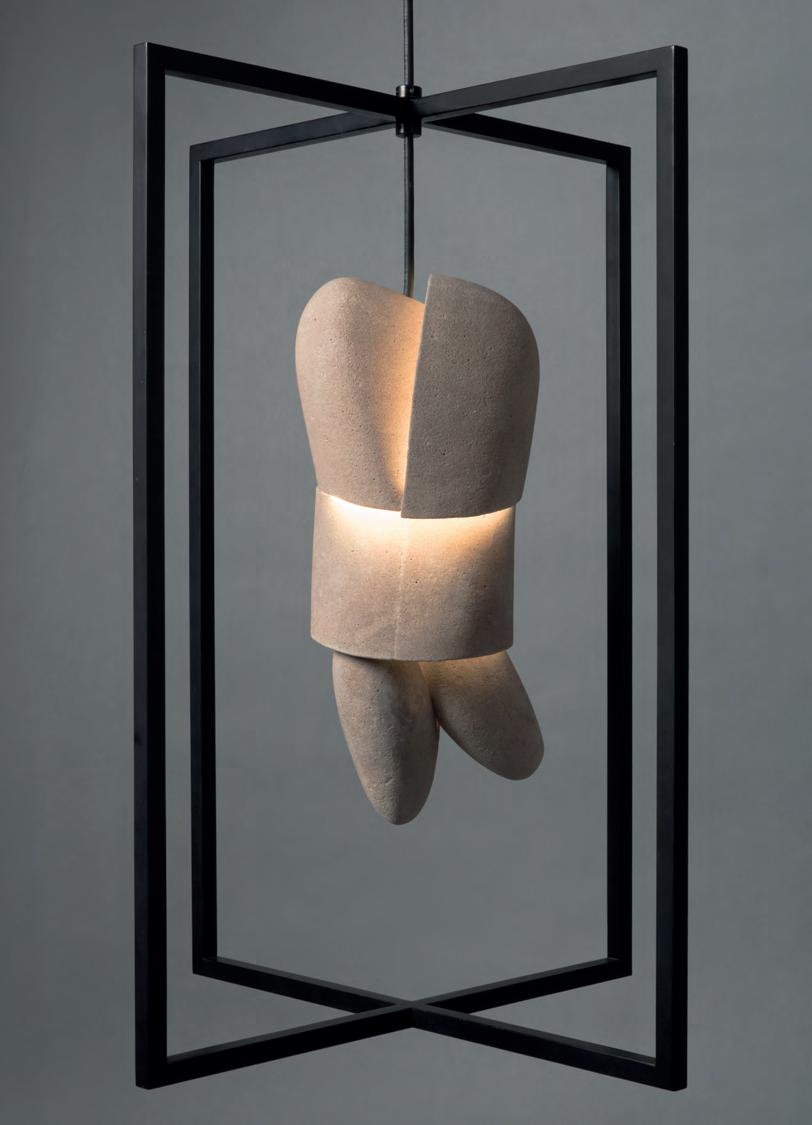
Exhibitions the
| 165 |
2023 87
burlington magazine
january
Exhibitions
26. Monument to heroes, by Isamu Noguchi. 1943. Cardboard, wood, bones and string, 71.8 by 34.6 by 24.8 cm. (ProLitteris, Zurich; Isamu Noguchi Foundation and Garden Museum, New York; exh. Zentrum Paul Klee, Bern).

exhibition’s opening venue, the story of their production is referenced only briefly and they hang over the show as though removed from any historical chronology.2
Noguchi is an artist who would, in fact, benefit from being more thoroughly compared to his contemporaries. By the late 1920s he had already met and worked with Brancusi, Fuller and Graham. He was interested in expanding the purview of sculpture, and although his work on playgrounds, murals and monuments is acknowledged in the exhibition, it is only superficially explored. The section of the exhibition titled ‘Social Protest’, devoted to his public monuments designed between 1933 and 1952, which largely went unrealised, is the most revelatory. Noguchi designed fifteen monuments and memorials, all of which are strikingly engaged with the fight for social justice in terms of both class and race. As only five were realised by the time of his death, this section entirely comprises text and photography.
These omissions leave the viewer to wrestle with the questions that are posed by the exhibition but left unanswered: what was Noguchi’s contribution to modern sculpture? Beyond recognising his undoubted versatility, where does he fit in this story? Moreover, the even-handed, tasteful arrangement means that the darker aspects of his engagements are somewhat suppressed. Viewers are briefly exposed to some of the violence in his work in relation to both race and sex, but his well-known Monument to heroes (Fig.26), a totem-like sculpture that incorporates bones, all too easily blends into a ‘Noguchi-look’ without having its importance analysed. Both the materials used and the work’s ironic title quite clearly indicate the futility of war and of traditional sculptural commemoration. Noguchi’s vocabulary was undoubtedly his own, while also relating to a Cubist vision of the interrelationship of forms. In ways similar to those essayed by his contemporaries, Noguchi experimented with the shine, lines and pairings of contrasting materials, and the bending of sheet metal. He flattened his bone-like or phallic
the burlington magazine | 165 | january 2023 88
shapes as though he were pressing them out; one material, such as clay, informed the innovative treatment of another, such as metal or marble. Added to this trademark form was his innovative use of gravity, either in suspension or the combination of interlocking forms. His arrangement of vertical forms and their lack of fixity can be compared to the work of (notably female) sculptors, such as Louise Bourgeois, Louise Nevelson and Barbara Hepworth. Alongside the cage-like or openwork structures that abound in his work, Noguchi also
27. My Arizona, by Isamu Noguchi. 1943, partly reconstructed 1978. Fibreglass, plexiglas, 46.4 by 46.4 by 11.7 cm. (Isamu Noguchi Foundation and Garden Museum, New York; exh. Zentrum Paul Klee, Bern).
made notable use of the wall. Some of his most unusual contributions to the discipline are his works made in the 1940s, which transcend ideas of what constituted sculptural reliefs at the time. Conceivably, they depart from the biomorphic forms of Jean (Hans) Arp, but they push the boundaries much further, partly through the use of malleable plastic materials and electric light. Although no specific allusion is made beyond their titles, such as My Arizona (Fig.27), these works date from the period in which Noguchi was based in an internment camp in Arizona,
following the order to intern Japanese Americans in 1942. Although Noguchi was exempt as a New York resident, he voluntarily entered the Poston War Relocation Center, hoping to improve conditions there.
This exhibition is difficult to evaluate, as its advantages are also its disadvantages. Viewers are able to see a large volume of works, which are well displayed and open to interpretation. However, the tasteful ambience often results in one work resembling another, and stylistic as well as contextual differences are left unexplored. Although Noguchi’s enormous range is well represented, it is shown without depth. The exhibition is an ample demonstration of the ways Noguchi used materials – ceramics, stones, metal, plastic and paper – and surfaces – floor, walls, tables and ceilings – but his formal contribution lies unidentifiable, and his political engagement and forthright contributions to a fractured society go under the radar. Although he made twenty stage productions with Graham and more than one with Hawkins, we learn almost nothing about them. Similarly, we are informed that he used the kiln of Kitaōji Rosanjin, but little more. Somehow, Noguchi is left as an anomalous figure, all things to all men, without any specific anchors tying him to the society in which he lived. For an artist who made such concrete contributions to design and to the built environment, this is a missed opportunity. For an artist whose place is both assured and yet still unlocated in the story of modern sculpture, this is even more lamentable. Noguchi’s generous contribution to sculptural vocabulary still evades description; his place is less clearly defined than that of his contemporaries. Unfortunately, this exhibition, despite – or because of – its size and range, and its equable and even display, does not help to find the words to describe the real nature of Noguchi’s work and contribution.
1 Catalogue: Isamu Noguchi. Edited by Fabienne Eggelhöfer, Rita Kersting and Florence Ostende. 320 pp. incl. 350 col. ills. (Prestel, Munich, London and New York, 2021), £39.99. ISBN 978–3–7913–7979–1.
2 The exhibition opened at the Barbican Art Gallery, London (30th September 2021–23rd January 2022) before travelling to Museum Ludwig, Cologne (26th March–31st July 2022).
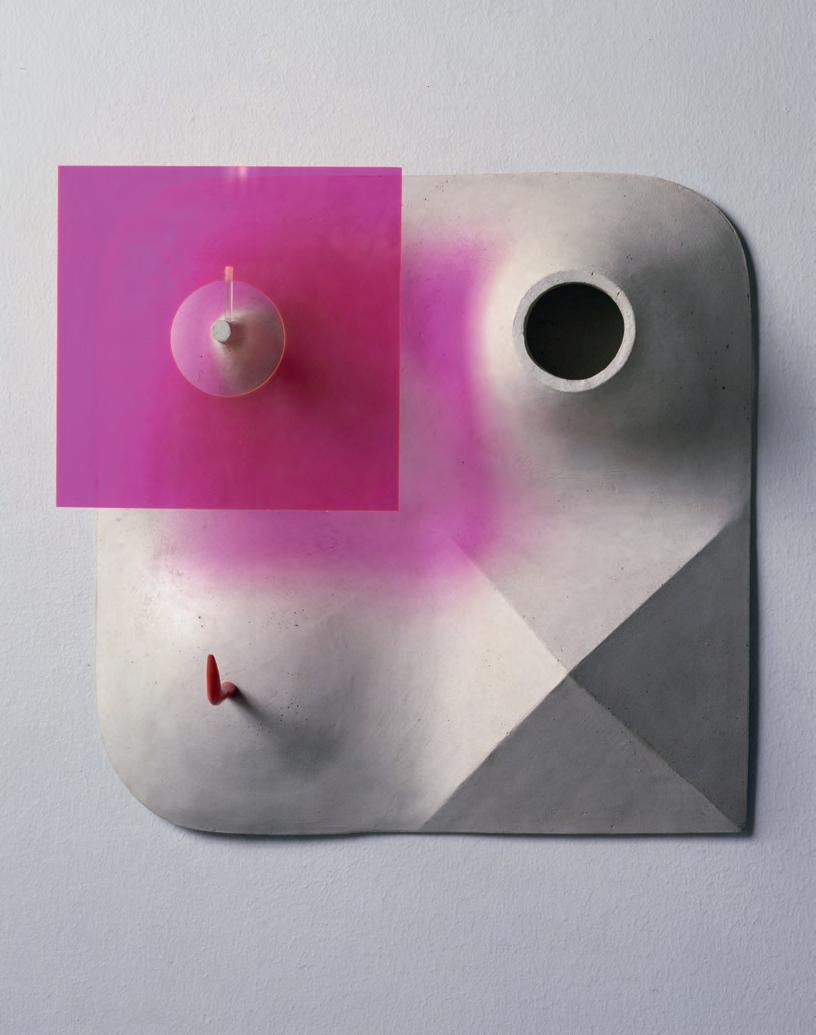
Exhibitions the burlington magazine | 165 | january 2023 89
Books
Artemisia Gentileschi
By Sheila Barker. 144 pp. incl. 80 col. ills. (Lund Humphries, London, 2022), £30. ISBN 978–1–84822–454–4.
by mary d. garrard
When Sheila Barker began to write about Artemisia Gentileschi a decade ago, she significantly changed our perception of the artist. As the Founding Director of the Jane Fortune Research Program on Women Artists, part of the Medici Archive Project, Barker combed the Florentine archives for information about Artemisia and other women artists. Her discovery and incisive analysis of archival documents revealed Artemisia’s ingenious strategy to gain patrons in Florence – a showy entrepreneurship, which included creating costumes of bartered silks that blended her own image with her painted ones. Ultimately, this led to highlevel patronage at the Medici court. Barker’s findings contradicted a standing assumption about Artemisia’s early professional life, that her career success in Florence was due to the proactive support of sympathetic patrons. We now know that it was Artemisia who took the initiative in managing her career, and our understanding of this complicated artist has deepened accordingly.
Barker’s inquisitive focus on Artemisia’s agency, her motivations and intentions, animates this important book on the artist’s life and art.1 It is the second volume to appear in the recently launched Illuminating Women Artists series, which enlists leading scholars to contextualise historically the work of Early Modern women artists in concise monographs that are intended to address both scholarly and general audiences. Barker fulfils this tall order with a clear, compelling narrative that is both intellectually sophisticated and pleasurably accessible. Building on the research she first published in disparate
articles, Barker presents a coherent overview in a slim volume that contains much new information about Artemisia and many original insights into her art.
In the preface Barker briefly reviews the now substantial literature on Artemisia, explaining that she will not engage with other scholarship, but will attempt to weave ‘a credible explanation for the vicissitudes of her progress as an artist’ (p.14). She emphasises the importance of viewing the artist through the lenses of gender and feminism, asserting that ‘how Artemisia stood with respect to her society’s views of womanhood is, in fact, one of the main questions driving this book’ (p.13). As the author of the first art-historical study of the artist, the feminist framework of which was initially questioned by scholars, this reviewer is gratified to see Barker reiterate that Artemisia’s outlook, no less than her art, was feminist avant la lettre 2 Earlier readings are enriched and sometimes modified by Barker, who has uncovered new documentary evidence of Artemisia’s feminist thinking, including her gender pride. For example, when Artemisia gave her Florentine biographer Cristofano Bronzini a largely invented version of her artistic origins, she traced her earliest inspiration to her mother’s embroidery skills and concealed the fact that her father trained her in painting, thus linking ‘her artistic gifts with a matrilineal line of descent, rather than a patrilineal one’ (p.25).
A particular strength of Barker’s biographical writing is her tracing of personal connections within the large cast of characters who populated Artemisia’s world. In Rome, when she was young, she had female role models among noblewomen reformers, artists and musicians. A notable model for her was the Bolognese painter Lavinia Fontana, who was enjoying artistic success in the city. Barker further suggests that Fontana’s late erotic female nudes prompted Artemisia to make the female nude her own specialty.
the burlington magazine | 165 | january 2023 90
Although this proposal risks reducing Artemisia’s motivations to a business plan, it is accompanied by the more thought-provoking idea that, for a woman, painting nude female bodies might have been a ‘subversive powerplay’ (p.17). Barker has a keen eye for explanations that connect the dots. The recent discovery that Artemisia wrote sonnets is here linked with the artist’s contribution to the painting cycle at Casa Buonarroti, Florence, which celebrated ‘the greatest of all poet-artists’, Michelangelo (p.78).3
Barker’s telling observation that Artemisia took up poetry soon after the publication of Michelangelo’s sonnets in 1623 complements visual evidence that Michelangelo offered both inspiration and a challenge to the highly competitive Artemisia.
Sustained discussions of selected paintings punctuate the biographical narrative. In a forceful reading of Judith beheading Holofernes (Fig.1), Barker brings an informed knowledge of Medici power politics to demonstrate how this painting came to represent both dynastic and feminist agendas. It was commissioned in 1619–20 by Grand Duke Cosimo II, at a time when his health was failing and both his mother, Cristina of Lorraine, and his wife, Maria Maddalena, were rising as culturally powerful, supporting regents. Artemisia’s polyvalent image of two courageous women defeating a foreign enemy was displayed in Palazzo Pitti, Florence, at the intersection of the male and the female apartments. In Barker’s reading, the painting was a political success in both wings of the House of Medici.
Barker’s emphasis on Artemisia’s careerbuilding strategies is counterbalanced by her fresh and perceptive analyses of paintings, which illuminate Artemisia’s inner life as an artist, her expressive intelligence and ability to load and enrich simple narratives with deeper meaning. Humble midwives, not the baby’s parents, are the compositional focus of the Birth of St John the Baptist (c.1635; Museo Nacional del Prado, Madrid), an inversion that, Barker notes, anticipates Velázquez’s The spinners, or the fable of Arachne (1655–60; Prado) by two decades One midwife holds a towel, ‘rolled up like an ancient scroll’, an allusive way to identify her as sibylline, and gazes meditatively at the baby in the bathwater in a prefiguration of his future as the baptiser of Christ. Barker’s unpacking of Artemisia’s poems demonstrates that she aspired to make ‘loquacious’ (p.103) paintings, which speak their meanings through the movements of bodies. The
Two pioneering scholars of Artemisia Gentileschi have re-evaluated the artist’s life and art, producing fresh insights into this still enigmatic artist
author’s interpretative insights encourage us to discover what more those movements and arrangements can tell us.
However, this reviewer would question the inclusion of certain paintings doubtfully attributed to Artemisia – especially the socalled ‘Lemme Judith’ (private collection), Weaning Virgin (Palazzo Corsini, Rome) and Lucretia (J. Paul Getty Museum, Los Angeles), although the inclusion of the last, and its appearance on the cover of the Getty Publications edition of the book, may not have been the author’s choice Some proposals seem improbable, such as one that Artemisia’s sensitive depiction of penitential saints
suggests she might have been a practising religious penitent. Yet Artemisia’s emerging stylistic range constantly surprises those who study her, and the life story that is unfolding contains revelations no one could have predicted at the outset. To interpret Artemisia, it is usually more promising to think big than to underestimate. As Barker rightly observes, ‘we have only begun to get to know her’ (p.11). Barker’s expansive and productive reasoning, grounded in new archival evidence, has substantially advanced the quest.
1 The book was published in the United States in 2021 by Getty Publications, Los Angeles, under the same title. ISBN 978–1–60606–733–8.
2 See M.D. Garrard: Artemisia Gentileschi: The Image of the Female Hero in Italian Baroque Art, Princeton NJ 1989.
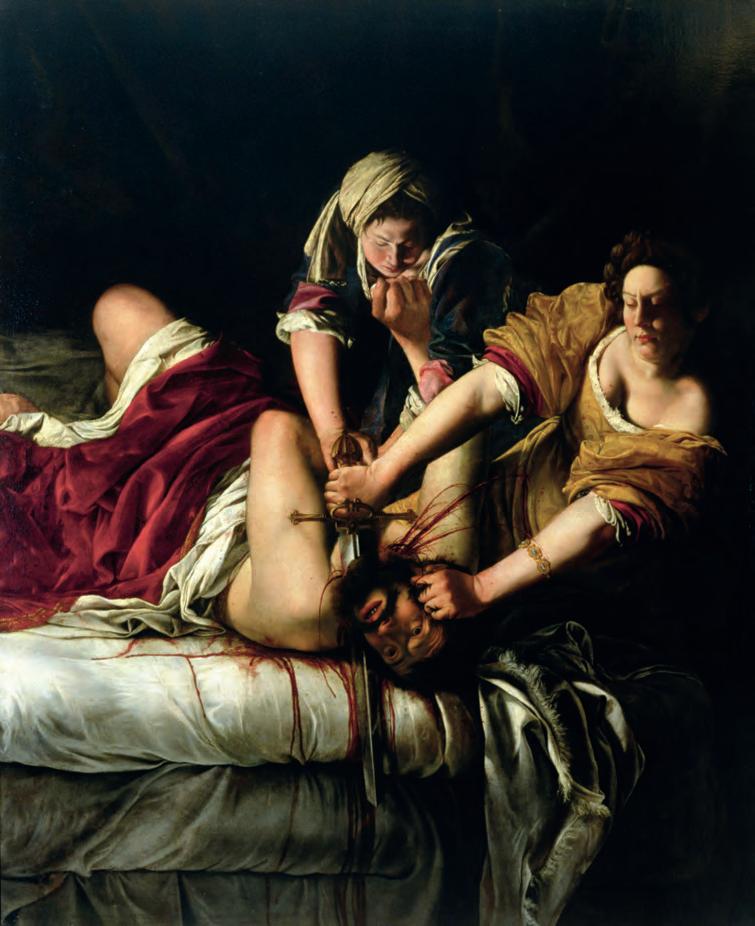
3 An edition of Artemisia’s sonnets, co-published by Sheila Barker, is forthcoming.
Artemisia Gentileschi and Feminism in Early Modern Europe
By Mary D. Garrard. 320 pp. incl. 65 col. + 4 b. & w. ills. (Reaktion Books, London, 2020), £15.95. ISBN 978–1–78914–202–0.
by babette bohn
Artemisia Gentileschi is easily the most famous woman artist of early modern Italy nowadays, and she has recently benefited from treatment by such fine scholars as Sheila Barker, Roberto Contini, Jesse Locker, Judith Mann, Gianni Papi, Francesco Solinas, Letizia Treves and Ward Bissell. Within this group, Mary Garrard occupies a uniquely important position. She wrote the first modern monograph on the artist, a groundbreaking work published in 1989 that upended modern comprehension of Gentileschi’s accomplishments and inspired a generation of scholars, including this reviewer. This is Garrard’s third book on Artemisia, and it follows her initial foray by more than thirty years. The author clearly articulates her intention at the outset, which is ‘to situate Artemisia’s art firmly within a discourse that is now taking clearer historical shape, and to show how her paintings played a part in that discourse’ (p.8).
The first chapter, ‘Artemisia and the writers’, connects the painter with the many early modern women writers who argued for women’s capabilities and rights, such as Lucrezia Marinella, Moderata Fonte and Arcangela Tarabotti. This chapter also narrates Artemisia’s own life, beginning in her native city of Rome, where her father, the artist Orazio Gentileschi, taught her to paint (this was unusual since, in Rome, male artists typically did not train their daughters); her years at the Medici court in Florence, where she was the first woman painter in the Accademia del Disegno; her relationships with two French queens, Marie de’ Medici and her daughter Henrietta Maria, consort of Charles I, the former probably having inspired Artemisia’s heroic depictions of women; her relatively short stay in Venice (a publishing centre, the population of which included more successful female writers than painters); and her long sojourn in Naples, interrupted by a trip to England. Garrard emphasises the artist’s intense dislike for Naples, where she nevertheless spent more than two decades – a situation that speaks to the limited opportunities that even talented women artists faced during the period. Such perceptive empathy for her subject is characteristic of
the burlington magazine | 165 | january 2023 91
1. Judith beheading Holofernes, by Artemisia Gentileschi. c.1620. Oil on canvas, 146.5 by 108 cm. (Gallerie degli Uffizi, Florence; Bridgeman Images).
Garrard’s approach, yielding insights that are often overlooked by other writers.
The following chapters each explore specific iconographies, beginning with Susanna and Lucretia, followed by musicians and Magdalens and Artemisia’s most frequent and famous subject, Judith. Some discussions reprise issues that the author has examined in previous publications, but recently rediscovered works are now emphasised, and interpretations enriched with new insights. Artemisia’s Self-portrait as a lute player (Fig.2), for example, is connected with pertinent themes, such as theatrical productions and gypsies, and related to illuminating comments by Laura Cereta and Moderata Fonte about women’s problematic relationship to fashion. Artemisia’s turban in the painting, which
2. Self-portrait as a lute player, by Artemisia Gentileschi. c.1615–18. Oil on canvas, 77.5 by 71.8 cm. (Wadsworth
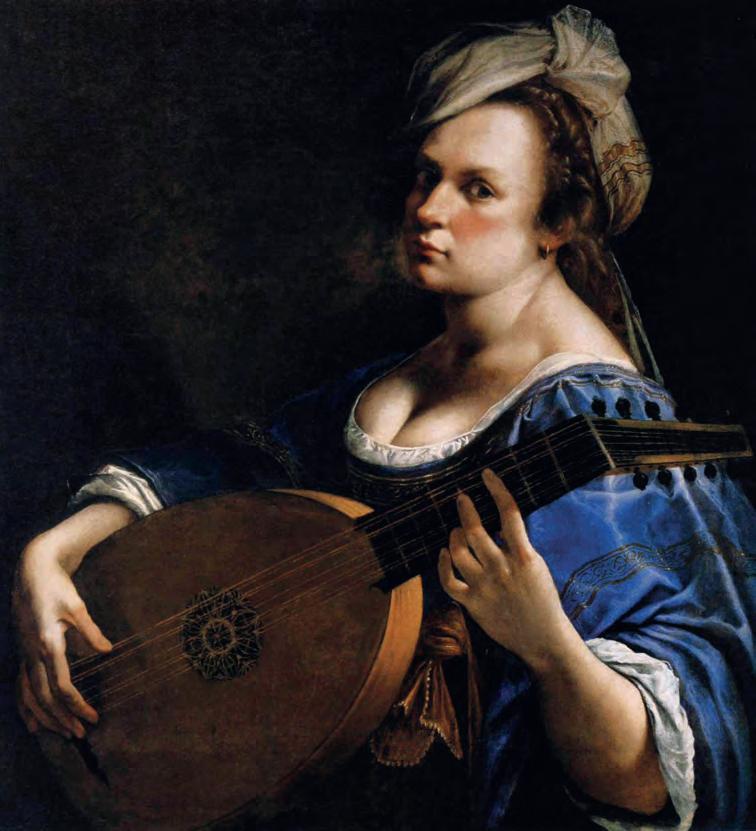
also appears in Self-portrait as St Catherine of Alexandria (1615–17; National Gallery, London), signals her identity as an artist. Garrard argues compellingly that Artemisia’s recurring self-imagery reflects her insistence on maintaining her own presence in the paintings, which ‘are always about her, even when they ostensibly concern an archetypal female character, and the relationship between the two, the type and the artist’s fictive self, is the major discourse of Artemisia’s art’ (p.124).
The three final chapters investigate a broad range of subjects. A discussion of ‘Women on top’ explores reversals of the so-called natural order by virtuous women such as Esther and Jael as well as by antiheroines such as Medea and Delilah. In the chapter ‘The divided self: allegorical and real’, Garrard explores allegorical pictures and self-portraits in relationship to the works of other female painters and writers, culminating in a discussion of Artemisia’s
late Self-portrait (?) as the allegory of painting (c.1638–39; Royal Collection), which, the author argues, both synthesises and challenges the status of painting and art theory. In the final chapter, on Artemisia’s paintings for the Queen’s House at Greenwich, originally commissioned from Orazio, the allegorical figures reference living people and hence ‘humanize the liberal arts and muses they represent’ (p.227). Garrard’s interpretations of these works, like the rest of her book, situate the artist in the context of a multifaceted network of significant women writers and rulers throughout Europe. This fascinating book provides an innovative, important and accessible addition to the Artemisia literature.
A Companion to Late Medieval and Early Modern Siena
Edited by Santa Casciani and Heather Richardson Hayton. 356 pp. incl. 19 col. ills. (Brill, Leiden and Boston, 2021), €160. ISBN 978–90–04–38999–1.
by giulio dalvit
In 2010, in an editorial to a special issue of this Magazine on Sienese art, which was to celebrate the exhibition Le arti a Siena nel primo Rinascimento held in Siena that year, Richard Shone highlighted a historiographical impasse.1 Although some articles published in The Burlington Magazine in the early twentieth century had been instrumental in helping Sienese art emerge from the ‘shadows of neglect’ by clarifying issues of chronology and attribution, others had been representative of a tendency to ‘[spill] purple ink’ about the elegance, purity, charm and spiritual uplift of art produced in Siena. Commenting on the articles included in the special issue, Shone admitted that ‘anyone wishing to gain some idea of the particular characteristics of Sienese art and its special distinction within Italian art as a whole will be frustrated [. . .] Aesthetic speculation is left on the side of the plate; the main meal is the fodder of commissions and productions, of payments and carpentry, of tiers, piers, dowels and frames’.2 Indeed, Shone identified a key problem that continues to face scholars of Sienese art and culture today: the difficulty of assessing Sienese art in its own right, without reverting to either appreciation in purely aesthetic terms, or depreciation according to a Florentine yardstick of excellence, or
Books the
|
2023 92
burlington magazine
165 | january
Atheneum Museum of Art, Hartford; Bridgeman Images).
else an approach that is myopically fixated on details of production.
The book under review, the twenty-third in the series of Brill’s Companions to European History, suggests that interdisciplinarity might be a solution to the impasse. It is conceived for a readership that includes – but is not limited to – art historians. Following an introduction by Heather Richardson Hayton, it comprises three main sections, titled ‘The City and Commune’, ‘Art and Religion’ and ‘Culture and Society’. A concluding ‘Epilogue’ discusses the nineteenth- and twentieth-century myths concerning Siena. Overall, the book aims to appraise ‘Siena’s contributions to the world’ (p.5) across and beyond disciplinary boundaries. The first essay, a historical overview by Mario Ascheri, an eminent scholar of Sienese studies, covers the institutional, political and economic history of the city from its foundation to the permanent loss of its independence to Florence in 1555. The succeeding twelve essays address questions of art, music, literature, politics, religion, urban planning and historiography.
Most interesting from an art-historical perspective are the chapters by Fabrizio Nevola and Sheri Shaneyfelt. Nevola presents a useful synthesis that enlarges the arguments he presented in his important book from 2007.3 He demonstrates that Siena is not ‘a Pompeii of the Middle Ages’, as Hippolyte Taine put it.4 Rather, the urban fabric of Siena is largely the result of fifteenth- and sixteenthcentury urban design legislation. Shaneyfelt discusses the trecento Marian altarpieces in the cathedral. Regrettably, instead of focusing on the panels completed between 1333 and 1348 by Simone Martini, Lippo Memmi, Pietro and Ambrogio Lorenzetti and Bartolomeo Bulgarini to complement Duccio’s Maestà (1308–11), she digresses with a discussion of the works produced by the Lorenzetti brothers for sites other than the cathedral. The essay thus becomes a meandering survey of Lorenzettian art, which, moreover, ignores much of the recent literature on the subject.
As befits a companion of this kind, such towering Sienese figures as St Catherine (1347–80) and St Bernardino (1380–1444) are given due attention. Sienese religious culture is further explored by Demetrio Yocum through the lens of Carthusian monasticism with a focus on the obscure Sienese Carthusian monk Pietro Petroni (1311–61) and by Andrea Wenz, who ventures into the uncharted territory of reformed religious beliefs in early-modern Siena.
Anna Peterson provides an essay on Sienese hospitals, which served as a crucial stop along the Via Francigena, the bustling pilgrimage route connecting Canterbury to Rome, and account for the city’s key role in the history of healthcare. Unfortunately, she does not address the role hospitals played as patrons of the arts. Lastly, Elena Brizio’s and Konrad Eisenbichler’s contributions on sixteenthcentury Sienese women in politics and literature are also useful to art historians, especially since the agency of women as patrons (let alone as artists) in Siena remains shamefully understudied.
The essays in this companion contain useful references, open new avenues for research and even present some fun facts, such as the information that one pig and four piglets were employed to clean the streets in thirteenth-century Siena. However, for art historians, the book as a whole does not provide a solution to the scholarly impasse highlighted by Shone. In fact, most of the authors continue to draw on a series of romantic topoi in the history on Siena, chief among them the preconception that the trecento was Siena’s golden age. The quattrocento is sidelined as retardataire, to the extent that not a single author discusses the period. As Bradley Franco’s and Saverio Battente’s essays demonstrate, this myth was, in fact, largely the result of Siena’s enduring capacity for reinventing its own past. Moreover, the companion fails to challenge the key position given to Florence in art history. It does not make the important point that much, if not all, of traditional art-historical literature concerning Siena was produced within a colonial context, in which scholars were used to think of art in terms of centre and periphery, which has made it difficult to assess the artistic achievements made in Siena, considered peripheral, separately from those made in Florence, the political capital that was held to be the artistic centre. If scholars could avoid prioritising Florence, on the one hand, and concentrating on the trecento in Siena, on the other, the history of Sienese art could be written on new terms. Only then will Siena be salvaged from the lurking shadows of neglect and recognised in current academic discussions as a keystone of Italian art.
1 Reviewed by Timothy Hyman in this Magazine, 152 (2010), pp.433–35.
2 ‘Editorial: Siena then and now’, THE BURLINGTON MAGAZINE 152 (2010), p.143.
3 F. Nevola: Siena: Constructing the Renaissance City, New Haven and London 2007.
4 H. Taine: Voyage en Italie, Paris 1866, II, p.61.
On Bramante
By Pier Paolo Tamburelli. 348 pp. incl. 32 col. + 43 b. & w. ills. (MIT Press, Cambridge MA and London, 2022), £36. ISBN 978–0–262–54342–2.
by david hemsoll
Historical architects are capable of inspiring today’s practitioners, or so this book maintains. Such a proposition accords with the supposed (but illusory) premise of Rudolf Wittkower’s celebrated Architectural Principles in the Age of Humanism (1949), and the subsequent convictions of many of his followers and successors who have held that the works of the Renaissance architect Andrea Palladio provide lessons, or even touchstones, for modern-day schemes. The present book, instead, fixes on Palladio’s predecessor Donato Bramante (c.1444–1514), identifying him as a visionary who, it is stated, can guide contemporary designers and encourage them to produce buildings that are ‘slightly less ugly’ (p.xiii).
The book takes the form of an extended exploration of Bramante’s life and work or, rather, a substantial meditation on them that runs to around sixty thousand words with numerous endnotes. It has two main sections, broken up into forty-three short chapters on diverse subjects (some with no explicit connection to Bramante), and lacking much of a chronological structure except towards the end, which is focused on Bramante’s rebuilding of St Peter’s, Rome. It is rooted in extensive reading, which stretches from Giorgio Vasari’s biography of the architect to recent studies by Arnaldo Bruschi and Christof Thoenes and covers much else besides (including many writings that may be unknown to English-speaking readers);1 but it still claims to be largely grounded in ‘first-hand knowledge’ of Bramante’s output, which together with the literature ‘constructs a discourse focused predominantly on contemporary architecture’ (p.xii). Patently a labour of love by a prominent modern-day architectural commentator, it had a gestation, we are told, of fifteen years before being written initially in Italian, the author’s first language, and then translated into English.
Despite professing to be based on direct knowledge of Bramante’s works, the book tends to rely on suppositions about the architect and his outlook that are not well supported by evidence or reason. For example, it is the presumption here, as it is in many accounts of Bramante’s career, that
Books the
2023 93
burlington magazine | 165 | january
he rethought his architectural objectives almost immediately upon his arrival in Rome in 1499, as a direct result of his experience of the city’s ancient ruins and of the extensive investigations of them, which Vasari says he undertook at this early moment. For Tamburelli, this adoption of ‘classical’ architecture was decisive and inevitable, but such a view of events is not supported by the facts. Bramante’s early cloister at S. Maria della Pace (1500), described here as already based on his ‘direct experience of the Roman ruins’ (p.46), is certainly highly novel and distinctive and in many ways different from his previous work in Milan, but it displays no new engagement whatsoever with Antiquity in either composition or detailing. Any such commitment becomes discernible only in subsequent works, and above all in schemes commissioned by Julius II and dating from around a decade later. A second and related premise, elaborated throughout the book in various guises, is that this ‘classical’ architecture is somehow not a style, that it conveys no meaning and that it is valid for everyone and ‘universal’ (p.54) in its remit, by being a kind of architecture that ‘everybody would have liked’ (p.12).
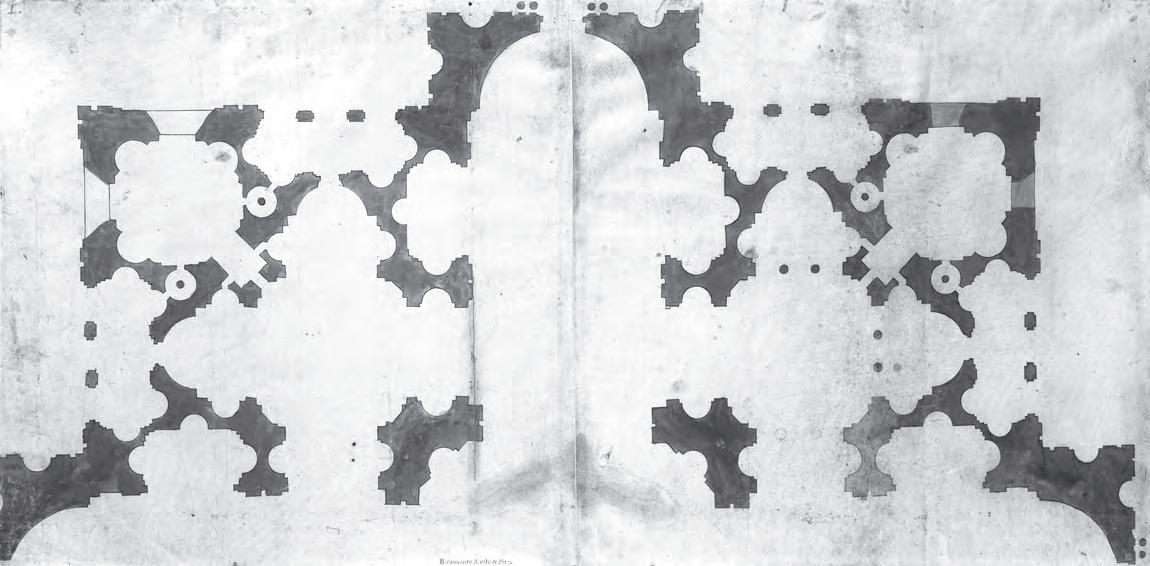
It is Tamburelli’s contention, furthermore, that this supposed lack of style
links with the principle that Bramante’s architecture is instead based solely on form and space; but all these views are again deeply questionable. A different and more historically attuned reading of the all’antica schemes Bramante devised for Julius II would be that they were very deliberately intended to impart meaning through their style, and that their unprecedented Romanness was deliberately calculated to evoke the pope’s authority and his comparability with the greatest rulers of the ancient past. A more objective understanding of the formal and spatial character of Bramante’s architecture – or rather of his successive plans for St Peter’s (Fig.3) – is also contingent on the ramifications resulting from designing a building with such an enormous dome rather than on needless conjecture regarding broader philosophical matters relating to his architecture’s supposed character. In other words, it was the nature of the commission, and Bramante’s new predilection for all’antica architecture, that determined the outcome of his approach, rather than theoretically driven conceptions of form and space, or nonhistorical and misleading understandings of the Classical or the universal.
It is perhaps legitimate to ask why exactly the book was written, and for whom it is intended. Even for those familiar with Bramante’s buildings, the arguments are difficult to follow, while the prose, with its
numerous assertions, modern-day cultural references and theoretical ruminations and meanderings, and its excessive recourse to italicised words and phrases, presents a multitude of further obstacles for ready comprehension. In addition, the colour plates of photographs, arranged in no intelligible order at the book’s front and back, are mostly dire in quality, deeply inconsequential and uninformative, and they bear little relationship to the contents or course of the text. Especially disappointing, too, is that the aims set out in the book’s introduction are never actually met. We never get to engage in any promised discourse focused on contemporary architecture, and we never learn precisely how contemporary architects could be motivated by Bramante’s buildings to design works that are ‘less ugly’. It is as if the book encapsulates a wish on the part of the author that his endeavour of devoting himself to one of the great Renaissance pioneers of so-called classical architecture might be emulated, or valued, by practising designers for their collective benefit. It is also, however, as though the author, who views Bramante as having managed to free himself from the ‘nostalgia’ associated with the ruins of Antiquity (p.12), is himself trapped in nostalgia, a nostalgia for the glories of his own Italian architectural heritage, which he perceives as being at such odds with the realities of the architectural present.
Books
the burlington magazine | 165 | january 2023 94
3. Design for St Peter’s, Rome, by Donato Bramante. 1506 or later. Pen and wash on parchment, 54 by 111 cm. (Gallerie degli Uffizi, Florence).
Il Mobile a Roma dal Rinascimento al Barocco
By Alvar González-Palacios. 507 pp. incl. 253 col. + 126 b. & w. ills. (Ugo Bozzi Editore, Rome, 2022), €33. ISBN 978–88–7003–067–9.
by simon swynfen jervis
In 1970 The Burlington Magazine published an article by Alvar González-Palacios attributing the design of the carved wood base of the young Bernini’s marble St Lawrence (Galleria degli Uffizi, Florence) to the sculptor himself.1 Remarkably, when Stanislao Fraschetti illustrated the sculpture in his foundational 1900 monograph, Il Bernini: la sua vita, la sua opera, il suo tempo, it was removed from its base and set on nicely arranged drapery, and subsequent authors continued to ignore the base. Over fifty years later, González-Palacios, now at once historian and historiographer, has incorporated into his new book an Italian translation of his 1970 article, which not only elevated furniture into art, but also made a strong case for the base as a prototype for Baroque tables in Rome and elsewhere. Also published in 1970 was a useful and richly illustrated book, Il Mobile Romano, the first on the subject, by Goffredo Lizzani (1906–72), an architect who campaigned to preserve the urban fabric of Rome. González-Palacios supplied a lengthy introduction. In subsequent decades he has continued to till and enrich this territory and its neighbours in books, articles, catalogue entries and exhibitions, including his grand monograph Luigi Valadier (2018), published to accompany an exhibition at the Frick Collection, New York.2
Il Mobile a Roma ranges from the early fifteenth century to 1700. Up to 1500 it is a conscientious pope-by-pope account, with documentary references to many a falegname, magister lignarius or indeed carpentario –woodworkers, often from Florence, able to construct both great church ceilings and smaller pieces of moveable furniture. Numerous furniture types are mentioned, notably sgabelli, stools which, when made for cardinals, were painted red, and the episcopal and papal faldistorio, the X-framed seat of majesty, definitively represented in Melozzo da Forlì’s fresco (c.1477; Pinacoteca Vaticana) showing the enthroned Sixtus IV appointing
Platina as prefect of the Vatican Library. Fragments of the intarsia decoration of Sixtus IV’s library survive, partly executed in 1481 by the Florentine Giovannino de’ Dolci, who had worked for Pius II from 1458 and for Paul II; as González-Palacios makes clear, they are not of the highest quality. There are also references to the prosaic – close-stools (sedibus stercorariis) for Palazzo Apostolico in 1484, for example – and to the exotic, such as seven large carpets from Cairo, for the papal court, in 1489.
In the early sixteenth century, particularly under Raphael’s aegis, woodwork of the highest quality was supplied to the Vatican. Unfortunately, only eight fine intarsia panels, made by Fra Giovanni da Verona, survive, but happily superlative carved doors and shutters attributed to Giovanni Barile of Siena, appointed head of the Vatican model workshop by Leo X in 1514, are a compensation for this loss. A problem then arises. Thanks to the activities, ruthless or nefarious, of late nineteenth- and early twentieth-century dealers, particularly in Florence, the surviving pool of sixteenthcentury Italian moveable furniture has been so muddied by alteration and imitation, not to speak of dislocation, that genuine pieces with impeccable provenances are rare birds. González-Palacios supplies a telling instance: he was asked in the 1980s by Sydney Freedberg, then Chief Curator at the National Gallery of Art, Washington, to catalogue seventy-two pieces of Italian furniture in its collection but was convinced by the complete authenticity of only a single piece (a Roman table, illustrated here). Nonetheless he has assembled a credible group of Roman cassoni, buttressed by pertinent drawings.3
Another prevalent dilemma, as González-Palacios makes explicit, is that the survival of furniture lacking documented makers is echoed by plentiful documentation on makers with whom no furniture can be associated. An exception is a massive cabinet, now in the Musée National de la Renaissance in the Château d’Écouen, made c.1579 for Cardinal Alessandro Farnese by a French craftsman, Flaminio Boulanger, active in Rome from at least 1551. A preliminary design survives at the Archivio di Stato, Naples, and the antiquary Fulvio Orsini and the architect Giacomo della Porta provided advice. One important documentary tool is heraldry: thus the essential clue to the reunification of a Roman table base documented as by the carver Pietro Paolo Giorgetti with its Florentine pietre dure top was the presence on
both of Barberini bees (private collection). But caution must be exercised: as GonzálezPalacios makes clear, even the attributions of the base of the celebrated Farnese Table (Metropolitan Museum of Art, New York) to Vignola and of its top to the French craftsman Pierre Ménard are attractive theories, rather than facts.
Throughout Il Mobile a Roma are references to the discoveries of friends and disciples, including Jennifer Montagu, Bertrand Jestaz, Francesco Petrucci, Roberto Valeriani, Enrico Colle and the late Daniela Di Castro, lending the text autobiographical accents, sometimes with a hint of the elegiac or nostalgic, and a sense of a continuing dialogue, if not dialectic. Its organisation, basically chronological, does not take the form of a relentless narrative, but is often episodic, sometimes even staccato. A special feature to relish is the incorporation of documents; several pages, for instance, are devoted to extracts from the accounts of Cardinal Francesco Barberini (1597–1679) describing delicious confections of ebony, lapis lazuli, silver and crystal, mainly made as gifts circulated ‘urbi et orbi’, with French, Spanish, Russian, Polish, Scottish and Hungarian recipients, the principal supplier being the German cabinetmaker Remigio Chilozzi.
The Roman development of pietre dure, which preceded and then overlapped with the Florentine industry, is, as might be expected from its principal historian, a major theme.4 He notes the new dating to the 1560s of the initiation of the great table given by Cardinal Alessandro Farnese to Philip II of Spain (Museo Nacional del Prado, Madrid), but its significance, establishing it as an early document to compete with the Farnese Table, is perhaps understated and the comparison with the much smaller Westminster Table (private collection), recently documented as Florentine, now seems less persuasive. In 2015 this reviewer attributed the commission of the great Sixtus Cabinet at Stourhead, Wiltshire, to Sixtus V (1521–90) himself, albeit
ORDER A BOOK
To order a book reviewed in The Burlington Magazine, please visit www.burlington.org.uk, where a link will take you to John Sandoe Books. By ordering your book through our website, John Sandoe Books will generously donate a percentage of the sale back to the Magazine, supporting our mission to publish new research on art and its history.
Books
95
the burlington magazine | 165 | january 2023
1 See A. Bruschi: Bramante architetto, Bari 1969; and C. Thoenes: ‘Elf Thesen zu Bramante und St Peter’, Römisches Jahrbuch der Bibliotheca Hertziana 41 (2013–14), pp.209–26.
4. Cabinet by Giacomo Herman. 1669–78, on an early 18th-century giltwood console table. Ebony veneer, mounted with lapis lazuli, jasper, gilt bronze and 14 gouache miniature paintings depicting views of Rome, and incorporating a clock by Giovanni Wenderlino Hessler and a virginal by Giovanni Battista Mambriani, dated 1676, 284 by 172 by 72.5 cm. (Private collection).
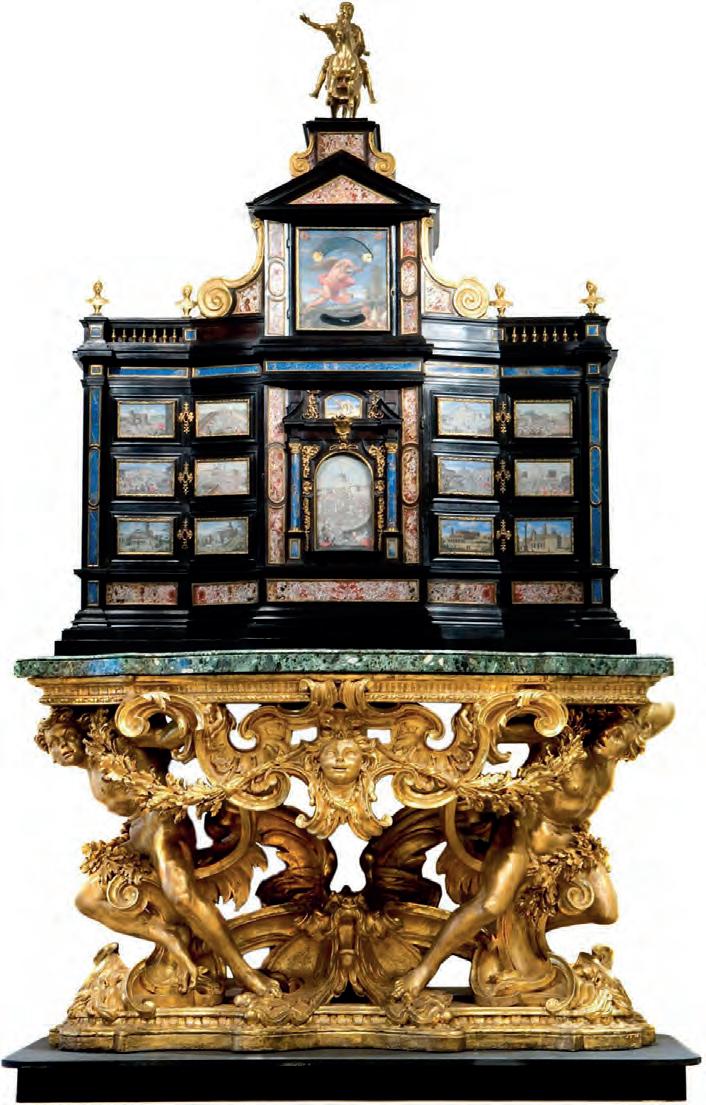
with a side bet on his great-nephew, Cardinal Alessandro Damasceni Peretti (1571–1623).5
Contract documents of 1603 to 1604, with details of a jewelled cabinet containing an
organ, summarised by González-Palacios, leave little doubt that this is the Stourhead Cabinet, which proves to have been designed by an obscure architect, Alberto Martini, and made by an otherwise unknown German cabinetmaker, Joannes Grinuald. Its organ, however, was the work of a well-known Neapolitan specialist, Alessandro Fabri, assisted by another, Crisostomo Noci. The date strongly suggests that the cardinal was indeed the patron of the cabinet, then rightly described as ‘magnificentissimi’.
the burlington magazine | 165 | january 2023 96
Bernini, inevitably, dominates the later years: in 1665 he designed two quintessentially bold console tables for Palazzo Chigi, Ariccia, and in 1666 a noble architectural corner cupboard for S. Maria Assunta, which faces the palace; all were made by Antonio Chiccari (the idea that his name was an Italianisation of the German ‘Kicker’ has proved fictive). Amusingly, Bernini’s great rival Francesco Borromini is the subject of a lengthy complaint from the carver Andrea Battaglini for having in 1651 caused extra work by changing the design of tables for Palazzo Spada, Rome. An inevitable cynosure is the extraordinarily theatrical bed (lost but recorded in a print by Pietro Santi Bartoli, 1663) designed and orchestrated from 1662 by Bernini’s assistant Giovanni Paolo Schor for the birth of the first-born of Maria Mancini (who married Lorenzo Onofrio Colonna in 1661), as is the work of Schor’s son, Filippo, on the base of one of the two great cabinets in the Galleria Colonna, Rome. GonzálezPalacios’s analysis of the Galleria’s painted mirrors and console tables reveals a lengthy and complex gestation that belies their sculptural assurance. Another case study is the unprecedented set of four cabinets by the German cabinetmaker Giacomo Herman, two now in Rosenborg Slot, Copenhagen, one in the Loreto Chapel, Cracow, and the fourth in a private collection (Fig.4).
The frontispiece to this selective but wide-ranging panorama of princely Roman furniture is an alluring but melancholic female sphinx on a superlative table once in Palazzo Patrizi, Castel Giuliano. The final illustration is a joyous detail of the spectacular sunflower mirror that has been the table’s companion since at least 1783. González-Palacios attributes this, tentatively, to the carver Filippo Passarini, on whose design book, Nuovi inventioni (1698), he is a little severe on grounds of its derivative nature. But on the mirror the historian, the rat des archives and the connoisseur does not hold back: it displays ‘una bellezza quasi feroce’ (p.489).
1 A. González-Palacios: ‘Bernini as a furniture designer’, THE BURLINGTON MAGAZINE 112 (1970), pp.719–23.
2 Luigi Valadier: Splendor in EighteenthCentury Rome was reviewed by Reinier Baarsen in this Magazine, 161 (2019), pp.70–72.
3 An extra might have been a fine Roman design for a cassone acquired in 1971 by Peter Ward-Jackson for the Victoria and Albert Museum, London. See P. Ward-Jackson: Italian Drawings. Volume One: 14th–16th Century, London 1979, p.221, no.494 (illustrated).
4 ‘Pietre dure’ here in the lax English usage to cover inlays of both hard and softer stones.
5 S. Swynfen Jervis and D. Dodd: Roman Splendour, English Arcadia: The English Taste for ‘Pietre Dure’ and the Sixtus Cabinet at Stourhead, London 2015, p.118.
Books
La nascita di una collezione: Gli Hercolani di Bologna (1718–1773)
By Barbara Ghelfi. 304 pp. incl. 28 b. & w. ills. (Bologna University Press, 2021), €35. ISBN 978–88–6923–772–0.
by linda borean
The study of art collecting in Bologna is hardly a new subject. This book by Barbara Ghelfi is, nevertheless, welcome, since the focus is on the eighteenth century and not on the seventeenth, the period of the ‘divine’ Guido Reni, which has been the object of intensive research in recent times. Knowledge of collecting during the eighteenth century is patchy, with a great deal of ground still to be covered, despite Bologna’s significance as the second city of the Papal States, which moreover boasted a school of painting with a good reputation, capable of keeping abreast of an art market that was in rapid transformation, as Olivier Bonfait has shown.1 Although the art collections of this period suffered massive dispersions, fortunately, some knowledge of them is preserved in Marcello Oretti’s late eighteenth-century accounts of art in the churches and palaces of the city, which is a fundamental starting point for the study of collecting in Bologna during this period.
The book focuses on the collection of paintings formed by the Hercolani family, and the author has undertaken extensive research in the local archives, notably in the private archive of the family, which is separate from the Archivio di Stato. The result is a radical new picture of the origins and development of this important collection. It was housed in the family’s palace on the Strada Maggiore (today occupied by the Department of Political and Social Science of the University of Bologna). The Hercolani could boast a respectable pedigree in the art world, going back to Vincenzo Hercolani (1500–57), who, according to Giorgio Vasari, was a patron of both Raphael and Correggio. The family’s collecting accelerated under two descendants of Vincenzo, Marcantonio Hercolani (1709–72) and his son Filippo (1736–1810).
Whereas Luigi Crespi in his Descrizione de’ Quadri di sua Eccellenza il Signor Marchese Filippo Hercolani (1774) credited Filippo with creating the collection, it is clear from the archival documents studied by Ghelfi, including notes left by Oretti, that the contribution of his father needs to be reassessed. As Ghelfi demonstrates,
Marcantonio was an energetic and passionate collector, who acquired some outstanding paintings, including such altarpieces as the Virgin with saints by Marco Palmezzano (1513; Alte Pinakothek, Munich), which, according to the author, may have come from Faenza. Most of Marcantonio’s acquisitions were made for him by a trusted majordomo, Gregorio Pagani, during expeditions in Bologna and into the Marche and Romagna regions.
Filippo, on the other hand, relied on the support of advisers with an established reputation in the painting market, such as Crespi, but he also closely studied the historical sources available to him. Furthermore, he took inspiration from his Grand Tour to Rome, Naples and Herculaneum in 1761, and from a journey to Vienna and Dresden in the following year. Convinced that high quality should provide the fundamental benchmark for his collection, Filippo acquired knowledge about the functioning of the art market and was aware of such contemporary European art galleries as the gallery of paintings at Dresden. These seem likely to have informed the installation of his collections in the Strada Maggiore palace. Indeed, one significant characteristic of the Hercolani collection was the attention paid to the hang, in particular by Filippo, who seems to have wanted to create a magnificent gallery, almost a proto museum; a key element in the installation of the works was the symmetry created by displaying together paintings of similar size, composition and colour. Given that there is still no systematic study of display in Bolognese collections in the eighteenth century, the example of the Hercolani collection could be an excellent starting point for a broader exploration of this theme, perhaps also with an eye to other artistic centres, starting with Rome and Venice.
The Hercolani gallery was also unusual within the context of Bolognese collections for including so-called ‘primitive’ painters, an interest that Filippo shared with the art historian and archaeologist Luigi Lanzi, who was fascinated by the altarpieces he saw in the Hercolani gallery. Churches often considered these works to be redundant, providing Filippo with opportunities for purchase, as in the case of Lorenzo Veneziano’s Coronation of the Virgin, originally in the church of S. Giacomo Maggiore, Bologna.
The volume includes a substantial appendix of documents, edited by Pasquale
Stenta, which contains transcriptions of the so-called topographic ‘quinterni’, inventories that Filippo commissioned in 1772–73; these records include detailed descriptions of the works in the collection and identify their locations in the rooms of the palace. This important resource is here published with a useful commentary, which will help to encourage future research, not only into the Hercolani gallery of paintings, but more broadly into collecting and the art market in Bologna in the eighteenth century.
1 O. Bonfait : Les tableaux et les pinceaux: La naissance de l’école bolonaise, 1680–1780, Rome 2000.
Improbable Pioneers of the
Romantic Age: The Lives of John Russell, 6th Duke of Bedford, and Georgina Gordon, Duchess of Bedford
By Keir Davidson. 592 pp. incl. 45 col. + 50 b. & w. ills. (Pimpernel Press, London, 2022), £40. ISBN 978–1–910258–25–5.
by richard ormond
This thoroughly researched book brings to life the marital career of a socially and culturally prominent couple in the early years of the nineteenth century. John Russell, 6th Duke of Bedford (1766–1839), had unexpectedly inherited the dukedom from his brother Francis in 1802, and for thirty-seven years he set about improving and developing his large estates, espousing the principles of progressive agriculture, attaining expertise in horticulture and botany, building up important plant collections, on which he published many studies, and adding to the collection of important works of art he had inherited. A shy and retiring man, his one foray into public life, as Lord Lieutenant of Ireland (1806–07), ended in failure and he withdrew. Nevertheless, as a leading member of the Whig elite, he remained politically influential, pulling strings behind the scenes and fostering the career of his son Lord John Russell (1792–1878), later prime minister.
In 1802 the duke married, as his second wife, the much younger Lady Georgina Gordon (1781–1853), daughter of the 4th Duke of Gordon and his firebrand wife, Jane, a passionate admirer of the Scottish Highlands. After the collapse of her marriage, Jane had spent the winter months at Kinrara House, on the banks of the River Spey, Perthshire. The marriage of John
Books the
burlington magazine | 165 | january 2023 97
and Georgina was to prove an enduring partnership between two very different characters. The impulsive, charismatic and attractive duchess offered a startling contrast to her quiet, thoughtful and intellectual husband. They shared a mutual passion for the estates they had inherited and a desire to transform and expand them. This led to all manner of building projects, new garden designs and features and large-scale landscape improvements. The three sons from the duke’s first marriage were soon joined by ten younger children and the family became a centrepiece in the couple’s lives. A favourite property of the duke and duchess was Endsleigh, Devonshire. Here they built a picturesque house in the Gothic style, designed by Jeffry Wyatville, sited dramatically above the valley of the River Tamar. It is considered to be a cottage ornée by architectural historians, although it is more substantial than most buildings of this type.
The wild, romantic aspect of the landscape attracted the couple to Endsleigh, and their many projects there, which included the construction of a Swiss cottage, were designed to enhance the natural beauty of the place. The duchess shared her mother’s passion for the Highlands and introduced
them to her husband, and almost every summer and autumn they journeyed north to the wilds, spending two or three months there. In Scotland they could leave behind their busy lives, enjoy the company of close friends and family and steep themselves in the beauty and drama of the Highland landscape. In 1830 the duke acquired the lease of the Doune, a house on the Rothiemurchus estate of the Grants, south of the Cairngorms. In the nearby valley of Glen Feshie the duchess begun building huts, where she and her friends could play at being simple Highlanders.
Whereas Endsleigh and the Doune were private retreats, Woburn Abbey, the family seat of the Bedfords, represented the formality and splendour of ducal life. In the words of Keir Davidson, it was there that ‘they were responsible for creating the grandest set of buildings, the most complete pleasure grounds and flower gardens, the most elaborate infrastructure of roads and walks in the park, and the most diverse and interesting attractions in every corner of the park for the family and visitors to enjoy’ (p.24). The duke, who had a keen interest in the visual arts, commissioned a number of paintings from leading artists of the day for the gallery at Woburn, many of them historical works and landscapes. What unites this plethora of estate projects was what the author perceptively calls a Romantic sense of
wonder at what was waiting to be discovered. The Bedfords were on a quest to make sense of the natural world and their relationship to it. The duke’s plant collections and botanical catalogues were one expression of such wonder, the duchess’s encampments in Glen Feshie were another.
Of particular interest from an arthistorical perspective is Davidson’s discussion of the relationship between the duke and duchess and Edwin Landseer (1802–73). More than just patrons and artist, they became intimate friends, and the Highlands was the setting for their burgeoning friendship (Fig.5). Landseer first met the couple in 1824, when, at the age of twenty-two, he paid his first visit to Scotland and joined them at Forest Lodge on the Duke of Atholl’s estate. There he painted the first of his many Russell family portraits, a depiction of the Russell children, romantically attired in Highland dress, enjoying a picnic of freshly caught fish on the banks of the River Tilt, watched over by an elderly Highland crone (private collection). In the same year, the duke commissioned Landseer’s early masterpiece, The hunting of Chevy Chase (Birmingham Museums and Art Gallery), which combines history painting with sporting art. Inspired by a border ballad, the painting records the story of Earl Percy hunting across the lands of his arch enemy Earl Douglas, a prelude to a battle in which the two leaders and most of their men were killed. Landseer records the hunting scene with a foreground of stags and hounds locked in furious combat. The duke took a keen interest in the commission, advising the artist of the types of deer to be included and berating him for failing to deliver the painting in time for the Royal Academy exhibition of 1825 (it was shown a year later).
Landseer became artist-in-residence to the Bedfords on their annual excursions to the Highlands. He also played his part at Woburn, organising theatricals and other forms of entertainment. He not only painted portraits of Russell family members, but recorded the family and their circle in a long sequence of amusing pen-and-ink caricatures. The duchess and the artist spent long periods of time together giving rise to the rumour that they were lovers. They certainly shared the same high spirits, mischievous humour and love of practical jokes, but whether that led on to a love affair remains uncertain. Nor is it clear whether there is any truth in the story that the duchess’s refusal to marry
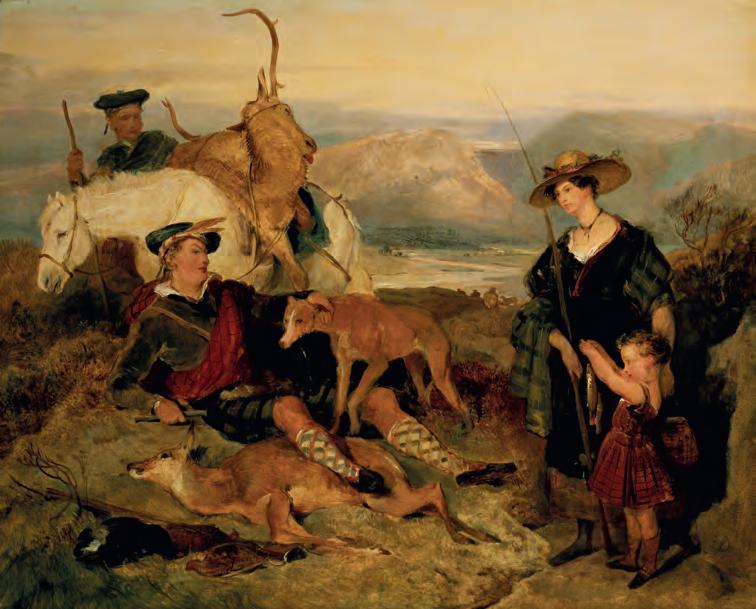
Books the burlington magazine | 165 | january 2023 98
5. Sketch for Deer-stalking in the Highlands, by Edwin Landseer. c.1828. Oil on canvas, 43 by 53.5 cm. (Wolverhampton Art Gallery; Bridgeman Images).
Landseer, after the death of the duke in 1839, prompted his first breakdown.
Davidson’s biography of the duke and duchess is a richly researched and detailed study of two important personalities and patrons of arts and sciences in Regency Britain. In their multifarious activities and interests, they embody the questing, Romantic spirit of the age, here vividly brought to life.
Mary Gillick: Sculptor and Medallist
By Philip Attwood. 216 pp. incl. numerous col. + b. & w. ills. (British Museum and Spink Books, London, 2022), £25. ISBN 978–1–912667–75–8.
by mark stocker
Two British women made history in 1953. The first was Elizabeth II, who was crowned that year; the second was the much-loved singer Kathleen Ferrier, whose premature death from cancer several months later caused shock waves. A third woman links the two: Mary Gillick (1881–1965), the artist of the first effigy of the queen on British, Commonwealth and imperial coinage, and of the bronze relief memorial to Ferrier (1958), in University College Hospital, London, where she had died. Although Gillick will never be as famous as either subject, Philip Attwood’s monograph admirably rescues her from the condescension of posterity. Its publication coincided with a Platinum Jubilee exhibition, Mary Gillick: Modelling the Queen’s Portrait, at the British Museum, London (2nd June–31st July 2022), which included other medals by her. A substantial archive in the Henry Moore Institute, Leeds, has made Attwood’s task possible, although he is at pains to stress that his book is about the art of Gillick and not her life. Given her staunch work ethic and modest privacy, she would have probably welcomed this.
Several reasons explain Gillick’s relative obscurity. The first is her chosen and preferred medium: the art of the medal. Despite the best efforts of such scholars as Attwood, Mark Jones and the present reviewer, the post-Renaissance medal has been consistently, almost deliberately, sidelined by art history. ‘Why not say “medal”?!’ asks an exasperated Attwood in the face of references to the ‘bas-reliefs of Alphonse Legros’ (p.162).1 The answer, at least partly, is the unfashionability of the medium, the largely commemorative
and honorific functions of which are at odds with the more purely formal ideals of Modernism. Indeed, medals are, in Attwood’s words, ‘an inherently conservative medium with innovation possible only within certain limits’ (p.145). This leads to another reason for Gillick’s modest status: she was, crucially, a generation older than Henry Moore and Barbara Hepworth, and never seriously engaged in a modernist aesthetic. In contrast, Gillick’s debts to Pisanello, Legros and Édouard Lantéri, her teacher at the Royal College of Art, London, are obvious. By looking closely and intelligently at her work, however, Attwood argues that Gillick significantly departs from Lantéri in her lettering, ‘which she saw not as a subsidiary adjunct to the figurative imagery but rather as an equally important element in the design’ (p.140). This is evident from early on in her career, not least in the reverse of her three Imperial Air Fleet
medals (1916), which depict a relatively small biplane in a vast, open sky. Atwood calls their minimalism ‘radical in the extreme’ (p.30), making them something of an outlier among her works.
Gillick (née Tutin) was married for nearly fifty years to the relatively prominent sculptor Ernest Gillick (1874–1951). Their partnership in art and life appears to have been happy and harmonious. The question of their influence on each other’s works is sparsely documented and Attwood wisely refrains from any retrospective exaggeration of Mary’s importance at Ernest’s expense.
The Gillicks were well known to Gerald Kelly, the President of the Royal Academy of Arts, London, who successfully supported the widowed Mary’s application for a Civil
6. Mary Gillick in the grounds of her home in Chelsea holding a plaster model for the new coinage. 1952. Photograph. (British Museum, London).

Books the burlington magazine | 165 | january 2023 99
List pension: ‘They used to do a certain amount of work together [. . .] She herself is a very good sculptor but the thing that is satisfactory about them both is that they were so full of artistic integrity – not a common quality these days’ (p.150). It is still rarer today, and what emerges from Attwood’s text is genuine artistic humility and absence of pushy self-promotion. Here she differs from a prominent friend of hers, the painter Laura Knight, and still more so from the ‘flamboyantly performative’ sculptor Dora Gordine (p.200). She completed six commissions that her husband had on hand when he died, and won national prominence in 1952, when she was announced as the artist of the forthcoming coinage effigy (Fig.6).
When modelling the queen, Gillick touchingly ‘wanted to get the feeling one has from her of radiant goodness, the seriousness of her and all that I tried to store in my mind as well as the shapes’ (p.75). She surely succeeded; although Gillick’s work is generally in a relatively narrow stylistic range, the portrait possesses a more conscious historicism than usual, both in the laureated hair and the soft, sweet modelling, reminiscent of female heads by Antonio Rossellino and Desiderio da Settignano.
The effigy is both pretty and serious, winning the admiration of the numismatist Humphrey Sutherland, who described it as ‘simple, decorative and majestic’, and the art historian Charles Mitchell, for whom ‘it breathes the air of the early Renaissance’ (pp.80–81). It was short-lived, however; what counted against it was a tendency for its shallow relief to wear down, particularly on smaller coins, and the necessity of its replacement when Britain went decimal.
A near surge of commissions ensued for Gillick, then seventy-one years old, and several were good-humouredly refused, such as a medal for the North Thames Gas Board. Executed works include the Ferrier memorial and further bronze relief medallions, commemorating the determined-looking Margaret Babington (1959–60), ‘a devoted friend of Canterbury Cathedral’ (p.113), and the somewhat bullish George Bell, Bishop of Chichester (1961). They are located in their respective cathedrals and represent an elegant but miniaturised coda to the British church monument. Bell’s memorial brought a change of heart from his friend Kenneth Clark, a supporter of Modernism, who had earlier patronisingly described Gillick’s work as a ‘mere pastiche of the Renaissance style’
(p.114). Following the unveiling, he hailed her ‘great success both as to design and to likeness. I think we are extremely fortunate that there is someone like you who is still able to do work of this kind which will stand the test of time’ (p.117). Clark’s warm words can be applied to an œuvre extending over half a century, painstakingly yet readably documented here.
1 See P. Rose: Working Against the Grain: Women Sculptors in Britain c.1885–1950, Liverpool 2020, reviewed by Katharine Eustace in this Magazine, 162 (2020), pp.1006–07.
Paul Signac: Journal 1894–1909
Edited by Charlotte Hellmann. 624 pp. incl. 55 col. ills. (Gallimard and Musée d’Orsay, Paris, 2021), €26. ISBN 978–2–07–017788–2.
by richard thomson
Paul Signac began to keep a journal in June 1894, aged thirty. He was writing in his seventh book when he abruptly stopped on 1st January 1903 and the journal was not taken up again until December 1908, but then only for three months. Another desultory phase took place in 1915, while Signac was sitting out the war in Antibes, and then a final burst over a year from July 1932, when he bought a property at Barfleur. Thus, his journal is partial and does not cover his whole career. There is nothing on the 1880s, when he showed at the final Impressionist exhibition and the NeoImpressionist group was coalescing around Seurat, or on the early 1890s, a period that saw a rising tide of the anarchism to which he was committed. And the urge to record and commentate diminished in the mid-1900s as the Neos went their different ways and the Salon des Indépendants lost momentum to the Salon d’Automne. Between 1949 and 1953 John Rewald published selected passages in three issues of the Gazette des Beaux-Arts, but these were teasingly fragmentary and edited out certain crucial aspects of Signac’s character, notably his anarchist credo.1 Thus, we can be extremely grateful for this full edition by Charlotte Hellmann, the artist’s great-granddaughter. Opened with essays by Signac expert Marina Ferretti Bocquillon and by Hellmann herself on the artist as a writer, the text is presented complete, fully footnoted and indexed.
Of course, much of what Signac wrote is about his practice as an artist. At times he interposed drawings with his text – some
the burlington magazine | 165 | january 2023
examples are illustrated – and the interplay between verbal and visual is vivid. He was consistent in his loyal admiration for Seurat and his determination to affirm his legacy. Much is written about work in progress, from scouting out motifs to composition and work on the canvas. Interestingly, there is little on chromatic theory – the chemist and theorist Michel-Eugène Chevreul is mentioned only four times and Ogden Rood once – whereas the term teintes, meaning subtle nuance or a colour achieved by a mixture of several colours, is a constant theme, vital both for the painterly vivacity of the canvas but also for individual expression. This was central to Signac’s understanding of NeoImpressionism. Another theme in his writing about practice is drawing, especially the way a composition should be harmonised with subtle but insistent arabesques. He often notes this in his own work and that of HenriEdmond Cross, his much-admired fellow Neo-Impressionist.
A surprise to many readers of his journal will be Signac’s awareness of the art of the past. During the later 1890s in particular, Signac referred enthusiastically to Poussin, Claude, Turner and Delacroix. His book on the evolution of modern painting, D’Eugène Delacroix au néo-impressionnisme (1899), acknowledged the notion of a chain of development, and his journal records purchasing prints after Poussin from the Chalcographie du Louvre so that he could trace the rhythmic harmonies of his compositions. Indeed, in the very first entry, on 14th June 1894, Signac mentions Delacroix’s journal, published only the previous year by Paul Flat and René Piot, and his illustrious predecessor may have prompted the hundreds of pages Signac eventually penned. The journal frequently, even surprisingly, brings out his approval of past art, as when he wrote that the Neos should paint simply, like Giotto in his frescos: ‘a beautiful line with some beautiful colour in it’ (16th October 1895). By contrast, he rejected painting from nature, finding the Impressionists to be ‘far from the great tradition. They are too much painters of accidents’ (18th March 1897).
Signac’s comments on the Parisian art scene in the later 1890s are particularly revealing. He distrusted the work of Henri Martin, who he reckoned had pillaged the pointillé touch from the Neo-Impressionists, and consistently dismissed the dark painting of Charles Cottet and his colleagues of the Bande noire group as a denial of the
Books
100
medium’s possibilities. Signac had good personal relations with Renoir, although he could not understand the older artist’s dismissal of Seurat’s Poseuses (1886–88; Barnes Foundation, Philadelphia). He was increasingly convinced that Impressionism was losing its vitality of colour, Monet’s facture becoming crusty and Pissarro merely dull. Paul Durand-Ruel was damned for promoting such Impressionist imitators as Maxime Maufra and Gustave Loiseau. Initially Signac was critical of the Nabis as a rival group, but he came to admire certain works by Édouard Vuillard, such as the decorative panels painted for Jean Schopfer (1901, reworked 1935; National Gallery, London), and also Maurice Denis’s use of colour; by the early twentieth century he had become a great admirer and good friend of Pierre Bonnard.
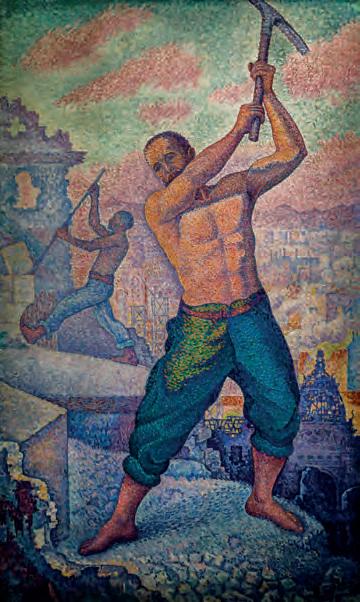
Anarchism is a consistent theme in the journal. In 1894 Signac inserted among its pages press cuttings reporting on the notorious Trial of the Thirty, when the critic Félix Fénéon and others went on trial in the hue and cry following the assassination of President Sadi Carnot. His ideological commitment was tightly engaged with his painting, and with the publication of his
journal some rethinking is required. The sun in Le démolisseur (Fig.7), hitherto considered to be rising to herald an anarchist dawn as the bourgeois world is torn down, we now know Signac described as setting (20th October 1896), an image of finality, whereas presumably in the planned but unpainted Les constructeurs the sun would have been rising as the better world was built.2 The journal also shows how Signac, a kind and generous character, admired the simple fisherfolk of his adopted Saint-Tropez, noting their argot and admiring their sailing skills. Fascinated by the modern, he enthused about the chromatics of octopus tissue seen under a microscope, and – already an enthusiastic bicyclist – became an early car driver. Signac’s humanity also surfaced in his sense of humour; he named his cockerel Barrès after the right-wing novelist, classed Federico Zandomeneghi’s work as ‘peinture de bidet’, and with Cross went looking – successfully – for the shapes of Rodin’s Burghers of Calais in cork oaks on the Mediterranean shores. Signac was a powerful painter, a humanitarian of principle, a fine friend and a lively intellectual: all of which is strikingly evident in this excellent and welcome edition of his journal.
1 J. Rewald: ‘Extraits du journal inédit de Paul Signac, I, 1894–1895’, Gazette des Beaux-Arts 36 (1949), pp.97–128 and 166–74; idem: ‘Extraits du journal inédit de Paul Signac, II, 1897–1898’, Gazette des Beaux-Arts 41 (1949), pp.265–84 and 298–304; and idem: ‘Extraits du journal inédit de Paul Signac, III, 1898–1899’, Gazette des Beaux-Art 42 (1953), pp.27–57 and 72–80.
2 R. Thomson: ‘Ruins, rhetoric and revolution: Paul Signac’s “Le Démolisseur” and anarchism in the 1890s’, Art History 36 (2013), pp.366–91, at p.383.
Against the Avant-Garde: Pier Paolo Pasolini, Contemporary Art, and Neocapitalism
By Ara H. Merjian. 304 pp. incl. 175 col. + b. & w. ills. (University of Chicago Press, 2020), £36. ISBN 978–0–226–65527–7.
by robert silberman
The poet, novelist and film-maker Pier Paolo Pasolini occupies a singular position in Italian cultural life. The circumstances surrounding his gruesome murder in 1975 at the age of fifty-three were tabloid fodder at the time and still remain a matter of debate. He has been the subject of documentaries, a feature film and many academic works, including this significant study of Pasolini’s relationship to contemporary art.1
Pasolini studied art history with Roberto Longhi at the University of Bologna, where he was writing a master’s essay on Giorgio Morandi and two other artists when he was called up for military service in 1943. A prolific critic, theorist and commentator, he began as a poet and literary figure who championed regional dialects and diversity; later he focused on cinema as well as the cultural and political issues of the day. The subject of his novels and his early films was the Roman sub-proletariat, a sign of his admiration for Karl Marx and Antonio Gramsci. During the so-called ‘economic miracle’ in post-war Italy, Pasolini became vehement in his opposition to neo-capitalism and the consumerism he associated with television, technocracy and the bourgeoisie; even sexuality was co-opted rather than being a source of liberation. With time Pasolini became ever more outspoken about these issues. A regular participant in the intellectual brawls that characterise Italian politics and culture, Pasolini faced thirtythree legal actions as a result of his writings and films. His final film, Salò, or the 120 Days of Sodom (1975), an adaptation of Marquis de Sade’s 1785 novel, set in Fascist Italy, featured extreme violence and sexuality. Although Pasolini became increasingly disillusioned –his poem ‘Progetto di opere future’ (‘Project for future works’; 1964) ends with the words ‘The revolution now is just a sentiment’ – he continued to speak out. He made proposals to abolish compulsory education and television, and in the notorious poem ‘Il PCI ai giovaniâ’ (‘The PCI to the young’) berated the student protesters of May 1968 as bourgeois ‘spoiled kids’ in contrast to the police, proletarian ‘sons of the poor’. The backlash overlooked his opposition to the police as an institution and his denunciation of state violence against students.
Pasolini was explicit about the debt his films owed to Masaccio, a Longhi favourite, and other Renaissance artists (Pasolini himself played a fresco painter, a student of Giotto, in his Il Decameron from 1971), a connection that has been explored by scholars in the past.2 In this study, however, Ara Merjian shifts the focus to the artist’s relationship with contemporary art. He demonstrates complete familiarity with his material in terms of the ideas, works and, not least, personalities – important when the milieu is so full of complicated alliances and vendettas. The author also understands the two major institutions in Italian life, the Communist Party and the Catholic Church, and Pasolini’s difficult relationship
Books the
2023 101
burlington magazine | 165 | january
with
7. Le démolisseur, by Paul Signac. 1897–99. Oil on canvas, 251 by 150.5 cm. (RMN-Grand Palais; Musée d’Orsay, Paris; Bridgeman Images).
each. Divided into four main chapters, the book manages to be both densely packed and clearly written, with Merjian expressing a judicious view of Pasolini’s complex, often contradictory positions.
Devoted to the figure in art, Pasolini regarded post-war abstraction as an indulgence tied to individual psychology rather than group action; he came to view the
8.
Performed
avant-garde as depoliticised, formalist and superficial. Pop art is discussed in a lengthy section. Pasolini saw it mainly as an unhappy avatar of the consumer economy, without fully considering the question of whether it was promoting or critiquing consumerism, or both. He wrote about Ladies and Gentleman at Palazzo dei Diamanti, Ferrara, in 1975, the first Warhol exhibition in Italy, but never wrote about Arte Povera. Still, Merjian is right to suggest Pasolini might have been sympathetic to the movement’s general anti-technological, anti-commercial bias, specifically to Jannis Kounellis’s sense of the cultural past as a paradise lost. In general, the discussion of
Pasolini’s relationship to Arte Povera and to later developments is suggestive, if at times forced, as are attempts to connect Pasolini’s film settings to Land art or his few plays to performance and body art. In his last days Pasolini, a self-proclaimed heretic, appeared antagonistic toward virtually all contemporary developments, yet insisted that his apparent conservatism in cultural and political matters was not nostalgic or reactionary.
Merjian leaves the films largely aside, although he neatly explicates the significance of one of Pasolini’s character’s turn to gestural abstraction at the end of Teorema (Theorem; 1968), when he urinates on a painted canvas. He also makes a remarkable comparison between an image in the Pasolini short La terra vista dalla luna (The Earth Seen from the Moon; 1967) and an early painting by Sigmar Polke, Plastic tubs (1964), where he rightly says that Pasolini lacked Polke’s irony. Although Merjian introduces some names that will be familiar to the non-expert on twentieth-century Italian art, literature and cinema, including Morandi, Giorgio de Chirico, Umberto Eco (an occasional Pasolini adversary), Alberto Moravia, Roberto Rossellini and Michelangelo Antonioni, many others will be less wellknown. The illustrations of works of art are well-chosen and effective.
The standout discussion in the book is of Fabio Mauri’s Intellettuale (Intellectual; Fig.8), a performance piece, in which Pasolini’s film The Gospel According to St Matthew (1964) is projected onto the torso of a person seated in an otherwise dark space. Originally performed with Pasolini the year he died, it was recreated by Mauri (and by others after Mauri’s death) with an empty white shirt as though to claim ‘Pasolini lives!’. As Merjian traces Pasolini’s influence down to the present the sheer number of artists and works that have paid tribute to him is surprising. Yet as Merjian’s study reminds us, Pasolini remains unrivalled in Italy, and maybe beyond, among artists of the immediate post-war period as a charismatic figure of independence and resistance.
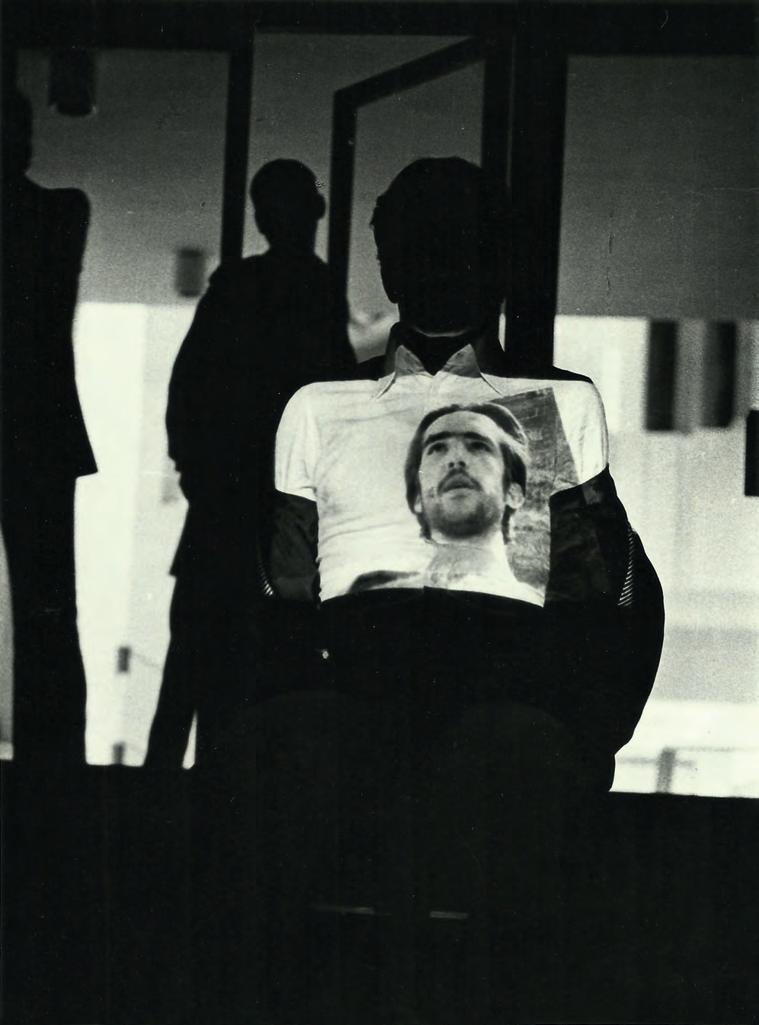
1 See, for example, Pasolini, directed by Abel Ferrara, 2014; Whoever Says the Truth Shall Die, directed by Philo Bregstein, 1981; Pier Paolo Pasolini: A Filmmaker’s Life, directed by Carlo Hayman-Chaffey, 1971; Pasolini l’Enragé, directed by Jean-André Fieschi; 1966; and L. Peretti and K.T. Raizen, eds: Pier Paolo Pasolini, Framed and Unframed: A Thinker for the Twenty-First Century, London and New York 2019.
2 See, for example, P. Rumble: Allegories of Contamination: Pier Paolo Pasolini’s Trilogy of Life, Toronto 1996; A. Marchesini: Citazioni pittoriche nel cinema di Pasolini: da Accattone al Decameron, Florence 1994; and F. Galluzzi: Pasolini e la pittura, Rome 1994.
Books
102
the burlington magazine | 165 | january 2023
Intellettuale: ‘Il Vangelo secondo Matteo’ di/ su Pier Paolo Pasolini, by Fabio Mauri. 1975.
at Galleria Comunale, Bologna, 31st May 1975. (Courtesy Stefano Masotti, Estate of Fabio Mauri and Hauser & Wirth; photograph Antonio Masotti).
Obituary Angus Trumble (1964–2022)
Foiled in his ambition to be a spy, Angus Trumble became a distinguished art historian and curator who also wrote books of great originality and wit on cultural history. He spent much of his career as Senior Curator of Painting and Sculpture at the Yale Center for British Art before returning to his native Australia in 2014 to become Director of the National Portrait Gallery, Canberra.
by andrew hopkins
Angus trumble, whose career culminated in his five years as Director of the National Portrait Gallery, Canberra, from 2014 to 2018, died on 8th October at the age of fifty-eight (Fig.1). Born in Melbourne, he lived in Trinity College in the University of Melbourne while completing with distinction his BA in History and Art History in 1986. He was then appointed tutor in fine arts at the university. Trumble’s international career began early, when he went to study at the Bibliotheca Hertziana in Rome for a year, in 1986–87, capping that off with a summer internship in 1987 at the Peggy Guggenheim Collection, Venice. There his charm, wit and intelligence endeared him to his fellow interns, many from New York, who became lifelong friends. From 1987 to 1991 Trumble served as aide-de-camp to the Governor of Victoria, J. Davis McCaughey, brother of Patrick McCaughey, who was then Director of the National Gallery of Victoria. This was followed by the award of a Fulbright Scholarship for study at the Institute of Fine Arts at New York University before Trumble made his return home as Curator of International Art at the Art Gallery of South Australia, Adelaide, from 1996 to 2001. There he was able to explore his Anglophone interests, curating and writing the catalogues for the exhibitions B ohemian London: Camden Town and Bloomsbury Paintings in Adelaide (1997) and Love and Death: Art in the Age of Queen Victoria (2001). As a curator he carefully cultivated a circle of patrons, who enabled him to make some spectacular acquisitions, including Scipione Pulzone’s large full-length portrait of Cardinal Ferdinando de’ Medici, later Grand Duke Ferdinando I of Tuscany, painted in 1580.

Trumble’s transatlantic mindset saw him return to the United States in 2003 as Senior Curator of Painting and Sculpture at the Yale Center for British Art, New Haven, where he remained until 2014. Working for the then Director, Amy Meyers, who became a lifelong friend, Trumble augmented the largest collection of British art outside the United Kingdom with significant acquisitions, including the Rhoda Pritzker Collection of modern British art. He also fully reinstalled the Center’s holdings and undertook an important series of collection displays and exhibitions, culminating in Edwardian Opulence: British Art at the Dawn of the Twentieth Century (2013), accompanied by a catalogue that he edited with Andrea Wolk Rager.1
Trumble then made his final homecoming to Australia as Director of the National Portrait Gallery, a post he filled with distinction, dedication and flare, stating ‘I have always had a great interest in history as distinct from art history, so for me, a national portrait gallery is the ideal place to be because it’s where stories about people form essentially a national narrative’. Here he not only oversaw the beginning of much-needed structural repairs to the building but also made significant acquisitions, including an important portrait by Graham Sutherland, Helena Rubinstein
in a red brocade Balenciaga gown (Fig.2), painted in 1957. This work prompted Trumble to write a meticulously researched biography of Rubinstein, focused particularly on her early years in Australia, when she began to establish her cosmetics empire. The manuscript is under contract and when published will add to Trumble’s corpus of important books.
In addition to this biography, and his many exhibition catalogues, Trumble contributed regularly to Apollo, the Times Literary Supplement, the Australian Book Review, Esopus Magazine, the Paris Review and this Magazine, for which he wrote reviews of books and exhibitions and two articles on Gilbert Scott’s works in Australia.2 Indeed, he leaves a brilliant legacy in the form of the written word. As much a historian as an art historian,
2023 103
the burlington magazine | 165 | january
1. Angus Trumble in 2015. (Photograph courtesy of the National Portrait Gallery, Canberra).
Trumble produced an ongoing commentary on the human condition that is sensitive, probing, erudite and charitable. The charm and wit that always enlivened his serious assessment of human affairs, past and present, are relayed perhaps most vividly through his long-running blog, The Tumbrel Diaries (www.angustrumble.blogspot.com) and his two books, A Brief History of the Smile (2003) and The Finger: A Handbook (2010). These
works fully illuminate Trumble’s propensity to take bits of the fabric of life – from the most fundamental to the arcane – and to plumb them fully, examining their place in all avenues of human expression, from art and music to literature. Trumble’s voice, so insistently rich and true, so warm, compassionate and understanding, lives on in these works, as well as in his more traditional art-historical scholarship.
Trumble’s first hope had not been to become an art historian, but rather a spy. His application to the Australian Security Intelligence Organisation (ASIO) was turned down, not only because, back then, homosexuality was considered to increase the chance of being blackmailed, but also – as he recounted it – they had checked his financial records and considered that he spent too much money on clothes, without taking into account that as aide-de-camp to the Governor he might need to be properly dressed at all times, which he invariably was.
Always generous with helpful advice, Trumble suggested to this author to apply for an internship at the Guggenheim in Venice during the winter, when the grand New Yorkers were in college and so could not be there, thus increasing enormously the chance of success. This was just one of the endless instances of the consideration he continuously displayed to friends and colleagues. In recognition of his scholarship and directorial flair, he was named a Fellow of the Australian Academy of the Humanities in 2015 and from 2019 he was a Senior Research Fellow at the National Museum of Australia, Canberra.
1 Reviewed by Marc Simpson in this Magazine, 155 (2013), pp.437–39.
2 A. Trumble: ‘Gilbert Scott’s “Bold and Beautiful Experiment”, Part I: The tomb of Sir Charles Hotham in Melbourne’, THE BURLINGTON MAGAZINE 141 (1999), pp.739–48; and idem, ‘Part II: the tomb of Charlotte, Lady Canning’, THE BURLINGTON MAGAZINE 142 (2000), pp.20–28.
among this month’s contributors
Babette Bohn is Professor Emerita of Art History at Texas Christian University, Fort Worth. She is the author of Women Artists, Their Patrons, and Their Publics in Early Modern Bologna (2021).
Linda Borean is Professor of History of Art at the University of Udine.
Roberta Cruciata is a Researcher in the History of Modern Art at the Department of Culture e Società at the University of Palermo.
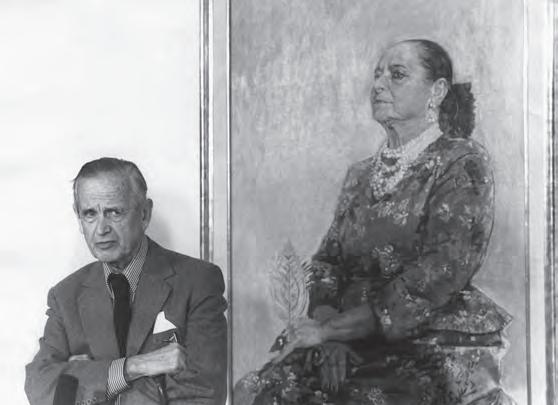
Penelope Curtis is the author of The Pliable Plane: The Wall as Surface in Sculpture and Architecture 1945–75 (2022). Her exhibition Scale: Sculpture 1945–2000 will open at the Fundación Juan March, Madrid, in March.
Giulio Dalvit is Assistant Curator of Sculpture at the Frick Collection, New York.
Samuel Dawson is an Associate Lecturer at the Courtauld Institute of Art, London.
Bart J.C. Devolder is Chief Conservator at the Princeton University Art Museum.
Paula Dredge is a teaching specialist in the conservation of cultural materials at the University of Melbourne.
Bruce Edelstein is Coordinator for Graduate Programs and Advanced Research at NYU Florence. His exhibition, Eleonora di Toledo and the Invention of the Medici Court in Florence, will open at the Pitti Palace, Florence, in February.
Mary D. Garrard is Professor Emerita of Art History at American University, Washington. She is the author of three books on Artemisia Gentileschi.
Anne Gérard-Austin is Curator of International Art at the Art Gallery of New South Wales, Sydney.
Elizabeth Goldring is an Honorary Reader in the Centre for the Study of the Renaissance, University of Warwick. She is currently writing a book on Hans Holbein the Younger.
Katharina Günther is the Scientific Director of the Research Association Marbach Weimar Wolfenbüttel at Klassik Stiftung Weimar, and an expert on modern and contemporary art.
Susan Haskins is the author of Mary Magdalen: Myth and Metaphor (1993), Who is Mary? The Idea of the Virgin Mary (2009) and a number of articles and essays.
David Hemsoll is Reader in Architectural History and Theory in the Department of Art History, Curating and Visual Studies at the University of Birmingham.
Andrew Hopkins holds the Chair in architectural history at the University of L’Aquila.
Daryl Howard is a scientist at ANSTO’s Australian Synchrotron campus, where he is applying the X-ray fluorescence technique to cultural heritage materials.
Simon Ives is a painting conservator at the Art Gallery of New South Wales, Sydney. He is developing augmented interactive displays of works of art based on conservation analytics.
Simon Swynfen Jervis is an independent scholar.
Armin Kunz is an art historian and the owner of C.G. Boerner LLC, a gallery specialising in old-master prints and drawings with offices in New York and Düsseldorf.
Heidrun Ludwig is an independent art historian working at the Sander Collection, Darmstadt.
Randall Morris is an independent scholar.
Arnold Nesselrath is Professor of Art History at Humboldt Universität, Berlin.
Richard Ormond is an independent art historian.
Kevin Salatino is Chair and Curator of the Department of Prints and Drawings at the Art Institute of Chicago.
Robert Silberman is Professor of Art History at the University of Minnesota.
Mark Stocker is a semi-retired art historian. He is the author of When Britain Went Decimal: The Coinage of 1971 (2022).
Jeroen Stumpel is Professor Emeritus in Iconology and Art Theory at Utrecht University, and currently guest Professor at the Technical University, Delft.
Richard Thomson is Research Professor in the History of Art at the University of Edinburgh.
Mary Vaccaro is a Distinguished Professor of Art History at the University of Texas at Arlington who studies northern Italian art.
Obituary the burlington magazine | 165 | january 2023 104
2. Graham Sutherland, photographed in 1977 with his 1957 portrait of Helena Rubinstein, now in the National Portrait Gallery, Canberra. (Photograph Keystone Press Agency Ltd).
Burlington Contemporary Journal is a free-access, peer-reviewed academic journal. The seventh issue was published in November 2022 and we are now seeking article submissions for our next issue, which will be dedicated to contemporary drawing.
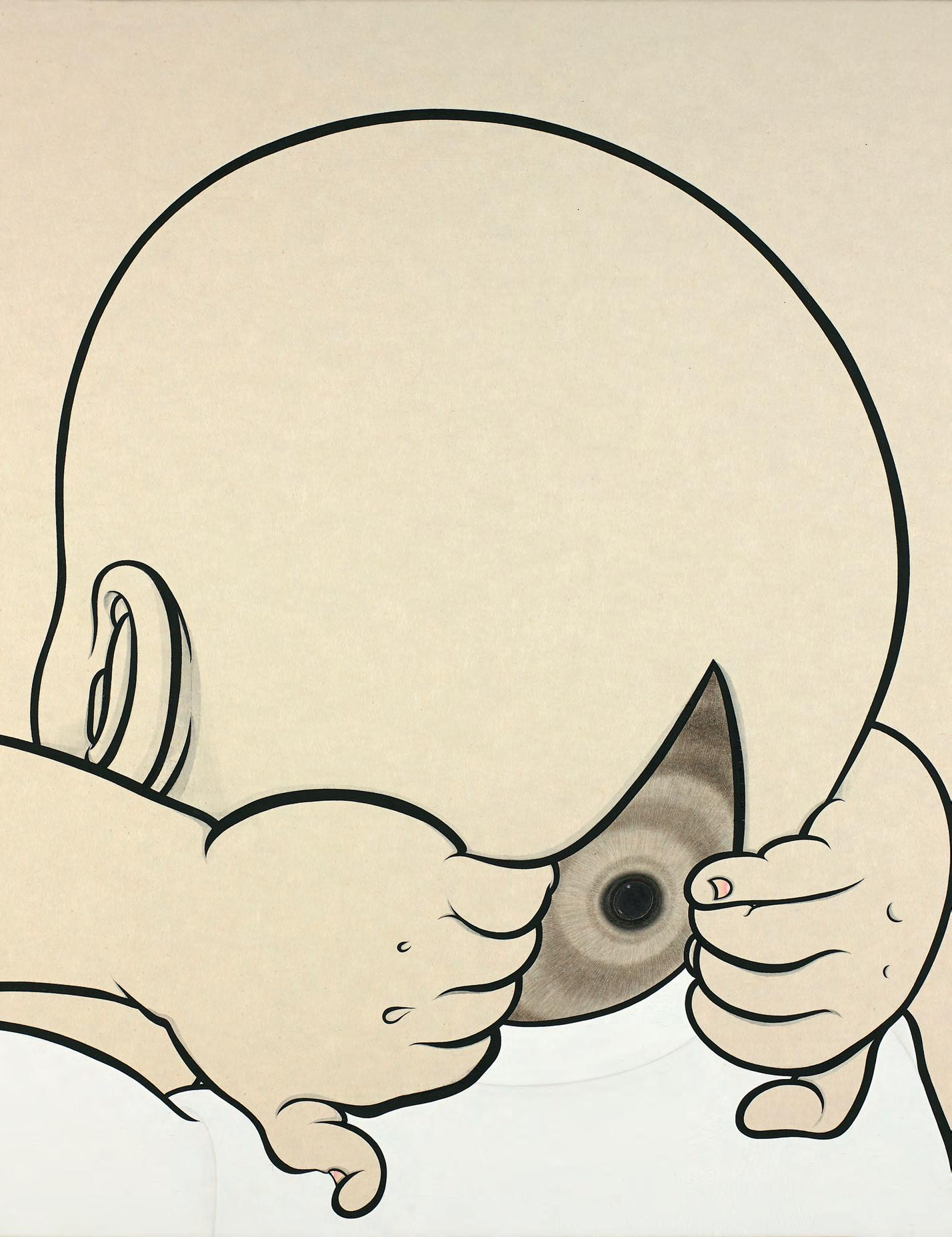
Journal Issue 8: Drawing Deadline: Monday 16th
2023
Call for papers
January
For more information please visit contemporary.burlington.org.uk
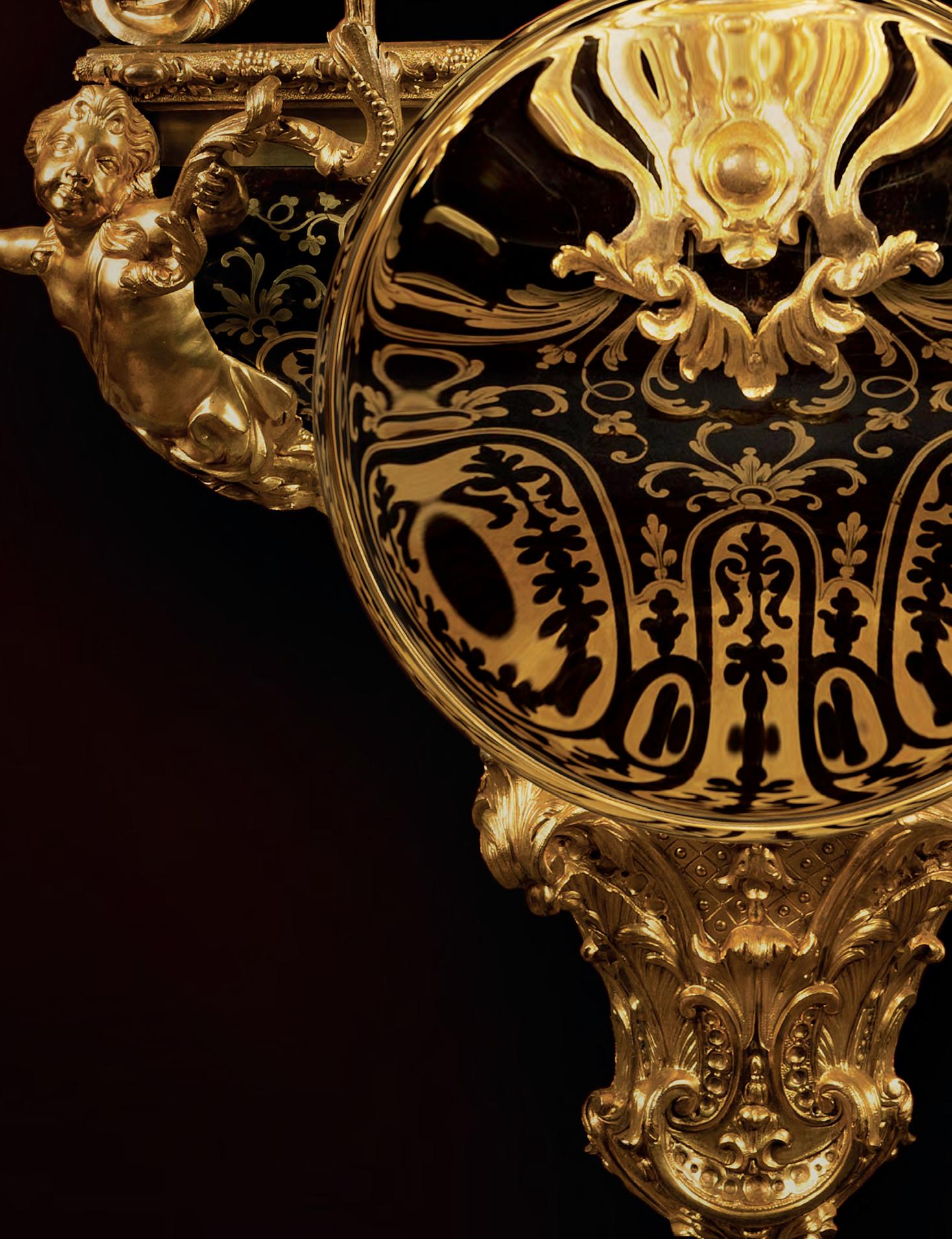


























 The temptation of St Anthony, by Pieter Huys (1519–84). Oil on panel, 41.8 by 57.8 cm. DE JONCKHEERE, GENEVA AND PARIS
The temptation of St Anthony, by Pieter Huys (1519–84). Oil on panel, 41.8 by 57.8 cm. DE JONCKHEERE, GENEVA AND PARIS







 Psycho-site, by Jean Dubuffet (1901–85). 1981. Acrylic on paper, 50 by 81 cm. GUY PIETERS GALLERY, KNOKKE-HEIST
Family portrait. Antwerp school, c.1620. Oil on canvas, 134.5 by 159 cm. KLAAS MULLER, BRUSSELS
Family group, by Henry Moore (1898–1986). 1945. Bronze, height 18 cm. OSBORNE SAMUEL
GALLERY, LONDON
Psycho-site, by Jean Dubuffet (1901–85). 1981. Acrylic on paper, 50 by 81 cm. GUY PIETERS GALLERY, KNOKKE-HEIST
Family portrait. Antwerp school, c.1620. Oil on canvas, 134.5 by 159 cm. KLAAS MULLER, BRUSSELS
Family group, by Henry Moore (1898–1986). 1945. Bronze, height 18 cm. OSBORNE SAMUEL
GALLERY, LONDON











































































































































































































































































































































 by armin kunz
by armin kunz


















































